
When Satoshi created Bitcoin in 2009, it didn’t take long before some clever individuals started exploring its use for online gambling. Hitting recent highs of over $60,000, Bitcoin and other cryptocurrencies such as Ethereum are gaining in popularity, and many users are choosing to use them for online gambling. Now, over a decade later, many […]
Best Bitcoin Gambling Sites was originally found on Blokt - Privacy, Tech, Bitcoin, Blockchain & Cryptocurrency.
]]>
When Satoshi created Bitcoin in 2009, it didn’t take long before some clever individuals started exploring its use for online gambling. Hitting recent highs of over $60,000, Bitcoin and other cryptocurrencies such as Ethereum are gaining in popularity, and many users are choosing to use them for online gambling.
IN A RUSH?
Go straight to our expert’s top pick. For the best all-around Bitcoin gambling experience, Bitstarz is our top pick.
Now, over a decade later, many different cryptocurrencies can be used for gambling, and hundreds of different crypto casinos have launched to fill this huge new demand.

Out of the land rush to create the best Bitcoin casino, a few sites emerged as leaders in the new crypto-powered gaming industry. In 2023, these sites continue to evolve, offering new ways to play and pushing innovations in crypto gambling.
Best Option for Your Country
NOTE: Many gambling sites restrict certain countries from using their services. Although some users may choose to use a VPN to access the sites, its probably a better idea to find a site that doesn’t exclude your country.
The table below lists the best sites for users from countries that are sometimes excluded.
| Country | Working Casino | Play |
|---|---|---|
| United States |  |
|
| United Kingdom |  |
|
| Australia |  |
|
| France |  |
|
| Netherlands | ||
| Spain |  |
|
| Italy | ||
| Sweden |  |
|
| Israel |  |
If you’re a user in a country not listed above then you can ignore this table and continue on to read our selection of the best overall sites below.
Crypto Gambling vs. Traditional Gambling
Here, we’re going to explore some of the best Bitcoin gambling sites the industry has to offer and discover the unique player experience each casino brings.
But before we get started, let’s find out why you might want to use cryptocurrency for gambling in the first place.
You might be wondering, why use cryptocurrency to gamble, when you could just use traditional currency and payment types?
It’s a great question, and it’s best answered with a list of the pros and cons of crypto gambling vs. traditional gambling.
Pros of crypto gambling
- Transaction speeds – Deposits and withdrawals are usually much faster compared to traditional methods such as bank transfers, because of the speed of blockchain transactions. Most withdrawals can be processed in 1 hour or less.
- Higher limits – Many crypto gambling sites will have higher deposit and withdrawal limits for crypto customers, meaning you can withdraw more of your winnings in a shorter amount of time.
- Anonymity – Some, but not all, crypto casinos and gambling sites will allow you to deposit funds and play without verifying your identity, which is great if you’re privacy-conscious.
- Transparency – If you play using a dedicated crypto gambling site, most of the transactions that you make will be on the blockchain, meaning that they are traceable and immutable, and reducing the likelihood of the ‘house’ cheating.
- Amazing bonuses – Often, crypto casinos and gaming sites are able to offer bonuses and promotions which simply wouldn’t be possible using regular fiat currencies!
- Better odds – Everyone knows that casinos have a slight advantage over their players called ‘house edge’, and it’s needed to keep casinos profitable. But with Bitcoin gambling sites, the house edge can be lower because of decreased costs – and with some crypto casinos, there’s no house edge at all.
Cons of crypto gambling
- Less choice – At the moment, there are fewer crypto gaming sites than traditional online casinos, so players have access to fewer games, but this is changing, and may even flip in the future.
- Some technical know-how required – To gamble with crypto, you’re going to need to buy crypto! Not everyone is tech-savvy enough to do this at first, but this guide will teach you how.
- Volatility – As Bitcoin and other cryptocurrencies are volatile, with their value fluctuating throughout the day, the value of your winnings could be eroded by market forces. However, you should remember its value can also go up!
How can you use crypto to gamble?
Naturally, to start gambling with crypto, you’ll first need to buy some coins or tokens from an exchange. Bitcoin is by far the most popular choice for crypto gambling, although many online casinos will also accept ‘alt-coins’ such as Ethereum, Bitcoin Cash, Litecoin, or even Dogecoin.
To buy Bitcoin, you’ll first need to make an account with an exchange where you can buy crypto with fiat currency, such as Coinbase. These exchanges let you buy Bitcoin and other cryptocurrencies, which you can then transfer to your favorite crypto gambling site!
We explain some of the best and easiest ways to buy cryptocurrency in our ‘How to Buy Bitcoin’ guide, so check it out if you need help buying your first Bitcoin.
Some of the casinos we’re going to look at here also allow you to buy crypto using a credit or debit card, instead of buying crypto on an exchange and transferring it over.
However, many crypto gambling sites will require you to send crypto to your casino wallet to play, so it’s best to familiarize yourself with this process first!
When you’re playing on a Bitcoin gambling site, unless you’re a real big player, you usually won’t be betting whole Bitcoins! Instead, most Bitcoin betting sites will let you place bets in ‘milli-bitcoin’ or ‘mBTC’, which is 0.001 BTC. Naturally, you can also place bets lower than this on most sites.
Best Bitcoin Gambling Sites
So, you’ve decided you want to gamble with Bitcoin and cryptocurrency, and you’ve got your crypto ready to go. But how do you choose the best gambling site? Use the table below to take a look at our top picks, or scroll down to read a detailed review on each site.
Hopefully, you’ll be ready to decide after reading this guide, but there are a few general things to keep in mind. Many sites have different games on offer, different supported currencies, and will accept players from different jurisdictions.
Make sure you pay attention to these key features:
- Game choice – Not every Bitcoin gambling site will have the same games, as each casino works with a variety of game providers. As a result, some will have more types of certain games, such as slots – so choose a provider with plenty of your favorite game type.
- Funding – Some crypto casinos will only support cryptocurrency deposits, or perhaps just Bitcoin deposits, whereas others will also support traditional payments. Before you create an account, make sure you can play with your crypto of choice.
- Security – Is the Bitcoin casino you’re sending your crypto to safe and trusted? Some less well-known casinos might not have adequate security, and your funds could be at risk. The casino’s we’re going to discover here are all trusted and transparent.
So, without further ado, let’s explore our top crypto gambling site picks for 2023!
1. Cloudbet

Cloudbet might be one of the longest-running Bitcoin gambling sites, but there are plenty of innovative features to keep players coming back for more.
Launched in 2013, Cloudbet is regulated and licensed in Montenegro and Curaçao, and serves customers in most countries, except for the U.S., the UK, and a handful of European countries.
Currently, Cloudbet supports BTC, ETH, BCH, USDT, USDC, PAX, PAXG, LINK, DAI, DASH, DOGE and LTC.
Cloudbet prides itself on offering better odds than traditional fiat casinos, which has been one of its unique selling points since its launch. On their website, Cloudbet claims that the disintermediation of third-party payment processors through Bitcoin has allowed them to provide fairer and more transparent gaming.
Recently, Cloudbet has pivoted its attention towards the enormous Esports industry, which has attracted many new users for the casino. Let’s find out how Cloudbet has evolved since its launch and its focus for 2023.
As the Ethereum Merge approached, Cloudbet announced support for Ethereum that has been staked on Lido. StETH is now available to all players who want to place a bet using staked coins.
New for the 2023/24 season, Cloudbet now allows its players to bet on the German Bundesliga. This year’s season will be the 61st, having celebrated the 60th anniversary this August. Cloudbet players can use Bitcoin and other cryptocurrencies to bet on the Bundesliga with advantages such as quick transactions and lower fees.
Cloudbet table and slots games
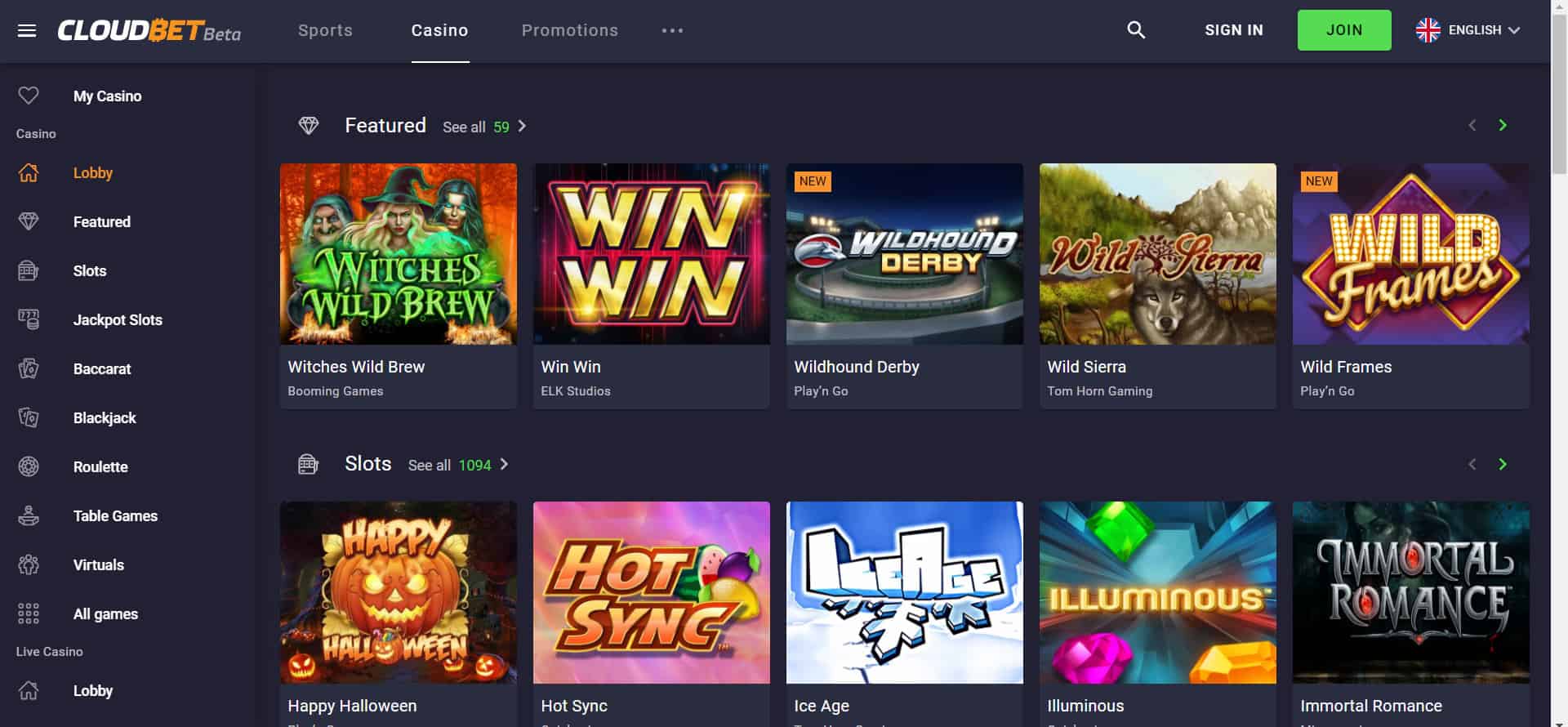
With thousands of table games, virtual games, and slots titles to choose from, players are sure to find a classic and immersive casino experience at Cloudbet.
Cloudbet has over 1,000 slots games, and over 100 classic casino games including roulette, baccarat, blackjack, dice, and craps.
Their range of slots games, despite not being as numerous as BitStarz, are from many of the same games providers, so there are a lot of familiar titles available to play on Cloudbet.
Cloudbet Esports
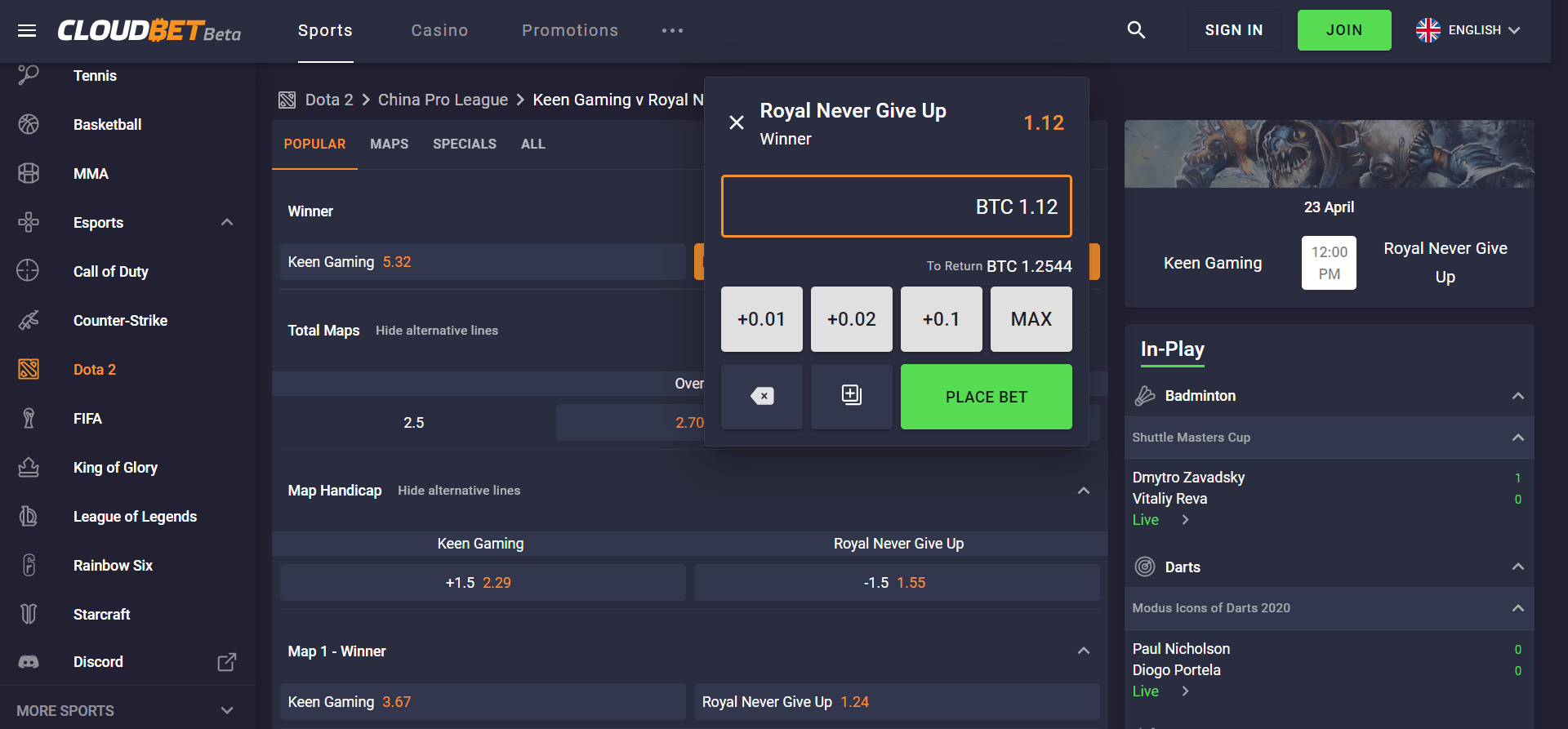
Electronic sports, or ‘Esports’, are gaming tournaments played online using multiplayer video games. These can be anything from team games, to shooters, or even electronic versions of real sports like soccer.
Cloudbet is one of the few crypto gambling sites to offer Esports betting, on some of the biggest competitive video gaming titles in the world. Although competitive Esports is still fairly new, they’ve attracted a huge and dedicated fan base, and many spectators are eager to place bets on the outcomes of games.
Cloudbet currently offer sports betting on the following Esports tournaments:
- Call of Duty
- Counter-Strike
- Dota 2
- FIFA
- King of Glory
- League of Legends
- Starcraft
It’s estimated that 1.57 billion tuned in to at least one Esports match in 2019, and this number is likely to grow in the future. Gambling sites like Cloudbet, who have offered Esports betting for a long time, are a great choice if you’re looking to place a crypto bet on an upcoming game or tournament.
Cloudbet sportsbook
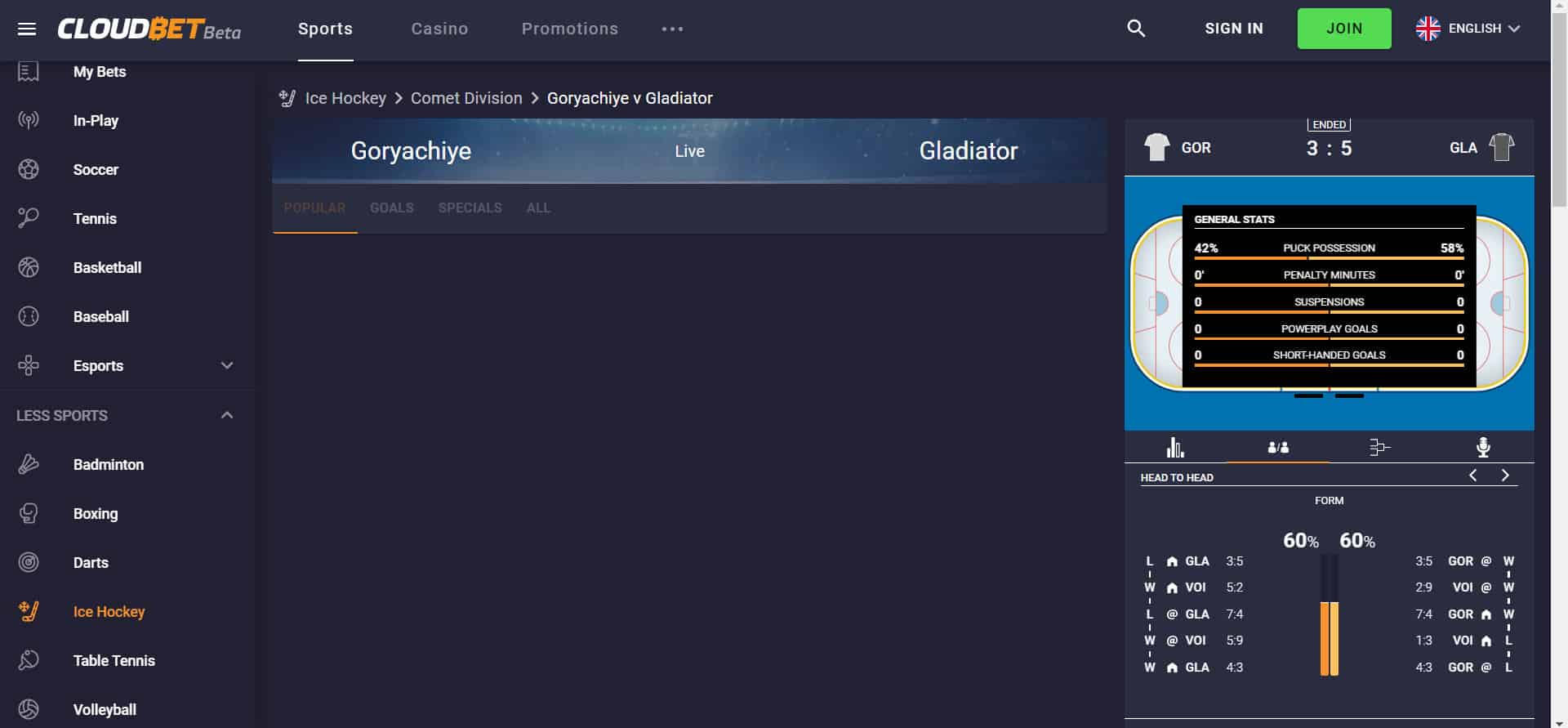
Cloudbet also has a decent range of sportsbook betting, which has been running since its launch in 2013. Similar to FortuneJack, Cloudbet offers betting on all the major spectator sports like soccer, NBA, and NFL, but also covers some niche sports too.
Players can place bets on table tennis matches, volleyball, badminton, and even ice hockey matches. Also, classic sporting events like darts and boxing are available to bet on through Cloudbet, all in Bitcoin and Bitcoin Cash.
In April 2022, Cloudbet announced its new and upgraded Horse Racing Service. This new service comes following the success of their Beta service, which was created for the Melbourne Cup in November 2021. Cloudbet promises highly competitive odds for races of all grades and has high limits for the more popular races. Cloudbet has also improved its pricing structure and options for parlays.
Is Cloudbet Safe?
Cloudbet keeps user deposits in cold storage, which provides the highest level of fund security available, and makes Cloudbet one of the safest exchanges on our list. Cloudbet only uses hot wallets – those connected to the internet – when it needs to process withdrawals.
This means that when not in play, your funds are kept in an offline wallet, which is highly resistant to hacks and theft – even if the Cloudbet site itself is compromised. You can read more about hot and cold Bitcoin wallets here.
At any one time, should the casino be attacked by hackers, there would only be a small amount of Bitcoin available to steal, which makes Cloudbet an unattractive target and a safe casino.
Cloudbet Customer Service
Cloudbet uses ZenDesk, a third-party help desk software provider, to provide extensive FAQs for players in need.
However, this is incredibly hard to find in the standard casino interface and does require some searching around the site to get help. There’s a live chat feature within the help desk, but this isn’t shown on the site except in live table games where you might need immediate assistance.
This does make it a little harder to get instant help on Cloudbet if you run into any issues, in contrast to BitStarz or FortuneJack where an assistant is just the touch of a button away.
Cloudbet Summary
With a huge Esports section, Cloudbet is a stand-out competitor, offering access to an entirely new niche of Bitcoin gambling. As a result, the casino has attracted many new users who wouldn’t normally place bets using cryptocurrency.
It’s a smart move by Cloudbet to attract new users, and if you’re an Esports fan, we highly recommend you try out Cloudbet’s easy-to-use betting experience for your next Esports wager!
Cloudbet also added a great loyalty program in November 2022. So going into 2023, players can earn lightning points, climb loyalty tiers, refer friends, and shop in the marketplace. This is great for more frequent players who want to be rewarded for their long-standing business with the brand.
Cloudbet’s sportsbook, while easy to navigate and providing in-play betting, generally offers more limited betting options than FortuneJack. Nevertheless, it still covers a great range of sports, including MMA matches, which many other crypto sportsbooks don’t currently provide.
While Cloudbet’s range of casino-style games is somewhat lacking compared to the mega slots of BitStarz or the huge variety of live table games on FortuneJack, there’s still plenty of variety to choose from, with hundreds of popular titles from leading game providers.
Cloudbet really excels in fund safety and security, providing dedicated cold storage to customer’s Bitcoin and Bitcoin Cash deposits, and only using hot wallets to process customer withdrawals.
Many other Bitcoin casino sites don’t provide details about their fund security, so if you’re safety-conscious it’s good to know that your Bitcoin is secured with Cloudbet.
|
Pros |
Cons |
|
|
2. BitStarz

BitStarz is perhaps the most popular crypto gambling site in the world, mainly due to its huge range of slots games – a firm favorite among many online casino players. According to a recent blog post they have over 3.4 Million players, 3,600 games, with the biggest win on the platform being over €2.4 Million!
BitStarz’s collection of slots games is so large that it’s earned the nickname ‘King of Slots’, and in total there are over 1,800 games to choose from on the casino!
Aside from Bitcoin, players can deposit and play with Bitcoin Cash, Ethereum, Litecoin, Dogecoin, and Tether on BitStarz, although some games may not accept every currency type.
If you’re new to Bitcoin or crypto, you’ll also be pleased to find out that BitStarz accepts all major credit cards and multiple other payment processors for depositing euros. Bear in mind that if you’re from a country that doesn’t use the euro, you might be charged a foreign currency exchange fee by your bank.
Choosing to credit your account in euros will require identity verification, so if you’re not comfortable with this, try crediting your account with Bitcoin. Using cryptocurrency will also allow for much faster withdrawals, with 90% of crypto withdrawals processed in under 10 minutes on BitStarz.
BitStarz Slots
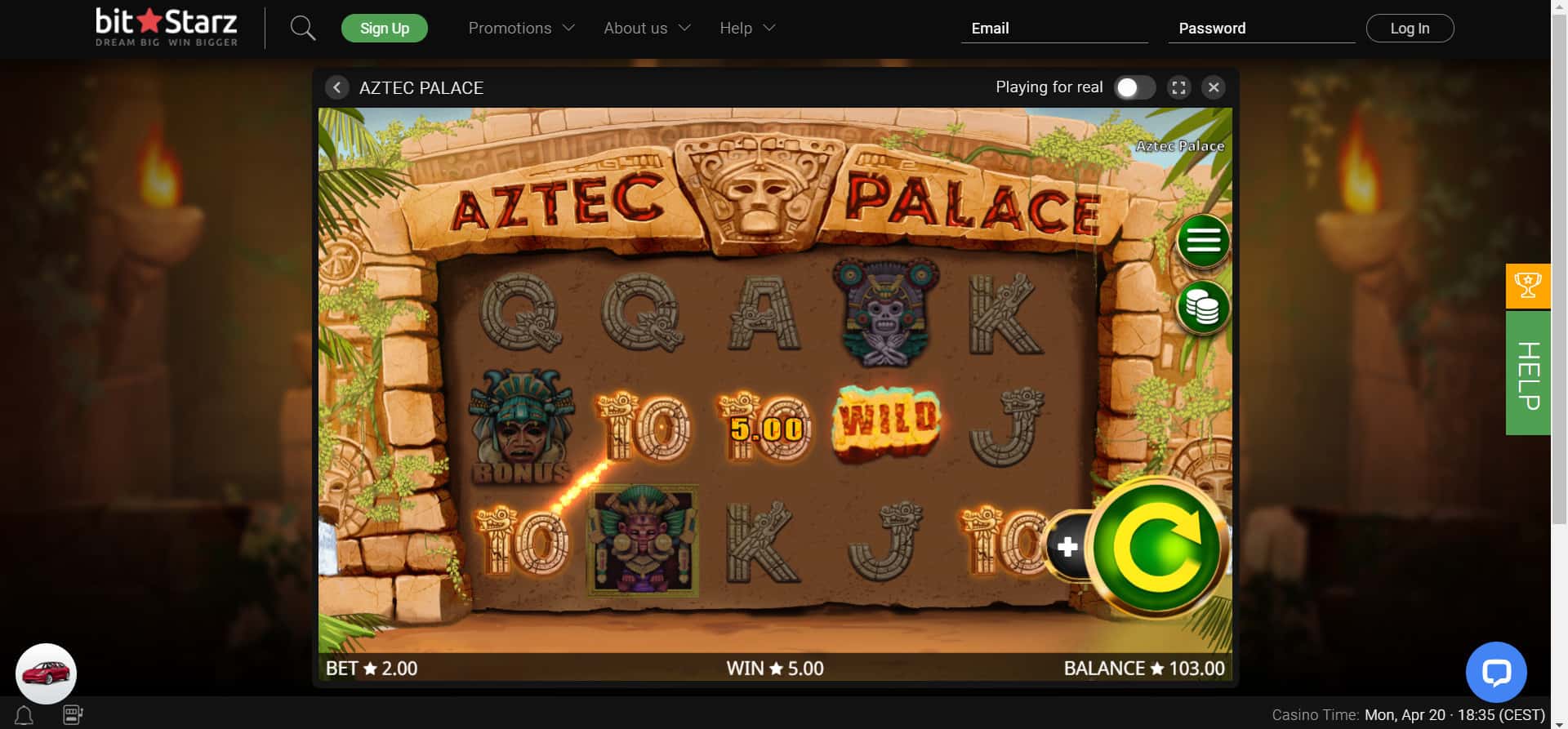
As we’ve briefly mentioned, BitStarz has become such a popular exchange largely because of its huge range of slots games.
Although every online casino has its fair share of slots titles, BitStarz has some of the very best titles from industry-leading game providers. BitStarz slots games are based on a huge amount of themes, from classic fruit reels to the popular TV-show Narcos, and Wild West fantasy games – every slots fan is sure to find a favorite.
Many BitStarz slots games also generate huge jackpots, sometimes worth millions of euros, which one lucky player can scoop up. At any one time, there are at least 20 slots games with massive jackpots available, with most worth a few thousand to tens of thousands of euros!
In February 2023, BitStarz launched Livespins, a new way of playing slot games that adds a social entertainment element to the casino experience. Players can join a Livespins stream, chat with other players, and bet on the action. The platform offers some great community features, including the ability to set a nickname and avatar and a chat function that includes support for dank gifs and reactions to show appreciation to other commenters. Livespins is now available to all BitStarz members.
To find out more about this popular Bitcoin casino site, read our full Bitstarz review.
BitStarz Tournaments and Promotions

Experienced crypto casino players may associate BitStarz with regular tournaments, promotions, and prizes, which are often the biggest and best in the industry – and the most numerous!
If you head over to BitStarz, you’ll see that they currently have three tournament types that run all year round. These are Slot Wars, Table Wars, and Last Man Standing.
As the name suggests, Slot Wars pits players against each other across BitStarz’s huge range of slots games, automatically entering players into a points-based race to the top of the leader board.
The more you wager, the more points you gain. Top players take home a cash prize, with first-place scooping a €300 prize and hundreds of free spins. This is the same for Table Wars, which rewards the top table game players with a huge cash prize of €3,000!
BitStarz also gives players the chance to earn free spins every Wednesday and matches deposits by 50% every single Monday. The casino also regularly runs competitions, such as the chance to win a brand new Tesla car.
Bitstarz have recently upgraded their welcome offering for new players, which is already one of the best in the Bitcoin gambling world. BitStarz have now added the ‘welcome freeroll’, which transforms new players’ 20 free spins into a slice of €1,000 – without the need to make a deposit.
Is BitStarz Safe?
When it comes to fairness, BitStarz takes transparency and provability very seriously. Every game on the casino comes with its own provability widget, which shows players the client seed and hash value for each round of the game.
Players can check this value using a hash calculator, to make sure the game hasn’t been rigged in BitStarz’s favor.
BitStarz doesn’t share details of how their player’s funds are secured within the exchange, however, they do enable two-factor authentication (2FA) through Google Authenticator, which makes logging in and protecting your account much safer.
Overall, BitStarz has a good safety track record, with no major security incidents in its history.
How good is customer service on BitStarz?
BitStarz absolutely excels in customer service, hiring only experienced online casino professionals to handle customer issues and provide 24/7 live chat support throughout your Bitcoin gambling experience.
According to the BitStarz website, all of their customer service representatives must have at least three years’ experience at other casinos before they work for BitStarz. There are also extensive FAQs on the BitStarz website, which will answer most players’ questions.
BitStarz summary
Since its launch, BitStarz has become both the most popular Bitcoin gambling site and a major rival to traditional online casinos. With thousands of innovative games to choose from and a mega-collection of slots games. BitStarz has got enough to entertain even the most demanding of players.
However, if you’re a big sports gambler, you’ll be disappointed to learn that BitStarz doesn’t have a sportsbook feature, nor do they currently support betting on Esports.
Perhaps the most impressive feature of BitStarz is their regular and generous tournaments, jackpots, and promotions, which reward frequent players and keep the casino experience feeling fresh and exciting.
BitStarz’s award-winning customer service team is one of the best in the industry, so if you’re looking for a safe and easy-to-use casino experience, BitStarz is the perfect choice. You can read more about Bitstarz in our extensive Bitstarz Review.
| Pros |
Cons |
|
|
3. FortuneJack
FortuneJack is one of the most well-established Bitcoin gambling sites in the world, first launched in 2014.
Formed by an expert team of real casino professionals, FortuneJack has become a highly-popular Bitcoin gambling spot, loved for its simplicity and the huge range of games.
Players on FortuneJack are currently entered into a raffle to win a Tesla Model 3. For every $20 players wager, they earn one ticket to the raffle.
If you want to play on FortuneJack, you’re going to need cryptocurrency. There’s currently no fiat currency support on FortuneJack, and likewise, you can’t buy cryptocurrency through the casino using a credit or debit card.
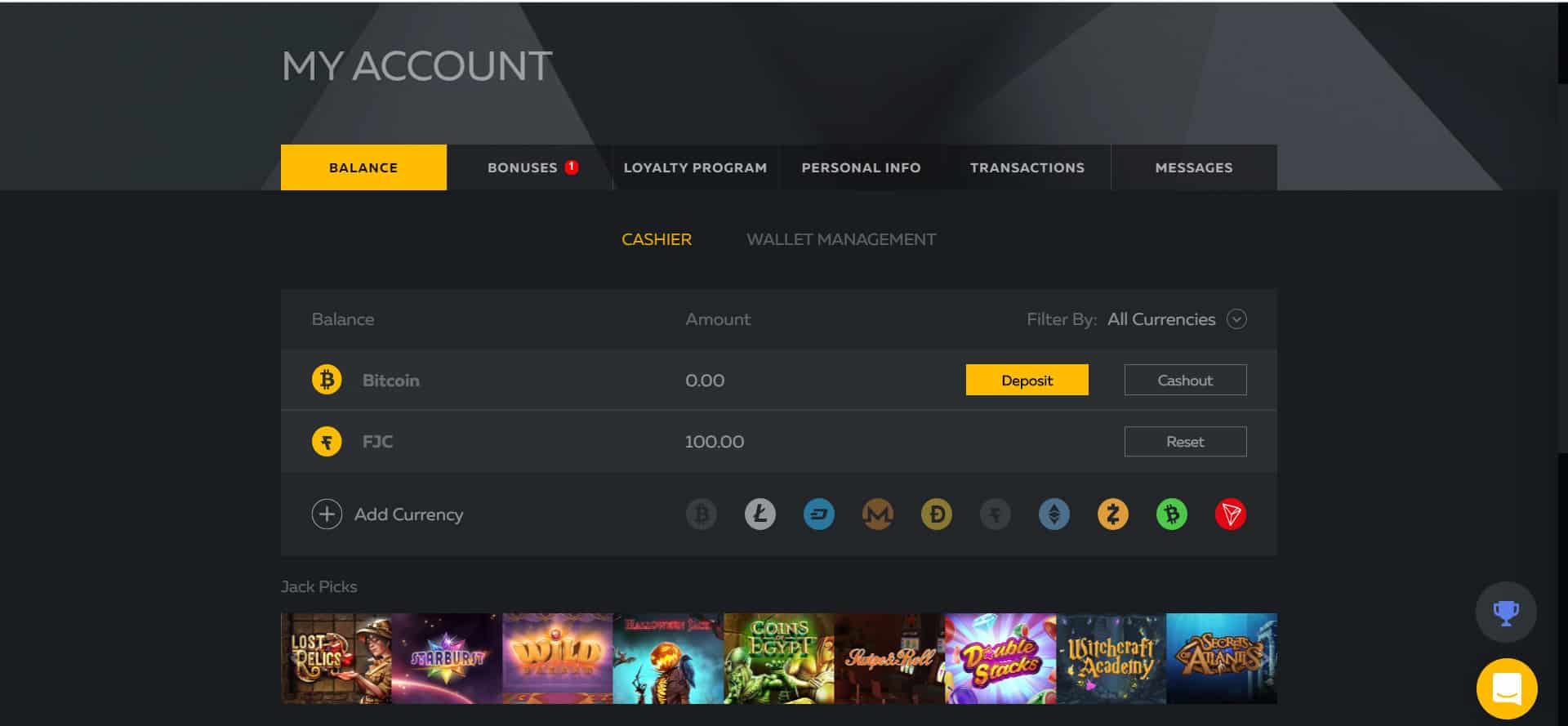
However, as you can see from the screenshot above, FortuneJack does support a wide range of cryptocurrencies which most other casinos featured here don’t. These include:
- Bitcoin (BTC)
- Ethereum (ETH)
- Litecoin (LTC)
- Dash (DASH)
- Monero (XMR)
- Dogecoin (DOGE)
- Tron (TX)
- Bitcoin Cash (BCH)
- Zcash (ZEC)
They also support their own loyalty token, the FJC token, which players earn as they use the casino. The casino currently accepts players from most jurisdictions, however, users from the United Kingdom, the U.S, Australia, Sweden, Spain, and Italy are restricted.
In April 2023, FortuneJack added support for Polygon (MATIC). This layer 2 solution for Ethereum enables users to utilise the cheaper and faster transaction which Polygon offers. Polygon launched in 2017 but has recently been gaining in popularity due to its speed and affordability.
As FortuneJack is a crypto-only casino that doesn’t require identity verification, some users have reported being able to bypass these restrictions using a VPN service.
If you’re a true crypto fan, you’ll love FortuneJack. Let’s discover some of FortuneJack’s best features.
FortuneJack sportsbook
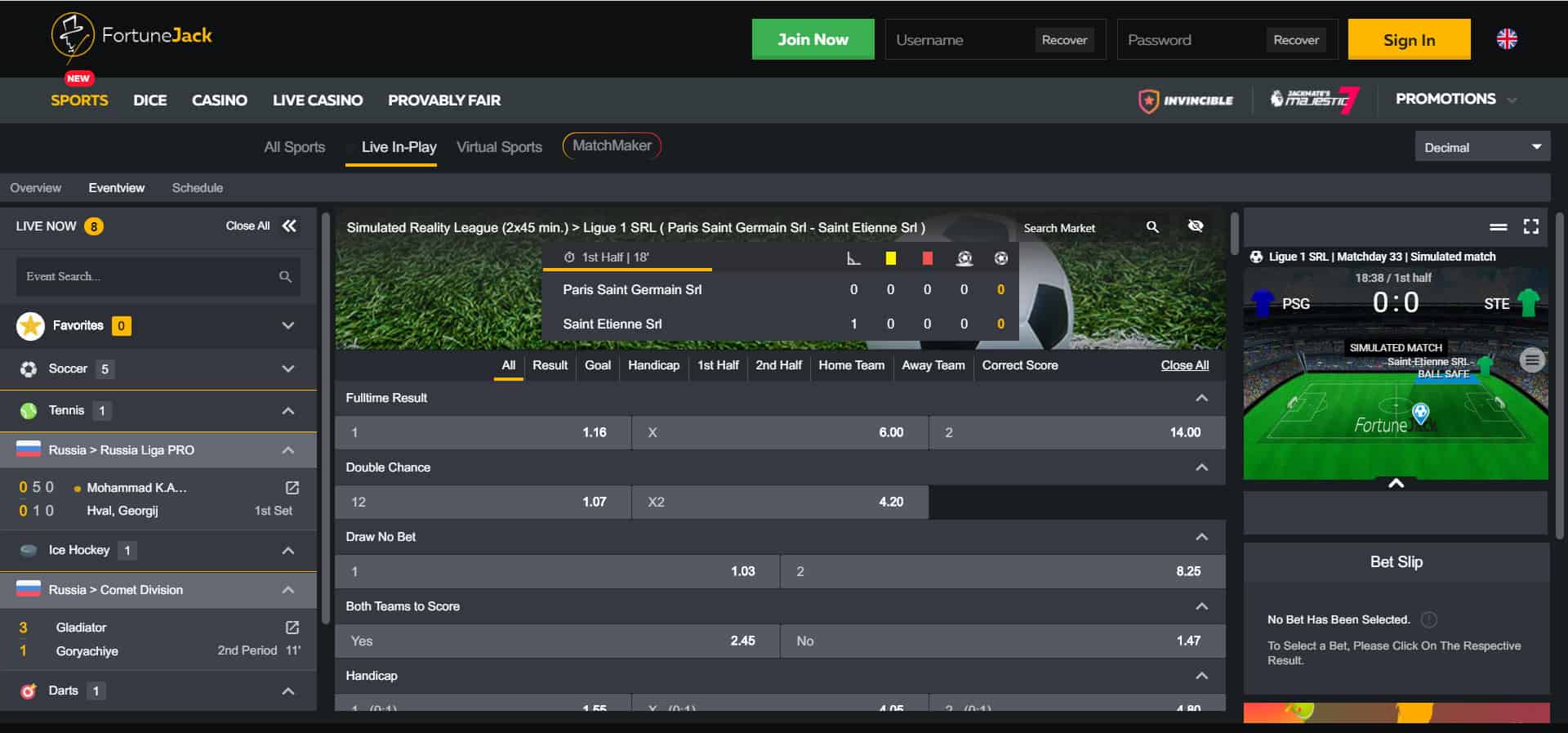
Like traditional betting shops or bookies, online casinos with sportsbook features let players place a bet on live sporting events. Just like regular betting, these bets can be placed on anything from a game outcome, to how many points are scored in the first half.
FortuneJack has an amazing, feature-rich sportsbook, which offers Bitcoin betting on both upcoming sports matches, live in-play games, and virtual sports.
Players can bet on well-known sporting events such as football premier leagues, NBA basketball, and NFL American football; or more niche sports such as table tennis, winter sports, and badminton.
Occasionally, FortuneJack also lets players bet on cultural events, such as the outcome of the next UK general elections.
Since its launch, the FortuneJack sportsbook has become the most popular bitcoin sports betting service, likely because of its user-friendly interface and a massive range of sports. It’s even come to rival that of traditional betting sites, such as Coral and Betfair.
FortuneJack Dice
Dice games have become increasingly popular among Bitcoin gamblers, as their simplicity and high-odds make for an interesting game.
Players can bet Bitcoin, up to a maximum bet of 1 BTC, on the outcome of a virtual dice roll, betting on the roll either being above or below a certain number. Players can set their ‘win chance’, which will decide how likely a certain roll outcome is to occur.
Naturally, as FortuneJack’s dice game is entirely online, players may question if it’s truly random and fair. Luckily, FortuneJack has thought carefully about transparency, and have built a verification system which players can use to track their rolls.
Each roll generates two separate seeds, a server seed and a client seed, which together decide the value of each roll and guarantee it’s not manipulated. Players can then independently inspect the SHA256 hash of the seed to determine if it’s random – and it is, every time.
FortuneJack Casino Games & Live Casino

Aside from their sportsbook and dice features, FortuneJack also has a huge range of slots and table games for a classic casino experience.
FortuneJack’s range of slots games includes both classic titles such as fruit themed games, and also a huge range of 3D slots games which fully engage their players. Their 3D games are fairly unique, with titles based on popular films such as Gladiator and Frankenstein.
The online casino’s live games, of which there are over 45 different titles, are streamed from live tables where dealers give out hands in real-time. These include games like baccarat, poker, blackjack, and roulette, but also specialty game types like Deal or No Deal and Dice Duel.
Is FortuneJack Safe?
FortuneJack only uses cryptocurrency deposits, so there’s no risk of your personal payment information being lifted by criminals in the event of a security breach.
When it comes to web security, FortuneJack uses SSL encryption for player credentials, and the casino hasn’t been hacked or successfully attacked since its launch.
As all of FortuneJack’s games are provably fair, there’s also no risk of being treated unfairly when it comes to odds or placing bets. As a result, FortuneJack is a very safe and secure Bitcoin gambling site to play on!
How Good is Customer Service on FortuneJack?
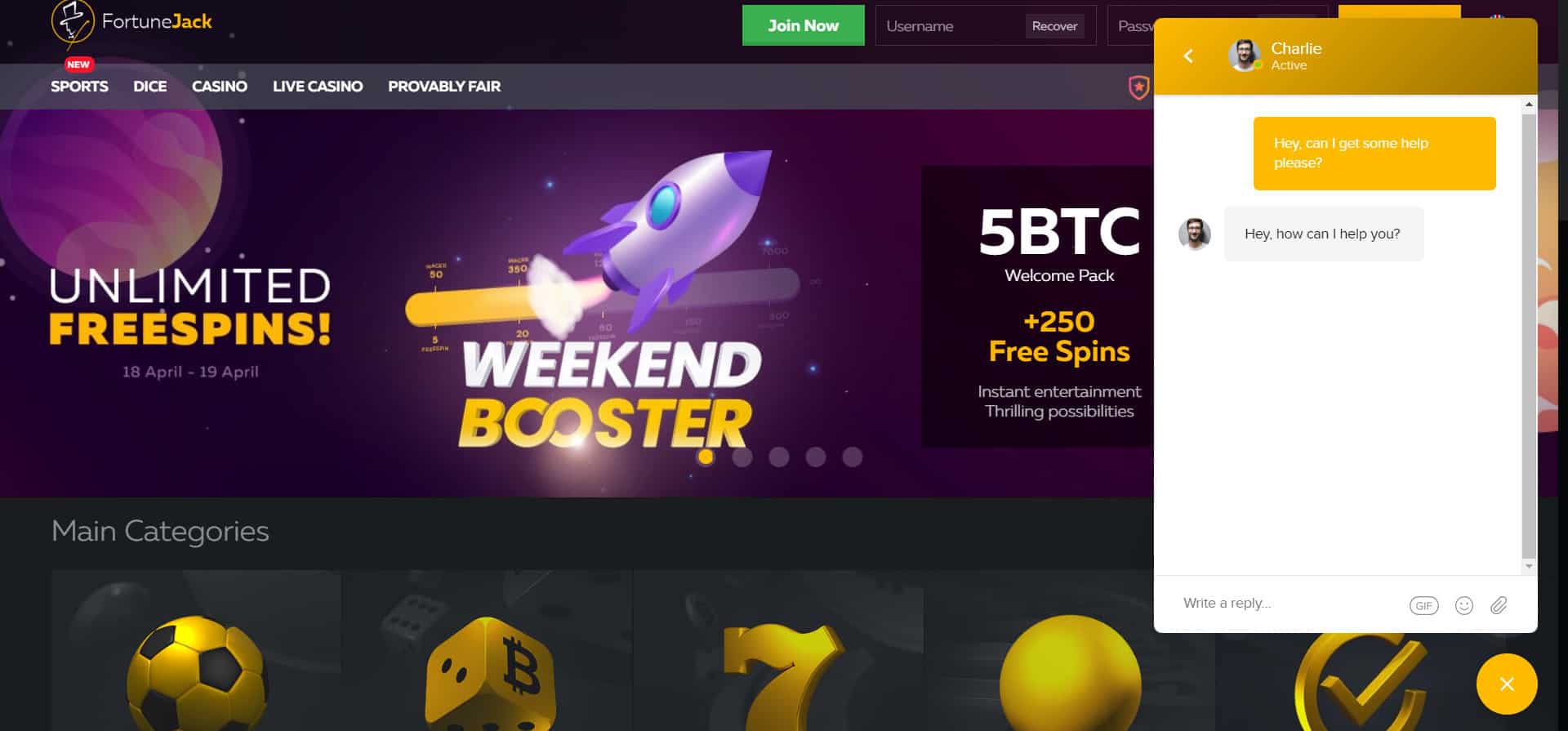
FortuneJack operates a 24/7 live chat feature for players experiencing technical problems, or even those who just want to know more about a certain game.
As you can see from the screenshot above, FortuneJack’s live chat support responds in seconds with a real representative. The casino also has extensive FAQ guides if you need more general help with deposits and withdrawals or games.
FortuneJack have recently launched Jack’s Club, an exclusive club for VIP customers, who can get access to personal VIP managers, better comp points, and better rollover requirements.
Jack’s Club members also get showered with regular gifts – some of which are real tangible rewards – and exclusive games just for members! To join Jack’s Club, players simply have to have been a long time member of FortuneJack, or wager a high amount of cryptocurrency.
The most exciting part of Jack’s Club is that you’ll never know when you’ll become a member – FortuneJack will simply contact you when you qualify! You can read more about what you need to do to become a VIP in their blog post here.
FortuneJack Summary
Overall, FortuneJack is one of the most trusted and provably fair crypto gambling sites in the world. We particularly enjoy their stylish and modern interface, which adds a touch of class to your Bitcoin gambling experience.
FortuneJack’s winning feature is definitely their sportsbook, which has one of the most impressive collections of sporting events of any crypto gambling site. It’s also one of the easiest to use, and their live in-play feature lets you place bets even if you missed the start of a match.
Crypto deposits and withdrawals are easy and quick, and there are no waiting days for payouts on those big wins! In summary, FortuneJack is a great online Bitcoin casino to play, and constantly adds new and interesting games and sports to their casino.
| Pros |
Cons |
|
|
4. Stake
Stake.com has been gaining the attention of crypto gamblers for its feature-rich user experience and attention to detail.
Launched in 2017, Stake.com has a unique, amazing-looking Bitcoin casino.
Stake has a great selection of games including slots, table games, and video poker, plus a huge selection of specialty games, many giving a mere 1% house edge.
Stake.com supports a large range of cryptocurrencies and all withdrawals are free.
Overall, we would highly recommend Stake.
|
Pros |
Cons |
|
|
5. Bitcasino
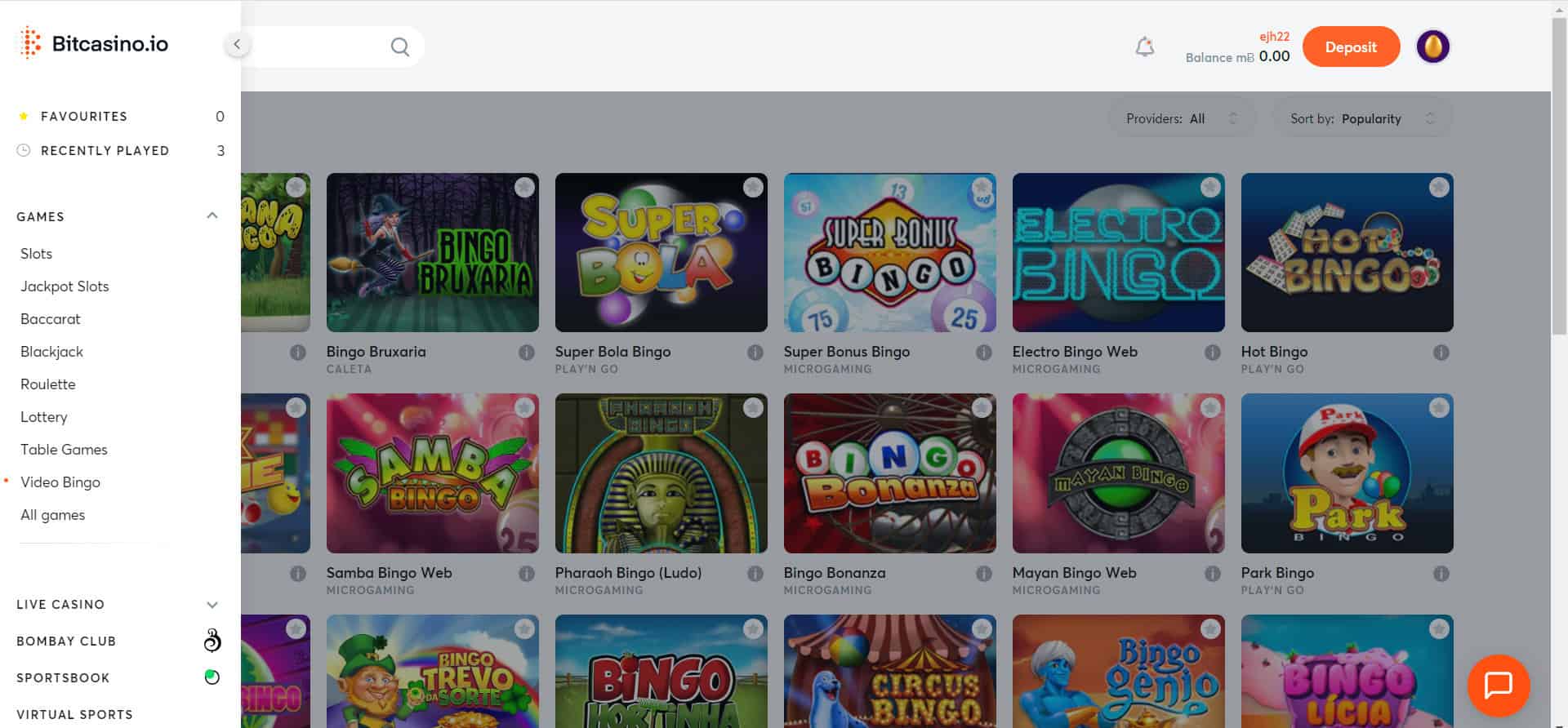
Established in 2014, Bitcasino is a Curaçao licensed online casino, where you can play using multiple cryptocurrencies, including Bitcoin, Ethereum, Tron, Litecoin, and Tether.
In April 2020, Bitcasino announced support for Ripple (XRP), with minimum deposits starting from just 50 XRP, and minimum withdrawals from just 100 XRP.
Users can also deposit and play with Japanese Yen (JPY) using a credit or debit card, so there’s no need to just use crypto if you want to play on Bitcasino. It’s unclear whether Bitcasino also accepts other fiat deposits, but you can buy Bitcoin using a credit card directly through the casino.
Players from Sweden, Switzerland, the UK, the U.S., Netherlands, Spain, Australia, and Italy are currently restricted from using Bitcasino, though all other jurisdictions are welcome.
In late 2019, Bitcasino took part in an environmental initiative to plant 101,000 trees, costing $1 per tree. This was in association with #TeamTrees, and players could pledge their unused loyalty club points to the scheme – so if you’re looking for a Bitcoin casino that’s also committed to doing good, Bitcasino is a great choice.
Bitcasino makes an effort to keep its users informed about recent developments in the cryptocurrency space. It’s refreshing to see a casino with an interest in the cryptocurrency side of the business, having published recent articles such as:
- Serenity is here: Everything you need to know about ETH 2.0
- Crypto in Asia: Top developments for 2021
- Best Bitcoin banks: top Bitcoin-friendly banks you should know
Bitcasino has some really fun and unique games, such as Monopoly Live, multiple lottery games, and a large range of bingo games.
There are also great rewards for regular players through the Bitcasino Loyalty Club, so it’s a casino that’s worth checking out. Let’s take a closer look at some of Bitcasino’s features!
The Bitcasino loyalty and VIP club

One of the features we love about Bitcasio is its loyalty club, where players can grow their rewards as they play in return for awesome prizes and rewards.
With seven levels to progress through, starting at ‘Beginner’ all the way to ‘Hero’, players simply have to place bets in order to gain points. Although it takes some time to reach the top levels, players will be rewarded throughout their journey with free spins, free chips, and even cashback rewards.
Bitcasino’s cashback rewards range from 5 – 10% based on what level you are, and how often you play, but for regular gamblers the Bitcasino Loyalty Club can be a great way to get some extra cash to bet!
There’s also a VIP members area, which is an invitation-only club for dedicated Bitcasino players. Once you’ve been invited to the VIP club, you’ll get access to your own personal assistant, unique offers and promotions, and even get invited to special VIP events.
Bitcasino video bingo

A pretty unique feature of Bitcasino is its ‘Video Bingo’ games. These titles, similar to the original physical game of bingo where players match their numbers to those called by the dealer, are a popular choice among Bitcasino players.
It’s one of only a handful of Bitcoin gambling sites to offer bingo games, and Bitcasino has multiple titles to choose from. Bitcasino’s bingo games range from monkey mayhem themes to crazy circus, and even genie themes!
For those who are used to playing more traditional casino games like roulette and blackjack, bingo can be a fun and light-hearted new gambling experience. Bitcasino is also a great place for regular bingo players who want to try their hand at Bitcoin gambling too, as their games are similar to those found at Mecca or Gala bingo.
Bitcasino lottery
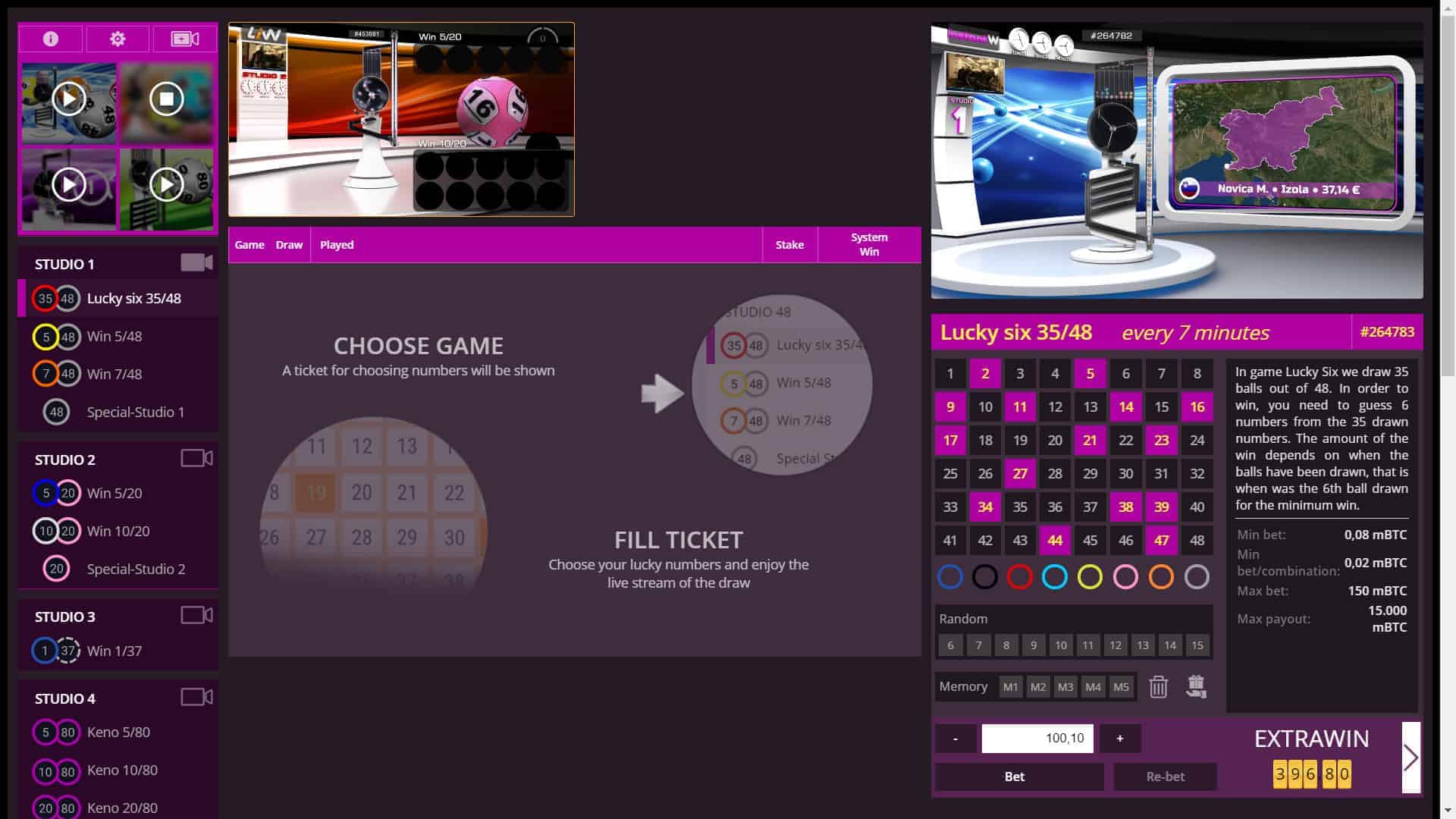
Another niche game type found on Bitcasino that many other online casinos don’t usually offer is a range of lottery games, which just like a traditional lottery lets players choose numbers that are pulled out of a random number generator.
Bitcasino have multiple lottery types, all of which are instant win – meaning the balls are drawn in front of you, and you can win during a single session, no need to wait for a future draw!
Users can either randomly choose how many numbers they want to be selected like a lotto lucky dip, or pick their own winning numbers. It’s a great game type for gamblers who like the thrill of live lottery calls, from the comfort of their own home.
Bitcasino Bitcoin poker
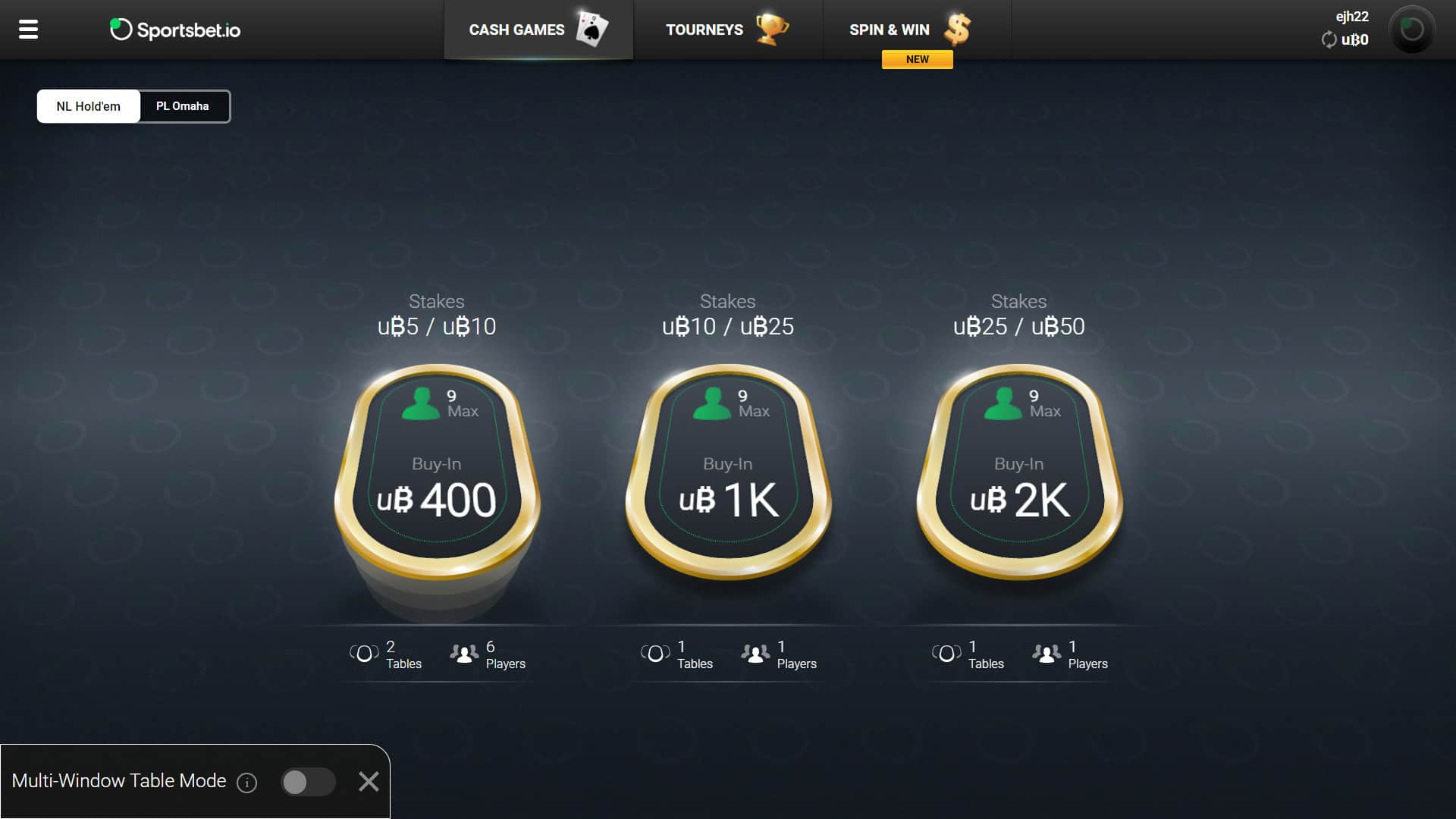
Another popular feature of Bitcasino is its multiplayer Bitcoin poker games, where users can buy-in to live tables and play against other players in real-time across the world.
These games require a buy-in in Bitcoin, which makes the game exactly like sitting and playing at a real poker table. Once you’re in, you can buy chips using Bitcoin, and play as many hands as you like. Other players can join and leave the game as it’s in play.
Is Bitcasino safe?
Bitcasino doesn’t specifically list the precautions they take to protect user’s Bitcoin and crypto deposits, however, they do assure players that their funds are safe.
Nevertheless, without details of Bitcasino’s custody methods, it’s difficult to say for certain how secure deposits are on the casino. That said, there’s never been any loss of funds or hacks of the casino since it’s launch, and it used SSL encryption to protect personal data on the site.
Bitcasino offers its players the option to enable 2FA to log in to their account, through Google Authenticator.
How good is customer service on Bitcasino?
Bitcasino has a dedicated live chat support feature, which like other Bitcoin casinos, makes it easy and quick to get help when you need it.
There are some detailed articles in the Bitcasino help center, but these are a little limited in scope and mainly deal with problems players might have with deposits and payment options.
It’s also not as easy as some other casinos to navigate through help topics, but there’s generally a good level of support, and players can always email the Bitcasino team for further help.
Bitcasino summary
For those who don’t want to navigate exchanges, crypto wallets, and Bitcoin addresses, Bitcasino is a perfect choice – players can simply purchase Bitcoin using their credit card once they’ve made an account. But remember, you will need to validate your identity if you choose this method.
The number of games on Bitcasino is limited compared to some of the other casinos we’ve reviewed here, but it makes up for that with niche lottery and bingo games. Bitcasino’s live poker matches, which function just like a real table game of poker, are a great way for classic casino lovers to buy-in with Bitcoin.
Compared to other crypto casinos like FortuneJack and BitStarz, Bitcasino’s user interface does feel slightly dated, and it’s somewhat more difficult to navigate between the sections and find your favorite games than other casinos.
However, overall Bitcasino is a good crypto casino for those who want access to a decent amount of games and perhaps aren’t as interested in a huge range of slots games.
|
Pros |
Cons |
|
|
Our Verdict
The crypto gambling site you choose will mainly depend on what type of player you are. That said, some of the online casinos we’ve reviewed offer more features than others, or excel in a certain area. Let’s have a look at the best casino’s in each category, then choose an overall winner!
Best crypto gambling sites for slots
For big-time slots lovers, then it’s hard to beat BitStarz huge range of slots titles, who have truly earned their place as the ‘King of Slots’.
Their massive amount of slots games has even drawn players from traditional casinos, earning the Bitcoin gambling site a 10/10 rating on AskGamblers for its huge variety. BitStarz also works with some of the leading game providers in the industry, so there are constantly new titles and types of slots games available to play.
Best site for niche games
If you’re a fan of bingo or lottery games, then Bitcasino is an excellent choice.
Although they don’t have the range of slots that competitors BitStarz and FortuneJack have, their unique game types make this crypto gambling site well worth considering if you’re looking for a change of scene from the usual range of games.
Best sportsbook features
FortuneJack’s sportsbook is easily the best sports betting option for crypto players on the market. Not only does it feature an enormous range of real-life sports to choose from, including all major soccer premierships and games, but it’s also got niche sporting events and even elections to bet on.
FortuneJack is also the best choice if you’re looking for a crypto gambling site that is dedicated to only using cryptocurrencies. With support for 9 different cryptocurrencies, and no need to verify your identity to play, FortuneJack is the go-to exchange for crypto enthusiasts who want to protect their identity.
Cloudbet is a close second when it comes to sportsbook betting, with a similar range of sports on offer, but not quite as many current games and tournaments available to gamble on at the time of writing.
Best casino for Esports
For Esports fans, Cloudbet is the best bitcoin gambling site we’ve reviewed hands-down, as it provides unparalleled gambling access to some of the most popular Esports tournaments in the world.
It’s also an easy way to access Esports betting for crypto investors who aren’t familiar with the industry, as many tournaments aren’t highly televised on mainstream media, so it can be hard to keep up to date with events.
Most secure Bitcoin gambling site
Cloudbet is also a clear winner when it comes to fund security, as they’re the only casino that is highly transparent about their custody solutions and wallet storage. By using cold wallets for the majority of players’ Bitcoin funds, Cloudbet can say with certainty that they’re taking all the necessary steps to protect their customers.
Similarly, in almost 8 years of operation, Cloudbet has never had a significant security breach, which should give peace of mind to players. If you’re particularly security conscious, or you want to use a casino which takes the principles of crypto seriously, Cloudbet is definitely the best option.
Best overall winner
As the Highlander franchise taught us, there can only be one! The overall winner and best Bitcoin gambling site for 2020 is BitStarz!
BitStarz’s huge range of games is impossible to beat, and even the most dedicated players would struggle to get bored with the different games on offer. This, paired with regular tournaments, giveaways, and amazing prizes, combine to make BitStarz one of the most exciting crypto gambling destinations.
Likewise, we just love the speed, friendliness, and professionalism of the BitStarz customer service team. There’s no better service on any gambling site online, which makes BitStarz easy to use even for beginners.
The icing on the cake is BitStarz lighting-fast withdrawal speeds, with 90% of customers receiving their winnings in 10 minutes or less, which is one of the fastest in the entire industry!
Ready to give BitStarz a try? Sign up today for free and start playing from as little as 0.01 BTC!
Key takeaway
Bitcoin gambling is a highly personal experience, and every player has their own favourite game or betting product.
All of the casinos we’ve reviewed here have their own strengths. No matter what crypto casino you choose, remember to have fun and stay safe!
References
-
- BitStarz FAQ
- FortuneJack Knowledge Base
- CloudBet FAQ
- BitCasino FAQ
- Kacy Drudy’s Whitepaper on “Casinos are Financial Institutions?”
- Statista’s Online Gambling Market Size
- Satoshi Nakamoto’s Paper on Bitcoin
- Wikipedia’s History on Online Gambling
- Cardinal’s Outline on Online Gambling Frauds
- UK’s Gambling Commission on Scams and Frauds
Disclosure: Blokt strives to provide transparent, honest reviews, and opinions. The writer of this article is a user of the product(s) or service(s) mentioned in this article and was not influenced by the respective owners.
We rarely run ads, but sometimes earn a small commission when you purchase a product or service via a link on our site. Thank you kindly for your support.
Read more or donate here.
Best Bitcoin Gambling Sites was originally found on Blokt - Privacy, Tech, Bitcoin, Blockchain & Cryptocurrency.
]]>
LINU’s Story LINU’s origin story is one of ups and downs. The project saw massive early hype, reaching a market cap of around $15 million. Investors flocked to LINU, seeing it as a safe haven after losing money in the Terra Luna crash. However, the anonymous developer who created LINU had secretly bought a large […]
The Rise of LINU: Community-Driven Crypto Project Gets Double Exchange Listing was originally found on Blokt - Privacy, Tech, Bitcoin, Blockchain & Cryptocurrency.
]]>
LINU’s Story
LINU’s origin story is one of ups and downs. The project saw massive early hype, reaching a market cap of around $15 million. Investors flocked to LINU, seeing it as a safe haven after losing money in the Terra Luna crash. However, the anonymous developer who created LINU had secretly bought a large supply of tokens early on, only to dump them once the price skyrocketed. This sent the community into a panic, and the price plummeted.
But the LINU community refused to give up. They realized that the underlying smart contract was still safe, with 0% tax on transactions, a renounced contract, and liquidity locked for 75 years. Community leaders took it upon themselves to revive the project, driven by the belief in the power of decentralization.
Since then, LINU has seen impressive growth, crushing obstacles along the way, thanks to the strength and conviction of its community. The mission is clear: to educate investors about centralization risks and prove that community-driven projects can thrive.
Double Exchange Listing
As per the LINU subreddit, this week marks a significant milestone for LINU, with the project set to be listed on two major exchanges: FameEx on March 13th and BitMart on March 14th. The community’s generous donations and unwavering support have played an integral role in reaching this point.
As the crypto world embraces the recent bull run, LINU is poised to be a significant player. By putting the power back in the hands of the community, this decentralized project aims to show the world what can be achieved when people come together, united by a common goal.
The rise of LINU is a testament to the resilience and passion of its community. As centralized organizations continue to crumble due to greed and corruption, LINU stands as a beacon of hope – proof that another way is possible. The journey is just beginning, but one thing is sure: LINU is here to stay, and the community hopes to carry it to new heights.
The Rise of LINU: Community-Driven Crypto Project Gets Double Exchange Listing was originally found on Blokt - Privacy, Tech, Bitcoin, Blockchain & Cryptocurrency.
]]>
Monad represents a transformational shift in decentralized applications and blockchain technology. By unlocking unprecedented scalability and optimizing processing efficiency in a decentralized manner, Monad is redefining the landscape of blockchain networks. Here, we dive into the intricacies of Monad, highlighting its unique features that facilitate improved performance, scalability, and the effortless execution of transactions. Monad: […]
Monad: Ushering a New Epoch in Blockchain Technology was originally found on Blokt - Privacy, Tech, Bitcoin, Blockchain & Cryptocurrency.
]]>
Monad represents a transformational shift in decentralized applications and blockchain technology. By unlocking unprecedented scalability and optimizing processing efficiency in a decentralized manner, Monad is redefining the landscape of blockchain networks. Here, we dive into the intricacies of Monad, highlighting its unique features that facilitate improved performance, scalability, and the effortless execution of transactions.
Monad: A New Era in Blockchain Technology
Founded by Keone Hon, Monad is a next-generation Layer 1 network primed to enhance the blockchain’s scalability like never before. As an Ethereum-compatible smart contract platform, Monad can yield a whopping 10,000 transactions per second (TPS) and deliver Ethereum transactions much more efficiently, courtesy of its impressive parallel execution capabilities.
Monad sets itself apart from traditional blockchain models by opting for parallel over sequential transactions, a visionary move in itself. This facilitates simultaneous transaction execution, leading to optimal network throughput. The MonadBFT Consensus mechanism bolsters this efficiency further by ensuring seamless ordering and execution of transactions with a single block, resulting in unmatched throughput.
Another unique feature of Monad is that it achieves and maintains full compatibility with Ethereum Virtual Machine (EVM) bytecode and Ethereum RPC API. This aspect underlines Monad’s commitment to simplicity and accessibility as it allows EVM developers who contribute to 98% of on-chain TVL across all ecosystems to migrate seamlessly.
Parallel Execution: The Core of Monad
Monad adopts a revolutionary approach with its parallel execution mechanism, thereby processing multiple transactions concurrently. It employs state-of-the-art techniques like Optimistic Concurrency Control (OCC) and Software Transactional Memory (STM) to ensure absolute data integrity and maximum network throughput.
The MonadBFT consensus mechanism accompanies the advanced parallel execution feature. By separating transaction ordering and execution, the network ensures immediate finality in each block. Its compatibility with the Ethereum Virtual Machine (EVM) means that it can be easily integrated.
How is Monad Different?
In the crowded landscape of Layer-1 blockchain platforms, Monad stands tall with its array of unique benefits:
1. High Transaction Throughput: With its ability to process 10,000 transactions per second, Monad significantly outperforms many existing blockchains.
2. Parallel Execution: Monad’s unique execution approach allows for multiple transactions to be processed simultaneously, enhancing network efficiency and reducing latency.
3. 1 Second Finality: Transactions achieve finality almost instantly within each block, thanks to the MonadBFT pipelined consensus mechanism.
4. Ethereum Compatibility: Monad ensures complete compatibility with Ethereum Virtual Machine (EVM), making it easy for developers to port existing Ethereum applications.
5. Optimized for Scalability: With its parallel execution and pipelined consensus, Monad’s architecture has been specifically designed to handle a growing number of transactions and users.
6. Lower Operational Costs: The high-efficiency landscape of Monad potentially leads to considerably lower transaction fees.
What’s to Come?
Monad has attracted hefty investment in its venture to revolutionize blockchain technology. During its seed funding round, Monad Labs reportedly raised a whopping $19 million, primarily funded by Dragonfly Capital. The massive financial boost will be focused on perfecting its Ethereum-compatible smart contract platform and expanding the team’s capabilities.
Monad’s vision for the future is as ambitious as its groundwork – the introduction of its testnet is slated for Q2 2024, a pivotal moment when the platform anticipates making significant strides in blockchain technology. Mainnet is currently expected in late 2024.
As a next-generation smart contract platform, Monad is prime to make a lasting impact on blockchain technology’s future and decentralized applications. Its impressive performance, Ethereum compatibility, and numerous innovations, coupled with Monad Labs’ significant funding round, may prove to be a transformative force in the decentralized application landscape.
Monad: Ushering a New Epoch in Blockchain Technology was originally found on Blokt - Privacy, Tech, Bitcoin, Blockchain & Cryptocurrency.
]]>![A Beginner's Guide to Monero - What Is XMR? [Updated 2023] 39 Beginners guide to Monero 2](https://blokt.com/wp-content/uploads/2019/04/Beginners-guide-to-Monero-2-300x168.png)
In celebration of Monero’s five successful years since launch, I’ve put together a short introductory guide to Monero. Monero’s goal is beautifully simple: a usable cryptocurrency for everyday payments, that functions as users expect. This includes protecting users from network attacks, large-scale surveillance, and most importantly being accessible anywhere. Monero, ticker symbol XMR, was founded […]
A Beginner’s Guide to Monero – What Is XMR? [Updated 2023] was originally found on Blokt - Privacy, Tech, Bitcoin, Blockchain & Cryptocurrency.
]]>![A Beginner's Guide to Monero - What Is XMR? [Updated 2023] 48 Beginners guide to Monero 2](https://blokt.com/wp-content/uploads/2019/04/Beginners-guide-to-Monero-2-300x168.png)
In celebration of Monero’s five successful years since launch, I’ve put together a short introductory guide to Monero. Monero’s goal is beautifully simple: a usable cryptocurrency for everyday payments, that functions as users expect. This includes protecting users from network attacks, large-scale surveillance, and most importantly being accessible anywhere.
History
Monero, ticker symbol XMR, was founded on April 18, 2014, by a Bitcointalk forum user operating under the alias “thankful_for_today.” The project initially called ‘Bitmonero’ was a fresh launch of the ByteCoin and CryptoNote protocols, using their code base.
Although ByteCoin and the CryptoNote technology it was based on had its flaws, it was one of the best privacy solutions available at the time, and subsequently, it attracted many developers and researchers. Shortly after CryptoNote’s creation, the core team forked the project away from the original creator, who wished to continue the project in ways the rest of the community disagreed with.
![A Beginner's Guide to Monero - What Is XMR? [Updated 2023] 41 monero private digital currency](https://blokt.com/wp-content/uploads/2019/04/monero-private-digital-currency.png)
Monero launched with poor mining code, relatively weak privacy, and many other limitations. Over the years, Monero has improved its protocol to make it more robust. Monero added RingCT for much better privacy, set minimum ring sizes, created a vulnerability response process, and implemented bulletproofs.
Now, Monero has succeeded in building one of the largest open-source communities in blockchain and developed a mindset of continual improvement to tackle future challenges. Since its humble beginnings on the Bitcointalk forum, it’s risen through the rankings to count itself among the top 10 cryptocurrencies by market capitalization and is perhaps the most successful privacy coins to date.
So, how have the developers, team members, and the wider community helped contribute to making Monero such a successful project?
Developers and Community
Monero has one of the most active development teams and community. Monero is stewarded by the Core Team, an unregistered organization that handles merge requests and maintains basic community infrastructure. Although the Core Team participates in discussions and helps set the vision, they do not make unilateral decisions. Decisions are usually made on GitHub issues, GitHub pulls requests and IRC meetings.
![A Beginner's Guide to Monero - What Is XMR? [Updated 2023] 42 monero community](https://blokt.com/wp-content/uploads/2019/04/monero-community.png)
The community organizes into semi-autonomous workgroups based on function. Examples include the Community Workgroup, Research Lab, Malware Response Workgroup, Localization Workgroup, and Outreach Workgroup. Users are encouraged to join existing workgroups or to start their own. There is no shortage of work that the Monero project needs help with!
Users and developers are encouraged to ask questions on the Monero StackExchange. Monero has the third most active StackExchange site of any cryptocurrency, behind only Bitcoin and Ethereum. It’s a great resource, and we need the help of all our community members to answer questions.
Privacy-Preserving Technology
Monero is unique in that it is not built on Bitcoin’s code. Instead, it began with the CryptoNote protocol, but it has changed so much over the years that it is essentially its own platform. Monero is by far the largest cryptocurrency built on this code. Monero provides its transaction privacy in three ways: hiding the receiver, sender, and amount.
![A Beginner's Guide to Monero - What Is XMR? [Updated 2023] 43 privacy preserving technology](https://blokt.com/wp-content/uploads/2019/04/privacy-preserving-technology.png)
There is no way to send a Monero transaction that is completely public on-chain. Instead, users can share the view key with select parties to reveal details of the transaction if needed. This group can be as small or large as necessary.
Firstly, Monero hides all addresses by using a stealth address system. Users essentially receive funds in one-time-use safety deposit boxes that only they can open. No other person knows which boxes are assigned to them or how much they hold (if anything).
Likewise, Monero hides the sender by obscuring the source of funds. Ring signatures hide the true spent outputs (these boxes) among others in the blockchain. Furthermore, since these outputs are not associated with specific addresses, observers cannot tell what addresses these outputs are associated with either. Instead, nodes see that transactions are sent from possible sources of funds, which are themselves references to very little. Stealth addresses and ring signatures work together to hide the transaction graph effectively.
Finally, Monero hides the amount with ring confidential transactions (RingCT). RingCT is based on confidential transactions for Bitcoin. Despite its name, this technology merely hides the transaction amount, not all transaction details. Luckily, Monero’s other defenses come to the rescue.
![A Beginner's Guide to Monero - What Is XMR? [Updated 2023] 44 monero mining](https://blokt.com/wp-content/uploads/2019/04/monero-mining.png)
Additionally, Monero has an accessible proof of work mining algorithm that is mineable on CPUs and GPUs. It has an adaptive block size to accommodate large spikes in transaction volume without growing unnecessarily or being trapped in an arbitrary constraint. Monero supports pruning, allowing old transactions to be cut down to about two-fifths of their size. Monero’s privacy, security, and scaling are always improving.
Purchasing and Spending Monero
Monero is a cryptocurrency with high utility and is meant to be used first and foremost for daily transactions rather than held as a speculative investment or store of wealth.
Monero can be bought and sold on many exchanges, including Circle, Poloniex, Binance, Bisq, Bitfinex, and Kraken. Users should make sure that your investment in Monero is also an investment in the community; consider supporting the fundamentals that give the asset value by donating to various community projects at the Community Crowdfunding System.
![A Beginner's Guide to Monero - What Is XMR? [Updated 2023] 45 Monero Community Crowdfunding System](https://blokt.com/wp-content/uploads/2019/04/Monero-Community-Crowdfunding-System.png)
So, where can you spend Monero? As you may imagine, many of the services which accept XMR are also privacy-focused or are in an industry where users may wish to protect their identities. For example, there are a number of crypto casino websites which accept XMR, including CryptoLotto, Bitsler, and MoneroDice; as well as a number of VPN providers, e-cigarette providers, and privacy hardware merchants.
However, it’s not purely privacy-focused services which accept Monero. You can even spend XMR on premium Thai coffee beans from Justroasted, buy portable solar panels from Mobisun, or get crypto themed clothing. Additionally, as Blokt previously reported, Fortnite players can also spend their Monero on the online merchandise store, to buy player skins, weapon mods, and more.
Monero Wallets
You’ve decided you want to buy Monero, but how do you store it? There are a number of options for users looking to securely store their XMR, including an official wallet for Windows, Max, Linux, and FreeBSD. All source code for these wallets is available on GitHub.
![A Beginner's Guide to Monero - What Is XMR? [Updated 2023] 46 monero wallets](https://blokt.com/wp-content/uploads/2019/04/monero-wallets.png)
It should be noted that downloading the official Monero wallet will require users to sync the entire blockchain to their machine. For users who prefer a lite wallet, which is comparatively much quicker to set up, there are a few wallets which are officially recognized by trusted Monero community members. These include Cake Wallet, Monerujo, and Edge wallet for iOS and Android, or MyMonero for desktop users.
Likewise, there’s a dedicated hardware wallet in the works for XMR, funded in part by Monero’s huge community, which would be a Ledger or Trezor type device focused on secure storage of XMR.
How Can You Learn More About Monero?
Monero has many community resources, but one of the best is a free copy of Mastering Monero. This is a good introductory guide for beginners and developers. Those interested in jumping into the granular details can also read Zero to Monero.
![A Beginner's Guide to Monero - What Is XMR? [Updated 2023] 47 learn more](https://blokt.com/wp-content/uploads/2019/04/learn-more.png)
The Monero Community Workgroup holds monthly virtual Coffee Chats where users can ask questions and listen to the latest news. The Revuo, a community-led initiative, covers the biggest events of the week for Monero.
References
- What is Ring Signature?
- What is Ring CT?
- Monero FAQ
A Beginner’s Guide to Monero – What Is XMR? [Updated 2023] was originally found on Blokt - Privacy, Tech, Bitcoin, Blockchain & Cryptocurrency.
]]>![Best 5 Bitcoin Sports Betting Sites [2023] (Analyzed & Approved) 50 Best Bitcoin Betting Sites](https://blokt.com/wp-content/uploads/2020/05/best-bitcoin-betting-sites-300x168.png)
When online betting first emerged, it changed the way players wagered on game outcomes forever, opening the doors to 24/7 betting regardless of where the match or tournament was being held. Now, Bitcoin is shaking up the way we place bets – lowering fees, shortening withdrawal times, and making foreign exchange fees a thing of […]
Best 5 Bitcoin Sports Betting Sites [2023] (Analyzed & Approved) was originally found on Blokt - Privacy, Tech, Bitcoin, Blockchain & Cryptocurrency.
]]>![Best 5 Bitcoin Sports Betting Sites [2023] (Analyzed & Approved) 70 Best Bitcoin Betting Sites](https://blokt.com/wp-content/uploads/2020/05/best-bitcoin-betting-sites-300x168.png)
When online betting first emerged, it changed the way players wagered on game outcomes forever, opening the doors to 24/7 betting regardless of where the match or tournament was being held.
Short on time?
Go straight to our top pick. For the best all-around Bitcoin betting experience, FortuneJack is our top pick.
Now, Bitcoin is shaking up the way we place bets – lowering fees, shortening withdrawal times, and making foreign exchange fees a thing of the past.
![Best 5 Bitcoin Sports Betting Sites [2023] (Analyzed & Approved) 51 Best Bitcoin Betting Sites](https://blokt.com/wp-content/uploads/2020/05/best-bitcoin-betting-sites.png)
But there are so many bitcoin sport betting sites to choose from, that sometimes it’s impossible to find one which is secure, fun to play, and offers a wide variety of sports to bet on.
That’s why we’ve reviewed five of the top bitcoin betting sites for 2023, and we’re going to give you our complete breakdown of their pros and cons.
But first, let’s take a quick look at what Bitcoin sports betting is, and why you should give it a try!
What is Bitcoin Sports Betting?
Like crypto gambling and bitcoin casinos, sports betting (also known as sportsbook) lets you gamble and place bets with cryptocurrencies. The most popular crypto used for betting is Bitcoin, however, there are multiple operators that let you place bets with a variety of cryptocurrencies.
Just like placing bets on traditional sportsbook operators, such as Coral or William Hill, Bitcoin sports betting lets players place a bet on the outcome of a real-world sporting event.
When we say ‘real-world’, we mean any event played competitively between two or more players – because as we’ll find out a little later, you can also use Bitcoin betting to speculate on video game tournaments, or ‘Esports’.
Sometimes, bet makers will let players place wagers on other events, such as the outcome of an election, the results of reality TV series, or even the weather.
Bitcoin sports betting generally offers lower or non-existent fees for deposits and withdrawals, much faster transaction processing times, and greater transparency. This means that players will often get their winnings instantly, without waiting days for withdrawals like on many traditional betting sites.
There are also huge benefits to those who want to protect their privacy online, as most Bitcoin betting websites won’t require personal or payment information from you in order to start playing.
Our Picks – The Top Bitcoin Sports Betting Sites
So, what are the top Bitcoin sports betting sites for 2023? Let’s find out! See our top picks in the table below, or scroll down to read a review of each site.
1. FortuneJack
![Best 5 Bitcoin Sports Betting Sites [2023] (Analyzed & Approved) 57 fortunejack sportsbook](https://blokt.com/wp-content/uploads/2020/04/fortunejacksb.jpg)
Established in 2014, FortuneJack is a hybrid crypto casino and bitcoin betting site, with a massively popular sportsbook feature.
Self-styled as the “number one” bitcoin betting and gambling site, FortuneJack is indeed one of the largest and best-known crypto gambling sites on the web, attracting thousands of users every day.
Unfortunately, FortuneJack restricts access to players from the United Kingdom, Australia, Spain, Italy, Sweden, and the United States – although you may be able to bypass these restrictions with a VPN.
At the time of writing, December 2023, FortuneJack is hosting daily rewards, challenges, and other activities as part of a New Years festivities event.
Which Cryptos Does FortuneJack Support?
You can only place bets on FortuneJack using cryptocurrency. There are no other ways to credit your account, so if you want to start using the site, make sure you know how to buy Bitcoin – if you don’t, follow our guide here.
One of the features many players love about FortuneJack is their huge number of supported crypto assets, which is particularly useful if you have a lot of crypto dust leftover in your wallets. These include:
- Bitcoin
- Ethereum
- Dash (DASH)
- Litecoin
- Dogecoin (DOGE)
- Monero (XMR)
- Bitcoin Cash (BCH)
- Tron
- Zcash (ZEC)
Many of the sites on our list accept a range of different cryptos, which is handy for those who also hold digital assets as a speculative investment – as some days it might make more sense to place a bet with an alt-coin rather than Bitcoin, or vice versa.
FortuneJack Sportsbook
![Best 5 Bitcoin Sports Betting Sites [2023] (Analyzed & Approved) 58 FortuneJack Sportsbook](https://blokt.com/wp-content/uploads/2020/04/fortunejacksports.jpg)
FortuneJack has a hugely comprehensive sportsbook feature, with access to more games and tournaments than most people probably ever knew existed!
Players can place bets on popular football leagues from around the world, such as FIFA, the Premier League, and national leagues like the German Bundesliga and the Belarusian Premier League.
There are also betting opportunities for other popular sports, such as American football NFL leagues, the NBA basketball league, tennis matches, and baseball.
If niche sports are your favorite to place bets on, you won’t be disappointed. FortuneJack offers plenty of choices, including:
- Cycling
- Golf
- Snooker
- Darts
- Volleyball
- Badminton
- Handball
There’s also the opportunity to bet on cultural events, such as upcoming elections, reality TV results, and much more at different times of the year.
With such a large variety of events to choose from, it’s easy to see why FortuneJack has become the most popular Bitcoin betting platform.
Is FortuneJack Safe?
As one of the longest-serving sportsbooks and bitcoin casinos, FortuneJack has built a solid reputation for transparency and safety, both with users’ funds and with the stability of their betting platform.
Deposits and withdrawals are processed instantly on FortuneJack, which is great news following a big win, or when you’re racing to place your bets ahead of a match – there’s no waiting for lengthy bank transfers, and FortuneJack never withholds your winnings.
FortuneJack Verdict
Not only is FortuneJack easy to sign-up and get started with, but it’s also one of the safest and most well-established crypto betting sites – easy to use even for beginners.
Although FortuneJack doesn’t offer Esports betting, it’s Bitcoin sports betting is one of the most comprehensive and feature-rich in the world.
We don’t feel that a lack of Esports makes FortuneJack any less enticing – in fact, it’s the perfect Bitcoin sports betting site for those who know exactly which sports games they want to place a bet on, and want the opportunity to do it in Bitcoin.
2. CloudBet
![Best 5 Bitcoin Sports Betting Sites [2023] (Analyzed & Approved) 59 Cloudbet bitcoin betting](https://blokt.com/wp-content/uploads/2020/04/sportsbetsportsbook-2.jpg)
CloudBet is one of the longest-serving Bitcoin sports betting and casino sites, launched in 2013. The site offers traditional sports betting, Esports, and a large Bitcoin casino which you can read more about here.
The site has recently started offering Bitcoin betting on Esports matches, which has made the site hugely popular, and seriously enhanced the betting experience CloudBet offers.
While CloudBet used to be a true Bitcoin betting site, supporting just two cryptocurrencies – Bitcoin and one of its early forks, Bitcoin Cash, it has now expanded its support with many additional cryptos added. CloudBet now supports BTC, ETH, BCH, USDT, USDC, PAX, PAXG, LINK, DAI, DASH, DOGE, and LTC, along with even more new coins announced in February 2022:
![Best 5 Bitcoin Sports Betting Sites [2023] (Analyzed & Approved) 60 CloudBet Addition Of Crypto Coins](https://blokt.com/wp-content/uploads/2022/03/cloudbet-Addition-Of-Crypto-Coins.png)
CloudBet Sportsbook
![Best 5 Bitcoin Sports Betting Sites [2023] (Analyzed & Approved) 61 Cloudbet eSports sportsbook](https://blokt.com/wp-content/uploads/2020/04/cloudbetmain-1.jpg)
CloudBet was among the first operators to offer Bitcoin sports betting, with their sportsbook feature launching at the same time as their casino in 2013.
Over the past seven years, CloudBet has constantly remained at the forefront of crypto sports betting, offering a huge range of sporting events and all major tournaments.
Major tournaments players can bet on at CloudBet include:
- NBA basketball tournaments
- NFL American football
- Rugby Union matches
- UEFA and other major football tournaments
Players can also place Bitcoin bets on darts, boxing, mixed martial arts, table tennis, and a huge range of other sports on CloudBet.
One of the features we think is particularly useful is CloudBet’s ‘In-Play’ section. This view shows players every single live game taking place around the world, and while games are still in play, CloudBet users have the opportunity to place a bet with the latest odds.
Odds are constantly changing for live games, indicated by green and red flashing bars on the odds table for each game. It’s quite an innovative feature, as it allows players to make the most of opportunities when odds suddenly change.
CloudBet Esports Betting
![Best 5 Bitcoin Sports Betting Sites [2023] (Analyzed & Approved) 62 Cloudbet esports](https://blokt.com/wp-content/uploads/2020/04/cloudbetesports.jpg)
CloudBet’s range of Esports titles is outstanding, which is one of the key reasons the site still remains so popular even into 2023.
Alongside all of the popular Esports titles that other sites offer, such as Dota 2, CS:GO, and League of Legends, CloudBet also lets players place bets on FIFA cyber matches, NBA cyber, and other niche Esports.
The Bitcoin betting site has such a focus on Esports, that they’ve even launched their own dedicated Discord server to discuss upcoming tournaments, share tips about bets, and discuss the outcomes of games.
Is Cloudbet Safe?
It’s fair to say that Cloudbet has one of the most transparent and trusted user safety protocols of any Bitcoin sportsbook.
As we mentioned, Cloudbet is one of the oldest Bitcoin gambling sites, staying true to its roots in the early blockchain scene and sticking to Bitcoin and Bitcoin Cash. When you trust your assets with Cloudbet, they use their hard-earned expertise to keep your funds safe.
They achieve this through dedicated cold storage wallets, which keep your funds offline in highly secure hardware wallets, virtually impervious to would-be attackers and Bitcoin thieves.
Cloudbet only uses hot wallets to process user withdrawals, moving just a fraction of their player’s pool of assets online at any one time. This protects each user against losses, even in the event of an attack.
Cloudbet Verdict
There’s a reason this veteran Bitcoin gambling site has powered on all the way into 2023 – it’s a feature-rich site with a massive range of popular sports, Esports, and unique games to bet on.
If you’re an Esports fan who likes to feel part of the action, then Cloudbet is definitely the place for you, why not check out their Discord server to see which games are in play right now?
Built by blockchain experts, Cloudbet can easily claim to be one of the safest destinations to bet using Bitcoin, and its transparency on fund security is refreshing.
3. Sportsbet.io
With a license in both the United Kingdom as a standard betting site, and in Curaçao for Bitcoin betting, Sportsbet.io is one of the leading Bitcoin gambling and casino sites.
The site is owned by mBet Solutions, the same provider that runs Bitcasino.io, a highly popular crypto gambling site.
The Sportsbet.io team has years of experience delivering sportsbook solutions to traditional fiat betting, and now they’ve pivoted to provide betting solutions for Bitcoin holders.
Sportsbet.io accepts players from multiple jurisdictions and offers free cryptocurrency deposits and withdrawals.
Which Cryptos Does Sportsbet.io Support?
Like other crypto betting sites on our list, Sportsbet.io supports a range of cryptocurrencies in addition to Bitcoin.
Players can deposit and play with the following cryptocurrencies:
- Bitcoin (BTC)
- Ethereum (ETH)
- Litecoin (LTC)
- Tron (TRX)
- Ripple (XRP)
- Tether (USDT)
It’s easy to create an account on Sportsbet, and all you need to provide is your email to get started – so there’s no need to reveal your personal information.
Sportsbet.io Sportsbook
![Best 5 Bitcoin Sports Betting Sites [2023] (Analyzed & Approved) 63 Sportsbet Bitcoin betting](https://blokt.com/wp-content/uploads/2020/04/sportsbetmain.jpg)
With one of the largest sportsbook features of any Bitcoin betting site, Sportsbet.io offers some of the best opportunities for players who enjoy betting on anything from huge football matches to chess tournaments, or even horse racing.
Sportsbook.io has created an attractive and easy-to-use Bitcoin sports betting platform, which has one of the best user interfaces out of all the Bitcoin betting sites. Along the top of the site, there’s an easy-to-navigate bar where players can access all of the sports betting options.
It’s easy to see the odds of any bet, and players can also place multiple bets at one time using Sportsbet’s ‘Multibet’ feature – which makes it quite easy to set all your bets for the day at once.
Sportsbet.io Esports
Esports stands for ‘electronic sports’, and covers any game or tournament played through video games rather than a traditional ‘real-life’ game. A huge and growing spectator sport, in 2019 an estimated 1.57 billion people watched at least one Esports match.
These multiplayer games, where single players or teams compete for huge cash prizes, are becoming a popular game type to place bets on, and cryptocurrency lends itself particularly well to this new digital sport.
Sportsbet.io were among the first Bitcoin betting sites in the world to offer players bets on Esports titles, first for eSoccer – virtual football games played around the world – and more recently they’ve added a whole host of other popular Esports titles.
Now, Sportsbet offers multiple major Esports games that players can place a bet on, including:
- CounterStrike: GO (CS:GO)
- Defense of the Ancients 2 (DOTA 2)
- King of Glory
- League of Legends
- Rainbow Six
- StarCraft 2
Placing a bet on an Esports game is similar to other real-life sports betting, and players can also place bets mid-game through Sportsbet.
Is Sportsbet.io Safe?
As part of the mBit group, Sportsbet.io is considered one of the most professional and safe Bitcoin sports betting sites in the world.
The site is registered in the Isle of Man and regulated by the UK Gambling Commission – one of the strictest and most trusted gambling regulatory bodies in the world, so customers can rest assured that they are protected when playing.
Likewise, Sportsbet’s regulated nature means it’s open to players in the United Kingdom through the Sportsbetio.uk site, which many other Bitcoin betting sites aren’t. If you need a hand, Sportsbet.io offers 24/7 live chat support to all customers.
Sportsbet.io Verdict
Sportsbet.io is a feature-rich Bitcoin betting site, with plenty of game options, tournaments, Esports, and sportsbook features to keep players entertained.
The winning feature of Sportsbook.io has to be its regulation status. As one of the few Bitcoin betting sites registered and regulated in the UK, it’s not only one of the safest sites, but it’s also open to UK players without jumping through hoops – a huge plus.
4. Stake.com
![Best 5 Bitcoin Sports Betting Sites [2023] (Analyzed & Approved) 64 Stake.com Bitcoin betting](https://blokt.com/wp-content/uploads/2020/04/stake.commain.jpg)
Launched in 2017, Stake.com is one of the youngest Bitcoin sportsbook sites on our list. The site offers a massive range of Bitcoin sports betting, as well as a casino section dedicated to crypto gambling, with a decent range of games.
Originally a pure Bitcoin casino, Stake.com launched its brand-new sportsbook feature in December 2019 after signing a two-year deal with Sportradar – a leading sports data company based in Switzerland – to license their Betradar software.
Players will immediately notice that Stake.com is one of the most modern-looking and visually-appealing Bitcoin betting sites, with a really simple and intuitive user interface – making this Bitcoin sportsbook site perfect for beginners.
So, is this newcomer to the Bitcoin betting space poised to be a serious competitor in the future? Let’s find out.
Which Cryptos Does Stake.com Support?
Like some of the other crypto betting sites on our list, Stake.com only supports payments in cryptocurrencies on their site – there are currently no ways to credit your account in fiat.
But, players can credit their account in a range of cryptocurrencies, including:
- Bitcoin
- Ethereum
- Litecoin
- Ripple
- Tron
- BitcoinCash
To start playing, you only have to provide a username, password, and email address, so there’s no need to give away your personal information if you’d rather preserve your privacy.
Alternatively, you can easily signup with Facebook, Google, or Twitch.
Stake.com Sportsbook
![Best 5 Bitcoin Sports Betting Sites [2023] (Analyzed & Approved) 65 Stake.com sportsbook](https://blokt.com/wp-content/uploads/2020/04/stake.comsportsbook.jpg)
As Stake.com’s sportsbook is operated by Betradar, there’s always live games and plenty of betting options to choose from.
Because of their partnership, even though Stake’s sportsbook feature is brand-new, it’s incredibly well designed and easy to use.
Likewise, all of the game data is pulled directly from Betradar, providing one of the most up-to-the-minute coverage of all major sporting events.
Stake.com also regularly has betting bonuses, such as double winnings on certain games, which are fairly rare among the other Bitcoin betting sites we’ve looked at.
Stake.com Esports Betting
![Best 5 Bitcoin Sports Betting Sites [2023] (Analyzed & Approved) 66 Stake.com eSports betting](https://blokt.com/wp-content/uploads/2020/04/stake.comesports.png)
If you’re a big Esports fan, then Stake.com is well worth checking out. The site features some huge Esports leagues and tournaments from some of the leading competitive games in the world.
The full list of Esports tournaments you can bet on at Stake.com includes:
- Counter-Strike
- Dota 2
- League of Legends
- King of Glory
- Rainbow Six
- Starcraft
Is Stake.com Safe?
Stake.com is a Crypto Gambling Foundation verified operator, which is committed to providing provably fair and transparent betting.
There’s no mention of how users’ funds are stored safely on Stake.com, however, its partnership with Sportradar, one of the industry’s largest sports betting operators, is a good sign that the betting site takes its technology seriously.
Nevertheless, as Stake.com is still a fairly new and unproven Bitcoin betting site, players should use caution before transferring a large amount of crypto to the platform.
Stake.com Verdict
It’s still early days for Stake.com’s sportsbook, but overall the betting site is shaping up to be one of the most exciting places to place bets in Bitcoin.
We really loved Stake.com’s interface, which was no-frills and easy to navigate, great for beginners or experienced users alike.
With its professional backing by Sportradar, Stake.com is sure to continue innovating and providing quality sportsbook content over the next couple of years.
5. 1xBit
![Best 5 Bitcoin Sports Betting Sites [2023] (Analyzed & Approved) 67 1xBit Bitcoin betting](https://blokt.com/wp-content/uploads/2020/04/1xbitmain.jpg)
Established in 2016, 1xBit.com has grown into one of the most popular destinations for crypto sports betting, mainly due to its huge range of supported cryptocurrencies and massive event coverage.
Bets on 1xBit.com are placed entirely in cryptocurrency, and there’s currently no way to place bets using fiat, but this is perfect for those looking to preserve their privacy.
1xBit.com offers no-fee deposits and withdrawals for players, an attractive feature that makes betting with Bitcoin an even more cost-effective way to play.
Which Cryptos Does 1xBit Support?
There’s a huge range of crypto’s supported on 1xBit, over 20 in total, including large market cap cryptos such as:
- Bitcoin (BTC)
- Bitcoin Cash (BCH)
- Ethereum (ETH)
- Monero (XMR)
- Litecoin (LTC)
- Dash (DASH)
- Ripple (XRP)
Users can also credit their account with smaller market cap coins like NEM and Verge, and even stablecoins such as Tether (USDT).
Players can deposit through LocalBitcoins.com, Crex24, CoinCheck, NovaDAX, Luno, and over 50 other crypto payment providers.
1xBit Sportsbook
![Best 5 Bitcoin Sports Betting Sites [2023] (Analyzed & Approved) 68 1xBit Bitcoin Sportsbook](https://blokt.com/wp-content/uploads/2020/04/1xbitSportsbook.jpg)
Gamer’s looking to place a bet on a sporting match will be spoilt for choice on 1xBit, with a massive variety of both popular and niche games to bet on.
1xBit enables Bitcoin betting on major sporting events such as football, tennis, rugby, basketball, and American football, but also other game types which have typically been favorites among bettors, including:
- Horse racing
- Greyhound racing
- Boxing
- UFC tournaments
- Motorsports
- Golf
- Cricket
- Darts
There’s also plenty of other niche sports players can place bets on, like surfing, hurling, sailing, chess, and water polo to name a few. In total, 1xBit offers Bitcoin sports betting on over 30 different sporting events.
Special Bitcoin Betting on 1xBit
Another popular feature of 1xBit is their sometimes weird and wonderful collection of specialty betting opportunities, some of which can’t be found anywhere else!
These include crazy wagers such as ‘Company to put human beings on Mars first?’, where players can bet big on the likes of SpaceX, Blue Origin, Boeing, or the US Space Force; or even totally out of this world bets such as the discovery that the Earth is flat by 2025!
However, 1xBit’s bets aren’t all that crazy. There are also some very timely and relevant betting opportunities, such as whether there will be a creation of a COVID-19 vaccine by May 2022, or whether Eminem will appear to give a 30-minute video concert to his fans during Coronavirus lockdown.
The huge number of specialty bets is a unique feature, which makes 1xBit.com stand out among competitors, despite having many of the same Esports and sports titles.
1xBit Esports Betting
![Best 5 Bitcoin Sports Betting Sites [2023] (Analyzed & Approved) 69 1xBit.com sportsbetting](https://blokt.com/wp-content/uploads/2020/04/1xbitesports.jpg)
Like other bitcoin betting sites on our list, 1xBit.com also offers players the opportunity to place bets on Esports matches.
1xBit features betting for both electronic versions of traditional sports, like football tournaments and basketball, and also a huge range of video game tournaments – over 300 separate leagues to choose from at the time of writing.
There cover most major Esports titles, including:
- CS:GO
- DOTA 2
- King of Glory
- League of Legends
- Overwatch
- Rainbow Six
- StarCraft 2
Is 1xBit Safe?
There’s not much information about 1xBit’s safety practices and fund custody on its site, which may be a little off-putting at first.
However, we think the betting site, which has been running for over four years without a security breach, is generally a safe and secure site to use, with good user reviews overall.
It’s also very easy to get hold of a 1xBit customer service representative through its live chat feature, which is very useful if you run into an issue while placing a bet.
1xBit Verdict
If you’re a more advanced Bitcoin betting enthusiast, then you’re probably going to love 1xBit.com. Its massive range of betting options really goes above and beyond the standard Bitcoin sports betting, so it’s suitable for regular players looking for something a little different.
However, as 1xBit.com is quite crypto-heavy, and offers a lot of different betting options, it’s probably going to be a little overwhelming for players who are brand-new to the Bitcoin betting world.
We also think that 1xBit’s interface is a little busy, with many major features slightly harder to find than other sites.
Which Is the Best Bitcoin Betting Site for You?
So, who takes home the crown? Let’s take a look at which site comes out on top for a few different features, and then name an overall winner.
Largest Variety of Betting Options
If you’re looking for Bitcoin betting with a little more variety, you’re going to want to check out 1xBit.com. We highly recommend their special betting types, which are totally unique and definitely sure to inject a little bit of fun into your betting experience!
Similarly, 1xBit.com has the most supported cryptos of any site on our list. If you’re an alt-coin maximalist, or you don’t want to spend your Bitcoin, you can still access 1xBit’s huge range of betting options through another digital asset.
Overall, 1xBit.com wins for variety, but it’s mainly suited to experienced players.
Easiest to Use
FortuneJack is without a doubt one of the easiest Bitcoin sports betting sites to navigate and use. Their simple interface will be highly familiar to players who are already used to traditional betting sites, and it’s easy to place bets and create an account.
Looks-wise, Stake.com has also created both an easily navigable and visually exciting betting site, which focuses on simplicity and usability – and it looks great on mobile too. There’s a handy button to show all live games in the top left-hand corner, which makes tracking the status of your open bets incredibly easy.
Stake.com’s chat feature, which connects you with other live players on their site, is also a very fun feature that we think other bitcoin betting sites could learn from, and it’s a great way to pass the time while you’re waiting for a bet to settle or a match to finish.
For beginners, Stake.com is a perfect choice, as the options are slightly more limited than FortuneJack, so you can learn the Bitcoin betting ropes with ease.
For intermediate and advanced players, FortuneJack is definitely the perfect choice.
Most Secure
CloudBet is one of the most secure Bitcoin betting sites, guaranteeing high-level fund security for users deposits. Likewise, their long track record of delivering an excellent and safe sportsbook experience is a massive attraction to some users.
We think that other Bitcoin sports betting sites could learn from CloudBet and be upfront with users about how funds are stored when they’re on the platform, as most other sites don’t communicate this – which could be off-putting for some crypto enthusiasts.
FortuneJack is also a highly trusted and safe betting site, with an impeccable security record and a dedicated customer service team on hand to help with any issues.
Which Is the Best Site for Sports Betting?
For an all-around great Bitcoin sports betting experience, FortuneJack is our overall winner. Its position as one of the leading and most-trusted bitcoin betting sites has been solidified through access to a massive range of sports and tournaments, as well as a good variety of niche sports.
FortuneJack doesn’t currently have an Esports section, which is slightly disappointing given the growing popularity of video game tournaments, and the huge amount of spectators who tune-in globally to watch them.
Nevertheless, it’s long-running position as the leading Bitcoin sportsbook, alongside its regular addition of innovative features and a seamless user experience, puts FortuneJack firmly in first place.
If you’re looking to start your Bitcoin betting experience, we’d highly recommend giving FortuneJack a try!
Disclosure: Blokt strives to provide transparent, honest reviews, and opinions. The writer of this article is a user of the product(s) or service(s) mentioned in this article and was not influenced by the respective owners.
We rarely run ads, but sometimes earn a small commission when you purchase a product or service via a link on our site. Thank you kindly for your support.
Read more or donate here.
Best 5 Bitcoin Sports Betting Sites [2023] (Analyzed & Approved) was originally found on Blokt - Privacy, Tech, Bitcoin, Blockchain & Cryptocurrency.
]]>
The Internet is no longer a safe place. Sometimes it seems that the Internet was designed to make it easy for governments, businesses, and snoops of all sorts to spy on regular people. So it is no surprise that vast numbers of people are using VPNs to protect themselves. But even the best commercial VPN […]
How to Make & Setup A VPN Server – 2023 In-Depth DIY Guide was originally found on Blokt - Privacy, Tech, Bitcoin, Blockchain & Cryptocurrency.
]]>
The Internet is no longer a safe place. Sometimes it seems that the Internet was designed to make it easy for governments, businesses, and snoops of all sorts to spy on regular people. So it is no surprise that vast numbers of people are using VPNs to protect themselves.

But even the best commercial VPN services have their weaknesses. That’s why more and more people are looking to create their own VPN.
In this article, we’ll look at the various reasons to set up your own VPN as well as reasons not to do so. We’ll also talk about three ways to get the job done and look at one of them in more detail.
By the end of this article, you should have a good sense of whether or not setting up your own VPN makes sense for you, and which approach you would like to take.
Reasons to Setup Your Own VPN
There are lots of reasons to use a VPN in today’s world. But since you are here, we assume you already know why you need a VPN. We further assume that you are trying to decide between using a commercial VPN Service like ExpressVPN or NordVPN or creating your own VPN.
To help you make that decision, here are some good reasons to setup your own VPN instead of subscribing to a commercial service:
- You want the benefits of a VPN Service without the monthly payments.
- You don’t want to take the chance that your online activities will be logged by a VPN Service. (Although, services like ExpressVPN have proven themselves to be zero log time and time again in various legal battles)
- You want access to your home network from anywhere in the world.
- You want access to local resources (your home Netflix account, for example) when you are in a different geographic location.
- You want to give other people access to resources on your home network.
Reasons Not to Setup Your Own VPN
While there are some good reasons to set up your own VPN, there are also a lot of reasons not to do so. These include:
- You don’t have a fast Internet connection – You need both fast upload and download speeds wherever your VPN Server is located or it will slow down everything connected to your personal VPN.
- You need a VPN to connect to resources in other geographic locations – VPN Services with multiple servers let you make it appear you are located in any of dozens, even hundreds of locations around the world. Since your VPN would have only one server you can only appear to be located in one place.
- You want to hide your IP Address – If you build your VPN Server on your own hardware, it will have an IP Address associated with your home network.
- You don’t want to handle the maintenance – It falls on you to maintain and update the VPN Server as well as the hardware and software it runs on.
- You have to have the technical ability to set up the VPN Server and clients.
- You want to hide your payment and identity information fully. The VPN you setup yourself might be safe from logging, but if you purchased the server you tunnel through, with your real name and payment details you are much more vulnerable than using a VPN service.
VPN Basics
If you are considering setting up your own VPN, you’ve probably got all the basics down already, but just in case, we’re going to start at the beginning. If you are clear on this stuff already, go ahead and skip ahead to, “Three Ways to Setup a VPN of Your Own.”
When you connect your device to an Internet resource without a VPN, the contents of the messages going back and forth are potentially visible to snoops. In addition, for the Internet to know where to send the messages, each message must expose a header that contains your IP Address as well as the IP address of the Internet resource you are connected to.

So everything is visible to snoops with the right tool.
Many Internet resources try to stop snoops with HTTPS. This is an Internet protocol that automatically encrypts the contents of messages. This can definitely help since it prevents snoops from seeing the contents of the messages going back and forth.
But HTTPS doesn’t do anything to prevent snoops from seeing that you (a device at your IP Address to be more precise) are communicating with that particular Internet resource. Using a VPN eliminates this problem. Here’s why:
A VPN addresses this problem by putting a VPN Server in the middle of the conversation. The VPN Server sits between your device and an Internet resource. Your device only connects to the VPN Server. The Internet resource only connects to the VPN Server. The VPN Server passes messages back and forth between your device and the resource.
This helps because the VPN Server uses its own IP Address when communicating with the resource on behalf of your device. Anyone spying on the connection between the server and the resource would only see the IP Addresses of the VPN Server and the Internet resource. Your privacy is protected on this part of the connection because no one looking at this connection can see your IP Address.
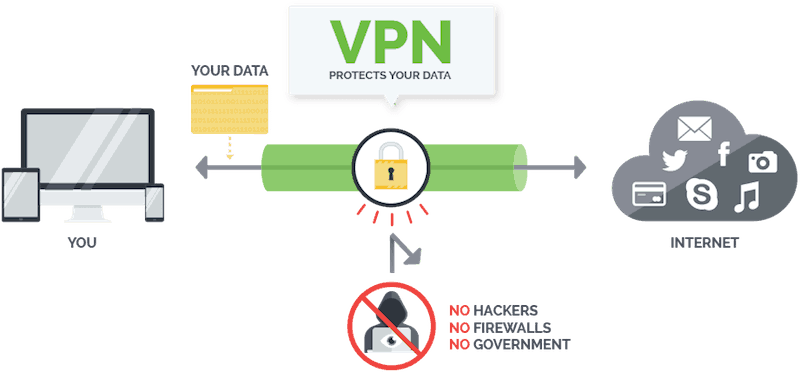
But that still leaves the connection between the VPN Client and the VPN Server. To address this part of the problem, the client and server encapsulate messages passing between them. That is, they encrypt the entirety of the messages between the device and the resource. Then they include the encrypted messages inside another message. This second message is what goes back and forth between the client and the server.
The advantage of doing this is that only the second message’s header information needs to be visible to the world. And all that message’s header can reveal is that your device and a VPN Server are communicating with each other. Snoops can’t see anything of the original message because the whole message, including the header, is encrypted in the body of the outer message.
At the VPN Server, messages coming from your device are extracted from the body of the outer message and decrypted. Then, in the header of your device’s message, the IP Address of your device is replaced by the IP Address of the VPN Server. This modified message is what gets sent to the Internet resource.
Messages coming from the Internet resource arrive at the VPN Server. There, the IP Address of the VPN Server gets replaced by the IP Address of your device. This modified message then travels down the tunnel to the VPN Client in your device, where it is extracted, decrypted, and passed along to your device as if the VPN wasn’t in the middle of everything.

As we’ve just seen, the VPN Server is the core of a functional VPN. In the rest of this article, we will look at ways to set up your own VPN Server and ignore the VPN Client. There are two reasons for this.
- The VPN Server you set up will dictate how you need to set up your VPN Clients.
- There are way too many devices you can connect to your VPN. If we tried to talk about the VPN Clients for each we would never finish writing this article.
As it turns out, setting up your own VPN Server is plenty complicated enough for one article. We’ll start exploring this topic by looking at the three ways to set up a VPN server of your own.
Three Ways to Setup a VPN Server of Your Own
There are three ways to setup your own VPN Server. The way you go will depend on what you plan to do with the VPN and what hardware you will be using. You can set up the VPN Server:
- On your router – If you are using a router with built-in VPN capabilities, or your router supports custom firmware like DD-WRT or OpenWrt, you can set up the VPN Server on your router.
- On your own computer – If installing the VPN Server on your router isn’t an option, you can set up a VPN Server on a spare computer, even something tiny and low-powered like a Raspberry Pi. This is relatively easy to do, particularly if you use a computer running Microsoft Windows, which has built-in VPN capabilities. Of course, if you go this route, you will need to keep the computer that hosts your VPN Server running whenever you want to use the VPN.
- On a cloud service – This approach doesn’t require you to have any additional hardware. However, if you host your VPN Server on a cloud service, you need to keep in mind that the cloud service will be able to see whatever you do with the VPN.
Let’s look at each of these options in more detail.
Setting Up a VPN Server on Your Router
Some home and business routers have a VPN Server built right into them. To use it, you simply need to log into the router, then turn on and configure the VPN Server. If your router has this capability, the manual that came with it should give you instructions on how to activate it. If not, a search formatted something like this should lead you to those instructions:
Router name VPN configuration
A more common situation is where your router doesn’t have a built-in VPN Server but “supports” one. This typically means that you can install third-party firmware on the router and that when the right firmware is installed, the router will be able to function as a VPN Server.
Three types of third-party router firmware are the most popular. These are:
Not all routers support these firmware packages. To find out if yours does, you’ll either need to dig through your router’s documentation or check the site of the firmware you want to use.
- DD-WRT has a Router Database where you can search for your router to see if it is supported.
- The main Tomato page linked above lists the routers that are known to work with this firmware.
- OpenWrt has a Supported Devices page with the information you need.
Even if your router does support one of these firmware packages, installing new firmware on a router is not a job for a computer beginner. While the sites provide detailed instructions for installing their firmware, there is a lot more involved than running an install program.
And one possible result of making a mistake is turning your router into a useless piece of junk that you can only throw away.
Here’s a high-level view of the DD-WRT installation process:
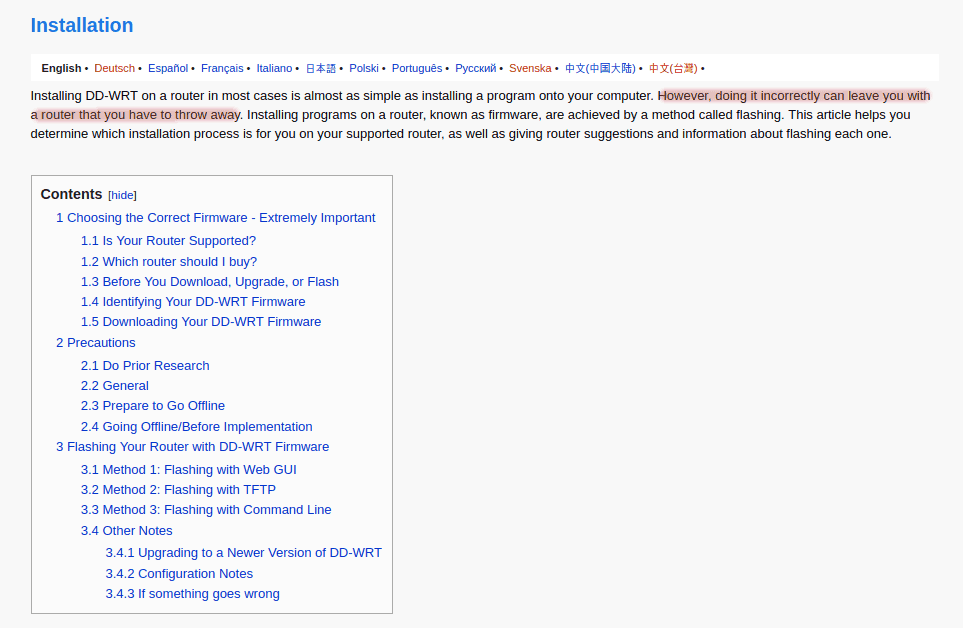
As you can see, this isn’t a spur of the moment project. But if you do decide you want to give it a go, you’ll find more information in our guide on ‘How to Set up a VPN on a Router.’
Setting Up a VPN Server on Your Own Computer
If your router doesn’t support third-party firmware, or you don’t want to take the chance of wrecking it, you can install a VPN Server on one of your own computers. Doing this will allow you to have access to files on the computer that hosts the VPN Server, as well as resources on your network that are accessible from the computer.
The easiest route is to use a Windows or Mac desktop that you are willing to leave running 24 hours a day. After all, a VPN Server does you no good if the computer it runs on is turned off when you need it.
Turning a Single-Board Computer into a Dedicated VPN Server
A slightly geekier approach is to take a small device like a Raspberry Pi and turn it into a dedicated VPN Server. This approach has the advantage of not tying up a larger, more expensive, more power-hungry computer for this single task.

Even a Raspberry Pi is potent enough for a basic VPN Server.
While this is a cool way to go and appeals to the geek side of your author, there are a few disadvantages to this approach:
- You need a Raspberry Pi to dedicate to the task.
- It adds an additional level of learning to the project if you aren’t already familiar with these devices.
- The performance of the VPN could suffer. Encrypting, encapsulating, and decrypting messages takes a lot of computing power and small devices like this will do the job slower than full-sized machines.
If this approach appeals to you, we suggest you visit the PiVPN site. It shows you how to set up OpenVPN on a Raspberry Pi with a minimum of fuss and bother. Or watch this video:
Setting Up a VPN Server on a Cloud Service
Setting up a VPN Server on a cloud service eliminates the need for your own hardware. You don’t need to hack your router or dedicate a computer to playing the role of VPN Server. This can be a convenient way to go.
But there are drawbacks to this approach as well. When you set up a VPN Server on a cloud service, you do so by installing software on a virtual machine running on the cloud services servers. This means that your VPN Server will be slow since it will be running on distant, simulated hardware.
It also means that you need to trust the cloud service completely. Everything you do will happen on their hardware, using their virtual machines. This leaves you with the same problem as using a commercial VPN Service: you need to trust a third-party.
The difference here is that commercial VPN Services sell themselves on their commitment to protecting your privacy. Services like ExpressVPN and NordVPN base themselves in jurisdictions where your privacy rights are protected. They cannot easily be forced to log your activities and share that information with the NSA, MI6, or whoever else is out there trying to spy on you.
Cloud services have a very different business model and are often based in places like the USA, where your privacy is not well protected. In our opinion, the chances that a cloud service would log your activities on their own, or be pressured into it by their local government, are much higher than with a top-notch commercial VPN Service.
How to Set Up a Personal VPN Server on DigitalOcean
One of the triggers for writing this article was seeing some online claims that it is quick and easy to set up a VPN Server on a cloud service. With people claiming you could have a VPN Server up and running in 10 minutes for only a few dollars a month (or even free for the first year), we thought we should investigate.
What we found was not encouraging.
The approaches we found a FOSS VPN Server called Algo. Algo seems to be a great software and works as advertised. It provides encrypted communications between your devices, and the Algo VPN Server running on Amazon EC2, DigitalOcean, Microsoft Azure, and other similar services.

But it doesn’t give you anonymity, and it doesn’t support the commonly-used OpenVPN protocol.
The problems come in with fast and easy claims. Unless you are a computer tech with Linux experience, setting up Algo isn’t easy or fast. It takes around 20 steps, many of which are done on the Linux command line. We had an experienced engineer set up Algo on DigitalOcean, and it took about 45 minutes.
To give you an idea of what you will need to deal with if you decide to install Algo on a cloud service, here are selected screenshots of the process.
First, you need to set up an account at the service (DigitalOcean in this example):
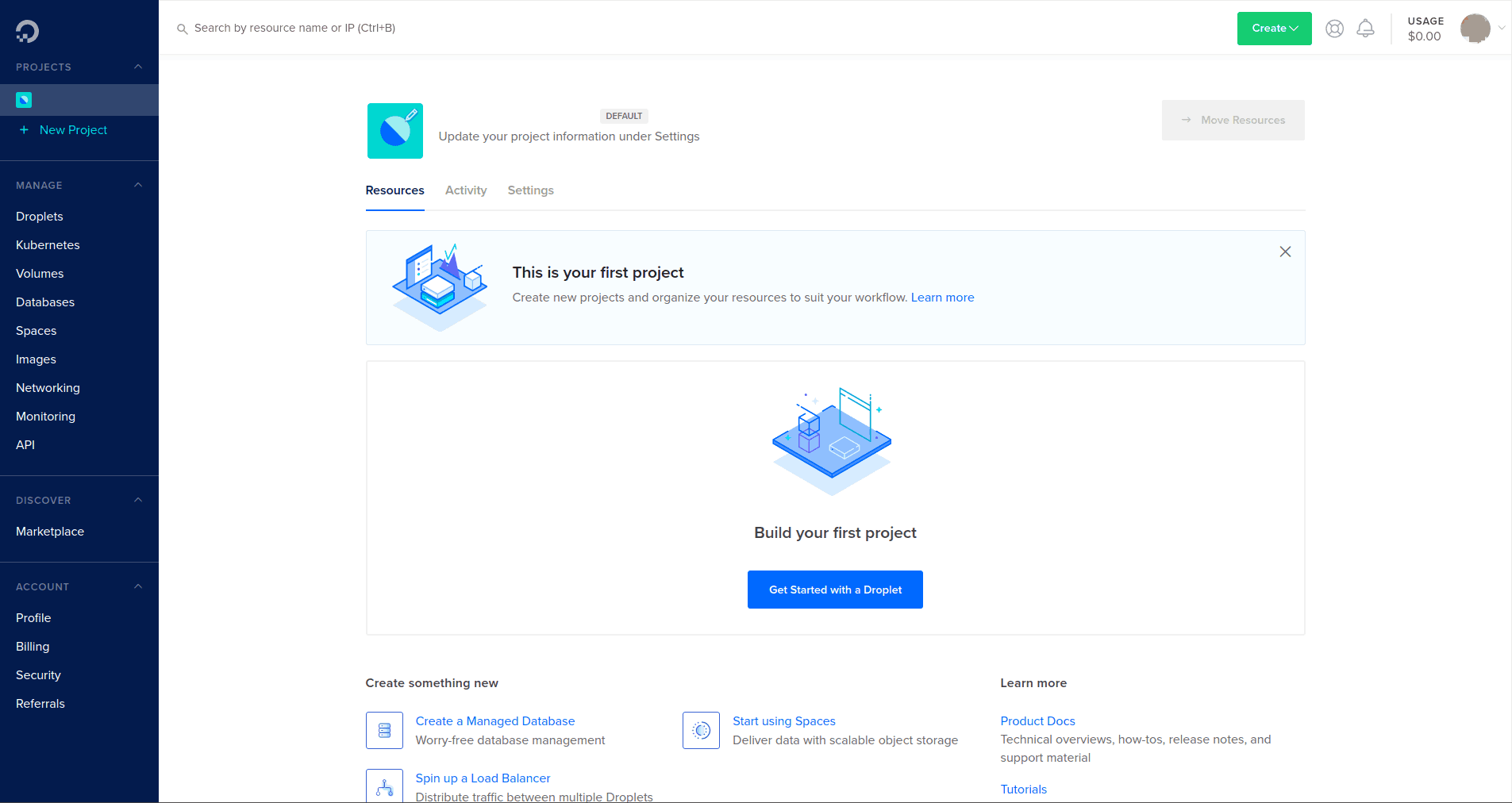
Clicking the Get Started with a Droplet (the DigitalOcean version of a virtual machine) gave us the options shown in the next screenshot. We created a Droplet running Ubuntu 18.04 by clicking the relevant button and selecting the plan we wanted:
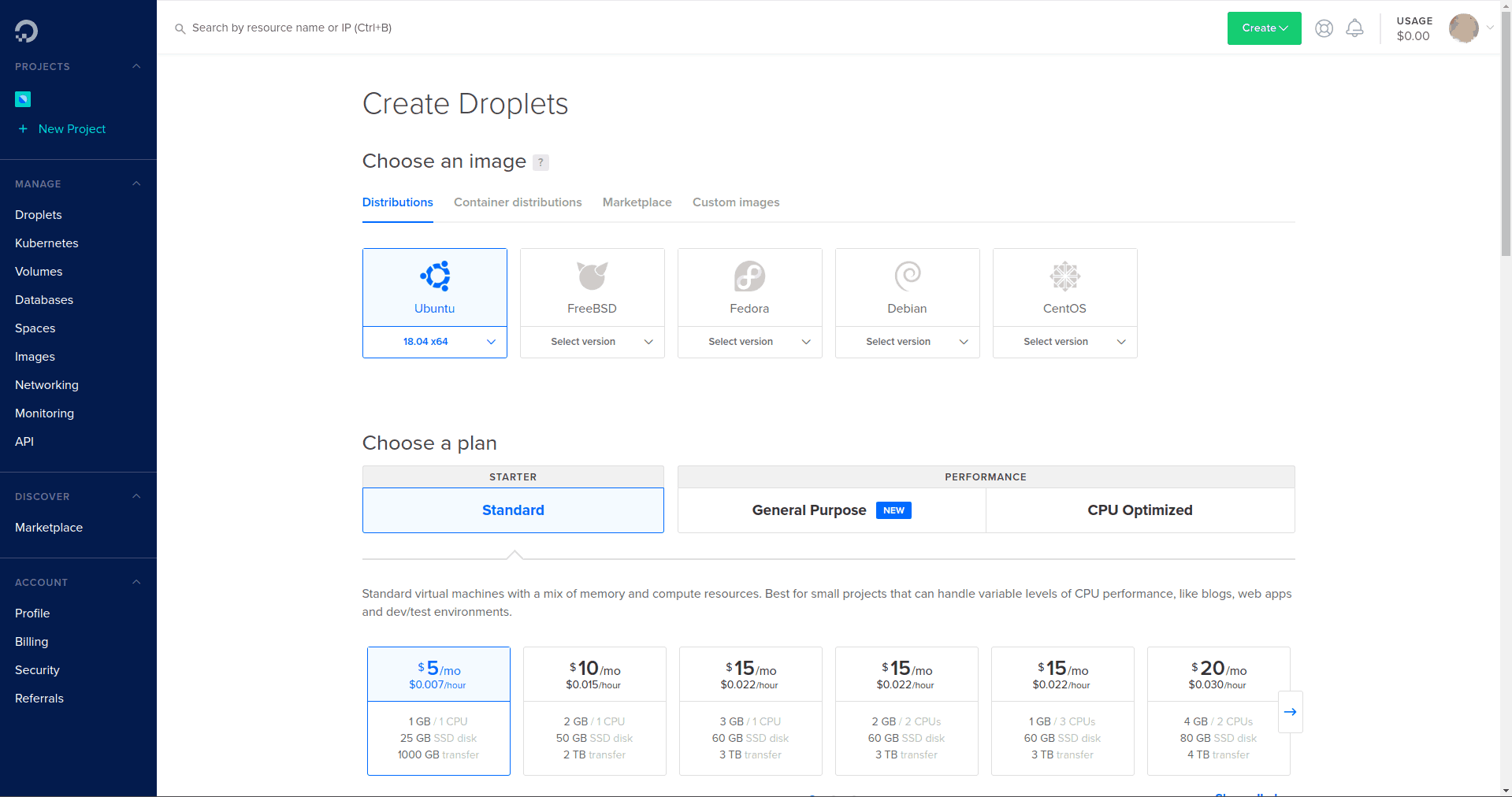
After a few minutes of waiting while DigitalOcean created the Droplet for us, we had a virtual machine running Ubuntu 18.04 ready to roll:
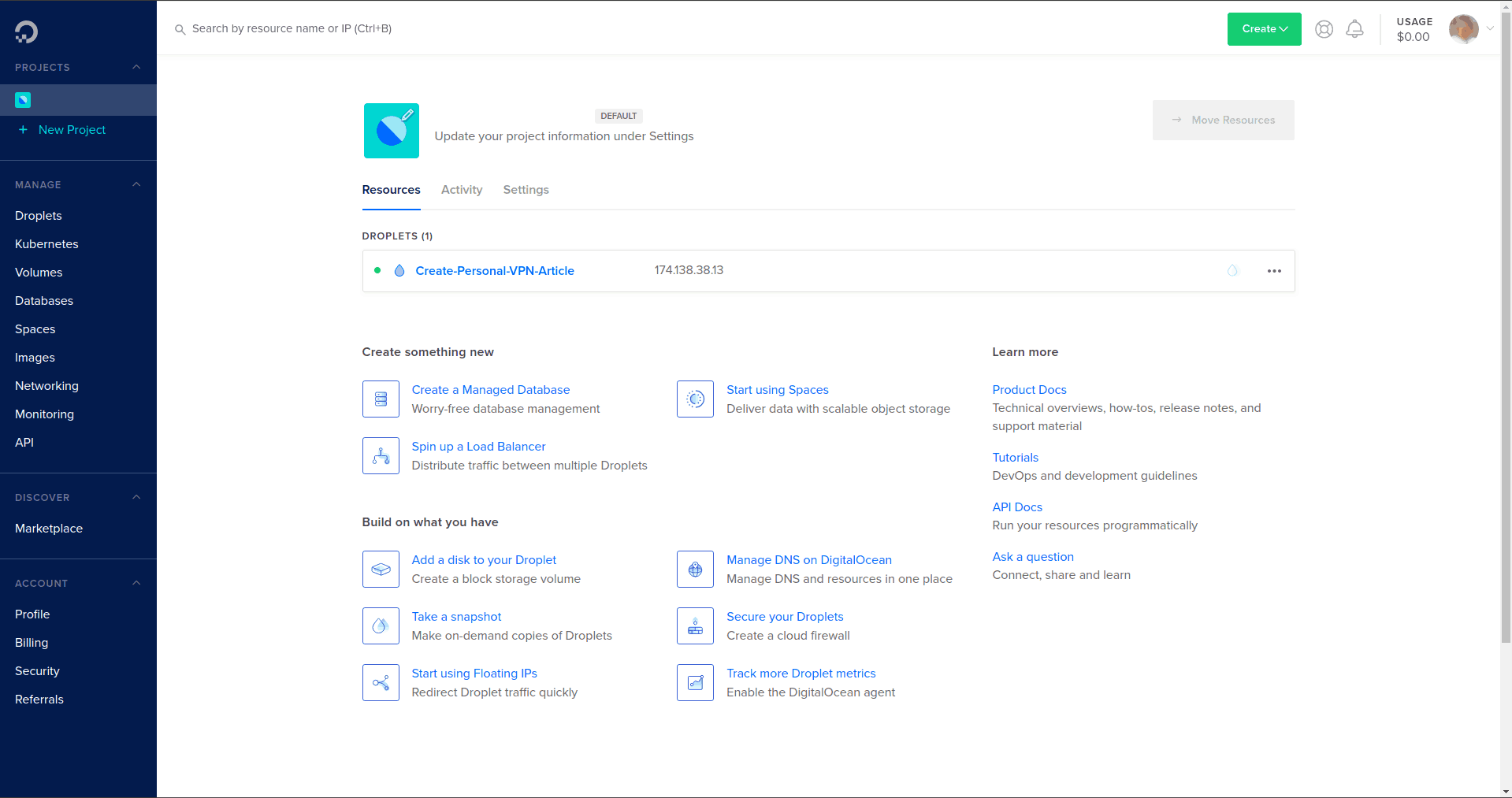
We logged into the Droplet and followed the instructions in the Algo Github repository to download and extract the Algo files, install Algo core and remaining dependencies. Then we opened the Algo Config.cfg file and edited it to include the list of users who would be able to log into the VPN:
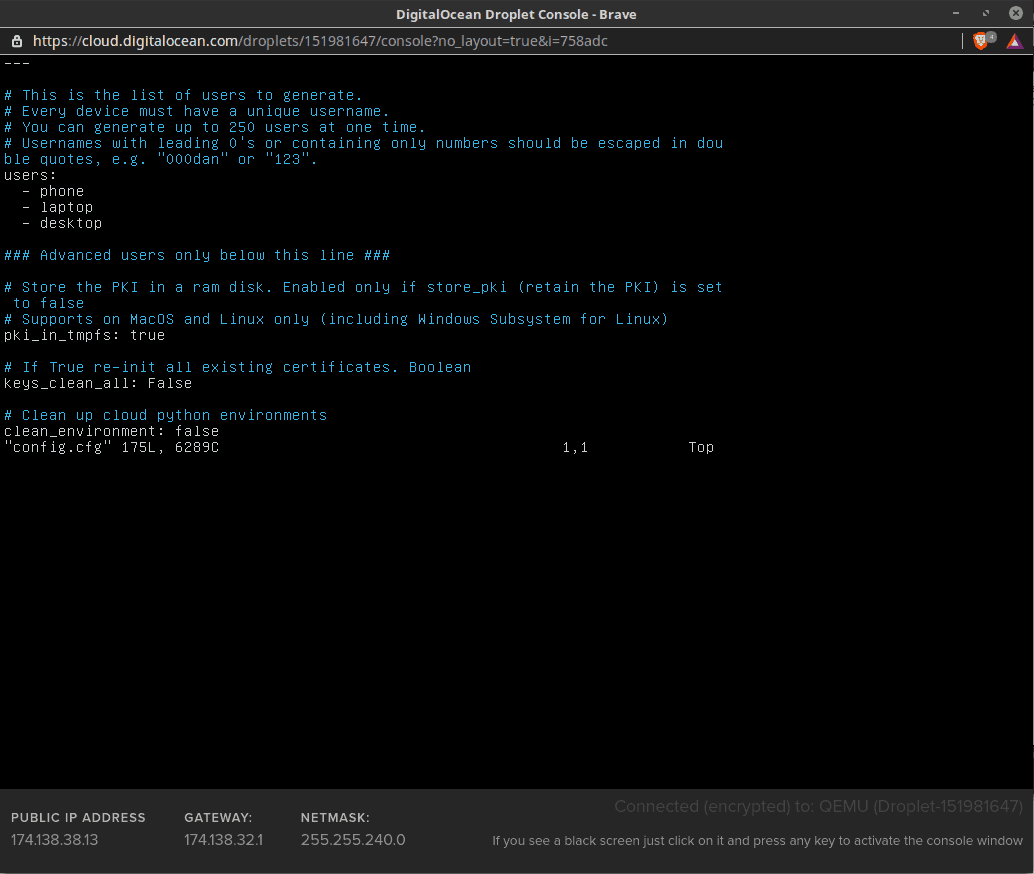
With all that out of the way we launched the Algo installer, and selected the DigitalOcean option:
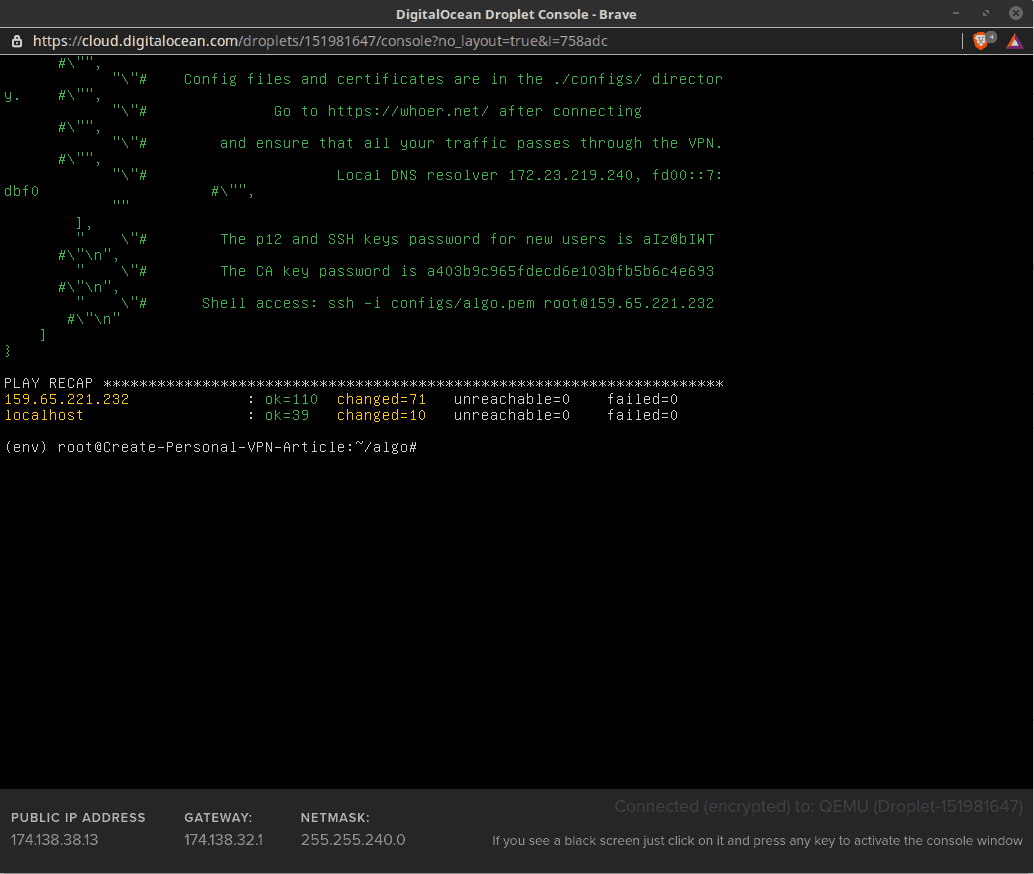
The Algo installer uses the DigitalOcean API to do most of the configuration work, so we sat back and waited about 15 minutes for the installation to finish.
As mentioned in the following screen capture, there are several values you must copy from the console once the installer finishes its work. Without these, you will not be able to add new users later:
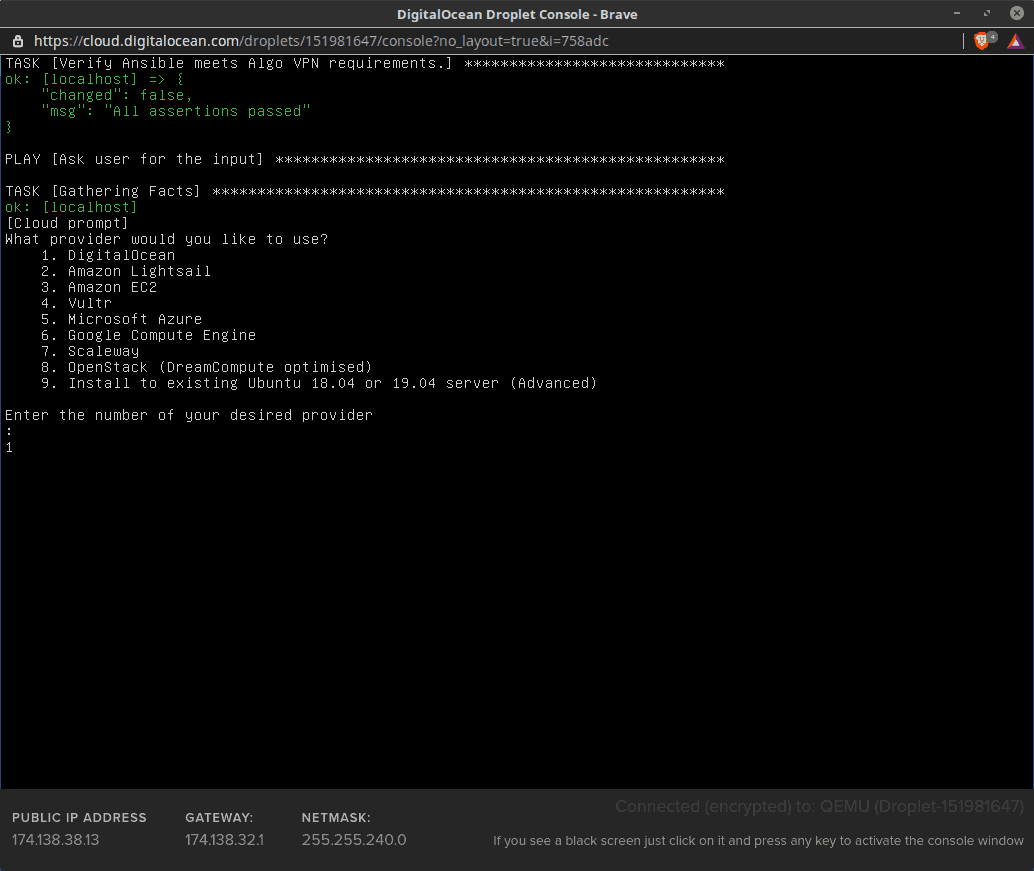
With that, the Algo VPN Server is installed in a DigitalOcean Droplet.
Now all you have to do is manually configure every client device that will connect to the server. Depending on the device, setting up the client could be pretty easy, or not so easy. As with setting up the server, the Algo Github page has links to the details of setting up clients on various popular types of devices.
When you finish that task you will have a fully functioning VPN Service of your own. It will be a slow VPN. You will need to trust that DigitalOcean won’t snoop on you as we discussed earlier. And because it has only a single server, it will be of limited use compared to commercial VPN Services, but it will be yours.
Despite the articles talking about the benefits of doing so, we really can’t see much reason to create your own VPN using a cloud service other than as an exercise for hardcore techies.
Conclusion
There are some privacy and security advantages of setting up your own VPN. These are most pronounced when you set up a VPN Server on your own hardware. In this article, we looked at three ways to get the job done, two of which involve setting up the server on your own hardware.
This table summarizes the pros and cons of each of the three approaches, as well as those of using a commercial VPN Service.
Pros and Cons for Setting Up Your Own VPN
| VPN Server on Your Own Router | VPN Server on Your Own Computer | VPN Server on Cloud Service | Using a Commercial VPN Service | |
| Protects | Entire Network | Specific Devices | Specific Devices | Specific Devices or entire network depending on service selected |
| Privacy | No need to trust third-parties | No need to trust third-parties | Cloud Service could log activities | VPN Service could log activities |
| Security | Good | Good | Low | Best |
| Speed | Medium | Slow | Slowest | Fastest |
| Ease of Setup | Medium | Low | Low | High |
| Ease of Maintenance | Medium | Low | Low | High |
As we’ve seen, while setting up a VPN Server for your own use is doable, it can be a lot of work and requires much more technical expertise than simply subscribing to a commercial VPN Service.
If you do decide to go this route, remember that you’ll also need to set up VPN Clients for each device you want to connect to your server. If the VPN Server documentation doesn’t have instructions you need, you should be able to find them with a quick web search.
If setting up your own VPN isn’t for you, we suggest you check out our review of the Best VPN Services for 2023. To help you decide between them, we organized them by use case, best VPNs for beginners, best for streaming, best for use on mobile devices, and so on.
References
What is a VPN Server?
What is Internet Protocol?
What is Network Encapsulation?
Note: This article was last updated In December 2023.
How to Make & Setup A VPN Server – 2023 In-Depth DIY Guide was originally found on Blokt - Privacy, Tech, Bitcoin, Blockchain & Cryptocurrency.
]]>
Ethereum is the leading blockchain app platform that was proposed in 2013 by Vitalik Buterin and went live on July 30, 2015. There are many different strands to this project and getting your head around it all can be quite the challenge. That’s why we have put together this comprehensive guide for those of you […]
What is Ethereum? Read the ULTIMATE Research-Backed ETH Guide was originally found on Blokt - Privacy, Tech, Bitcoin, Blockchain & Cryptocurrency.
]]>
Ethereum is the leading blockchain app platform that was proposed in 2013 by Vitalik Buterin and went live on July 30, 2015.

There are many different strands to this project and getting your head around it all can be quite the challenge. That’s why we have put together this comprehensive guide for those of you wondering “What is Ethereum?” and “How does Ethereum Work?”
As the harbinger of the second generation of blockchains and home to the second largest digital currency in the world, Ether (ETH), the Ethereum project has started a new era of blockchain development that enables a global community of developers to unleash their creativity in the space.
The ability to craft smart contracts gave developers a chance to think about new use cases for blockchain technology that previously remained largely connected to cryptocurrencies.

Ethereum also gave enterprises, organizations, and startups the ability to issue their own tokens, and build their own unique blockchain ecosystem using the Ethereum framework.
Till date, Ethereum-based ERC20 tokens have been the most popular means for launching Initial Coin Offerings.
Of course, Ethereum is still in development and has faced some hurdles. It has faced problems related to scalability, which was highlighted when the popular game dedicated to internet-bred cats called CryptoKitties managed to clog its network in December 2017.
However, with a unique concept, upcoming developments, a strong developer community and the first-mover advantage (second only to the mighty Bitcoin), Ethereum is one blockchain project that continues to remain at the forefront of DLT and crypto development.
So… What is Ethereum?
In a nutshell, Ethereum is an open source Smart contract and Decentralized Application Platform.
The Ethereum whitepaper describes the project as the next generation distributed computing platform, that provides a decentralized virtual machine known as the Ethereum Virtual machine EVM.
The latter is able to execute Peer-to-Peer contracts by means of Ether (ETH), its proprietary crypto fuel.
Blockchain technology is used as a tool of shared consensus, while Ether is the digital asset that is used to pay for transaction fees and computational services.
What’s the Difference Between Bitcoin and Ethereum?

Since the advent of the Ethereum project in late 2014 and its explosion of popularity within the confines of the nascent crypto space and beyond, Ethereum has always been compared to Bitcoin.
All being similar to the use of Blockchain as the underpinning technology, both projects are fundamentally different. The main difference between them is the purpose of each one.
In fact, Bitcoin was built as an alternative to regular money. Bitcoin can be used as a medium of value exchange, a means of payment and a store of value with no central authority to issue or control it and no intrinsic value or physical existence.
On the other hand, Ethereum is rather a platform for developers to build and run Peer-to-Peer executable contracts and decentralized applications.
Block time generation (seconds in the case of Ethereum and minutes in the case of Bitcoin), the rate at which new coins are mined (constant in Ethereum and halves every 4 year in the case of Bitcoin), the proof of work hashing algorithm (Ethhash in Ethereum, and Sha 256 in Bitcoin), and the total supply (capped to 21 millions in the case of Bitcoin and uncapped in that of Ethereum) are the other differences that set both projects apart.
| Ethereum | Bitcoin | |
|---|---|---|
| Release Date | July 30, 2015 | January 9, 2008 |
| Release Method | Presale | Genesis Block Mined |
| Founder | Vitalik Buterin | Satoshi Nakamoto |
| Blockchain | Proof of Work (Will transition to Proof of Stake) | Proof of Work |
| Purpose | Blockchain app platform, smart contracts & digital currencies | Digital Money & store of value |
| Native Cryptocurrency | Ether (ETH) | Bitcoin (BTC) |
| Algorithm | Ethash | SHA-256 |
| Block Time | 12 – 14 seconds | 10 minutes |
The Ethereum Virtual Machine
The Ethereum Virtual Machine (EVM), is a 256-bit quasi-turning-complete virtual state machine that forms the runtime environment for smart contracts and specifies the execution model for such contracts.
The machine is stack based, altogether separate from the main Ethereum Network, and has its own independent storage model.
In fact, all the nodes on the Ethereum Network run the EVM in addition to validating transactions.
The EVM could be seen as a testing ground for Smart contracts because once these contracts are deployed to the mainnet, such a step can’t be reversed.
Any developer that wants to build on Ethereum, could deploy his/her untested code on this network of computers and see how it muddles along.
The most powerful aspect of the EVM is that it can be implemented into various different programming languages. So far, EVM iterations have been deployed in C++, Java, JavaScript, Python, Ruby, Haskell, Rust, Erlang, WebAssembly and more – promoting adoption and ensuring all developers can have fair access.
This is particularly important for interoperability with other blockchains, as it means that any other blockchain could essentially run and iteration of the EVM which could power smart contracts and DApps on their chain, without building a specific virtual machine for their own chain.
Blockchains which currently use or offer versions of the EVM include Telos, Hyperledger Fabric, EOSIO, and others – and blockchains like Tron use virtual machines which are based on or compatible with EVM.
Ether (ETH) and Gas

In Ethereum each operation or work performed by the network has a cost assessed by the network which is known as a gas limit.
In order to execute a smart contract, for example, developers need to pay for all the operations featured in their code.
Sending Ether from one wallet to another one involves four gas units.
These gas units are checking your balance, transferring ETH to a receiving address, subtracting ETH from your balance and adding ETH to the receivers.
So gas units refer to the smallest measurement of work needed to settle a given operation but don’t have a monetary value.
The cost is paid in Ether. Gas is that unit that translates into Ether.
Since Ethereum can only compute a limited number of gas units at any given time, miners are sort of bribed by network users to pace up the stream of request that is being sent over to the network.
To pay miners, small fractions of ETH named Gwei are attached to each gas unit, which sets the gas price.
What everyone should remember is that the gas price is how much you pay per gas unit, and the gas limit is how much work you are requesting from the network.
Smart Contracts – What Are They and How Do They Work?
Smart contracts refer to computer codes that facilitate the exchange of value whether it is money, property or content.
They are called contracts because they translate the terms of an agreement, and smart because they automatically execute themselves once specific triggers are met.
The notion of smart contracts was around way before the advent of Bitcoin or Ethereum.
Simply put smart contracts are just like regular contracts in the real world, where two parties or more agree to specific terms of an arrangement and commit to sticking to it once signed.
The main difference is that Smart contracts are fully digital.
Furthermore, when running on a Blockchain like the Ethereum Network, a smart contract acts as a self-operating computer code that automatically executes itself once specific conditions are met.
Blockchain-based smart contracts are immutable and would run exactly as programmed once deployed without any possibility of censorship, downtime, reversing, or third-party interference.
Other Blockchains Which Utilize Smart Contracts
Smart contract enabling Blockchains are regarded by many as the “real deal,” this whole Blockchain revolution came up with since its rise to prominence.
Put by Nick Szabo, the blockchain pioneer, himself:
“New institutions and new ways to formalize the relationships that make up these institutions are now made possible by the digital revolution. I call these new contracts “smart” because they are far more functional than their inanimate paper-based ancestors. No use of artificial intelligence is implied. A smart contract is a set of promises, specified in digital form, including protocols within which the parties perform on these promises.”
We crafted a list of ten blockchains, other than Ethereum, that support Smart Contract programming and deployment.
- Cardano: a project that caught a lot of media attention, and that is allegedly developing a smart contract platform that seeks to deliver more advanced features than its competitors do.
- EOS: a Smart Contract platform for industrial scale dApps deployments through a DAO model, commonly referred to as the alternative to Ethereum.
- NEM: written in Java, the NEM platform is arguably one of the simplest to use since no specific platform programing language is required to code and deploy smart contracts on it.
- Waves: the underdog of this list, it is an open source smart contract platform that focuses on scalability and speed of settlements.
- Other interesting blockchain projects that could play an important role in the future of smart contracts, are Hyperledger Fabric, Lisk, NEO, Qtum, Stellar Lumens, and Tezos.
Ethereum Use Cases
Smart contracts make Ethereum flexible, providing it with more real-world use cases than its predecessor Bitcoin.
A combination of smart contracts and dApps keep developers intrigued and users interested in the network.
According to ConsenSys, some industries and sectors where use cases for Ethereum can be found include:
- Banking and Financial Services:
Large banks routinely spend more than $200 million per year on cybersecurity. If the servers of a central bank were to go down, you would see the collapse of a country’s payment clearing system.
However, if every bank within a payment network instead transacted through a blockchain, there would be no single point of failure.
Therefore, a country’s interbank payment network could be maintained even if multiple servers were to go down.
Also, because the basic idea behind blockchains- creating a distributed, public and immutable ledger with a never-to-be-tampered with the record of transactions remains the same, the data behind the credit score of a user becomes more reliable for financial companies.
Related industries like insurance can also be hugely benefitted as they can disburse payments more easily to their customers.
- Startups and ICOs:
Ethereum empowers startups by letting them launch their own Initial Coin Offerings (ICOs).
These tokens, usually created using the ERC20 protocol, help startups in raising the funds needed to realize their goals.
Interestingly, one of the largest crypto exchanges and companies in the world, Binance, used funding generated through the sale of BNB, a coin that follows the ERC20 standards.
Even Tron, one of the largest blockchain projects in the world started out with an ERC20 token offering.
- Digital Identities:
Since data and identity theft is such a menace, a smart contract solution is a good fit for this problem.
Using information hidden behind a dedicated smart contract, users could not only take their identities digital but rest assured that they do not reveal more than what they are comfortable sharing.
Services like uPort allow users to take back control of their identities and share only the information they choose through their mobile devices.
Information can only be shared upon authentication from the user and the data is always stored safely on the Ethereum blockchain.
- Supply Chain:
A major application for Ethereum smart contracts looks set to be in supply chain management where it could benefit both consumers and suppliers through more efficient tracking.
Whether you want to know about the freshness of produce or the origins of the diamonds you bought for your wedding, blockchain-based smart contracts can help to deliver this. The supply chain system of the world is currently broken but not beyond repair.
Using an extensive network of smart contracts, companies can track their raw materials and the transportation of goods. They can accurately measure their manufacturing processes, related logistics and the process through which a product reaches a consumer.
The consumer, on the other hand, is provided with reliable information that instantly proves whether a product is fresh, authentic, fair trade, locally produced and more.
- Other major industries and applications where Ethereum could find many uses include Real Estate, Law, Oil and Gas, Energy Grid, Government, and Commodity Trade Finance and more as stated by ConsenSys.
Ethereum’s Most Popular dApps
Here are some of the most popular dApps that run on the Ethereum blockchain:
- CryptoKitties:
The internet’s obsession with cats knows no bounds and when CryptoKitties was launched, it was evident that there would be more than a handful of interested players.
 The game allows players to buy, sell, collect, and breed digital cats. Each cat is unique and has its own value.
The game allows players to buy, sell, collect, and breed digital cats. Each cat is unique and has its own value.
CryptoKitties received widespread attention from the media, the crypto community and the “uninitiated” people who may have never heard about cryptocurrencies and blockchains before when cats on the game started selling for thousands of dollars.
CryptoKitties remains one of the most popular dApps and should be credited for evolving the scope of dApps from “work” to “play” while adding value to “digital asset ownership.”
- LocalEthereum:
The second-generation blockchain cousin of LocalBitcoins, LocalEthereum solves one BIG problem for buyers- removing middlemen from the crypto ecosystem.
You buy ETH over the counter using smart contracts and escrow services available on the platform.
The seller’s Ethereum is locked via a smart contract and is released only when they receive the agreed fiat currency from the buyer.
- IDEX:
The IDEX decentralized exchange is considered by some a thing of beauty, especially as it introduces Ethereum users to the idea of giving up on “centralized exchanges.”
Some of the most popular dApps on Ethereum are decentralized exchanges- they are new, innovative and remove a big hurdle from the world of digital currencies, providing more power to the users.
The first adopters of IDEX were speculators, and the exchange enables a huge range of Ethereum and ERC20 tokens to be traded and exchanges.
However, popular cryptocurrencies such as XRP, Litecoin, Bitcoin and Tron is not possible.
- Ethlance:
Giving other freelancing job platforms a run for their money, Ethlance allows users to work on gigs or projects of their choice without paying a hefty fee.
This could mark the beginning of the end of freelancers having to give away over 20% of their earnings to centralized platforms such as Upwork in “fees” and part with even more dollars to get the money in their local currency.
Ethlance, the decentralized freelance hiring platform allows you to work for zero fees. The only payment here is the gas utilized on Ethereum.
- Uniswap ProtocolPart decentralized application and part decentralized protocol, Uniswap provides automated liquidity on Ethereum, for Ethereum-based tokens – such as ERC20 tokens and certain ERC721 non-fungibles.Uniswap has quickly become one of the most popular apps on Ethereum, and many developers and liquidity providers use the protocol to make trading low market cap tokens easy and simple.
Users can integrate Uniswap with Ethereum wallets such as MetaMask, which automatically links users tokens with the Uniswap protocol and lets traders easily swap their tokens for others.
- AAVEOne of the most popular decentralized finance (Defi) lending protocols, AAVE has taken the crypto finance world by storm. AAVE is an open-source money market protocol build atop Ethereum, which lets users borrow assets, and lend out their assets in order to gain fixed interest back.AAVE, which means Ghost in Finnish to show the protocol’s transparency, has over $1.8 billion staked with it in assets which include DAI, USDC, TUSD, USDT, BUSD, ETH, BAT, LINK, REP, and a whole host of other popular assets.
Users have either a ‘Deposit APY’, which is the interest that they will earn on their deposited assets and ‘Variable APY’ which is the amount borrowers pay back into the lending protocol.
Many users leverage the AAVE protocol to borrow assets for short-term trading opportunities and to take advantage of market swings.
- Other popular Ethereum dApps include FCK, Kyber, ForkDelta, Etheroll, and more.
Pros and Cons of dApps

The pros – Here are some of the key benefits of decentralized applications:
- Fault tolerance – Systems use redundancy to remove the risk of accidental failure. If one element goes down the network still works, this means applications can run with zero downtime.
- Attack resistance – There is no single point of failure, as the applications run on the blockchain. This makes them impervious to denial-of-service (DDoS) attacks.
- Tamper & corruption proof – Applications run precisely as programmed removing the possibility of fraud, censorship or third-party interference. This makes it more difficult for an individual or group to act for its own benefit at the expense of everyone else.
- No middlemen – This removes exuberant fees and allows users to interact directly with each other (peer-to-peer). This can lead to greater transparency, trust, and privacy.
- Open source – An open-source protocol enables anyone interested in the dApp to collectively contribute to its development for the benefit of everyone.
The Cons – Here are some of the negatives of decentralized applications:
- Speed – Currently the dApps can be quite slow with transactions also taking a long time.
- Scalability – The limit on how many transactions can be processed per second might be quite low which limits the dApps scalability.
- Fees – While in some ways the ‘compensating system’ is a benefit, it also means users have to pay each time they use the dApp.
It’s worth noting that solutions and new innovations are constantly occurring in the nascent dApp and blockchain industries, so the current ‘cons’ may well be overcome in the future.
The DAO Hack
The DAO was a project that crystallized most of what blockchain technology stood for since its inception, in both its business model and management structure.

It was created in 2016 by members from within the Ethereum community, notably the Slock.it developer team.
The DAO was conceived as a form of investor-oriented, stateless, decentralized venture capital firm after raising a record-breaking crowdfund sale of around $150 million worth of Ether in May 2016.
Unfortunately, when things were looking up for the project, it turned out that there was a flaw in its source code, and that flaw was eventually preyed on.
On June 17, 2016, some hacker(s) exploited a loophole in the DAO smart contract and drained as much as 3.6 million ETH (around $70 million at the time) to a subsidiary account in just a few hours of the attack.
In fact, the attack was found to be made possible when the hacker(s) realized that the smart contract was mistakenly coded to check the internal balance after sending coins not the other way around.
The attacker(s) proceeded by requesting funds from the smart contract several times before the smart contract could update its balance.
The hack marked the beginning of the end for the DAO and had far-reaching consequences on the Blockchain space that are still tangible today.
Besides delisting the DAO token off major exchanges in the months following the hack, and hard forking the Ethereum main chain, the incident caught the eye of regulatory watchdogs all over the world, and put a special emphasis on the necessity of placing the crypto sphere under close scrutiny.
Ethereum Classic Fork
In the wake of the DAO hack, the Ethereum community gathered and debated on the proper actions the foundation should take in order to handle the disastrous situation the hacking incident has cast over the project.
The community split into two fundamentally opposed groups.
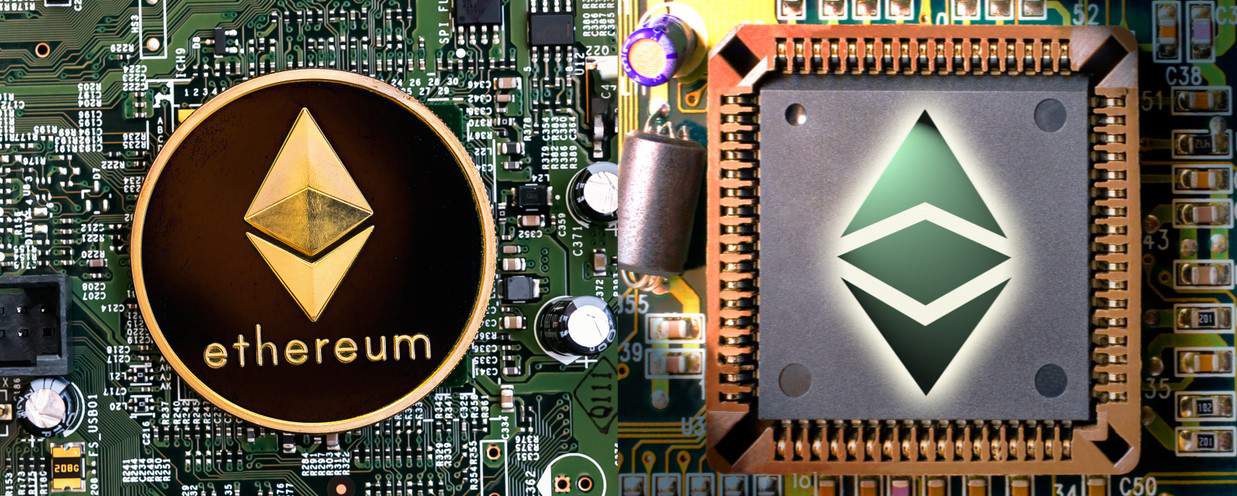
While one side suggested a hard fork to contain the hack, reverse it, and send the stolen funds back to their original wallets, the other side strongly opposed the move invoking ideological reasons, and arguing that prevailing with the code and trusting the smart contract under all circumstances, is the philosophy behind Blockchain, and failing to commit to it, could open the door for similar actions in the future.
A vote took place in July 2016 and the decision to implement a hard fork to the Ethereum code and move the stolen Ether away to a new smart contract was agreed upon by a vast majority of the community including co-founders Gavin Woods and Vitalik Buterin.
Consequently, a hard fork occurred on the main Blockchain at height 1,920,000, right before the hacking incident took place.
The offshoot kept the name Ethereum and named its fuel Ether, ETH.
However, the other group, or “the code is law” advocates, decided to stick with the original chain, which became known as Ethereum Classic.
Ethereum Mining
 Did you know that Google CEO Sundar Pichai’s 11-year-old son mines Ethereum? The young one, Pichai says, understands a lot about cryptocurrency and has corrected him on occasion.
Did you know that Google CEO Sundar Pichai’s 11-year-old son mines Ethereum? The young one, Pichai says, understands a lot about cryptocurrency and has corrected him on occasion.
Do you know as much about Ethereum mining as Pichai’s son?
Well if not, don’t worry as we have all the information you need here to boost your knowledge on the subject.
In a nutshell, Ethereum mining is similar to Bitcoin mining.
The concept of mining, i.e., giving rewards to “miners” who create new blocks in the network in the form of a native cryptocurrency of the blockchain, is the same.
However, the Ethereum blockchain is faster than Bitcoin’s, which means that blocks are created at a faster rate.
In the Bitcoin Network, a new block is created every 10 minutes while Ethereum achieves the same in 15 seconds.
Miners on the Ethereum network receive ETH tokens along with all the gas contained within their block (gas is the fuel of all Ethereum transactions which manifests as code-processing and transaction fees on the blockchain).
Can You Mine Ethereum With ASIC?
Yes, it is currently possible to mine Ethereum with ASIC.
However, an Ethereum Core Development meeting recently pushed forward a proposal called ‘ProgPoW‘ that would make Ethereum ASIC resistant.
How Many Ethereum Nodes Are There?
According to Ethernodes.org, the Ethereum mainnet hosts about 8,752 nodes at the moment. However, this figure changes on a daily basis.
Of these, the largest majority of nodes are based in the USA while China, Canada, Germany, the UK, Russia, and more trail quite far behind.

Are These Nodes Full Nodes?
A full node is any computer that enforces all the rules of consensus on the Ethereum network and is connected to it.
A full node must have the entire Ethereum blockchain downloaded on its computer.
By definition, all miners in the Ethereum network have to be full nodes. However, all full nodes do not have to mine the currency.
The nodes have a few important functions.
- They have to ensure that all the miners are given the correct block rewards.
- They must ensure all transactions have the right signatures.
- They must check that all blocks and transactions are in the right data format.
- They must make sure there is no double-spending in the blocks.
How Can I Use Ether (ETH)?
Ether is one of the most versatile coins available in the cryptocurrency space today.
As the second-largest cryptocurrency in the world, Ether has many holders.

Per the most recent CoinMarketCap data, Ether is valued at over $15 billion with 104 million coins in circulation currently.
Here are a few of the common uses of ETH:
- For making transactions:
Ether can be used as an alternative to using credit cards and wire transfers. However, to make a transaction with Ether both the sender and receiver must have an Ether wallet set up. For cross-border payments, Ether could work to be much cheaper and faster than traditional methods.
- For buying ICO tokens:
When participating in token sales, Ethereum is often a popular cryptocurrency of choice. As a large number of Initial Coin Offerings are offered using the Ethereum blockchain, it means that buying tokens from these projects using ETH becomes easier.
- For making purchases in the real world:
Several cryptocurrency startups are pushing for the adoption of digital currencies and helping in the installation of PoS machines and other methods that enable purchases using ETH.
- For making digital purchases:
Many websites now accept payment in Ether, and your dApps could also accept ETH payments, enabling you to purchase anything from extra lives in games to subscriptions of a magazine.
- For trading/investing:
Ether is one of the most commonly available trading pairs for digital currencies used in exchanges around the world. You can purchase Ether and hold it as an investment or exchange it directly for other cryptocurrencies.
How Can I Store Ether (ETH)?
Once you have bought Ether, you will need an Ethereum wallet to store it securely.
You have the option to use hot wallets, cold wallets, hardware wallets, paper wallets, desktop or mobile wallets. There is one for all platforms; some options will be better suited in comparison to others.
Let’s look into each option:
- Hot wallets- exchange wallets:
You will most likely buy ETH on an exchange like Coinbase or Binance. These exchanges will provide you with a wallet where you can store your ETH.
Exchange hot wallets are easy to use, very simple and it’s usually easy to liquidate your holdings since your coins can be accessed on the exchange’s website.
Therefore, exchange wallets can usually be accessed from multiple devices as long as you have a connection to the internet.
The problem with these wallets is that they could be more vulnerable to theft than others depending on the security of the exchange and your account.
If you trade regularly, then this is likely the best and most convenient option.
- Cold wallets- hardware wallets:
Hardware wallets can offer their users extremely strong security when used correctly.
They are usually USB devices, and the market-leading provider of hardware wallets currently is Ledger.
You can store your Ether holdings on a hardware wallet for as long as you wish and rest assured that they cannot be reached by a hacker.
Just make sure that you do not lose the device or tell anyone else your passwords.
- Cold wallets- paper wallets:
Paper wallets are considered the most secure way of storing your Ether safely away from malware and cyber-attackers.
With a paper wallet, you print your private keys, and Ether addresses and store them in a safe location.
However, to many, this can seem like a big inconvenience when compared to using an exchange wallet for example.
Again, like with hardware wallets, it’s important to keep your paper wallet somewhere safe and never share the information with anyone else.
- Desktop and mobile wallets:
As the name suggests, desktops and mobile wallets can be distinguished based on the devices where they are being used.
Desktop wallets can be more functional, while mobile wallets provide more convenience.
Mobile and desktop wallets can usually only be used on the device where they are installed. Therefore, if you lose the device, this will put your funds at risk.
Some mobile/desktop wallets will be specifically designed for storing Ether and ERC20 tokens, whereas some will allow you to hold a wide range of cryptocurrencies together.
Which Is the Best Ethereum Wallet?
Given that there is such a wide range of wallet options out there, it begs the question, which ones are best?
Well, to help answer that question, here are some of our handpicked favorites:
- Hardware wallet – Ledger Nano S
The Ledger Nano S squeezes both advanced security and ease of use into one package.
Our guide to storing cryptocurrencies securely on a Ledger Nano S can be found here.
- Desktop wallet – MetaMask
This simple, easy to install and easy to use browser-based wallet lets you connect to Ethereum and a host of dApps hosted on the blockchain instantly.
MetaMask is a highly popular wallet which has also received funding and support from ConsenSys and Ethereum.
Fake versions of this wallet are out there so be sure to download a legit version.
- Basic Wallet – Mist Wallet
If you are looking for nothing but the bare basics, then the Mist Wallet is the right choice for you.
It was created by the Ethereum Foundation for a no-frills, no-distraction experience and is listed as the most basic wallet available on ethereum.org.
- Multicurrency Wallet – Exodus
If you hold numerous cryptocurrencies and want a well-designed wallet that eliminates the need for multiple crypto wallets, then Exodus could be a good choice.
Exodus is is fairly popular amongst crypto users and some cool features, including the portfolio feature where you can track your holdings.
- Web Wallet – MyEtherWallet
MyEtherWallet is one of the most popular Ether wallets out there.
As a web wallet, it allows you to log in from any device, which does bring some security risks.
However, these risks can be mitigated if it’s paired with a hardware wallet such a the Ledger Nano S.
- Mobile Wallet – Trust Wallet
Trust Wallet is now Binance’s official cryptocurrency wallet, and the app is available to download on both iOS and Android devices.
It supports Ether and all Ethereum network tokens such as ERC20 tokens, as well as many other leading cryptocurrencies such as Dash, Tron, Litecoin, Bitcoin, and more.
Where Can I Buy or Sell Ethereum?
Cryptocurrency exchanges are the most common choice for buying or selling Ethereum.
Cryptocurrency exchanges can be centralized or decentralized.
The world’s three largest cryptocurrency exchanges are:
- Binance
- OKeX
- Huobi
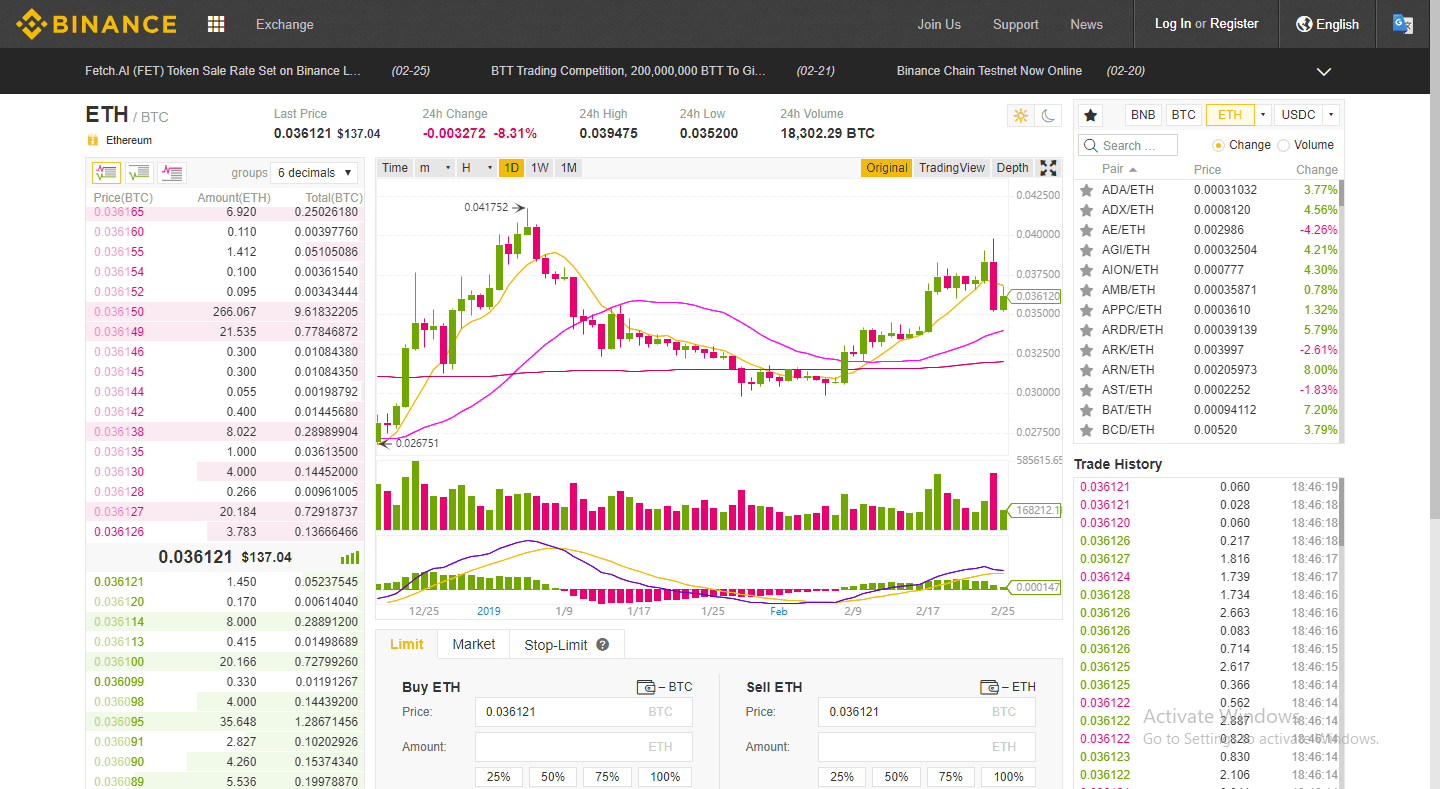
Other prominent exchanges include:
- Coinbase
- Bitfinex
- Upbit
- Kraken
- Digifinex
Ether is available to buy, sell, and trade on all of these exchanges. As Ether is a leading digital coin, it is available on most cryptocurrency exchanges.
Different payment methods for purchasing Ether on exchanges include by credit/debit card, with fiat currencies, and with cryptocurrencies or stablecoins. The fees charged by different exchanges will vary and will also depend on the payment method.
Other options include cryptocurrency ATMs where you can buy Ether with cash, trading Ether peer-to-peer on LocalEthereum, and using conversion exchanges like Changelly and Shapeshift to swap fiat-to-ether or crypto-to-ether instantly.
Is Coinbase Safe?
Coinbase is a leading and popular cryptocurrency exchange based in the US. Currently, over 18% of the platform’s volume comes from ETH/USD trades.
For people using the exchange’s services, Coinbase provides a hot wallet which can be used to store currencies.
Coinbase holds over 98% of its user’s funds offline and takes other security measures, which prevents thefts and hacks from damaging user’s holdings.
Any funds stored online by Coinbase are covered by insurance.

Coinbase also enables two-factor authentication for the users, further protecting them from unauthorized access of accounts.

Coinbase also runs a bug bounty program with an active community of security researchers that help to keep the platform safe.
None the less, some users still may want to take full control of their security rather than rely on an exchange. If so, using one of the secure methods mentioned above such as a hardware wallet or paper wallet would be a good option.
How Much Is Ethereum Worth?

As of December, 2021, the price of Ether currently stands at $2248 with a market capitalization of $274 billion.
In November and December 2015, Ether traded below the $1 mark.
However, a year later, between October and December 2016, Ether’s price was nearing $10.
In June 2017, prices went as high as $377.56 with market capitalization reaching over $34 billion.
on January 13, 2018, the price of Ether reached an all-time high near $1,400, with a market capitalization of $133 billion.
Since then, Ethereum has witnessed a massive sell-offs and tumbling prices in an unwavering bear market.
However, like with all markets, a boom and bust cycle exists, and now everyone is waiting for a new bull market, with hopes that Ether could one day make an all-time high again.
Ethereum Price Predictions From Big Names
Ethereum has caught the attention of many crypto enthusiasts as well as prominent personalities from the traditional finance sector. Some have also made predictions about Ethereum’s price. Let’s look at what they had to say.
Jeff Reed considers Ethereum more valuable than Bitcoin:
Crypto author Jeff Reed believes that Bitcoin and Ethereum have little in their way to stop them from becoming alternative currency systems. He said:
“You can conceivably trade anything using Ethereum, but this is not Ethereum’s strength in comparison to other cryptocurrencies – they can all do this. It’s rather the computing language that allows the smart contracts to exist that makes Ethereum more valuable than BTC (in my opinion).”
Steven Nerayoff predicted $3,000:
Co-creator of Ethereum, Steven Nerayoff noted that billions of dollars were being poured into the Ethereum ecosystem in Jan 2018, through ICOs. He was vouching for a $3000 price tag on Ether by the end of 2018, but unfortunately, this did not materialize.
Nigel Green sticks to $2,500:
deVere Group CEO Nigel Green suggested that Ethereum could reach $2500 by the end of 2018, followed by further increases in 2019 and 2020.
He said:
“The price of Ethereum is predicted to increase significantly this year, and could hit $2,500 by the end of 2018 with a further increase by 2019 and 2020. This general upswing will be fueled by three mains drivers. First, more and more platforms are using Ethereum as a means of trading. Second, the increased use of smart contracts by Ethereum. And third, the decentralization of cloud computing.”
Who Is the Founder of Ethereum?
Russian-Canadian programmer Vitalik Buterin is the co-founder of Ethereum.
BREAKING NEWS: I hereby announce that I, Vitalik Buterin, am the founder of ethereum.
— vitalik.eth (@VitalikButerin) May 2, 2016
Vitalik conceived the idea of Ethereum and released a white paper in 2013 describing in detail its design and rationale.
Vitalik had already been interested in Bitcoin and cryptocurrencies since 2011. He co-founded the news website named ‘Bitcoin Magazine’ where he published hundreds of articles and was also involved with the privacy-focused Dark Wallet project.
It was during this time that Vitalik came up with the idea of a single blockchain that could be reprogrammed to create custom decentralized applications rather than having to develop a whole new blockchain.
In January 2014 Vitalik formally announced Ethereum at the North American Bitcoin Conference in Miami and started working with Dr. Gavin Wood who he went on to co-found Ethereum with.
In July 2014 they launched a 42-day public sale of Ethereum tokens known as ‘Ether’ raising more than $18 million, which was the most successful ever crowd sale at the time.
The Ethereum platform went live and launched a year later on June 30, 2015, allowing developers to start creating and running decentralized applications.
The Founding Team
Apart from Vitalik Buterin, other people were also involved in designing and perfecting the concept of Ethereum.
The most prominent among them is doctor Dr. Gavin Wood who wrote the “technical bible” called Ethereum yellow paper, which outlines the details of the Ethereum Virtual Machine (EVM).
Dr. Joseph Lubin is another prominent name who later built ConsenSys, a Brooklyn-based startup focusing on the Ethereum ecosystem.
When the project was publicly announced in 2014, the core team consisted of Vitalik Buterin, Mihai Alisie, Anthony Di Lorio and Charles Hoskinson.

How Can Programmers Use Ethereum?
Ethereum is a single blockchain with a built-in programming language. It serves as a platform where programmers can create, use and run many different types of decentralized applications.
This has led to Ethereum being described as ‘The World Computer’ where just like with conventional computers the potential uses depend in part on the creativity of its users.
To get started, programmers can start learning more about the foundational concepts of blockchains- decentralization and cryptography.
They must familiarize themselves with the key feature of the Ethereum blockchain, smart contracts, as well as other components like GAS, Ether (ETH), and the Ethereum Virtual Machine.
Programmers will also need to learn Solidity, the programming language used for Ethereum.
What is Solidity?
Solidity is the programming language used for creating smart contracts on Ethereum.
According to Blockchain Council, Solidity is a high-level programming language, and the syntax is similar to the JavaScript scripting language.
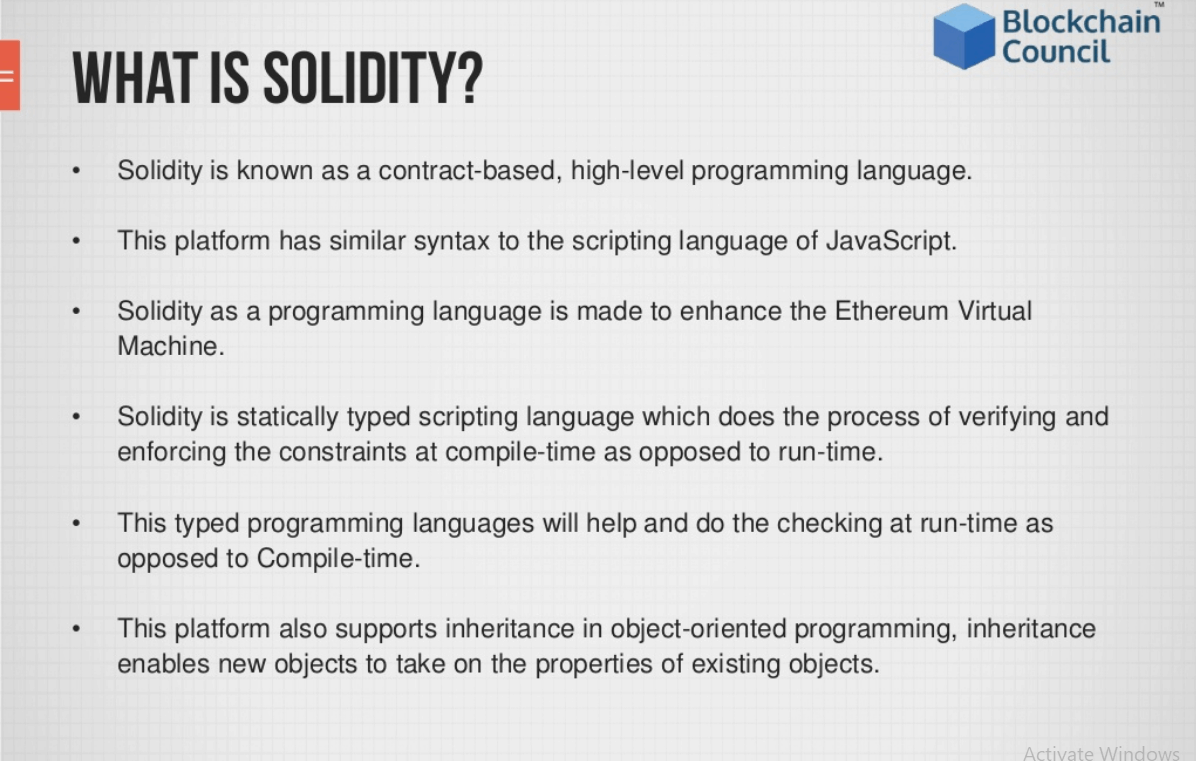
Solidity was initially proposed by Gavin Wood in August 2014.
It was then developed by Gavin Wood, Alex Beregszaszi, Christian Reitwiessner, Yoichi Hirai, Liana Husikyan, and other former Ethereum core contributors.
It was designed to enable the writing of smart contracts on platforms like Ethereum.
For programmers who are well versed in JavaScript or C, Solidity will seem relatively proverbial.
While Solidity is a fairly new language, there are numerous experts working on it, and there is ample documentation available to help new programmers who want to learn the basics.
Ethereum 2.0 Update
Ethereum has struggled with some scalability issues which could be a hurdle to the widespread adoption of the platform and Ether.
Ethereum wants to overcome these hurdles with Ethereum 2.0, also called the ‘Casper’ Upgrade. The upgrade was originally expected to arrive in 2019, although there are still many technical hurdles to overcome.
In August 2020, Ethereum 2.0 developers outlined several issued with the Medalla testnet, which was the first testnet that Ethereum 2.0 community members could use. The first issue was staking participation, which was fairly low – especially with Nimbus and Lodestar clients failing to verify some blocks and causing a 10% gap in expected staking – with a 57% staking participation. This number was also lower because some staking participants were offline when the network went live.
It will include concepts like sharding which is expected to make the blockchain faster and more efficient. We will examine more on sharding later in this article. Once successfully upgraded, Ethereum 2.0 will then start on its journey moving towards Ethereum 3.0 which will provide the network with security against the power of quantum computers.
Scaling
Scaling could be considered the Achilles’ heel of the Ethereum network; however, a lot of work is being done in the background to try and overcome this.
As Ethereum is not just a single blockchain, it also allows users to create their own blockchain-based projects on the original Ethereum blockchain.
Furthermore, over 1400 dApps are running on Ethereum currently which means that the network already has a large number of users and processes millions of transactions.
The problem begins when the number of apps, projects, and users increases to a level where the Ethereum blockchain nodes are unable to handle the ever-increasing amount of transactions.
In fact, when the CryptoKitties game on the Ethereum network went viral in late 2017, the network became congested and saw a 600% increase in pending transactions. This surge resulted in the network slowing down and expensive transactions fees, therefore, reducing the usability/viability of Ethereum applications.
The solutions currently being developed to overcome the scaling issue include:
- Casper – The upgrade that will set to bring about Ethereum 2.0 and move Ethereum to a Proof-of-Stake protocol. It is expected to occur in 2019.
- Sharding – Splits up the entire network into separate ‘shards’. Each independent shard and its allocated nodes can process certain transactions, rather than the entire network processing each transaction, therefore, increasing throughput.
- Serenity – A new blockchain system that would be connected to Ethereum. The goal would be to move all the existing Ethereum applications here where they would be “sort of folded into a contract on one shard of the new system.”
Proof of Stake vs. Proof of Work
Proof of Stake (PoS) and Proof of Work (PoW) are two popular types of blockchain consensus mechanisms.
A consensus mechanism is used to verify and validate the information that’s being added to the blockchain ledger. This ensures that there is no double-spending or other invalid data is being added to the blockchain. It also prevents the networks from being harmed through constant forking.
There are pros and cons to each consensus mechanism, but, they all aim to serve the same purpose. A primary difference between consensus mechanisms is how the verification of transactions are delegated and rewarded.
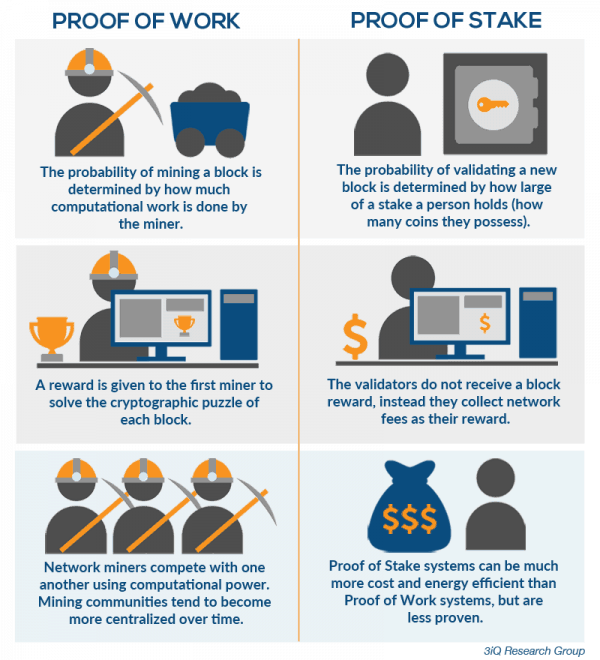
Ethereum currently uses a Proof of Work system, but the Casper upgrade will start the transition of Ethereum to a Proof of Stake system. The new system will also have a penalty system built in to punish malicious actors.
Good Audience state that:
“The penalty system has the additional benefit of deterring 51% attacks. In a PoW system, a 51% attack is costly but repeatable as long as enough hashing power has been collected. With PoS, the attackers run the risk of losing their stake should the attack fail. In such a case, the only way to relaunch an attack would be to acquire new Ether.”
Casper, Sharding & Ethereum 2.0
The roadmap to Ethereum 2.0 consists of two combined upgrades, which are Casper and Sharding, as is designed to bring scalability and security benefits to Ethereum. It may take several years for these both to be implemented fully and form Ethereum 2.0.
Despite that Casper and Sharding will be combined to form Ethereum 2.0, both are separate projects that will have different phases and implementation and completion times.
The Casper protocol is a proof of stake consensus mechanism that forms a major part of Ethereum 2.0 roadmap. With Casper, validators will have to set aside part of their Ether as a stake.
When blocks are discovered by validators which they think should be added to the Ethereum blockchain (validated), they will make a bet on it in Ether. If the block is appended to the chain then the validators are rewarded based on their bet sizes.
As mentioned above it will have built-in mechanisms for punishing malicious actors on the protocol which will ensure that they cannot game the system and that the system remains trustless. Validators acting badly will have their stakes removed.
Sharding, on the other hand, will divide the network into separate shards. Each shard will be designated to process specific transactions, which it can do so on its own.
Currently, the entire network is needed to process each transaction, which is likely an excessive use of the network’s resources. That’s why implementing sharding could significantly increase throughput on Ethereum and enable greater scaling.
This is how Vitalik Buterin explains sharding:
“Imagine that Ethereum has been split into thousands of islands. Each island can do its own thing. Each of the islands has its own unique features, and everyone is belonging on that island, i.e., the accounts, can interact with each other AND they can freely indulge in all its features. If they want to contact other islands, they will have to use some sort of protocol.”
Conclusion
Ethereum’s contribution to the blockchain/crypto world is enormous. Ethereum has opened up new possibilities with blockchain through the introduction of smart contracts, decentralized applications, and tokenized economies.
There is no doubt that Ethereum is still a work in progress. It has some issues, especially those related to scaling and the solutions needed will not just come overnight.
The future of Ethereum depends on how widely adopted and powerful the network becomes as well as the creativity and talent of the developers who use the platform. Ethereum indeed appears to be heading in the right direction, gaining the attention of many large corporations and institutions.
 The Enterprise Ethereum Alliance currently has over 386 members that support and back Ethereum related developments. Members include heavy hitters like Intel, JPMorgan, Microsoft, BP, and even the Indian Government.
The Enterprise Ethereum Alliance currently has over 386 members that support and back Ethereum related developments. Members include heavy hitters like Intel, JPMorgan, Microsoft, BP, and even the Indian Government.
No one can predict for sure what impact Ethereum will have, just like in the 1990’s no one knew how much the internet would impact the world. It’s still early days for Ethereum, but it certainly has the potential to be a revolutionary platform.
References & Resources:
- Ethereum Enterprise Alliance – Full list of EEA members
- Ethereum 2.0 – ETH 2.0 specs on GitHub
- Scaling Ethereum – Sharding explained by Prysmatic Labs
- Binance – Trading Ether on Binance
- Constantinople – Hard fork will be supported by OKEx
- Ether – What is Ether by Ethereum.org
- Ethereum Chart – Charts and price data provided by TradingView
- Smart Contract Platforms – List of awesome SC platforms on GitHub
- Congestion – How CryptoKitties congested Ethereum by Consensys
- Ether ATM – Ethereum ATM map by Coin ATM Radar
- Block Time – Average Ethereum block time by Etherscan
- Ether Wallets – About MyEtherWallet (MEW)
What is Ethereum? Read the ULTIMATE Research-Backed ETH Guide was originally found on Blokt - Privacy, Tech, Bitcoin, Blockchain & Cryptocurrency.
]]>![Private Internet Access (PIA) VPN Review: [2023] 118 pia review featured](https://blokt.com/wp-content/uploads/2019/05/pia-review-featured-300x168.jpg)
Today we’ll talk about PIA (Private Internet Access), a popular VPN that has been in business for almost 20 years. In the interest of full disclosure be aware that this writer used PIA for several years before switching to ExpressVPN in 2018. To help you decide whether PIA is the best VPN for you, we […]
Private Internet Access (PIA) VPN Review: [2023] was originally found on Blokt - Privacy, Tech, Bitcoin, Blockchain & Cryptocurrency.
]]>![Private Internet Access (PIA) VPN Review: [2023] 147 pia review featured](https://blokt.com/wp-content/uploads/2019/05/pia-review-featured-300x168.jpg)
Today we’ll talk about PIA (Private Internet Access), a popular VPN that has been in business for almost 20 years. In the interest of full disclosure be aware that this writer used PIA for several years before switching to ExpressVPN in 2018.
![Private Internet Access (PIA) VPN Review: [2023] 119 pia review featured](https://blokt.com/wp-content/uploads/2019/05/pia-review-featured.jpg)
To help you decide whether PIA is the best VPN for you, we divide this review into several sections. They include:
- Device Support
- Speed
- Security and Privacy
- Geographic and Legal Considerations
- Global Coverage
- Streaming and Torrenting
- Additional Considerations
- Customer Support
![Private Internet Access (PIA) VPN Review: [2023] 120 Private Internet Access VPN Source: privateinternetaccess.com](https://blokt.com/wp-content/uploads/2019/05/pia-vpn-main.jpg)
Device Support
PIA offers client applications for the mainstream operating systems. It also provides browser extensions for Chrome, Firefox, and Opera.
![Private Internet Access (PIA) VPN Review: [2023] 121 Private Internet Access for all your devices - Source: www.privateinternetaccess.com](https://blokt.com/wp-content/uploads/2019/05/pia-devices.png)
PIA has greatly improved its desktop clients since I last used the service. The company has created a consistent, attractive client interface across its desktop clients, although the mobile apps and browser extensions don’t match them right now.
![Private Internet Access (PIA) VPN Review: [2023] 122 Image courtesy of London Trust Media](https://blokt.com/wp-content/uploads/2019/05/london-pia.png)
Once you are logged into the client you have access to a wide range of options not normally seen in VPN clients, including a choice of DNS (including one provided by PIA), encryption type, even a light or dark theme for the client itself.
![Private Internet Access (PIA) VPN Review: [2023] 123 Private Internet Access](https://blokt.com/wp-content/uploads/2019/04/pia-logo.png)
Speed
Discussing the speed of a VPN Service is always tough since it depends on so many factors. Where you connect from, when you do it, and which ISP you use for the tests are just some of those factors.
Fortunately, when it comes to PIA, we have some independent test results we can use to answer the speed question. In 2018, one of PIA’s competitors commissioned a company called AV-TEST GmbH to do some independent testing. It ran a large set of tests on a dozen VPN Services, including PIA.
![Private Internet Access (PIA) VPN Review: [2023] 124 Speed Performance (PIA) - Source: Shutterstock.com](https://blokt.com/wp-content/uploads/2019/05/pia-speed.jpg)
The VPN Comparative Test report showed PIA to have better latency (ping), streaming, upload, and download speeds than most of the VPNs tested. Given this, it was surprising that PIA was one of the slowest VPNs among those tested.
These results imply that under most circumstances, PIA will be fast enough for most users. To find out if it will be fast enough for you, we recommend that you take advantage of its 7-day money-back guarantee to run some speed tests using your devices and your ISP in the locations where you are most likely to be using the VPN.
Then compare your test results with the data in this April 5, 2019, Consumer Reports article discussing the download speeds needed to stream different types of multimedia content.
A few rounds of testing in typical situations where you would use PIA should give you enough information to decide if this VPN is fast enough for you.
Security and Privacy
Now we need to talk about security and privacy. While related, they are not the same thing. The differences become particularly important when talking about PIA since it is based in the United States.
![Private Internet Access (PIA) VPN Review: [2023] 125 Security and Privacy(PIA) - Source: Shutterstock.com](https://blokt.com/wp-content/uploads/2019/05/securityandprivacy.jpg)
By the time you finish this section of the article, you will have a good sense of how security and privacy differ, and how the two play out with PIA.
PIA Security
Security means being able to keep others from messing with your stuff. Locking the doors of your house provides security for you and everything else in the house. Putting money in a vault provides security for your money.
VPN security is provided by two technologies: tunneling and encryption.
Tunneling
Tunneling involves taking each data packet that moves between your computer and the VPN and putting that data packet inside another data packet. This “outer” data packet has a standard format that is used by the VPN.
The original packet is hidden inside the VPN formatted data packet. To an outside observer, it simply looks like standardized data packets are passing back and forth between your computer and the VPN.
![Private Internet Access (PIA) VPN Review: [2023] 126 Tunneling(PIA) - Source: Shutterstock.com](https://blokt.com/wp-content/uploads/2019/05/tunneling.jpg)
Putting your data packets inside standardized VPN data packets is called encapsulation. The VPN software on your computer and the software in the VPN server both can encapsulate packets into VPN formatted packets and extract them again. Once extracted, these packets function the same way they would have if there was no VPN involved at all.
OpenVPN is widely-respected, open source software that handles encapsulation as well as encryption for the best VPN services.
Encryption
Encapsulation provides one layer of protection for the messages flowing between your computer and the VPN. But someone with the right software who can intercept the VPN packets flowing back and forth can extract the original data packets.
To deal with this problem, VPNs use encryption. Before encapsulating message packets for tunneling, the VPN software on your computer or in the server encrypts the message packets. In theory, only your computer and the VPN can read packets that are encrypted.
![Private Internet Access (PIA) VPN Review: [2023] 127 Encryption(PIA) - Source: Shutterstock.com](https://blokt.com/wp-content/uploads/2019/05/encryption.jpg)
VPNs employ various encryption techniques. Some are now obsolete in that computers have become powerful enough to quickly crack their encryption. Others are too hard to crack but have weaknesses built into them called backdoors that allow anyone who knows how to use the backdoor to easily decrypt the messages.
And others are, as far as we know, uncrackable within any reasonable amount of time and free of backdoors.
PIA supports several of the most popular encryption techniques, including AES-256. This encryption standard is considered “military-grade” as it is used in the most secure military and commercial applications.
IP Address Leaks
Your IP Address can be used to identify your specific computer or mobile device, making it relatively easy to identify you. You want to be sure that your VPN never exposes that information on the Internet.
Without going into too much detail, there are three types of leaks: IP leaks, DNS leaks, and WebRTC leaks. Testing shows that PIA prevents all three of these types of leaks.
Another situation that could cause your IP Address to leak is if your connection to the VPN fails for some reason. Typically if the VPN connection fails, your computer will revert to its normal connection to the Internet. That exposes your IP Address to anyone who happens to be looking.
![Private Internet Access (PIA) VPN Review: [2023] 128 IP Address Leaks(PIA) - Source: Shutterstock.com](https://blokt.com/wp-content/uploads/2019/05/ip-address-leaks.jpg)
To deal with this problem, the best VPNs include a Kill Switch. The Kill Switch is software that automatically disconnects your computer from the Internet if the VPN fails.
PIA comes with a built-in Kill Switch. However, the Kill Switch is not enabled by default. You must enable it manually. There was a bit of controversy about the PIA Kill Switch in 2018, with some users reporting that the switch failed to reliably disconnect their computer from the Internet under certain circumstances.
We haven’t seen any recent complaints about this issue, but if the Kill Switch is important to you, we suggest you contact PIA Support and ask about this before licensing the product.
PIA DNS
Like industry leader ExpressVPN, PIA provides its own DNS service. Many VPNs encrypt messages passing through their network but use third-party DNS servers to resolve IP Addresses.
PIA sets the DNS Server addresses in your operating system to point to its private DNS servers. Directing all DNS requests through the VPN to private PIA DNS servers prevents your IP Address from being exposed as a DNS leak.
PIA Privacy Policy & Confirmation of No-Logs Status
PIA is a “no-logs” VPN. That means it records no data that could be used to track your activities online or associate you with specific activities. Illustrating how serious it is about this, PIA posted this video by Rick Falvinge.
Rick Falvinge founded the Swedish Pirate Party in 2006. Today he is the Head of Privacy at Private Internet Access. In the following video, he explains that PIA does not log and what it would do if the US Government (or anyone else) tried to force it to keep logs.
Rick is a prominent member of the bitcoin cash community and is a very ideologically driven individual and very anti-government. Having someone like that to head your privacy is a very good sign that things are working correctly.
And PIA’s dedication to the privacy of its users isn’t just talk. It has been demonstrated in two court cases. First, in a 2016 FBI case dealing with a fake bomb threat, and again in a 2018 FBI hacking case, PIA was unable to provide the FBI the information they desired. In both cases, PIA simply did not have the data because it doesn’t keep logs of user activity. It only records the email address you use to sign up for its service.
Geographic and Legal Considerations
So far, PIA is looking like a very fine VPN service. It is in this section of the article that things get a little muddier.
Legal Jurisdiction
Since VPNs exist to provide online privacy and security, where they are located can make a big difference. Different countries have different laws about privacy, Internet use, encryption, censorship and so on.
For example, some countries require all online services, including VPNs, to keep detailed records of where the users go online and what they do. These records must be made available to local law enforcement or government officials as required by local laws.
![Private Internet Access (PIA) VPN Review: [2023] 129 Legal Jurisdiction - Source: Shutterstock.com](https://blokt.com/wp-content/uploads/2019/05/kegal-jurisdiction.jpg)
Other countries are heavy into censorship, demanding that online services (possibly including local VPNs) block users from visiting sites that the local bureaucrats dislike.
The United States takes a different approach. The government doesn’t censor sites. Instead, private businesses like Google and Facebook censor content under pressure from politicians and activist groups.
The USA also doesn’t require VPNs based in the USA to record everything users do online. Instead, law enforcement and intelligence agencies can force online services, including VPNs, to secretly record data about specific individuals using their services.
What does all this have to do with PIA? London Trust Media, Inc., the parent company of PIA, is based in Denver, CO. That means that it is under US jurisdiction, and could be subjected to pressure from law enforcement and intelligence agencies to secretly record data about you.
![Private Internet Access (PIA) VPN Review: [2023] 130 London Trust Media, Inc. - Source: londontrustmedia.com](https://blokt.com/wp-content/uploads/2019/05/londontrustmedia.jpg)
Normally servers that are located in other countries are governed by those laws, rather than the laws of the country where the company is based. However, in past disputes, the United States has tried to force companies to comply with US laws even for resources (like VPN servers) that are located outside US territory.
While we urge you to avoid doing anything illegal online, and it is highly unlikely that anyone reading this will be targeted for individual attention by the FBI or NSA, there are other high-quality VPNs that are based in more privacy-friendly jurisdictions.
The Mt. Gox / PIA Connection
If you are into cryptocurrencies you have probably heard of Mt. Gox. This was an early Bitcoin exchange based in Japan. It ended up declaring bankruptcy in 2014 after a lawsuit, seizures of cash by the US Department of Homeland Security, technical problems preventing users from withdrawing money, charges of stolen Bitcoins, amongst other problems.
![Private Internet Access (PIA) VPN Review: [2023] 131 The Mt. Gox / PIA Connection - Source: Shutterstock.com](https://blokt.com/wp-content/uploads/2019/05/mtgox.jpg)
Mt. Gox creditors claimed to have lost over 2 trillion dollars during this mess. The CEO of Mt. Gox was arrested in August 2015 and charged with several offenses including embezzlement and fraud.
On March 14, 2019, the Tokyo District Court found the former CEO guilty of falsifying data but acquitted him of embezzlement and other charges. He is currently free of jail on a 4-year suspended sentence.
What does the Mt. Gox situation have to do with PIA? Mark Karpelès is the former CEO of Mt. Gox. He was hired as the CTO of London Trust Media, the parent company of PIA, in April of 2018. His hiring raised doubts about continuing with PIA among some users.
The fact that Mr. Karpelès was recently acquitted of most charges is a good sign, although the following passage from a Bloomberg story about his recent court appearance isn’t comforting:
Physical Distance
Messages take a finite amount of time to traverse the connections on the Internet-based on how far they must go. Connecting to a VPN almost always makes messages travel further. But you can minimize this problem by choosing to connect to a VPN server close to your physical location, or physically close to the Internet resource you want to use.
PIA has servers in 32 countries. This gives you a reasonably good chance of connecting to a VPN server that is physically close. You might want to check out the PIA Network page to see if it has servers where you need them.
Global Coverage
As you can see in the screenshot below, as of April 23, 2019, PIA had over 3,300 servers in 52 locations spread across 32 countries.
![Private Internet Access (PIA) VPN Review: [2023] 133 Global Coverage-PIA](https://blokt.com/wp-content/uploads/2019/05/global-coverage.jpg)
The PIA network has a good number of servers, but they are located in fewer countries than some of its major competitors like NordVPN and ExpressVPN. Still, unless you need to reach some of the less-popular services in the world, it should suffice.
If you want to access a streaming service that only accepts users from a country that is not listed above, you might want to reconsider. There are plenty of other VPN providers who have a better spread of servers in many locations across the world. If you are looking for a list of our top recommendations see our best VPN guide.
Streaming and Torrenting
For many people, the number one use of a VPN is for streaming multimedia content and/or torrenting (downloading content). In this section, we’ll look into how well PIA serves this audience. We currently rank it number 4 on our best VPNs for torrenting list.
![Private Internet Access (PIA) VPN Review: [2023] 134 Streaming and Torrenting(PIA) - Source: Shutterstock.com](https://blokt.com/wp-content/uploads/2019/05/streamingandtorrenting.jpg)
Streaming and Torrenting Speed
PIA servers are generally fast enough for streaming and torrenting without a lot of annoying drops or delays. And like industry leader ExpressVPN, it also provides a SOCKS5 proxy server that gives you a faster connection. But you have to be careful. Why? We’ll cover that in the next sections.
Security While Streaming
Most streaming media companies often have contractual and legal requirements to control where in the world their content is available. For example, Netflix has one library of content for the USA, another for the UK, and so on.
They use a technique called geo-blocking to prevent people from accessing the “wrong” library. This setup means that you may not be able to access the content you pay for simply because you happen to be in another location when you try to connect.
Geo-blocking systems check the IP Address you are using to decide if you are allowed to view the content you are trying to get. You can use a VPN or a proxy to get around this problem. By connecting to the service using a VPN server that is located in an “approved” location, you may be able to evade the geo-blocking system.
![Private Internet Access (PIA) VPN Review: [2023] 135 Security While Streaming(PIA) - Source: Shutterstock.com](https://blokt.com/wp-content/uploads/2019/05/securitywhilestreaming.jpg)
Standard proxy servers provide the same kind of location-shifting ability as a VPN, but without the encryption. A SOCKS5 proxy server like that provided by PIA provides more protection than a regular proxy server, but less than a VPN.
In other words, you have a tradeoff to make:
- Step 1: You can use the full PIA VPN service when you want to stream content. This is the most secure way to go, but the strong encryption this gives you means you will have a slower connection.
- Step 2: You can use the SOCKS5 proxy when you want to stream content. This is faster but less secure than using the full PIA VPN.
What about Netflix?
Netflix puts a lot of effort into ensuring that its content only gets streamed where it wants it to be. It uses tools like databases of the IP Addresses of known VPNs to try to prevent anyone from getting around its geo-blocking. And Netflix is good at it. PIA has had some success at getting around these blocks, but this is an ongoing battle, and there are no guarantees.
![Private Internet Access (PIA) VPN Review: [2023] 136 About Netflix(PIA) - Source: Shutterstock.com](https://blokt.com/wp-content/uploads/2019/04/netflix.jpg)
We haven’t seen any results showing that the SOCKS5 proxy is better than the full PIA VPN for connecting to Netflix or vice versa. If connecting to Netflix is very important to you, you may want to consider ExpressVPN or NordVPN, both of which have good reputations as VPNs for Netflix.
Security While Torrenting
Being secure while torrenting is an important issue. That’s because, in many, if not most countries, torrenting is illegal. The USA, for example, has the DMCA (Digital Millennium Content Act).
Under the DMCA, downloading a copyrighted movie, or even a single 3-minute song can result in up to 5 years in prison and a fine of up to $150,000 per file. Whether or not you consider these penalties wildly out of line with the severity of the “crime,” this is the law.
![Private Internet Access (PIA) VPN Review: [2023] 137 Security While Torrenting(PIA) - Source: Shutterstock.com](https://blokt.com/wp-content/uploads/2019/05/security-torrenting.jpg)
This law does not just apply to commercial pirates. Here are some cases where these massive penalties have been applied:
- A college student fined $675,000 for downloading 30 songs.
- A single mom by the name of Jammie Thomas-Rasset, who was fined over a million dollars for downloading 24 songs.
Several other countries have similarly brutal copyright laws.
Obviously, the best way to avoid this kind of life-destroying risk is to not download copyrighted content. But if you are one of the tens of millions of people worldwide who intends to torrent multimedia content in spite of such laws, a VPN can provide some protection.
Services like PIA hide your IP Address when you are torrenting and don’t keep logs that would allow the authorities to identify you.
The question is what happens if your connection to the VPN fails. With some services, your computer simply reverts to communicating without protection, exposing your IP Address to the world. The better VPNs all implement something called a Kill Switch. This is a system that disconnects your computer from the Internet if the connection to the VPN fails.
PIA includes a Kill Switch that you must enable manually. We strongly recommend that you turn this on and leave it on. Note that as recently as May of 2018, there were online complaints that the PIA Kill Switch was not reliable and sometimes exposed a user’s IP Address when it should not have. But we haven’t seen any such complaints since then, implying that PIA has fixed the problem.
Additional Considerations
Here are additional considerations to take into account when looking at PIA.
![Private Internet Access (PIA) VPN Review: [2023] 138 Additional Considerations(PIA) - Source: Shutterstock.com](https://blokt.com/wp-content/uploads/2019/05/additional-considerations.jpg)
Connections
This is one area where PIA shines. It allows 10 simultaneous connections to its service. That is, you can have 10 devices of whatever type actively using the VPN service at once.
This is impressively generous. Most services offer between 3 and 6 simultaneous connections.
![Private Internet Access (PIA) VPN Review: [2023] 139 Connections(PIA) - Source: Shutterstock.com](https://blokt.com/wp-content/uploads/2019/05/connections.jpg)
Now it is hard to imagine most people needing more than 10 simultaneous connections, but what can you do if you do need more? PIA can be installed on a router, which means that every device connected to that router automatically gets connected to the PIA VPN network.
PIA gives you a couple of ways to set this up:
- Step 1: You can buy a router that comes with PIA already installed and configured. You can get routers with PIA pre-installed on them from several manufacturers. More information on this option is available under the Plug n’ Play Router Setup heading.
- Step 2: You can install PIA on your current router. This takes some technical chops, and not every router is supported. To find out which routers are supported, check the Advanced Router Setup heading.
Price
By this point, you are probably wondering what it would cost you to sign up for PIA. Unlike some of its competitors, PIA makes things simple. Every payment option includes the full-service offering. The only difference is that the price varies depending on the length of the subscription you sign up for. Here are the prices listed at the end of March 2020:
![Private Internet Access (PIA) VPN Review: [2023] 140 Price (PIA) - Source: privateinternetaccess.com](https://blokt.com/wp-content/uploads/2019/05/price.png)
| Length of Plan | Price | Total Price Billed Up Front |
| 1-month | $9.95 per month | $9.95 |
| 1-year | $5.99 per month (billed once per year) | $71.88 |
| 2-year | $3.49 per month (billed once every 2 years) | $83.87 |
A month-by-month subscription to PIA is about $10 per month, which is pretty typical. As you might expect, if you sign up for a longer-term subscription the monthly price drops. The $3.49 per month price for a 2-year subscription is good, putting PIA in the ranks of less-expensive services.
PIA offers a 7-day money-back guarantee in lieu of a free trial. This is okay, but it would be nice if it gave a longer trial period.
PIA is creative with its payment methods. It supports all the usual credit cards, PayPal, and a range of cryptocurrencies, as shown here:
![Private Internet Access (PIA) VPN Review: [2023] 141 PIA is creative with their payment methods](https://blokt.com/wp-content/uploads/2019/05/payment-method.png)
Beyond this, PIA supports its own gift cards and even allows you to trade in gift cards from various stores to pay for your subscription:
![Private Internet Access (PIA) VPN Review: [2023] 142 Gift cards from various stores to pay for your subscription](https://blokt.com/wp-content/uploads/2019/05/gift-cards.png)
Customer Support
Customer Service was a weak point with PIA when this writer was a subscriber. However, in the last year or so the company has made major strides in this area. As PIA themselves said in 2017:
![Private Internet Access (PIA) VPN Review: [2023] 144 Customer Support - Source: www.privateinternetaccess.com](https://blokt.com/wp-content/uploads/2019/05/helpdesk.png)
It seems that this increased emphasis has paid off for the company. These days there are few complaints about PIA’s support visible online.
Conclusion
PIA is a VPN service that has some strong points and some disappointing negatives. If you need a lot of simultaneous connections at a low price and don’t mind a USA-based service, you should definitely check it out. But if you live in the United States or don’t need lots of connections at a low price, there are other options that would probably serve you better.
![Private Internet Access (PIA) VPN Review: [2023] 145 Conclusion - Source: Shutterstock.com](https://blokt.com/wp-content/uploads/2019/05/conclusion-1.jpg)
![Private Internet Access (PIA) VPN Review: [2023] 123 Private Internet Access](https://blokt.com/wp-content/uploads/2019/04/pia-logo.png)
Disclosure: Blokt strives to provide transparent, honest reviews, and opinions. The writer of this article is a user of the product(s) or service(s) mentioned in this article and was not influenced by the respective owners.
We rarely run ads, but sometimes earn a small commission when you purchase a product or service via a link on our site. Thank you kindly for your support.
Read more or donate here.
Private Internet Access (PIA) VPN Review: [2023] was originally found on Blokt - Privacy, Tech, Bitcoin, Blockchain & Cryptocurrency.
]]>![Best VPNs For Google Chrome [2023] 149 Best VPN for Google Chroem](https://blokt.com/wp-content/uploads/2020/05/best-vpns-for-chrome-300x168.png)
Chances are, you’re reading this from the world’s most popular web browser, Google Chrome. According to StatCounter, almost 65% of internet users access the web through Chrome or a Chromium-based browser. Chromium open-source software also powers new arrivals to the browser scene, such as Brave, which means that all the VPN extensions we’ll be looking […]
Best VPNs For Google Chrome [2023] was originally found on Blokt - Privacy, Tech, Bitcoin, Blockchain & Cryptocurrency.
]]>![Best VPNs For Google Chrome [2023] 157 Best VPN for Google Chroem](https://blokt.com/wp-content/uploads/2020/05/best-vpns-for-chrome-300x168.png)
Chances are, you’re reading this from the world’s most popular web browser, Google Chrome. According to StatCounter, almost 65% of internet users access the web through Chrome or a Chromium-based browser.
Chromium open-source software also powers new arrivals to the browser scene, such as Brave, which means that all the VPN extensions we’ll be looking at here are also compatible with any other Chromium based browsers.
This guide is also going to be relevant to Google Chromebook users – but with one important distinction.
If you’re a Chromebook user, all of the browser extensions below will only encrypt your internet traffic while you’re inside a Chrome browser session. You’ll need to download the Android client for each of these VPN’s to use it on your Chromebook.
Why do you need a VPN extension for Chrome?
You might think that having a VPN application installed and running from your desktop will give you complete privacy – but you’d be wrong.
Although VPN applications reroute your traffic through a private server and mask your IP, there are still certain ways that you can be tracked through your browser session.
To show you local recommendations and services, many websites will track your session through HTML5 geolocation, which reveals your approximate location – with greater accuracy if you’re using a GPS enabled device.
It’s a little-known way that websites can see your approximate location without tracking your IP, and it’s especially annoying if you’re making an effort not to be served ads, or get tracked as you navigate the web.
Most quality VPN extensions for Chrome will spoof your location, which prevents HTML5 geolocation from establishing your location.
Traditional location tracking through your IP will use ‘web real-time communication’, or WebRTC, to track you during your session. Most VPNs will block this even through their desktop apps, but you can ensure your session is private through a browser extension.
Often, VPN providers will refer to their Chrome extensions as ‘proxy extensions’, because of the extra security they afford their users. Here, we’re going to look at the best VPNs for both the Google Chrome browser, and the Google Chromebook.
ExpressVPN
ExpressVPN is a service we’ve reviewed extensively in the past, and it’s always been one of our favorite services.
Established in 2009, ExpressVPN has been providing military-grade traffic encryption and privacy protection for over a decade, and in May 2019 they launched the latest iteration of their Chrome extension.
One of the highest-rated VPN browser extensions on the market, the ExpressVPN Chrome extension offers serious browsing protection for users of all levels. The extension was last updated in March 2020.
To install the ExpressVPN Chrome browser extension, you’ll first need to have the desktop app (full client) for Windows, Mac, Android (and also Chromebook), or Linux, and an active ExpressVPN subscription. You can sign up here.
The ExpressVPN app for Chrome has a 4.2 star rating from over 650 users, and 800,000 downloads. Users can also download an Android client for ExpressVPN to protect their Chromebook.
ExpressVPN for Chrome features
![Best VPNs For Google Chrome [2023] 151 ExpressVPN](https://blokt.com/wp-content/uploads/2020/04/ExpressVPNexample.jpg)
There’s a lot of crossover between the ExpressVPN desktop app and their Chrome extension, however there’s a few extra features to keep you safe while browsing, which include:
- Location spoofing – Prevents HTML5 geolocation code embedded in websites from revealing your true whereabouts.
- One-click connection – Once you’ve installed the extension, you can turn it off or on in seconds using the icon in the top right corner of your browser. You’ll automatically connect to the last place you connected to on your desktop app.
- WebRTC blocking – ExpressVPN ensures your location is obfuscated through changing your IP address.
- HTTPS upgrade – If you connect to a site which doesn’t have HTTPS protection, the ExpressVPN extension will automatically connect you to a more secure version of the site, which helps to protect your personal data.
Once you’ve downloaded and installed the extension, it’s added to your Chrome toolbar (in the top right corner next to your user profile by default), and you can open the extension to change settings like server location, HTTPS settings, and more.
Is ExpressVPN reliable?
As one of the best-established and most trusted VPN services, ExpressVPN has gained a good reputation for providing reliable and safe internet privacy.
Over the years, they’ve built a huge network of dedicated servers and infrastructure to provide a stable service to users, which includes:
- Unlimited bandwidth – Some smaller VPN operators place restrictions on bandwidth, but with ExpressVPN’s network of over 3,000 servers across 94 countries, you can enjoy unlimited use of your VPN.
- Streaming services – ExpressVPN works hard to keep support open for streaming services, like Netflix and Amazon Prime, allowing users to bypass geo-restrictions.
- Anonymous browsing – Together with their HTML5 and WebRTC blocking, ExpressVPN uses TrustedServer technology to encrypt browsing data as you surf Chrome.
- Multi-device support – Whether you’re browsing Chrome from a Windows, Android, Iphone, Mac, or Linux device, you can install ExpressVPN. Chrome extensions are only available to desktop users. Chromebook users are supported via the Android client.
Does ExpressVPN support streaming services?
ExpressVPN does provide guarantees that it’s users will be able to bypass most major streaming services, for instance if they’re trying to watch American Netflix from Europe.
This is known as bypassing ‘georestrictions’, and whilst some VPNs provide this dedicated service, many do not.
ExpressVPN is well known for its support of geo-restriction bypassing on all devices, including inside the Chrome browser and Chromebook, and they also offer a 30-day money back guarantee if the service happens not to work for you.
How much does ExpressVPN cost?
As we mentioned, you’ll need a subscription and the desktop app to use the ExpressVPN browser extension.
To download the ExpressVPN client to your desktop, you’ll also need to first have an active subscription, so make sure you’ve visited ExpressVPN’s website and signed-up before you try to add their Chrome extension, because it won’t work otherwise.
ExpressVPN is one of the more expensive VPN providers, but we think their reputation, security, and customer service makes up for this somewhat.
Subscription costs $12.95 per month billed on a month-by-month basis, reduced to $8.32 per month if you subscribe and pay up front for a year’s service.
This will set you back $99.95 in a lump sum, but it’s equivalent to savings of over $55 – which makes the service more affordable. You can pay for ExpressVPN with Bitcoin.
|
Contract Length |
Monthly Price |
| Monthly |
$12.95 |
| Yearly |
$8.32 |
ExpressVPN Chrome extension verdict
Since their update in May 2019, ExpressVPN’s Chrome extension is one of the most downloaded browser extensions of any VPN provider, trusted by almost a million users.
Their high rating on the Chrome web store is a good indication of how well the extension performs.
We particularly like how easy it is to install and connect to the service. If you’re an ExpressVPN desktop user, it takes literally seconds to install and use the extension – and we really recommend you do.
It’s not intrusive either, there’s no annoying notifications or pop-ups while you’re browsing – it simply sits on the toolbar and does its job.
Overall, ExpressVPN is a great choice for both Chromebook and Chrome browser users who want an extra layer of protection.
NordVPN
![Best VPNs For Google Chrome [2023] 152 NordVPN Chrome](https://blokt.com/wp-content/uploads/2020/04/NordVPNConnected.jpg)
Another of our regularly featured VPN providers, we’ve previously highly recommended NordVPN for both it’s affordable subscription prices, and consistently reliable service.
One of the VPN industries biggest names, NordVPN launched in 2012 out of Panama, and has grown into a behemoth of the VPN space – serving over 12 million users worldwide.
Their Chrome extension, first launched in 2017, is a great way to ensure NordVPN’s privacy extension extends to every part of your browsing experience. Downloaded by half a million users, the extension generally has good reviews, with a three-star rating overall.
It’s worth mentioning here that NordVPN also has an incredibly useful password manager Chrome extension called NordPass. This is a fairly new service by NordVPN and it offers a single secure place to store passwords and login information. All passwords are encrypted using XChaCha20 – the latest encryption technology.
NordVPN’s Chrome extension was recently updated in December 2019, and the team publishes regular updates to the service.
NordVPN for Chrome features
We’ll take a look at some of NordVPNs wider VPN features below, but there’s several unique services included in their Chrome extension which makes it well worth considering:
- HTTP encryption – All traffic moving through the NordVPN Chrome extension is encrypted using the Transport Layer Security protocol (TLS 1.2), which provides an extra layer of privacy to your web inputs and activity.
- WebRTC leak protection – Like ExpressVPN, NordVPN’s browser extension prevents WebRTC leaks while you’re inside a browser session, which could reveal your true location even while your desktop VPN application is running.
- Malware protection – A unique feature we love about NordVPN is their ‘CyberSec’ protection, which actively protects users from intrusive auto-play adverts, pop-ups, and unauthorized downloads while you’re browsing the web.
- Unique IP’s – It’s well-known that NordVPN has one of the largest ranges of servers of any VPN service, but they also provide access to over 1,100 unique IP addresses in over 60 countries that users can connect to through their Chrome extension.
- Ranked Num 1 – Ranked our num 1 best VPN overall, as well as the best for torrenting, gaming and much more.
Is NordVPN reliable?
As one of the most used VPN providers in the world, NordVPN is generally trusted for its reliability and safety.
We actually rank NordVPN as the number one VPN in our best VPN guide for 2020. We also have a very detailed 2000+ word Nordvpn review that is worth reading.
We previously found that NordVPN consistently ranks near the top, or in leading position, for virtually every category in VPN performance, but here’s a few overall features which make NordVPN a great choice:
- Special servers – NordVPN have developed a number of special servers which offer added browsing protection, including ‘Onion over VPN’, double VPN connection, and more. These features aren’t available via the Chrome extension, but you can still connect through your desktop app while receiving added security from your extension.
- Streaming – Slow streaming over VPN is a thing of the past with NordVPN, who use their thousands of servers to provide fast and reliable access to streaming services such as Netflix and Hulu, with unlimited bandwidth and bypassing geo-restrictions.
- No-log policy – User data, browsing history, and access information are never stored by NordVPN, and they don’t comply with requests for this data. Their no-logs policy is independently verified by third-party auditors.
Does NordVPN support streaming services?
If you’re watching Netflix, Hulu, Amazon Prime, or any other major streaming service through your Chrome browser, you’ll be pleased to know that you can use NordVPN to bypass geo-location restrictions.
The NordVPN team works hard to keep these services available, and their huge network of servers let’s most users slip past restrictions every time.
If you’re just watching shows in your Chrome browser, then the NordVPN extension may be all you need to manage your VPN connection – without launching the full client.
How much does NordVPN cost?
Like most other providers, it’s cheaper to sign-up to NordVPN with a longer subscription than paying monthly – and NordVPN offers some of the largest savings for long-term subscribers of any provider.
NordVPN offers a few different pricing plans. From least to most expensive, these are Standard, Plus, and Complete. Each plan provides more features as they get more expensive.
For a two year complete subscription, users pay just $134.73 in one lump sum. This may sound like a lot, but this equates to just $5.61 per month – a saving of over $200 compared to paying a monthly subscription at $14.99 per month.
That’s three years protection for less than one year’s subscription when paid monthly. This hugely affordable price has definitely contributed to NordVPNs success, and it’s proof that you can get a professional product at good prices.
Once you’ve subscribed, you can download the Android client if you’re using a Google Chromebook, then install the Chrome extension – you’ll be logged in automatically, and connected to your last used VPN server.
|
Contract Length |
Monthly Price |
|
Monthly |
$14.99 |
| Yearly |
$4.05 |
| Two Years |
$5.61 |
NordVPN Chrome extension verdict
Design wise, the NordVPN Chrome extension is very user friendly, easy to install and use, and doesn’t obstruct your browsing experience.
The NordVPN icon sits in your browser’s toolbar, displaying a small green block of text showing the country you’re connected to – a useful feature if you regularly access services in different jurisdictions.
CyberSec protection is a really interesting feature by NordVPN, and their inclusion of it in their Chrome extension provides yet another layer of protection against all sorts of malware and attacks, pop-ups, and auto-play adverts.
As a result the NordVPN Chrome extension is one of the few VPN extensions that doubles up as a basic ad-blocker and anti-tracker in one, making your browsing experience more pleasant.
It does have a lower score on the Chrome web store than ExpressVPN, but we found the functionality quite similar and just as good overall.
If you’re looking for an affordable Chromebook VPN with plenty of features, and a well designed browser extension, then NordVPN is a great choice.
TunnelBear
The only VPN which promises to ‘put a bear in your browser’, TunnelBear is a Canadian VPN provider, owned by cyber-security firm McAfee. The service claims to have 20 million users – more than other leading brands NordVPN and ExpressVPN.
There are full Android clients available for Chromebook users, and the Google Chrome extension takes just a few seconds to download.
TunnelBear really started coming into their own following their acquisition by McAfee in 2018, but their Chrome extension is already one of the most downloaded on the web store, and has incredible reviews from its users.
Of 700,000 users, there are almost 33,000 reviews of the TunnelBear Chrome extension, with an amazing 5-star rating – the highest on our list. The last update of their extension was released in October 2019.
Compare this to just the few hundred reviews by users of NordVPN and ExpressVPN, and it’s easy to see that TunnelBear must have something worth shouting about. Let’s find out what it is!
TunnelBear for Chrome features
![Best VPNs For Google Chrome [2023] 153 TunnelChromeVPN](https://blokt.com/wp-content/uploads/2020/04/tunnelbearchrome.png)
Remember, when you’re using the Chrome extension for TunnelBear, you’re only protected whilst you’re inside that browsing session. We strongly recommend downloading the Android full client to protect your entire traffic.
That said, TunnelBear has built a robust VPN Chrome extension which works well as stand-alone protection for lightweight tasks like browsing the web on the go. These include:
- Tracking protection – If you simply want a VPN service to stop annoying ads being served that track your whereabouts, then the TunnelBear extension works great. It blocks your IP by tunneling through their VPN servers.
- Avoid regional blocking – If a website is blocked to users from your jurisdiction, the TunnelBear Chrome extension is a really easy way to bypass these restrictions. You can do this without downloading the full client for your device.
- Public WiFi protection – Connecting to public WiFi without VPN protection is dangerous. It’s easy for attackers to gain access to your device, and lift personal information about your browsing session – such as payment info. If you only use public WiFi occasionally, then TunnelBear’s Chrome extension is an easy way to get basic protection.
TunnelBear Blocker
![Best VPNs For Google Chrome [2023] 154 tunnelbearchrome2](https://blokt.com/wp-content/uploads/2020/04/tunnelbearchrome2.jpg)
The TunnelBear Blocker is a standalone extension for Chrome, but it works alongside their VPN service really well. The extension blocks all ads like a traditional ad-blocker, but it also prevents email tracking, browser fingerprinting, and more.
Users can also use the TunnelBear Blocker to prevent Adobe Flash applications from running automatically within Chrome, as well as prevent third-party tracking as you navigate between sites.
If you’re thinking of installing the TunnelBear VPN extension, we also recommend you use the TunnelBear Blocker, for complete protection.
Does TunnelBear support streaming services?
Unfortunately, TunnelBear doesn’t currently guarantee users will be able to bypass geo-restrictions that many major streaming services enforce.
That’s not to say no streaming services will work while using TunnelBear, and it’s possible that many might, and there could be certain workarounds.
However, with their fairly limited range of servers, many TunnelBear VPN connections have already been identified and blocked by streaming services.
How much does TunnelBear cost?
There’s no extra cost for downloading and using the TunnelBear Chrome extension, and in actual fact, you can even use 500 MB of data over the VPN service for free.
However, to use the full client for Android on your Chromebook past your free allowance, you’ll need a subscription.
TunnelBear is one of the most affordable VPN services, at just $3.33 per month – with no hidden costs or lengthy subscription services. You can even pay for your subscription in Bitcoin at no extra cost!
|
Contract Length |
Monthly Price |
|
First 500 MB |
Free |
| Monthly |
$3.33 |
TunnelBear for Chrome verdict
If you’re a casual user, who simply wants a VPN Chrome extension to limit intrusive adverts, and encrypt your traffic, then you’ll likely love the simplicity and 500MB of free data from TunnelBear.
However, we can’t recommend only using the TunnelBear browser extension, or free data, if you need a high level of protection. If you need to protect your privacy and encrypt your traffic, for instance doing business work over a public WiFi network, then we recommend you download a full Android client for your Chromebook.
TunnelBear is definitely aimed at a more casual range of users than ExpressVPN, NordVPN, or CyberGhost – which we’ll look at below. For instance, there’s no specific access to specialty servers, and the level of protection and server locations are limited compared to competitors.
Nevertheless, as a basic VPN for front-line protection on public networks and while bypassing geo-restrictions, TunnelBear’s full client for Chromebook and their Google Chrome extension is a great choice – and a very affordable one too.
Private Internet Access
Private Internet Access, often abbreviated to ‘PIA’, is a veteran VPN provider who have been in business for almost 20 years, providing its users with exactly what it says on the tin – greater privacy while browsing the web.P
Although it’s not as well known as NordVPN or ExpressVPN, PIA has a lot of features to offer, and it’s also compatible with Chromebook – albeit with a little advanced setup that might not be suitable for beginners.
PIA does however have a very well designed Google Chrome extension, which provides additional protection while in a Chrome session, and it’s well worth considering. Let’s discover its features.
The PIA Chrome extension has over 100,000 downloads and a 4-star user rating.
PIA Chrome extension features
![Best VPNs For Google Chrome [2023] 155 pia1](https://blokt.com/wp-content/uploads/2020/04/pia1.png)
Like other extensions, the PIA Chrome extension sits in the top right corner of your browser, and doesn’t show you unnecessary alerts or pop-ups. Turning it on only takes one click, and there’s a huge range of countries and servers to choose from.
We like the red lock icon, which indicates you’re not connected to one of PIA’s VPN servers, so you can tell at a glance whether you’re protected or not. The Chrome extension also includes:
- WebRTC blocking – Prevent your location data reaching the sites you browse through PIA’s WebRTC blocking, which obfuscates your IP address and stops third-party tracking.
- Latency priority – A feature we haven’t seen advertised with other services, PIA’s server gateways are sorted by latency – the time it takes to communicate with the server – so you’ll always get the best possible connection, and the best possible browser experience.
- URL whitelist – Another nice feature that PIA allows is manual whitelisting of websites you regularly visit, or those you don’t mind sharing your personal information with. An example of this may be an email login, or a forum you frequently log in to.
- P2P supported – PIA also allows peer-to-peer downloading, perfect for sharing or transferring files and using torrent sites.
Is PIA secure?
As one of the longest serving VPNs in the world, PIA is trusted by millions of users, and recommended by multiple companies including Forbes, Wired, and Business Insider.
The VPN provider uses 3,332 servers worldwide, located in 45 different countries, and it also offers users the opportunity to perform a range of privacy tests, such as DNS leak tests, IPv6 leaks, and email leaks via their website.
PIA is definitely a secure VPN provider, with a focus on maintaining users rights to privacy online – which they regularly publish thought-leadership on, and donate to a number of internet freedom’s groups.
Does PIA support streaming services?
PIA does support certain streaming services in some locations, however for the vast majority of streaming services they can’t guarantee access to all users.
This is mainly because PIA has focused on providing streaming access to the most popular geolocations, and as a result some users from certain countries have reported difficulty accessing streaming services through PIA.
How much does PIA cost?
Before we get into cost, let’s have a look at the ways you can pay for your PIA subscription.
Being leaders in privacy, PIA let their users pay in Bitcoin, and also a huge range of popular gift cards and store cards – so you don’t have to reveal your payment data or personal information.
If you’re really interested in totally preserving your privacy, you could buy a gift card in cash at your local store, and redeem it for your subscription. This is a feature we really like, as it shows PIA go above and beyond in protecting their user’s private data.
They’re pricing is attractive too. Their cheapest subscription starts at just $39.95 per year, or the equivalent of $3.33 per month, which puts PIA on par with TunnelBear.
If you want to pay monthly, it’s $9.95 per month – so buying a yearly subscription will save you 67%, paying for itself in just four months.
| Contract Length |
Monthly Price |
|
Monthly |
$9.95 |
|
6 Months |
$5.99 |
| Yearly |
$3.33 |
PIA Chrome extension verdict
Overall, PIA can definitely attest to being one of the most secure and privacy conscious VPN services, and their commitment to preserving individual internet freedoms says good things for their approach to keeping user logs and protecting your information.
Their Chrome extension is good, it’s got all the features you’d expect including HTTPS upgrade and WebRTC blocking, which is active even when there’s no VPN connection established.
We also like the fact that PIA allows users to pay in Bitcoin, or through gift cards bought with cash from many major retailers, which basically enables users to make every single part of their account completely private.
However, PIA will probably appeal to the more advanced user, especially for Google Chromebook users, who will have to manually configure some information to connect to a server, rather than simply downloading a full client.
Nevertheless, if it’s total privacy and anonymity you’re looking for online, look no further than PIA.
CyberGhost VPN
Established in 2011, CyberGhost has grown to be one of the most popular VPN providers, and have attracted a large and dedicated user base through their commitment to transparency and customer service.
We’ve previously reviewed and recommended CyberGhost, and it certainly doesn’t disappoint on features.
Unfortunately, there’s no full client currently available for Chromebook users. However, CyberGhost do have a totally free Google Chrome extension with limited server options which is worth a look, and there are ways to connect to their servers from a Chromebook if you’re more experienced.
CyberGhost’s Chrome extension has 200,000 downloads and a 4.2-star user rating on the Google web store.
CyberGhost Chrome extension features
![Best VPNs For Google Chrome [2023] 156 cyberghostvpnchrome](https://blokt.com/wp-content/uploads/2020/04/cyberghostvpnchrome.png)
CyberGhost’s tray icon is a small ghost in the top right hand corner of your browser – but it’s actual browser extension window is the largest and one of the best looking that we’ve reviewed here.
With a huge power button to turn the VPN on, and a quick drop-down menu to choose your VPN location, CyberGhost’s Chrome extension is one of the easiest to use and activate.
You can connect for free to Germany, the U.S., the Netherlands, and Romania, with unlimited bandwidth – but do bear in mind that it’s only your Chrome session that’s protected, not your entire connection.
You don’t need to download a client for your Chromebook to use the CyberGhost Chrome extension, but nevertheless we recommend you configure a separate connection anyway for full protection – although there’s some technical know-how needed for this.
Is CyberGhost secure?
To ensure the security and stability of its network, CyberGhost has invested in some of the best infrastructure in the world, including:
- Thousands of servers – CyberGhost has the most servers of any VPN provider we’ve reviewed here, with over 6,400 dedicated VPN servers in 90 countries worldwide, providing stable and uninterrupted service.
- Military-grade encryption – All traffic passed through CyberGhost’s servers, including that which passes through their Chrome extension, is protected with AES 256-bit encryption, making it impossible to intercept.
- Bitcoin subscriptions – Like PIA, CyberGhost lets users pay in Bitcoin for their VPN subscription. Using a throw away email to sign-up and paying in Bitcoin provides complete anonymity.
The service also has a number of other innovative features, such as NoSpy servers which are controlled completely by the CyberGhost team, no logs policies, and multi-device support. Some of these features are not available through their Chrome extension.
Does CyberGhost support streaming services?
CyberGhost’s full VPN does support all major streaming services, and they guarantee that their users will be able to access the likes of Netflix, Amazon Prime, Hulu, and even regional services like the BBC through their VPN.
However, it’s not clear if this same support also extends to their free Chrome extension. It’s unlikely that all streaming services are available through the extension, as there’s only a limited number of servers to choose from.
How much does CyberGhost VPN cost?
Even though you can access the Google Chrome extension for free, we highly recommend purchasing a subscription for more complete protection and access to premium features.
CyberGhost are one of the cheapest VPN providers, with subscriptions from just $2.75 per month – although you’ll need to purchase a three-year plan worth $99 to get this price.
Monthly subscriptions cost $12.99, or a 1-year plan is just $71.88, equivalent to $5.99 per month.
|
Contract Length |
Monthly Price |
|
Monthly |
$12.99 |
| Yearly |
$5.99 |
| Three Years |
$2.75 |
CyberGhost Chrome extension verdict
It’s free, but is it any good? It’s certainly a decent service for a freemium product. Naturally, CyberGhost encourages users to subscribe to their service, and as a result their Chrome extension is quite limited.
There’s only a few servers to choose from, which might not suit people who put their privacy first, and it’s got a limited choice of country location.
For those who aren’t sure if they need a Chrome VPN extension, it’s a good way to get to know how these add-ons work, but it’s certainly not comparable to NordVPN or ExpressVPN’s premium Chrome extensions.
It’s a shame that CyberGhost doesn’t currently have a full client for Chromebook users, and while this may change in the future, at the moment you’ll need to be a fairly advanced user to set up this VPN on your Chromebook device.
What is the best VPN for Chrome in 2020?
There’s always a winner in all walks of life – and VPN services for Chrome are no different. Some are definitely better than others, either with more in-browser utility or simply better access to servers.
However, all of the VPNs we’ve looked at here have their own unique features, and we would gladly recommend them all for protection while you’re using a Chromebook or navigating the web inside the Chrome browser.
But there’s a clear winner that not only offers the most for your money, but also has some of the best technical features of any VPN on the market, and looks great while doing it.
NordVPN, a service we’ve previously given great reviews of in the past and it is currently ranked our best VPN overall. It also takes the number one spot for Chromebook and Chrome browser VPN providers.
It’s Chrome extension makes it easy to see where your most recent connections were and reconnect to them, it’s not intrusive and it doesn’t show unnecessary alerts, and it’s useful to see where you’re currently connected to on their icon.
The other feature we like about NordVPN’s Google Chrome extension is that you’re logged in automatically if you have the full client for desktop, which saves time when you open a new Chrome session.
NordVPN has a dedicated full client for Android, which is also configured to work with Google Chromebook devices, so you can cover both your device and browsing session if you need to.
Despite scoring fairly low in their reviews, NordVPNs latest Google Chrome extension, released just four months ago, has some great new features which we think will push its ratings up.
Overall, we highly recommend Google Chromebook owners and Chrome browser users to use NordVPN to protect their privacy while they browse the web!
Best VPNs For Google Chrome [2023] was originally found on Blokt - Privacy, Tech, Bitcoin, Blockchain & Cryptocurrency.
]]>
The Ledger Blue hardware wallet is an enterprise-grade device produced by French manufacturer Ledger; a specialist crypto security company established in 2014. Founded by cryptographic and tech security experts, Ledger has over 130 employees and has sold 1.5 million hardware wallets to date. Released in 2016, the Ledger Blue is one of three hardware wallets […]
Ledger Blue Review: Worth it? Or are Ledger Nano X and Nano S better? was originally found on Blokt - Privacy, Tech, Bitcoin, Blockchain & Cryptocurrency.
]]>
The Ledger Blue hardware wallet is an enterprise-grade device produced by French manufacturer Ledger; a specialist crypto security company established in 2014. Founded by cryptographic and tech security experts, Ledger has over 130 employees and has sold 1.5 million hardware wallets to date.
Released in 2016, the Ledger Blue is one of three hardware wallets currently sold by Ledger, and unlike it’s smaller and simpler cousin the Ledger Nano S, the Ledger Blue is a futuristic and attractive device which features a large touchscreen interface and metallic body.

As you might expect, as one of the most premium hardware wallets available, the Ledger Blue doesn’t come cheap. In fact, it’s one of the most expensive devices on the market, six times the price of the Ledger Nano S, which has left some cryptocurrency users skeptical about its value for money.
In this Ledger Blue review, we will examine the tech behind the Ledger Blue device, it’s pros and cons, and most importantly, whether it’s worth splashing out on.
Device Overview
The Ledger Blue is large – one of the largest devices on the market, and more closely resembles a smartphone than a hardware wallet. Made from a Zamak metal alloy frame, with a plastic tactile back, and a full glass screen on the front, the Ledger Blue is an eye-catching device which fits nicely in hand. It’s clearly built using high-quality materials, giving an overall premium feel to the device.

However, the bezel around the screen is disappointingly large, and there’s definitely room to expand the interface to give a more modern experience.
- Dimensions: 97 mm x 68 x 10 mm
- Weight: 90 g
- Connection: USB Type Micro-B
- CPU: ST31G480 (Secure) + STM32L476
- Display: 3.5 inch LCD
- CurrencySupport: Over 1,000 assets
- SupportedOS: 64-bit Windows, 64-bit Mac OS, and 64-bit Linux.
- Price: ~ $300
Ledger Blue Unboxing
The Ledger Blue comes in compact packaging, and users may notice that unlike other hardware wallet manufacturers which provide tamper-proof packaging, Ledger packaging comes free from physical tamper-proofing stickers. There’s a good reason for this, which we’ll explore later, and it’s because Ledger uses a secure chip in its hardware wallets.
In the box, users will find their Ledger Blue on top, with accessories underneath, including a recovery phrase sheet, a micro USB cable, and a well-made carry case to keep the device protected.
However, compared to hardware wallets such as the KeepKey, which provides users with a quality woven USB cable, or the Trezor Model-T which comes with a magnetic docking station, the Ledger Blue is relatively simple despite its high ticket price.
Coin Support
Ledger has excelled itself when it comes to coin support, with over 1,180 supported assets, and overall the Ledger Blue is no different, supporting 30 cryptos which run on their own chains, alongside all the ERC-20 tokens.
That said, some assets are missing from the Ledger Blue which are supported by its cheaper counterpart, the Ledger Nano S.
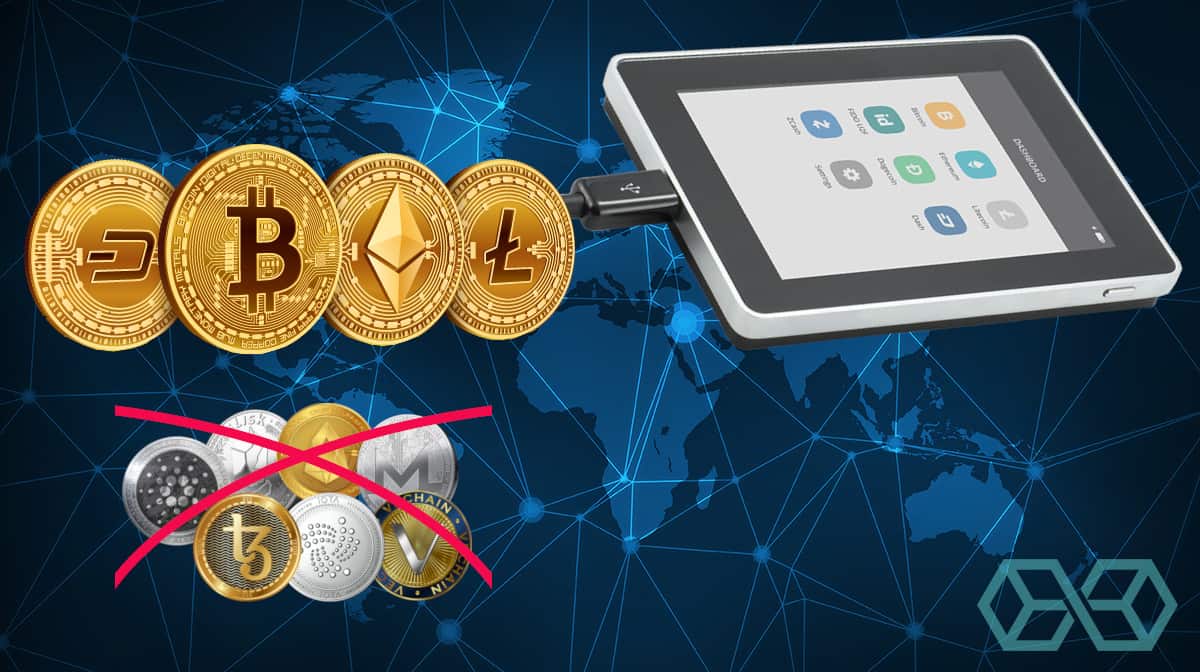
Specifically, here are some of the major market cap coins which aren’t supported by the Ledger Blue, but are supported on the Ledger Nano S:
The lack of support for coins with such huge communities may explain why the Ledger Nano S has sold over 1.4 million units, compared to just 10,000 for the Ledger Blue.
Security Features
Like Ledger’s other hardware wallets, the Ledger Blue is based around a secure element chip, alongside Ledger’s proprietary BOLOS hardware architecture, which offers bank-grade security for your cryptographic assets. The secure chip prevents tampering, and if the device has been modified before use, the user will be alerted on set-up.

Before any transaction can be processed, the Ledger Blue requires user’s manual consent to authenticate the transaction. Consent is given via the Ledger Blue device, and private keys or other sensitive data are never exposed to the computer your device is connected to.
Unlike other manufacturers, Ledger doesn’t release open-source code for its devices. However, the code for individual asset apps is open-source and available on its GitHub.
Set-up and First-time Use
As with all Ledger products, the team has done a great job of usability and simplicity, and the Ledger Blue’s screen makes the set-up process even easier to complete. New users will download the Ledger Live platform, which serves as a plug-and-play interface for setting up, sending and receiving assets on any Ledger device. Likewise, users can set up apps for new assets through Ledger Live.
To send crypto assets, users use the Ledger Live platform to launch the app for their respective asset and then launch the corresponding app on their Ledger Blue device. Users can then fill in the required fields (i.e., amount, recipient address, fees), and hit ‘send.’ The Ledger Blue will then ask users to confirm the transaction before they continue.
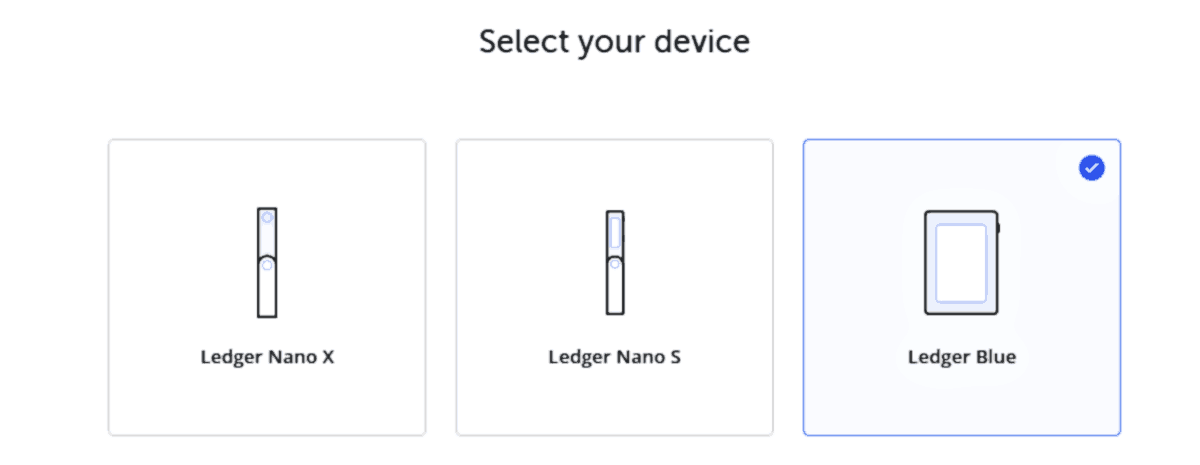
To receive assets to the Ledger Blue, the process is virtually the same in reverse, and the Ledger Live platform guides users through the process.
Pros & Cons
| Pros | Cons |
|
|
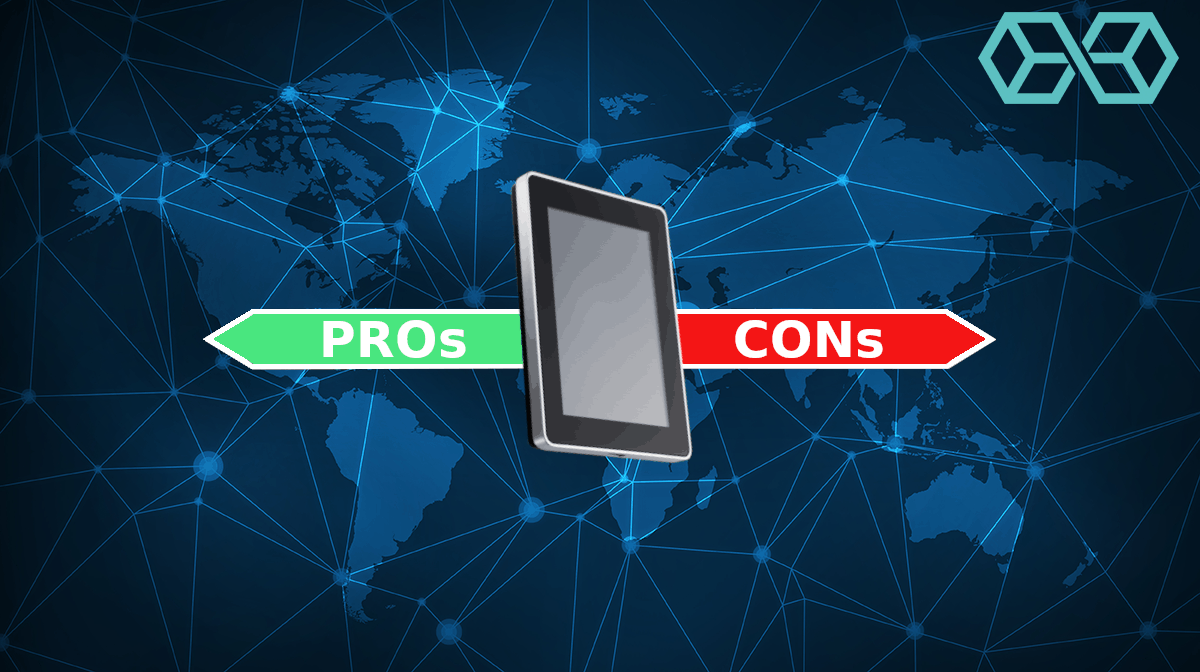
Buying the Ledger Blue Hardware Wallet
So, should you buy the Ledger Blue hardware wallet?
There’s no doubt that this is a striking piece of technology. As easy to use as a smartphone, with all of Ledger’s tried-and-tested security features, including their unique secure chip technology, the Ledger Blue scores highly in cryptographic security and ease of access.
However, when it comes to coin support, the Ledger Blue actually has fewer supported assets than its much cheaper counterpart, the Ledger Nano S, and some popular cryptos, such as Nano, Lisk, and EOS are missing from the Ledger Blue.
Considering how much time the average user will spend interacting with their hardware wallet on a daily basis, there is a tradeoff to be made between price and utility with the Ledger Blue.
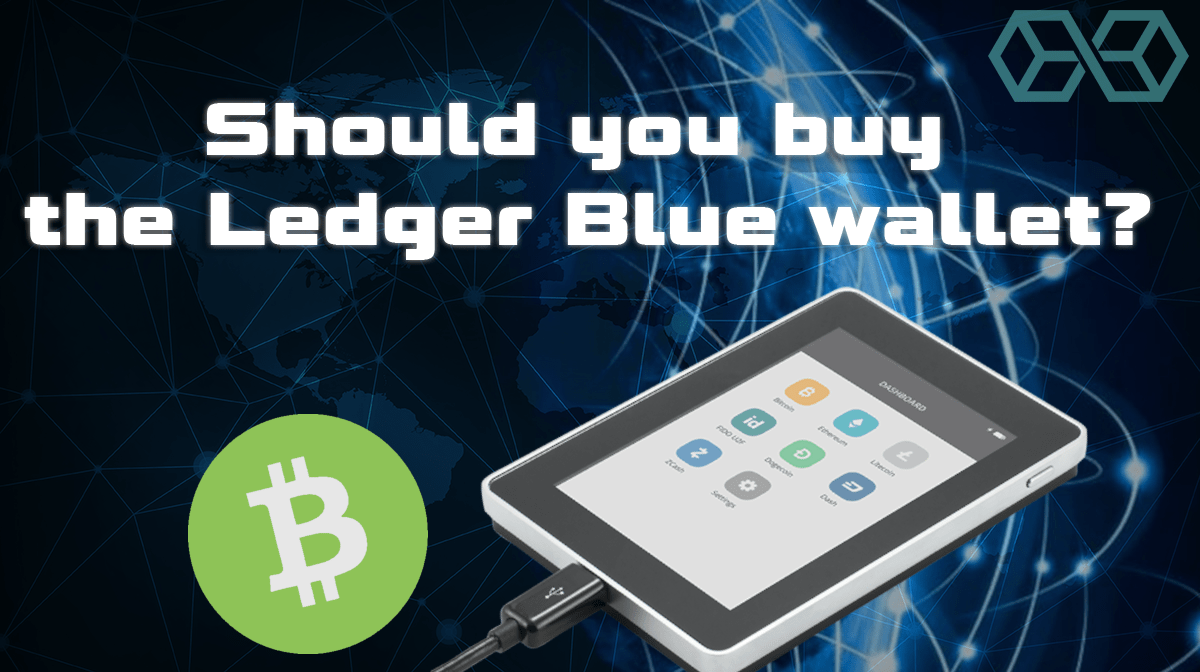
If you’re a frequent user, for example, a high volume trader who likes to keep custody of their private keys in cold storage between trades, then the Ledger Blue makes the entire process of transacting cryptocurrencies quicker and easier than most other hardware wallets on the market – very helpful when time is of the essence.
For the average crypto holder, who simply wants custody over their private keys while they hold for a few months or years, the Ledger Nano S would suffice, and at just one-sixth of the cost of the Ledger Blue.
The Verdict
Overall, the Ledger Blue is a fantastic device which really shows what hardware wallets are capable of. That said, users should ask themselves what they need the device for, and if it’s just casual use, this wallet is likely a prohibitively expensive option – which could be why the Ledger Blue has sold far fewer units than the Ledger Nano S.

Additionally, with the Ledger Nano X now on sale, featuring a bigger screen and fast Bluetooth connectivity at under half the price of the Ledger Blue ($119), many will opt for this latest state-of-the-art device.
In terms of value for money, users will find the Ledger Nano S more than adequate for almost all scenarios, and for this reason for standard users, we’d ultimately recommend against buying the Ledger Blue.

References
- Private and Public Keys Explained
- Investopedia’s Guide to Cryptocurrencies
- How Does A Cryptocurrency Wallet Work?
Disclosure: Blokt strives to provide transparent, honest reviews, and opinions. The writer of this article is a user of the product(s) or service(s) mentioned in this article and was not influenced by the respective owners.
We rarely run ads, but sometimes earn a small commission when you purchase a product or service via a link on our site. Thank you kindly for your support.
Read more or donate here.
Ledger Blue Review: Worth it? Or are Ledger Nano X and Nano S better? was originally found on Blokt - Privacy, Tech, Bitcoin, Blockchain & Cryptocurrency.
]]>![An In-Depth Beginners Guide to Uniswap [2023] 170 Beginners Guide to Uniswap](https://blokt.com/wp-content/uploads/2020/10/beginners-guide-to-uniswap-300x168.png)
With so many new decentralized finance (DeFi) protocols emerging almost daily on the Ethereum blockchain, those in the crypto space hear almost every day about newly minted millionaires, huge returns on tiny investments, and also the occasional rug pull. The DeFi hype is centered around protocols that offer lending solutions, or other traditional centralized financial […]
An In-Depth Beginners Guide to Uniswap [2023] was originally found on Blokt - Privacy, Tech, Bitcoin, Blockchain & Cryptocurrency.
]]>![An In-Depth Beginners Guide to Uniswap [2023] 177 Beginners Guide to Uniswap](https://blokt.com/wp-content/uploads/2020/10/beginners-guide-to-uniswap-300x168.png)
With so many new decentralized finance (DeFi) protocols emerging almost daily on the Ethereum blockchain, those in the crypto space hear almost every day about newly minted millionaires, huge returns on tiny investments, and also the occasional rug pull.
![An In-Depth Beginners Guide to Uniswap [2023] 171 Beginners Guide to Uniswap](https://blokt.com/wp-content/uploads/2020/10/beginners-guide-to-uniswap.png)
The DeFi hype is centered around protocols that offer lending solutions, or other traditional centralized financial products on the blockchain in a decentralized manner, with a particular focus on yield-farming protocols. These apps allow users to ‘lend out’ their cryptocurrency assets in return for fixed high yields, and the associated tokens of these platforms have driven a bull market throughout 2020.
As a result, one of the most frequently asked questions from new entrants into the DeFi space is where can you buy the latest DeFi tokens? Well, the easy answer to that question, and indeed the most trusted solution, is Uniswap. But what is Uniswap, and how does it work?
What is Uniswap?
![An In-Depth Beginners Guide to Uniswap [2023] 172 Uniswap main](https://blokt.com/wp-content/uploads/2020/10/UNI_Main.jpg)
Uniswap is a decentralized, peer to peer exchange developed specifically for the Ethereum network, also described as a decentralized protocol for automated liquidity provision on Ethereum. Launched in November 2018 by Ethereum developer Hayden Adams, Uniswap uses an automated market-making system powered by smart contracts to match orders on any ERC-20 token across the entire Ethereum blockchain.
Essentially, Uniswap is a smart contract for the exchange of ERC-20 tokens. It draws liquidity from liquidity pools, which we will explore later.
Uniswap has over 8,484 unique assets that can be traded on the protocol. Here, we are going to explore how you can get started on the Uniswap protocol, but first let’s examine some of the core concepts behind the decentralized exchange.
2023 Update: Uniswap is developing a mobile app, which is currently available as an limited early release. This means Uniswap is now a good option for those who want to trade crypto on the go.
What are Liquidity Pools?
Liquidity pools, which power the Uniswap platform, are essential to decentralized finance. Each liquidity pool is a pool of tokens locked inside a smart contract. These tokens, which are otherwise inaccessible to regular traders, are used to facilitate trading through the provision of liquidity.
Traditionally, most decentralized exchanges rely on these liquidity pools in order to match open orders on their books – as there always has to be a both a buy side and a sell side when a user places an order.
In traditional exchanges, such as stock exchanges and large, well-funded cryptocurrency exchanges like Binance, it is easy to match orders between users, and market makers are also used to ensure that there is adequate liquidity on the exchange at any given time.
However, with decentralized exchanges, who have fewer users, there is no guarantee that there will be someone willing to buy or sell the asset you wish to trade. Likewise, as decentralized exchanges work through the blockchain, using a traditional order book model would be incredibly slow and inefficient – because blockchains still only process a few transactions per second.
Instead, liquidity pools can be used to provide instant and price-steady trading between two assets within a decentralized exchange. Users can supply their ‘liquidity’ to a pool by supplying tokens, which generates a yield for the user via fees while their tokens are locked in the liquidity contract.
This has created both lucrative opportunities for yield-farming, enabled better liquidity on decentralized exchanges, and provided passive returns to long-term token holders. Uniswap leverages these pools to allow users to quickly swap between ERC-20 tokens, and as such it has become one of the most popular places to trade new tokens.
How Popular is Uniswap?
Although Uniswap got off to a somewhat slow start as users made their way tentatively into the DeFi space, it’s seen a huge upsurge in activity during 2020, powered in part by the rising interest in Ethereum-based DeFi protocols such as AAVE and DMM DAO.
In 2020, total liquidity on Uniswap reached $300 million, and 24-hour trading volume regularly exceeds over $200 million collectively on various pairings on the platform—even occasionally surpassing Tether in generated gas fees.
On August 30, 2020, Uniswap overtook Coinbase in daily volume, processing some $426 million in a 24 hour period, compared to just $349 million on Coinbase in the same period.
Also contributing to Uniswap’s popularity has been the launch of their native token, UNI. Let’s explore UNI below.
The UNI Token
![An In-Depth Beginners Guide to Uniswap [2023] 173 UNI Claim](https://blokt.com/wp-content/uploads/2020/10/UNI_Claim.jpg)
Introduced on the 16th September 2020, the Uniswap token, or UNI, is a governance token that allows users to take part in the future of the Uniswap protocol. Over 60% of the total UNI supply was distributed to community members, making it a fairly decentralized token, with only 21.5% given to team members and roughly 17.8% given to investors.
Around 150,000,000 UNI tokens were claimed by previous liquidity providers on the protocol, and 430,000,000 tokens were retained as governance treasury tokens. Around 5,000,000 community UNI tokens will also be available for yield farmers to claim through various stablecoin yield farming pools.
Uniswap will use the UNI governance tokens to promote community initiatives, provide liquidity mining, and fund other programs for the good of the protocol. If you have used Uniswap, you should be eligible to claim up to 400 UNI tokens just for connecting your wallet.
How to Find Uniswap Gems
Often, you may find cryptocurrency community members talking about ‘Uniswap gems’. As Uniswap offers easy peer to peer trading between any ERC-20 token with low gas fees, it’s often the first place users can access brand new Ethereum-based tokens, such as the latest DeFi protocol or utility token for example.
As a result, many crypto traders keep a close eye on new additions to Uniswap to make the most of brand new trading opportunities. These are often called ‘Uniswap gems’, and although most accept that these type of tokens are somewhat of a gamble, they usually share similar characteristics, such as low market capitalization, a small daily traded volume, and a relatively small number of existing token holders – all characteristics which give tokens a high upside potential, if they are sound projects.
There is little doubt that the number of Uniswap gems and the returns they have netted for users, has significantly contributed to the protocol’s success, especially during the more bullish 2020 market.
How to use Uniswap
There are a couple of things you will need before you get started on Uniswap. Firstly, you will need to have a browser extension or plugin installed which lets you interface with web 3.0 applications. The most common of these, and the one best supported by Uniswap, is Metamask.
![An In-Depth Beginners Guide to Uniswap [2023] 174 Wallet Uniswap](https://blokt.com/wp-content/uploads/2020/10/uniswap-wallet-select.jpg)
There are also options to use WalletConnect, Coinbase Wallet, Fortmatic, and Portis wallets for ease of access. Coinbase wallet is a great option for users who are relatively new to cryptocurrency and have assets stored in the Coinbase mobile app. You can learn how to use Coinbase here.
This should make it much easier to transfer your assets across from Coinbase and swap them for ERC-20 tokens easily. Be careful though, as you can only use ETH and Ethereum-based tokens on Uniswap – don’t try and use Bitcoin, for example.
The swapping experience is simple on Uniswap. First, connect your chosen wallet extension. Once connected, in the top box, simply select the asset you want to swap and enter the amount, or click ‘max’ if you want to swap all of your asset. In the example below, we will swap ETH for UBT.
![An In-Depth Beginners Guide to Uniswap [2023] 175 Uniswap](https://blokt.com/wp-content/uploads/2020/10/Uniswap_transaction.jpg)
Select the asset you want to swap for from the list in the bottom box. Occasionally, you may have to manually search for the asset you want to swap to. The easiest way to do this is to paste the contract address of your desired token. This is also the safest way since tokens can have the same name as others and you can’t guarantee you are buying the real one without the contract address.
Once you are happy with the exchange rate and slippage tolerance, go ahead and click ‘Swap’. You will be shown another lightbox with more details of the swap. If you are happy to go ahead, click ‘Confirm Swap’. You will now be prompted to confirm the swap via your wallet plugin and select your gas price. We will explore more on this below.
If you’re already familiar with Metamask or using other Ethereum plugins for interacting with decentralized applications, or DApps, then using Uniswap should be a pretty easy and familiar experience, but there are a few things to keep in mind.
Let’s explore the most common things new Uniswap users stumble on when using the decentralized liquidity protocol.
Uniswap Slippage
![An In-Depth Beginners Guide to Uniswap [2023] 176 UNI slippage](https://blokt.com/wp-content/uploads/2020/10/slippage.jpg)
Slippage occurs when the price you have opened a trade at, or wish to swap assets for, isn’t available anymore at the time of the execution of your order. This can happen for a number of reasons, especially in periods of high market volatility when many other users are trying to buy into a token – prices move quickly.
To make sure you don’t lose your transaction to slippage, which is particularly annoying on Uniswap because sometimes you will still be charged gas fees for initiating the transaction, navigate to the cogwheel in the upper right-hand corner of the exchange interface.
Clicking the cogwheel will show a lightbox with multiple settings, but at the top, you will see ‘slippage tolerance’. The general concept of slippage is simple. If you set a slippage tolerance of 0.1%, the most you will pay for your assets is 0.1% above the spot price – the current market price of the asset.
If you set 0.5% you are willing to go that much higher than the spot price to secure your assets, and so forth. You can choose from 0.1% to 1% slippage from the pre-set options, or set your own slippage tolerance using the manual section.
Sometimes, in rare circumstances and at times of high market volatility, you may even have to go up to 5% slippage to successfully process a transaction. This is only recommended if you really feel you need to get an entry into a token, and you want to make sure you get a good position. Setting slippage tolerances above 5% isn’t recommended, as you are essentially just paying a premium for the asset.
Gas fees
Like everything powered by Ethereum, you will have to pay gas fees in ETH to process transactions on the Uniswap protocol. Even though you are able to swap one ERC-20 asset for any other supported ERC-20 asset directly, this transaction would still cost you gas payable in ETH, so you need to ensure you have some ETH handy in your linked wallet to successfully process this transaction.
Gas fees on the Ethereum network can get incredibly high at busy periods, or in times of high network congestion, and indeed the recent Uniswap and DeFi craze have added to the rising gas costs on the Ethereum blockchain.
Setting gas fees too low on Uniswap can cause your transaction to stall, or fail completely. Be warned, even if your transaction fails due to low gas, you may still lose some ETH funds for initiating the transaction.
Instead, it’s best to either use the network recommended gas prices at the time (medium speed), or opt to pay more gas for a faster transaction to ensure your swap completes successfully. If you aren’t in any rush to swap your assets, consider checking back in on Uniswap when gas prices are down, to bring down your costs.
Transaction deadlines
As we described above, settling too low of a gas fee, or insufficient slippage tolerances, can cause your transaction to stall, or in the worst case, fail completely. You do have to use caution setting a transaction on Uniswap and simply leaving your computer.
In periods of high market volatility or high gas prices, you may pay the initial transaction fee but your swap won’t process – and you will lose some funds. In periods of high gas, this can be quite a significant sum of money.
As a result, you may want to set transaction deadlines. Navigate to the same cogwheel menu as you did for setting slippage, and you will see the option to change the transaction deadlines. The default is 20 minutes, although this might still be too high for some. Essentially, if your swap hasn’t been filled in 20 minutes or the given amount of time, it will be automatically canceled.
We recommend everyone ensures they have a transaction deadline set up. The exact length is up to your risk profile and slippage tolerance, but it is a great tool to ensure your transaction doesn’t get lost in the ether!
Expert Mode
Here’s a little disclaimer before we teach you about Expert mode – if you’re not an expert, don’t use it! Expert mode allows ultra-high slippage trades, which can often result in poor rates of exchange between assets, and even make you lose part of your original asset or funds.
So, why might you use Expert mode in the first place? If you are an experienced trader, there may be opportunities that arise which you just don’t want to miss. For example, some DeFi coins have made astronomical daily gains during the past couple of months, and it can be difficult to get a position in a coin using normal slippage tolerances in a fast-moving market.
Instead, by setting high slippage and turning off confirmation transaction prompts, you can settle swaps far quicker than the average user. However, it’s highly likely that you will get less of the asset you are swapping for in terms of current market value. Therefore, Expert mode really is only for experienced traders who are sure they can turn a profit from a trade, despite the unrealized losses they may make on the initial swap.
Conclusion
If you are familiar with using decentralized applications through a browser extension, such as Metamask or Portis, then you should have little trouble navigating Uniswap. However, do make sure you are careful to avoid some of the common mistakes new users make on Uniswap to avoid losing your funds or missing out on a great trading opportunity.
Just getting started and want to buy ETH to swap for the latest DeFi coins on Uniswap? Find out how you can buy Ethereum here.
An In-Depth Beginners Guide to Uniswap [2023] was originally found on Blokt - Privacy, Tech, Bitcoin, Blockchain & Cryptocurrency.
]]>
Looking to roll some dice and win some Bitcoin or other cryptocurrencies? You’ve come to the right place. Read on to find out which sites our expert chose as the best. Bitcoin Dice is one of the most popular crypto gambling games, and even though these games are relatively simple, they are one of the […]
Best Bitcoin Dice was originally found on Blokt - Privacy, Tech, Bitcoin, Blockchain & Cryptocurrency.
]]>
Looking to roll some dice and win some Bitcoin or other cryptocurrencies? You’ve come to the right place. Read on to find out which sites our expert chose as the best.
IN A RUSH?
Go straight to our expert’s top pick. For the best all-around Bitcoin dice experience, DuckDice is our top pick.
An Introduction to Bitcoin Dice
Bitcoin Dice is one of the most popular crypto gambling games, and even though these games are relatively simple, they are one of the most customizable forms of betting you can play with cryptocurrency.
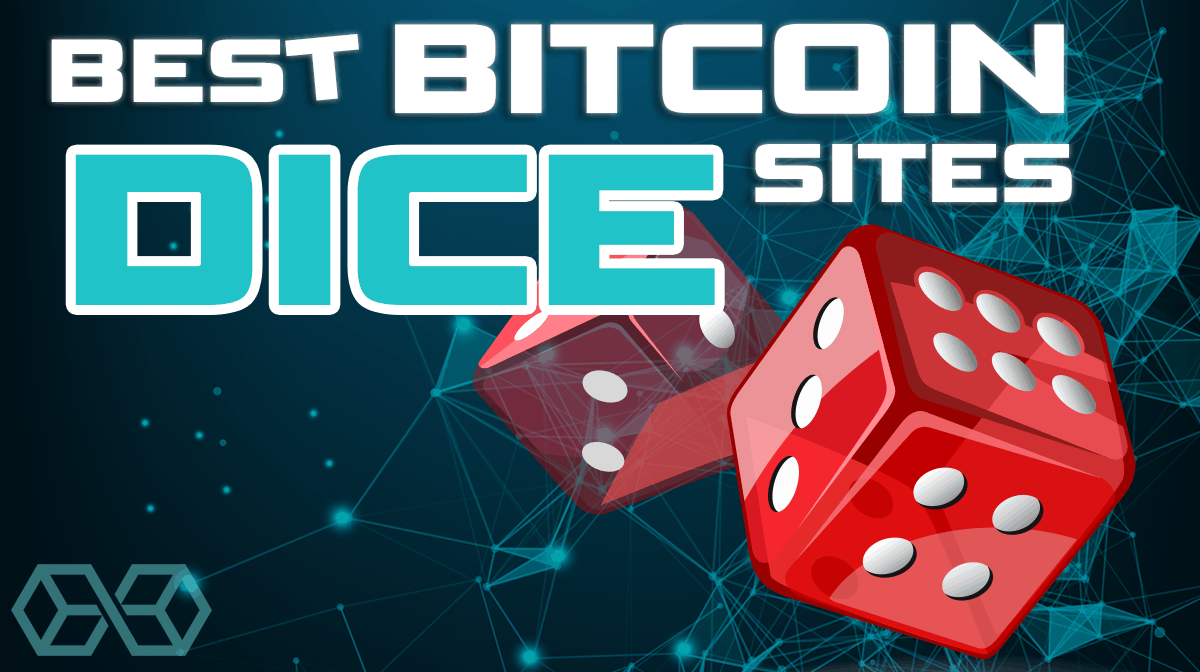
This is because Bitcoin dice sites typically allow players to set their own odds, alter risk and reward, and determine the house edge level. Naturally, the lower house edge will mean less reward, but many players like the opportunity to tailor their gambling experience and win more regularly and consistently with dice games.
Because of its simplicity, many crypto gambling players have come to regard Bitcoin dice and other dice games as one of the purest forms of wagering, changing little in their long history.
Here, we’re going to explore some of the best Bitcoin dice websites globally and highlight some of the best Bitcoin faucets available. But first, let’s look at what a Bitcoin dice faucet is and discover some of the most popular strategies for winning at Bitcoin dice.
What is a Bitcoin Dice Faucet?
In this article, we will be looking at ‘Bitcoin Dice Faucets,’ but what are they, and why do Bitcoin dice players love them so much?
Certain Bitcoin Dice websites will give players a tiny amount of BTC, like a faucet would leak a little water, to try out Bitcoin dice games without risking their funds. Some Bitcoin dice faucets offer substantially more Bitcoin than others, or they dispense at more regular intervals – so some players like to maximize their free BTC through Bitcoin dice faucets!
This free BTC or other cryptocurrencies can either be saved up or used to bet on Bitcoin dice games to try and gamble up your crypto holdings.
In the article below, we’re going to look at some of the best Bitcoin dice faucets so that you can make the most of your dice experience.
Which is the Best Bitcoin Dice Strategy?
We should start by saying that Bitcoin dice is a game of chance – ultimately, it’s a gambling game, and the house always has a slight edge. However, players can follow strict strategies to improve their odds of winning and increase their takings over time.
Here are a few of the most popular strategies:
- The Paroli Strategy – A method that helps players maximize winning streaks and minimize losses, the Paroli strategy sees players determine a base stake amount, then double their bet after each win until they achieve three consecutive wins.
- The Martingale Strategy – A tried and tested strategy from the 1700s; Martingale strategy players gradually increase their bet amount when they are on a losing streak. The idea behind this strategy is that the increased bets will recover the losses incurred during the losing streak when the player wins.
- The D’Alembert Strategy – This easy-to-remember strategy increases your bet amount by 1x after each consecutive roll.
- The Inverse Martingale Strategy – As you might have guessed, this is the opposite of the regular Martingale strategy. Players increase their wagering size during a winning streak rather than a losing streak, maximizing the takings from a successful win.
Our Picks – The Best Bitcoin Dice Sites
Now you’re armed with some knowledge of the best Bitcoin dice strategies, let’s dive in and review some of the best places to play Bitcoin dice! Check out the table below for a quick overview of the top sites or scroll down to see a detailed review of each.
1. DuckDice
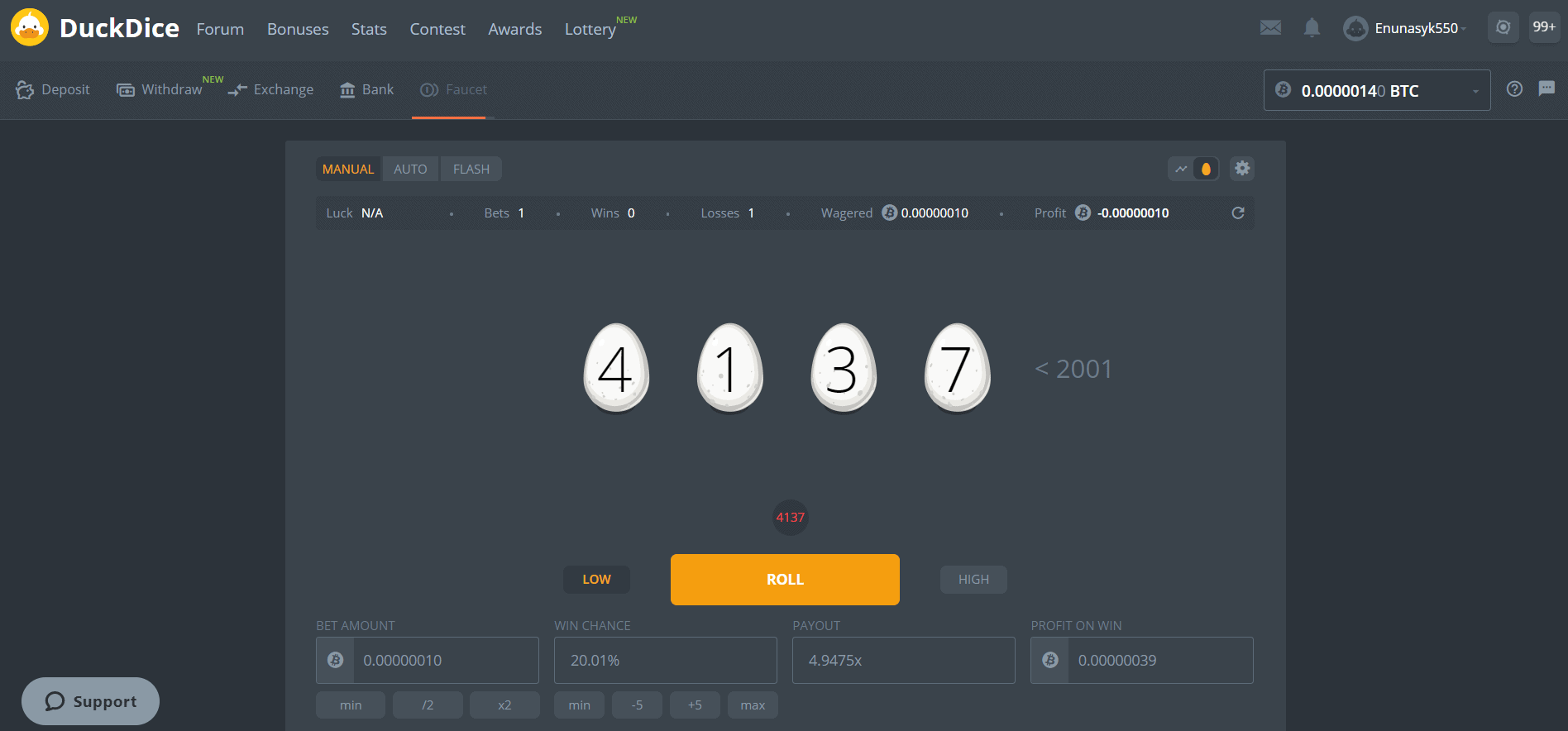
A growing Bitcoin dice website, DuckDice.io is a well-designed site licensed in Curaçao. As a Crypto Gambling Foundation member, DuckDice provides provably fair dice games in a range of cryptocurrencies.
The site has implemented plenty of exciting features that have contributed to its popularity, and these have assisted in setting DuckDice apart from other Bitcoin dice operators in recent years. There are a couple of different games on DuckDice, including their main Dice feature and also some lottery games.
Signing up to DuckDice.io is one of the most effortless experiences in crypto gambling – you simply click ‘sign-up,’ and DuckDice generates a username for you. There’s no need to enter an email address, and you can get started straight away.
Users from the United States, the Netherlands, Russia, France, and Ukraine are not currently allowed to play on DuckDice.io.
DuckDice.io Bitcoin Dice
With a focus on design, DuckDice’s crypto dice games are well laid out and easy to play, with a fun ‘egg’ theme to show how much players have wagered.
There are auto modes if you’re the kind of player who likes to set up their games and watch them go, or a ‘Flashbet’ mode, which lets power-players place hundreds of bets per second.
Flashbet lets players set their wagering parameters and then executes hundreds of bets at the fastest speed possible. Once a Flashbet session is in play, there’s no way to stop it unless one of your pre-set criteria is reached or you run out of balance.
DuckDice’s Flashbet is an excellent way for regular players who like to wager a set amount per day to play, so if you’ve got limited time on your hands, check it out!
DuckDice.io Bitcoin Faucet
DuckDice has both a generous Bitcoin faucet feature and ‘rain’ events where cryptocurrency is distributed to certain players.
Their faucet feature allows players to collect free satoshis, which are immediately available to gamble on their dice games. It’s easy to collect BTC from DuckDice’s faucet – you either beat another player in a tic tac toe minigame or play three games in succession to win! However, the faucet feature is only available when you have no funds in your account.
Players can choose to make it ‘rain’ on other members of their chatroom by clicking the cloud icon at the top of the site. This will distribute small amounts of crypto to everyone in that room, so it pays to know some high-rollers on DuckDice!
DuckDice.io Supported Cryptos
DuckDice lets players gamble in the following cryptocurrencies:
- Bitcoin
- Litecoin
- Dogecoin
- Dash
- Bitcoin Cash
- Ethereum Classic
- Ethereum
- Bitcoin Gold
- Zcash
- Monero
- Ripple
- Tether
- And many more
In fact, in April 2022, DuckDice announced 7 more coins that will be supported on its platform including SOL, MATIC, LUNA, and others. They have since removed LUNA after its recent colapse.

It’s incredibly easy to credit your account on DuckDice, only requiring a deposit address for your chosen asset.
DuckDice.io Additional Features
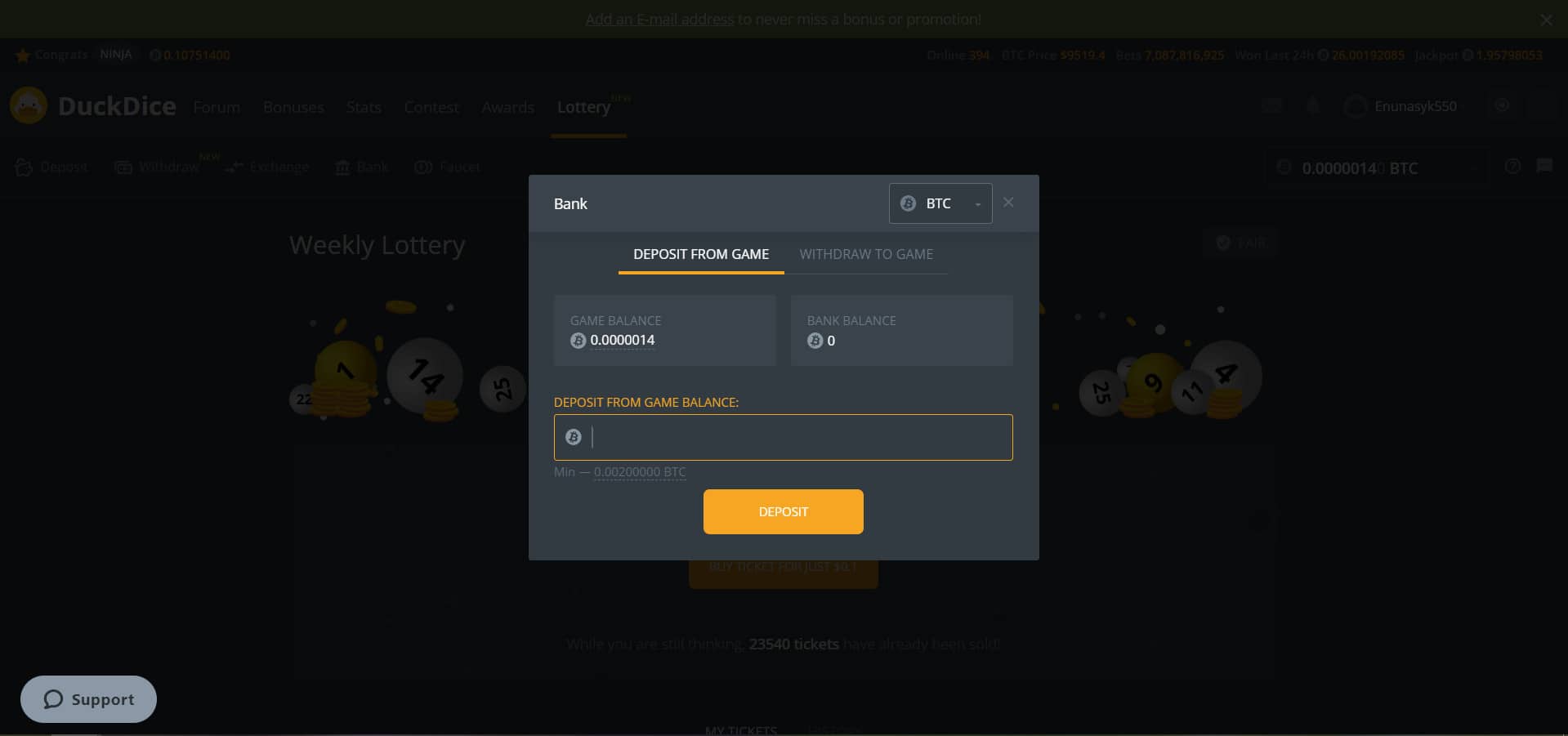
In addition to their feature-rich dice games, DuckDice also has a currency exchange, a ‘bank’ feature, awards, and regular contests.
Users can transfer any supported crypto to any other cryptocurrency using DuckDice’s currency exchange feature, for instance, BTC to LTC, which takes just seconds and is great for quickly swapping the currency you’re betting with.
There are regular contests, such as daily wagering contests for dice players with prizes up to 0.01 BTC.
DuckDice’s bank feature is an exciting way to make sure you’re setting aside a portion of your winnings rather than leaving them all on the table. Players can deposit their crypto into DuckDice’s bank, which removes it from the available funds when placing a bet.
Our Verdict
A great-looking Bitcoin dice site, DuckDice is leading the way in terms of innovation and user-friendliness.
They are jam-packed with features that other Bitcoin dice sites don’t have, like banking features, huge bonuses, and crypto exchanges, which transform DuckDice into more than just a standard Bitcoin dice site.
Overall, we think DuckDice.io is one of the best choices for Bitcoin dice players regardless of skill level or wager amount.
2. Primedice
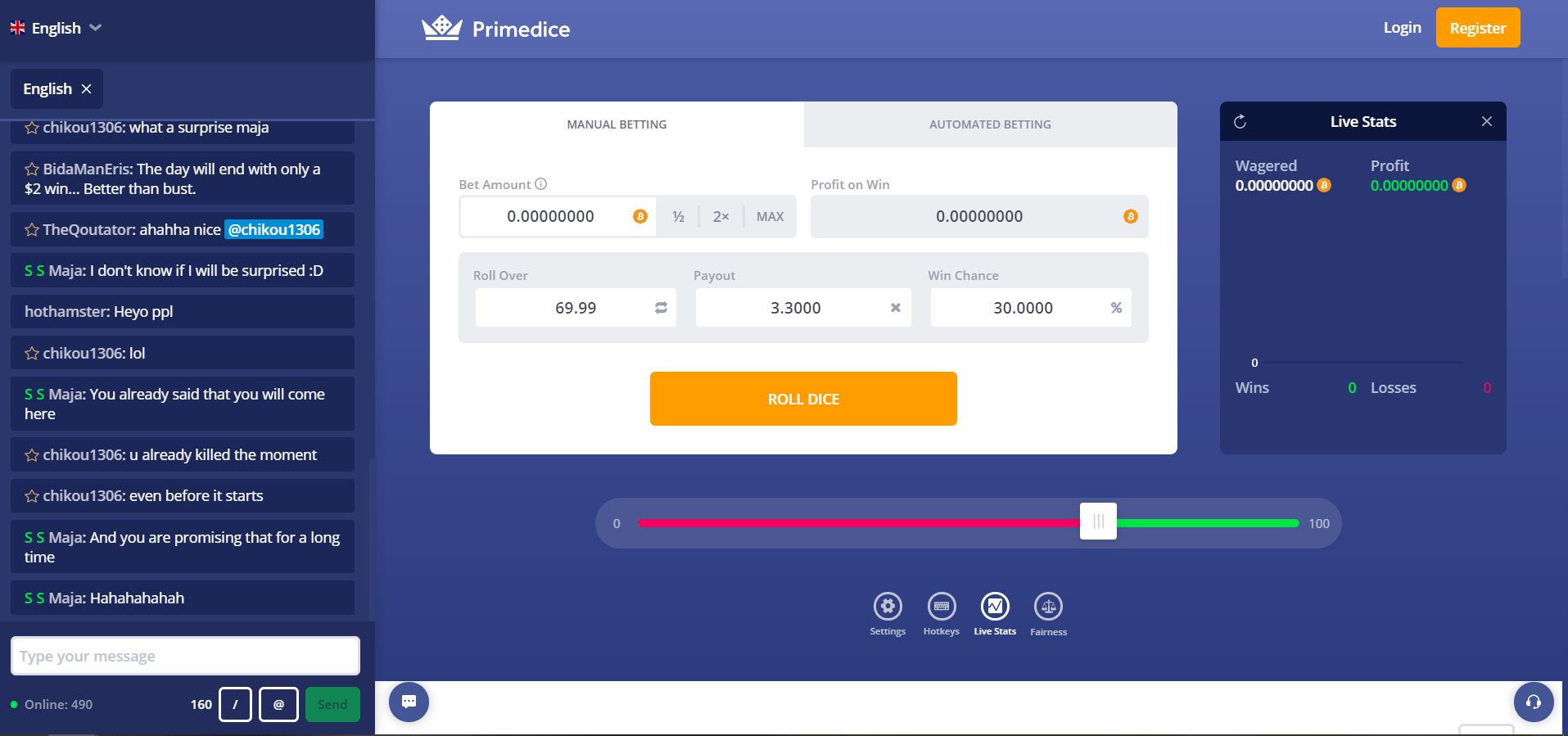
Established in 2013, Primedice is one of the most popular Bitcoin dice venues where users can stake their Bitcoin bets. Primedice is owned and operated by Slice Media, the same company as popular crypto casino Stake.com – one of our top 10 best Bitcoin casinos for 2022.
With provably fair dice games, one of the lowest house edges in the industry of just 1%, and instant bitcoin deposits and withdrawals, Primedice is an incredibly easy-to-use Bitcoin dice website.
Primedice is open to players in most jurisdictions, but they restrict players from the USA, Australia, and other countries where online gambling is illegal.
Primedice Bitcoin Dice
Visually, Primedice has one of the best Bitcoin dice interfaces of any provider, with no fluff or unnecessary options – it’s a simple and easy to use game set-up which does precisely as bitcoin dice players would expect.
There’s a simple slider bar to change the wagering requirements, which makes it incredibly easy to change the win chance from 98% all the way down to just 2%. There are also options to quickly wager either half or the entirety of your Bitcoin holdings, and there are more options for automated betting – where players can simply set up their rolls and watch it go.
If you choose to play with automated betting, you can set your wagers to stop once a certain amount of profit or loss is reached, so if you’ve got a set amount of Bitcoin to spend, this is an excellent option for placing your bets while you do something else.
Primedice’s Bitcoin dice is provably fair and verifiable, providing both client and server seeds for each game.
Primedice Bitcoin Faucet
Unfortunately, Primedice doesn’t offer a Bitcoin faucet anymore.
However, they do let players try-out dice games by placing zero bets, which allows users to experiment with different game methods.
Supported Cryptos
Primedice lets players gamble in the following cryptocurrencies:
- Bitcoin (BTC)
- Litecoin (LTC)
- Ethereum (ETH)
- Ripple (XRP)
- Bitcoin Cash (BCH)
- DogeCoin (DOGE)
- Tron (TRX)
Primedice Additional Features

Primedice has some exciting extra features which have contributed to its popularity, including a VIP status for regular players that awards unlimited rake backs, gifts and rewards, and exclusive bonuses.
VIP status is obtained through Primedice’s loyalty progression, the final level of which is ‘Diamond’ status for the highest wagering players. For VIP players, Primedice claims there are ‘limitless’ opportunities for rake backs, which refunds players some of the money they’ve wagered so they can continue playing.
There are also challenges tailored to each player, which are unique based on the kinds of wagers you place and the frequency you play on Primedice.
We also liked Primedice’s chat feature, which is a live community chat where players can exchange tips, pass the time while their automated wagers run, and share their big wins!
Our Verdict
It’s straightforward to see why Primedice has become one of the most popular Bitcoin dice sites, as it’s one of the best designed, easiest to use, and most feature-rich sites in the world. It’s also achieved veteran status among the crypto community, becoming highly respected during its seven-year history.
We liked the broad range of cryptocurrencies that Primedice supports, which is excellent for those who wish to gamble using altcoins. However, compared to some of the other sites we’ll be reviewing below, Primedice doesn’t have a Bitcoin faucet feature, which is disappointing for those who like to receive free BTC to bet with periodically.
Overall, Primedice is provably fair and highly trusted Bitcoin dice operator, which has a proven track record of delivering a fantastic crypto gambling experience.
3. TrustDice
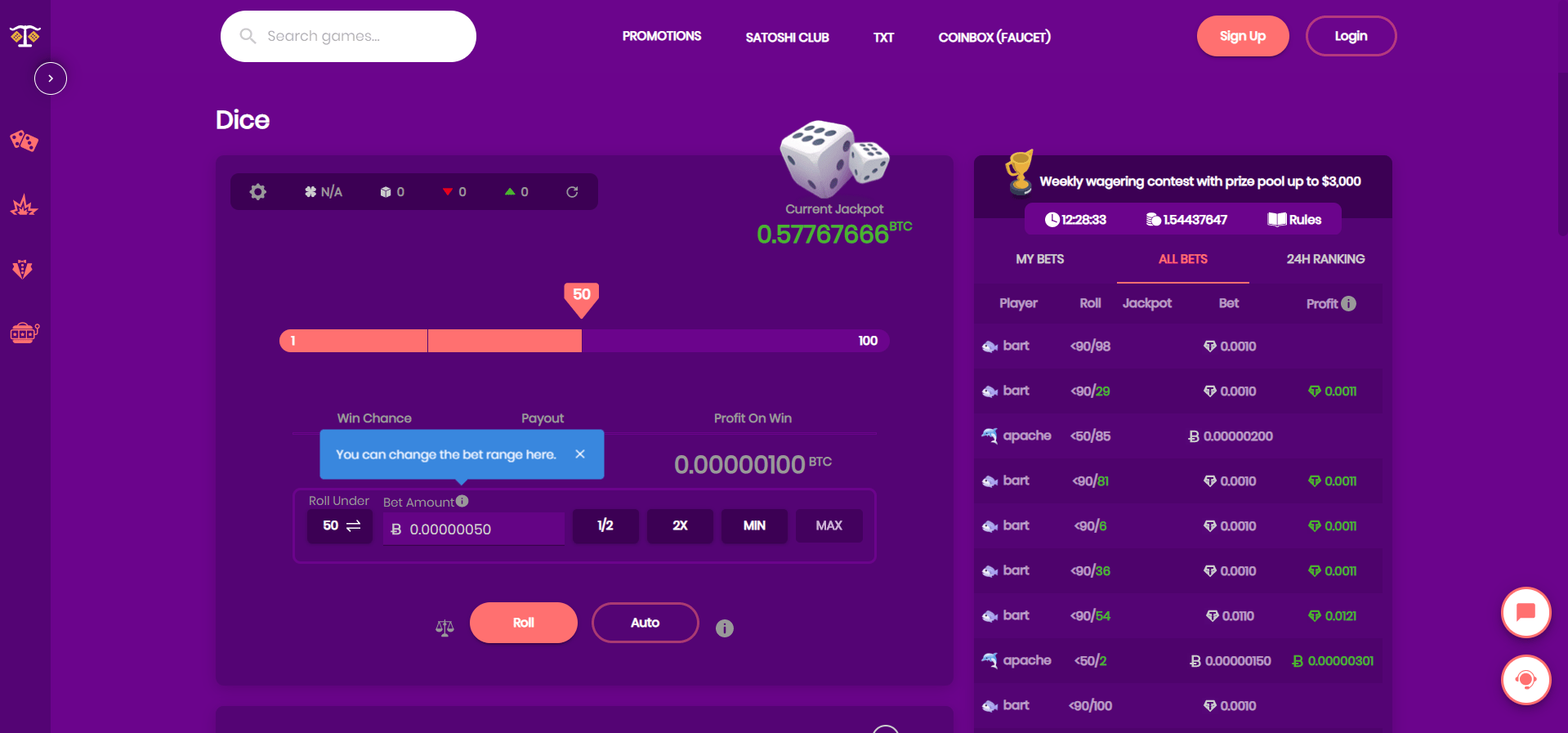
Trustdice are primarily a Bitcoin dice provider, but they also have a range of traditional crypto casino games, like Blackjack, Baccarat, and Roulette.
Established in 2018, TrustDice is licensed in Curaçao, and run by Satoshi Gaming Group. The site has almost 200,000 players worldwide, with 62 million total bets placed and nearly $185,000 paid out in prizes.
TrustDice supports players from most jurisdictions but excludes those from the USA, France, and the Netherlands.
TrustDice.Win Bitcoin Dice
TrustDice has an enjoyable and easy to use interface, which lets players place a wager in seconds. Like other sites on our list, there’s a slider bar that players can use to change their bets quickly.
Players can see all the bets other users are placing on the game, as well as what they’ve won and what they rolled – which is great for keeping track of how often the Bitcoin dice is paying out.
There are also quick-press buttons for placing a minimum bet, max bet, or half of your total holdings. It’s not easy to find information on how provably fair the games are within the gaming interface. However, digging a little deeper does reveal that games on TrustDice are provably fair.
TrustDice.Win Bitcoin Faucet

TrustDice.Win uses the Coinbox faucet, which offers a vast range of free crypto to players, including Bitcoin, Ethereum, EOS, Tether, and other tokens. New players can claim from the Coinbox faucet every six hours, and for regular players, the faucet pays out more often.
All crypto claimed from TrustDice’s faucet can be immediately wagered on dice games with a minimum bet of just 10 Satoshi. As players can get 50 sats every six hours from TrustDice’s faucet, you can make 20 free wagers every day just from faucet crypto!
TrustDice.Win Supported Cryptos
TrustDice.Win lets players gamble in the following cryptocurrencies:
- Bitcoin
- Ethereum
- EOS
- Tether
TrustDice Additional Features
TrustDice.Win lets players access a range of other crypto casino games, but they also keep their dice players interested through contests and prizes.
For example, players can take part in TrustDice. Win’s weekly wagering contest, to be in with a chance of winning up to $3,000.
Our Verdict
TrustDice has one of the best user interfaces of any Bitcoin dice site, and it’s also got the best crypto and Bitcoin faucet hands down.
There’s a decent range of competitions, including level-up rewards and plenty of opportunities for rakebacks. Overall, TrustDice.Win is a great option for Bitcoin dice players who also want to explore betting with altcoins.
4. OneHash
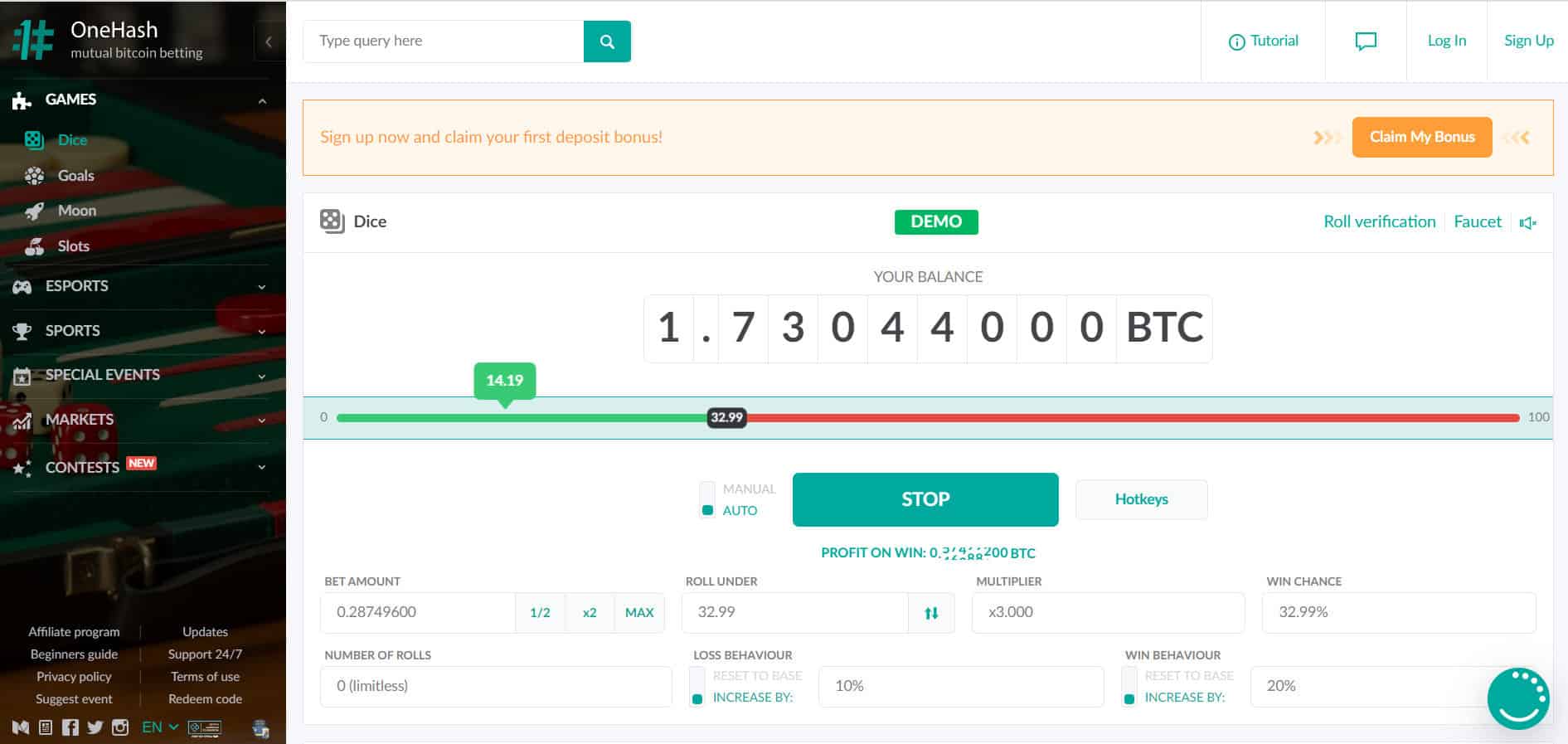
OneHash is a Bitcoin dice, casino, slots, and sportsbook casino based in Curaçao. Its Bitcoin dice game is one of the most popular in the industry, and it’s also one of the easiest to use.
OneHash is open to all players that are legally allowed to gamble online in their jurisdiction.
OneHash Bitcoin Dice
OneHash’s Bitcoin dice is an easy to play game, with a well laid out interface and plenty of customization for your wagers. Like other Bitcoin dice games we’ve reviewed, there’s a simple slider to change the odds, and auto roll features to set up games.
Each game contains ‘seed settings,’ where players can view the SHA256 hash of the game’s server seed to verify that the game is provably fair. Users can also change the seed to one of their choosing if they want more control over their game.
Overall, OneHash’s Bitcoin dice has most of the same features as other sites, but its interface is a little cleaner and easier to navigate.
OneHash Bitcoin Faucet
Players will be pleased to find out that OneHash does have a Bitcoin faucet, which pays out 0.000001 BTC. The faucet button can be found in the top right corner of the Bitcoin dice gaming interface.
There’s no information as to how many times users can claim free Bitcoin from OneHash’s faucet, but it’s definitely available to new players.
OneHash Supported Cryptos
At the moment, OneHash only accepts Bitcoin deposits and payments.
There’s no information about any new cryptocurrencies coming to One hash.
OneHash Additional Features
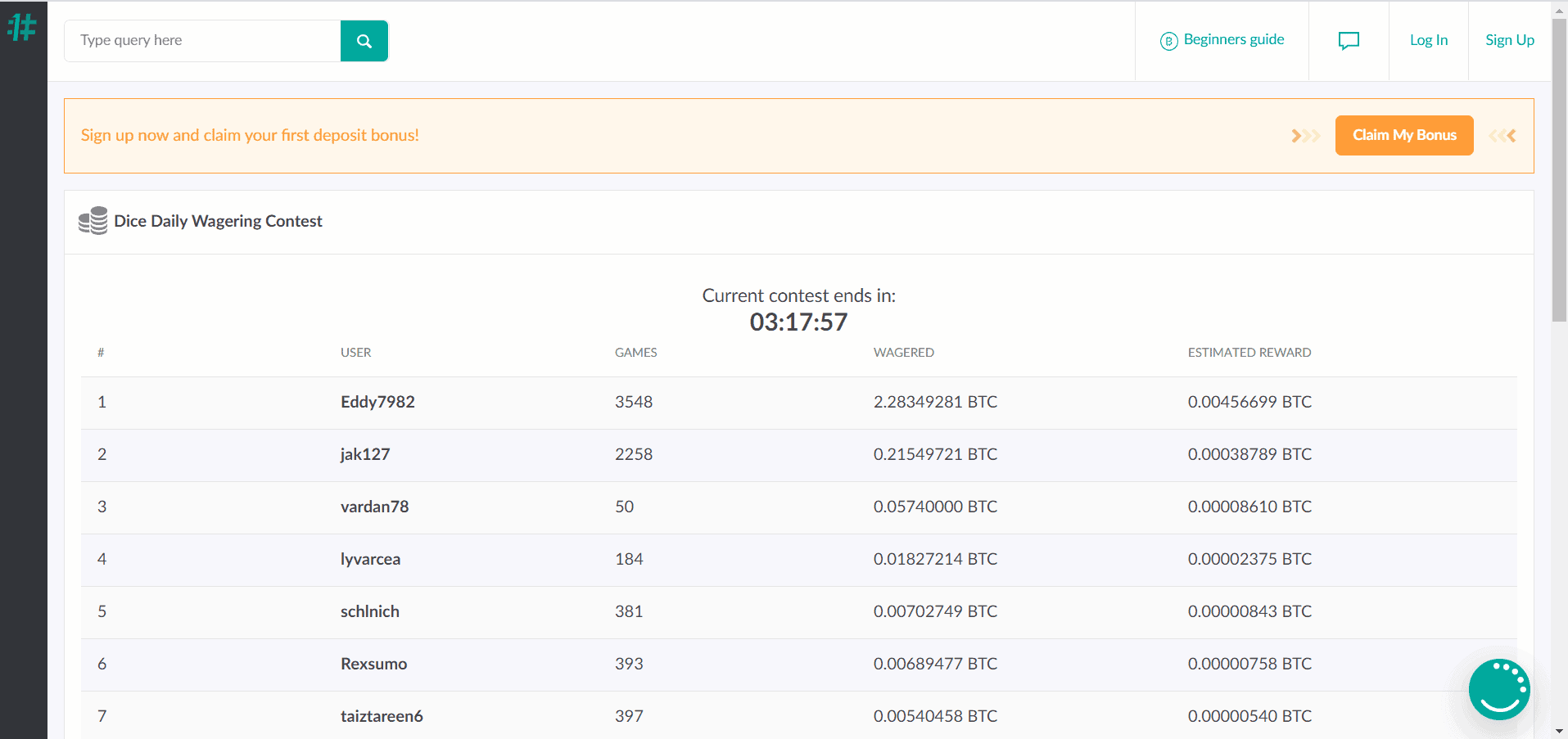
OneHash has regular dice wagering contests, where the most frequent players are rewarded with cash prizes. Contests run every day from midnight, and the top 10 users all receive a reward. The top player takes home 0.015 BTC!
There’s 24/7 live chat support for customers, and users can suggest upcoming events to wager on, which the OneHash team will review and potentially let players bet on them.
Our Verdict
The Bitcoin dice game at OneHash offers everything crypto gamblers would need from a dice game, and it’s also simple and easy to use.
We liked how easy it was to see verification for the fairness of each roll on One hash, and likewise how quickly players can receive free Bitcoin through their faucet feature.
It’s not quite as feature-rich as TrustDice.Win or DuckDice.io, but it’s still going to be a great choice for most Bitcoin dice fans.
5. BitDice
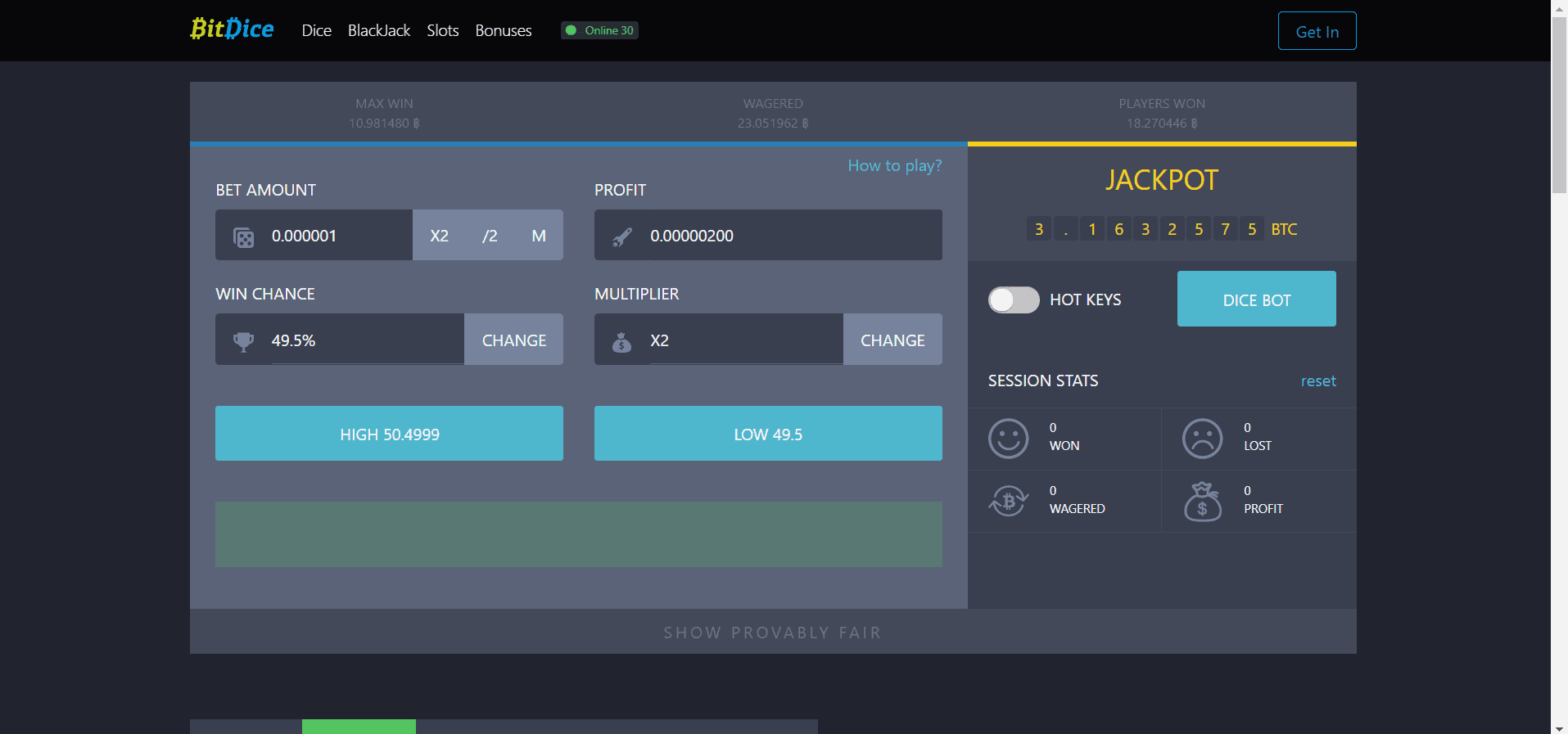
Established in 2014, BitDice is a long-running Bitcoin Dice website that’s remained popular among crypto enthusiasts for many years.
Licensed in Curaçao, BitDice offers other games for crypto gambling, too, including blackjack and slots. BitDice is best known for its exciting leveling system, generous rake backs, and it’s loyalty token.
BitDice Bitcoin Dice
A nice feature of BitDice is their’ session stats’, where players can quickly see their wins and losses, the amount in BTC they’ve won, and how much total BTC they’ve wagered in that session. You can also see who is placing the largest bets and who is getting the biggest winnings on the leader board.
BitDice also has a handy feature where players can see if a game is provably fair at the touch of a button. This is at the bottom of the dice interface, and clicking the button displays the secret hash and client seed of each game.
BitDice Bitcoin Faucet
BitDice does have a Bitcoin faucet, but it’s limited to BTC and only gives out small amounts. Its primary use is to let players try out games without first depositing crypto to the casino.
Although it’s not as generous as some of the other casinos we’ve reviewed here, it’s still a nice feature, and if you’re dedicated enough, your faucet rewards can build up over time.
BitDice Supported Cryptos
Bitdice supports the following cryptocurrencies:
- Bitcoin
- DogeCoin
- Litecoin
- Ethereum
BitDice Additional Features
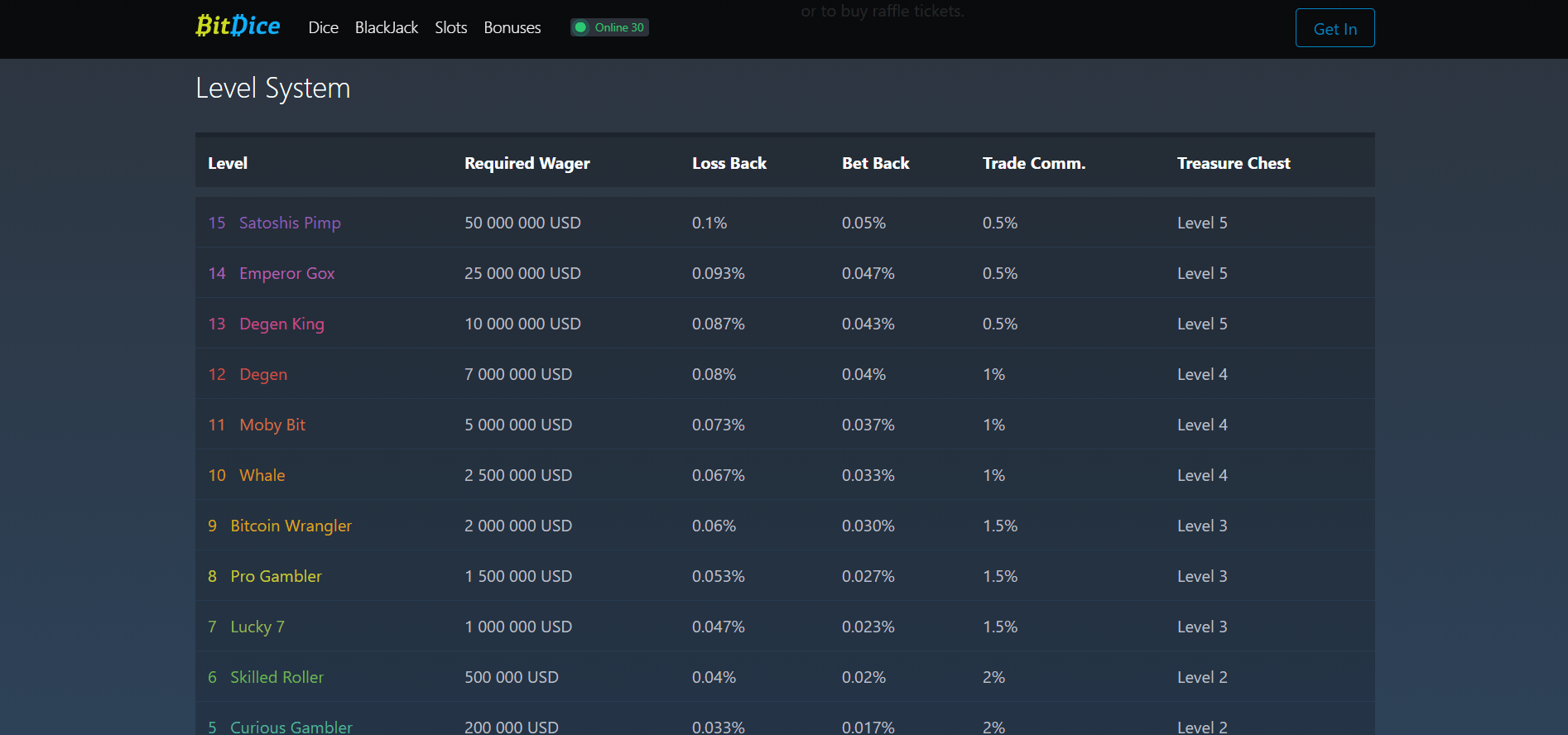
There are substantial rake backs available for BitDice players, which you can earn by progressing through the levels – made by playing regularly on the site. Other bonuses for regular players include daily chests that contain huge bonuses and random bonus wins of either free spins or extra funds.
Every bet you make on BitDice will award a small amount of the casino’s loyalty token, ‘BitDice Tokens.’ These tokens can be converted to Bitcoin at the rate of 1,000 BitDice Tokens to 1 BTC. However, players can only spend this inside the BitDice casino, either by wagering or on raffles and competitions.
Our Verdict
Overall, BitDice is a decent site to play Bitcoin dice games, and it’s simple and easy to use, as well as being a very trustworthy site.
However, compared to some of the other sites we’ve reviewed, BitDice is a little dated looks-wise, and it’s Bitcoin faucet is also somewhat limited – essentially only functioning as a way to try out games without committing your funds.
Nevertheless, BitDice is a great Bitcoin dice site overall, and we think their easy-to-view secret hash and client seed for each game is a very important feature for those concerned with fairness.
Best Bitcoin Dice Faucets
With up to 20 free wagers per day, Trustdice’s faucet is definitely one of the best ways to claim free Bitcoin, and a range of other cryptocurrencies.
We were impressed with how many different types of crypto could be claimed through TrustDice. Win’s faucet, which is considerably more than any other Bitcoin dice site we’ve reviewed here.
Which Is The Best Bitcoin Dice Game?
Overall, we liked DuckDice’s gaming interface and range of features the most. Its Flashget system is perfect for those who play dice games regularly, as you can get all your daily bets done in an instant.
DuckDice’s banking feature is also a great way to limit how much you wager, so if you’ve had a decent winning streak you can easily take these winnings off the table without transferring them to an external wallet.
TrustDice comes in as a great second choice. It has a faucet for many cryptocurrencies, which makes it a perfect option for people who like to collect free Bitcoin. For beginners who don’t want to commit a lot upfront, we recommend TrustDice.
Nevertheless, for an all-round excellent Bitcoin dice experience, DuckDice is one of the best and most feature-rich Bitcoin dice sites!
Disclosure: Blokt strives to provide transparent, honest reviews, and opinions. The writer of this article is a user of the product(s) or service(s) mentioned in this article and was not influenced by the respective owners.
We rarely run ads, but sometimes earn a small commission when you purchase a product or service via a link on our site. Thank you kindly for your support.
Read more or donate here.
Best Bitcoin Dice was originally found on Blokt - Privacy, Tech, Bitcoin, Blockchain & Cryptocurrency.
]]>
Protecting your privacy takes more than running a privacy-oriented Linux distro and using a password manager. Many security experts believe the weakest link in any system is the human that operates it. In this article, we’ll learn what social engineering is and why it is such a threat. Then we’ll look at some of the […]
Social Engineering: A Major Threat to Your Privacy was originally found on Blokt - Privacy, Tech, Bitcoin, Blockchain & Cryptocurrency.
]]>
Protecting your privacy takes more than running a privacy-oriented Linux distro and using a password manager. Many security experts believe the weakest link in any system is the human that operates it.
In this article, we’ll learn what social engineering is and why it is such a threat. Then we’ll look at some of the social engineering attacks that bad guys can use against you, both online and offline. We wrap it up with a few tips for protecting yourself from social engineering attacks.
What is Social Engineering?
Merriam-Webster defines social engineering as the “management of human beings in accordance with their place and function in society.” That sounds a little creepy in itself. But in recent years, the phrase has taken on a more manipulative, sinister meaning.
Today, social engineering means something like “manipulating people to give you confidential information.” When we talk about social engineering here, this is the sense that we’re using.
Why Social Engineering is Such a Threat
Criminals use social engineering because it is easier than hacking into a computer system. Tricking someone into telling you something they shouldn’t is relatively easy. Most people are trusting of others.
It doesn’t matter how secure your computer system is. Or where you stashed your personal documents. Or how many guards are in front of your offices. Social engineering attacks sidestep all that.
Famous ex-hacker Kevin Mitnick often used social engineering attacks to get into “secure” computer systems.
“Anyone who thinks that security products alone offer true security is settling for the illusion of security.” – Kevin D. Mitnick, The Art of Deception: Controlling the Human Element of Security
Criminals use social engineering attacks, both online and offline. Now we’ll look at some of the most common types of attacks and what you can do to defend yourself against them.
We will start with online social engineering attacks that hackers love. You may have come across some of these before.
“A hacker is someone who uses a combination of high-tech cyber tools and social engineering to gain illicit access to someone else’s data.” – John McAfee
Some Online Social Engineering Attacks
Here are a few of the most common online social engineering attacks:
- Phishing
- Spear Phishing
- Baiting
Phishing
According to the Department of Homeland Security website, a phishing attack “uses email or malicious websites to solicit personal information by posing as a trustworthy organization.”
You’ve seen this kind of attack. We all get emails from official-sounding organizations claiming there’s a problem with our account, or they need to verify our credit card information.
The goal is to get you to click on the link in the email. That link will take you to a legitimate-looking, but phony, website for the organization. The website will be set up to trick you into entering your credit card data, Social Security number, or whatever it is that the crooks want to steal.
Spear Phishing
Spear phishing is a type of phishing attack where the attacker customizes the phishing email using personal information about the intended victim. In December 2018, the US Internal Revenue Service (IRS) published a warning about several spear-phishing scams.
These scams were meant to gather the information that goes on IRS Form W-2. The target for these scams was small businesses. The bad guys would use the information to open credit card accounts, file fraudulent tax returns, open lines of credit, and so on.
Spear phishing attacks rely heavily on Pretexting attacks. We cover Pretexting attacks in the next section.
Baiting
Baiting attacks are somewhat similar to phishing attacks. The difference is that baiting attacks offer the target something they want instead of resolve a problem. In these kinds of attacks, you might get offered free music, copies of new movies, or any other kind of prize. To get the prize, you would be required to enter whatever type of personal information it is that the crook is after.
Baiting attacks can also occur offline. One such attack involves leaving USB sticks lying around somewhere employees of a target company might find them. The chances are good that someone will pick one up and plug it into their computer, letting whatever malicious software it contains loose inside the organization.
Some Offline Social Engineering Attacks
Online isn’t the only place you are vulnerable to social engineering attacks, here are some examples of offline techniques.
- Pretexting
- Tailgating/Piggybacking
- Vishing (Voice Phishing)
Pretexting
Pretexting is using some form of a lie to trick someone into giving up information they should not share. Pretexting attacks can be run both online and offline. They are often used to get the personal information needed to set up Spear Phishing attacks.
An offline example might be someone who calls you, pretending to be from a lawyer’s office. You’ve just inherited a lot of money from a distant relative. All you need to do is provide certain information to prove your identity, and the lawyer will wire you the money. The pretext for the call is the phony inheritance.
Tailgating/Piggybacking
Tailgating usually involves passing through some sort of electronic security system using someone else’s access. Someone following close behind you when you pass through electronic security might not be a fellow employee at all. Instead, they might be someone tailgating on your access to go somewhere they don’t belong.
Vishing (Voice Phishing)
Vishing, or Voice Phishing, is the offline equivalent of a Phishing attack. There are several versions of this attack, but all use the telephone system. They aim to get the victim to divulge a credit card number or some other personal information in response to an official-sounding phone call.
These scams usually use VoIP (Voice over IP) technology to simulate the automated phone system that a real company might use. Phone systems used to be considered safe and trustworthy, making people more vulnerable to Vishing scams.
How to Defend Yourself from ONLINE Social Engineering Attacks
We’ve looked at some of the more common online social engineering attacks in use today. But what can you do to protect yourself from them?
Here are some practices that will reduce your chance of getting scammed:
- Don’t open unexpected email attachments. If you receive an unexpected attachment, the chances are good that it is malicious. Contact the company IT department (if at work). If not at work, contact the sender (if you know them). Find out why you received it before opening any unexpected attachment.
- Look up websites on your own. Remember that phishing-type attacks usually direct you to a fake website. You can avoid their trap by looking up the website address yourself rather than clicking on a link in an email message or attachment. If you do find yourself on a website you are unsure about, check out the URL (the address) that appears in the browser address box. While it is possible to make an exact duplicate of a legitimate website, no two sites can have the same URL. Looking up the company in a search engine should get you to the real site.
- Never reveal your password to anyone online. No legitimate organization is going to ask a user for their password.
- Use a VPN for additional privacy when browsing the web.
How to Defend Yourself from OFFLINE Social Engineering Attacks
We’ve also looked at common offline social engineering attacks. Here are some things you can do to protect yourself from offline attacks:
- Don’t give personal information to callers. This may have been safe many years ago, but is not now. If someone calls you and says they need you to confirm some personal information, hang up on the creeps!
- Don’t let anyone tailgate you to get past security. Regular criminals or ex-employees have been known to use this technique to get back onsite and steal things or exact vengeance.
- Always demand an ID from anyone who shows up asking you for information.
- Never plug anything into your computer if you don’t know where it came from!
Social Engineering: A Major Threat to Your Privacy was originally found on Blokt - Privacy, Tech, Bitcoin, Blockchain & Cryptocurrency.
]]>![CEX.IO Extensive Review [2023] - A Safe, Proven Crypto Exchange 199 CEX.IO Review Featured](https://blokt.com/wp-content/uploads/2019/04/CEX.IO-Review-Featured-300x168.png)
CEX.IO manages to balance the provision of an exchange platform with advanced services and an interface that is visually appealing, easy-to-use, and accessible to newer crypto investors. CEX.IO has been in the cryptocurrency business since 2013, starting as a cloud mining provider, and claims to currently have over a million users, ranging from “Bitcoin beginners […]
CEX.IO Extensive Review [2023] – A Safe, Proven Crypto Exchange was originally found on Blokt - Privacy, Tech, Bitcoin, Blockchain & Cryptocurrency.
]]>![CEX.IO Extensive Review [2023] - A Safe, Proven Crypto Exchange 212 CEX.IO Review Featured](https://blokt.com/wp-content/uploads/2019/04/CEX.IO-Review-Featured-300x168.png)
CEX.IO manages to balance the provision of an exchange platform with advanced services and an interface that is visually appealing, easy-to-use, and accessible to newer crypto investors.
CEX.IO has been in the cryptocurrency business since 2013, starting as a cloud mining provider, and claims to currently have over a million users, ranging from “Bitcoin beginners to institutional traders.”
![CEX.IO Extensive Review [2023] - A Safe, Proven Crypto Exchange 200 CEX.IO Review Featured](https://blokt.com/wp-content/uploads/2019/04/CEX.IO-Review-Featured.png)
That said, CEX.IO does not offer all the features that some crypto traders expect from an advanced digital asset trading platform and it only supports a limited number of cryptocurrencies and trading pairs, so it definitely cannot satisfy the needs of all investors.
If CEX.IO sounds like it could be the right fit for you, then please read on.
![CEX.IO Extensive Review [2023] - A Safe, Proven Crypto Exchange 201 cex.io security and reliability](https://blokt.com/wp-content/uploads/2019/04/cex.io-security-and-reliability.png)
In this CEX.IO review we will cover all the key facts about the exchange, its main distinguishing features, the registration, and verification process, its fee schedule and then summarize everything we have learned with a quick pros and cons list at the end – where you can decide if it’s the best cryptocurrency exchange for your needs.
Quick Facts
| CEX.IO Facts Sheet | |
| Exchange Type: | Centralized |
| Fiat-to-Crypto: | Yes |
| Crypto-to-Fiat: | Yes |
| Crypto-to-Crypto: | Yes |
| Number of Fiat Currencies Traded: | 4 |
| Number of Cryptocurrencies Traded: | 10 |
| Number of Countries Supported: | 150+ |
| Number of Fiat Currencies Supported: | All |
| Bank Transfers/Deposits: | Yes |
| Credit/Debit Cards: | Yes |
| Wire Transfers: | Yes |
| PayPal: | No |
| Exchange Wallet(s): | Yes |
| Account Size Limits: | No |
| Spending Limit Periods: | Yes |
| Margin Trading: | Yes |
| Trading Fees: | 0.25% or less taker and 0.16% or less maker |
| Deposit/Withdrawal Fees: | 2.99% deposit and 3% + $5 withdrawal for credit cards, 1% withdrawal for bank/wire transfers |
| Headquarters: | UK |
| Incorporated: | UK |
CEX.IO Features
CEX.IO lists several key benefits and features it has to attract clients including a range of payment options, strong security, worldwide coverage, legal compliance, margin trading, reasonable commissions, cross-platform trading, advanced reporting, and high liquidity as can be seen in the screenshot below:
![CEX.IO Extensive Review [2023] - A Safe, Proven Crypto Exchange 203 why choose cex.io 1](https://blokt.com/wp-content/uploads/2019/03/why-choose-cex.io_-1.png)
Let’s take a look at some of these features and others in a bit more detail.
Advanced Orders
CEX.IO allows users to place advanced order types, specifically limit and stop orders.
While this may not sound like much to the uninitiated, these advanced order types are essential for anything beyond the most basic investment strategies.
However, some variations of these order types such as a trailing stop that are not yet available on CEX.IO.
Low Commissions
CEX.IO has very low and simple transaction costs. At 0.25% or less for takers and 0.16% or less for makers, CEX.IO is easily competing for the top spots in the industry for lowest transaction fees.
Low transaction fees mean more trading strategies become viable, and your trades need to work less hard to make a profit.
A market maker is placing an order that may or may not be filled. This standing order adds ‘liquidity’ to the market by adding more potential volume that can be traded.
A market taker, by contrast, is choosing from existing orders set by market makers and closing these orders down, thereby removing liquidity from the market by removing some of the potentially tradeable volumes.
Since exchanges like more liquidity, as it attracts more traders to their venue, they are willing to reward market makers with lower, and sometimes even positive, transaction fees.
![CEX.IO Extensive Review [2023] - A Safe, Proven Crypto Exchange 205 CEX.IO](https://blokt.com/wp-content/uploads/2019/04/cex.io-logo.png)
Slick Interface
If you are new to crypto exchanges, then you probably can’t do much better than CEX.IO’s market interface.
We often find that the more advanced trading platforms tend to be intimidating to new crypto traders and investors because of all the flashing lights and scrolling numbers. In our opinion, CEX.IO as an interface with the perfect balance between function and simplicity.
Low Credit Card Deposit and Withdrawal Fees
The value of low deposit and withdrawal fees for credit card users is hard to overstate.
Many crypto investors highly prize the convenience and privacy of using their credit cards to make cryptocurrency transactions.
However, not all digital asset exchanges offer this option and those that do often charge extremely high fees for the privilege.
![CEX.IO Extensive Review [2023] - A Safe, Proven Crypto Exchange 206 CEX.IO Low Fees e1554982545786](https://blokt.com/wp-content/uploads/2019/04/CEX.IO-Low-Fees-e1554982545786.jpg)
While not the most competitive in the industry, CEX.IO’s credit card fees (2.99% for deposits) are still well below the market average, and this is a major advantage to a huge range of crypto investors.
Margin Trading
CEX.IO has its own margin trading platform called CEX.IO Broker, which is currently in beta.
The platform offers cryptocurrency trading via contracts for difference (CFDs) and has advanced trading tools, technical analysis instruments, and different order types available.
Users will be able to trade Bitcoin and Ethereum with up to 10x leverage when the platform goes live.
![CEX.IO Extensive Review [2023] - A Safe, Proven Crypto Exchange 207 cex.io broker margin trading e1554710359671](https://blokt.com/wp-content/uploads/2019/04/cex.io-broker-margin-trading-e1554710359671.jpg)
CEX.IO Affiliate Program
CEX.IO allows its users to earn 30% of the commissions from exchange transactions for anyone they refer to the platform.
![CEX.IO Extensive Review [2023] - A Safe, Proven Crypto Exchange 208 cex.io affiliate program e1554982684395](https://blokt.com/wp-content/uploads/2019/04/cex.io-affiliate-program-e1554982684395.png)
CEX.IO Listed and Tradable Cryptocurrencies
CEX.IO currently has 10 cryptocurrencies listed and available to trade on the exchange. This includes:
Bitcoin, Ethereum, Bitcoin Cash, Bitcoin Gold, Dash, Litecoin, Ripple’s XRP, Stellar, Zcash, and Gemini Dollar.
In April 2020, CEX.IO also announced support for Chainlink (LINK), which is one of the most exciting projects and most-traded assets in the crypto market.
Trading of LINK/USD, LINK/EUR, and LINK/GBP are supported on CEX.IO, and users can withdraw LINK from the platform.
Registration, Verification, and Crediting Your Account
CEX.IO’s verification process is among the most onerous in the industry.
Not only does CEX.IO manage to drag the industry-standard verification process of identification documents and proof of address out over more details and pages than its competitors, but it also requires additional selfies be uploaded for each stage and the provision of a tax identification number.
![CEX.IO Extensive Review [2023] - A Safe, Proven Crypto Exchange 209 CEX.IO Proof of Identity](https://blokt.com/wp-content/uploads/2019/03/CEX.IO-Proof-of-Identity-300x241.png)
This excessive verification process continues with your payment card, with several additional photos being required, whereas most other crypto exchanges simply require your payment card details.
There is also a third level of verification for increased limits and services based on personal income and assets, but in this regard, CEX.IO manages to come closer to the industry standard.
CEX.IO have recently introduced Skrill payments, an online payment provider who process fast fiat transfers, which enables customers to credit their CEX.io accounts with British pounds (GBP) and euros (EUR).
Users with enhanced and corporate accounts can use Skrill to easily transfer funds to their trading account without the need to wait for lengthy bank transfers.
Fees
CEX.IO has some of the best fees in the industry, both in terms of transactions and deposit/withdrawal fees.
Transaction Fees
CEX.IO’s transaction fees are 0.25% or less for takers and 0.16% or less for makers.
These fees decline toward zero based on your 30d trade volume.
For a breakdown of what taker/maker fees are, please see the note in the Features section above.
Credit Card Fees
CEX.IO’s deposit and withdrawal fees for credit cards are variables based on the supported currency used (USD, EUR, GBP, RUB) and the volume transacted.
You are encouraged to follow the link above to see for yourself in detail, but the most important numbers are the 2.99% deposit and up to 3% + $5 withdrawal fees for USD and 2.99% deposit and up to 1.2% + €5 withdrawal fees for EUR.
These are very competitive numbers, though not the best in the industry.
Bank Transfer Fees
The bank transfer fees are 0 for deposits in all currencies and 1% for USD and €1 for EUR withdrawals.
The €1 withdrawal fee is nominal and competitive with the best in the industry, while the 1% fee for USD withdrawals can actually be quite high for large sums, as many competitors will charge zero or flat rate for bank/wire transfers.
Pros and Cons
Let’s briefly examine how all these factors stack up for CEX.IO with a pros and cons list.
Pros
- Slick interface
- Good exchange for newer crypto traders and investors
- Good credit card fee rates
- Very good transaction fee rates
- Well established exchange with 0% users funds theft
- Good knowledge resources for people looking to learn advanced crypto investment and trading
- Margin trading
- Affiliate program
Cons
- Low deposit and withdrawal limits for credit cards
- Lacking features that professional crypto traders would expect from an advanced trading platform
- Onerous verification process
- Only 10 coins supported
Closing Thoughts
CEX.IO is an interesting exchange with some nice feature that will appeal to many cryptocurrency investors and traders.
![CEX.IO Extensive Review [2023] - A Safe, Proven Crypto Exchange 210 cex.io a bitcoin exchange you can trust](https://blokt.com/wp-content/uploads/2019/04/cex.io-a-bitcoin-exchange-you-can-trust.png)
This includes its safe crypto cold storage, the fact that it’s well-established and never lost any users funds to theft, it has a mobile application, a 24/7 support team, and offers margin trading.
In addition, the low transaction and credit card fees make CEX.IO an excellent choice for anyone looking to buy Bitcoin or any other major cryptocurrency using their credit cards. The same can be said if someone wants to sell them, as long as they don’t mind the onerous verification process.
![CEX.IO Extensive Review [2023] - A Safe, Proven Crypto Exchange 205 CEX.IO](https://blokt.com/wp-content/uploads/2019/04/cex.io-logo.png)
References
- Market makers and takers by CME Group
- CEX.IO Payment Policy
- CEX.IO Margin Trading
- Transaction Fees
- Deposit and Withdrawal Fees
- Margin Trading Fees
- CEX.IO History
- CEX.IO About
- Account Opportunities
- CEX.IO Credit Card Payment
- Bitcoin Wallets Explained
Disclosure: Blokt strives to provide transparent, honest reviews, and opinions. The writer of this article is a user of the product(s) or service(s) mentioned in this article and was not influenced by the respective owners.
We rarely run ads, but sometimes earn a small commission when you purchase a product or service via a link on our site. Thank you kindly for your support.
Read more or donate here.
CEX.IO Extensive Review [2023] – A Safe, Proven Crypto Exchange was originally found on Blokt - Privacy, Tech, Bitcoin, Blockchain & Cryptocurrency.
]]>
When 2013 began, the general public had no idea who Edward Joseph Snowden was, but by the end of the year, everyone knew his name. Snowden, a former CIA employee who spent time working with the NSA, decided to share highly classified information with several leading journalists, who then broke the news to the world. […]
The Biggest Leaks Revealed by Edward Snowden was originally found on Blokt - Privacy, Tech, Bitcoin, Blockchain & Cryptocurrency.
]]>
When 2013 began, the general public had no idea who Edward Joseph Snowden was, but by the end of the year, everyone knew his name. Snowden, a former CIA employee who spent time working with the NSA, decided to share highly classified information with several leading journalists, who then broke the news to the world.
It’s no exaggeration to say that Snowden’s astonishing revelations have changed the world as we know it, shedding damning light on intelligence agencies and systems all over the world and making countless people think long and hard about their own privacy, anonymity, and security.
“We had a cyber Pearl Harbor. His name was Edward Snowden.” – Ashton Carter, Former Secretary of Defense.
Countless stories have been written, and debates have raged in the years since the leak began, and everyone has their view on Snowden and the mind-blowing information he shared with the world. His actions even led to the development of the USA Freedom Act, which was designed to limit the amount and type of data that could be monitored and recorded.
However, as Snowden’s leaks revealed, the fact of the matter is that there’s a whole lot of spying and secret data-gathering going on behind the scenes of our lives. There’s still probably plenty that we don’t even know, but Snowden’s info helped to blow the whole thing open. Here are some breakdowns of some of the biggest and most essential revelations he shared.
The NSA Can Demand Call Records And Data From Telephone Companies
This was one of the first major stories to come out in the wake of the Snowden leaks, but it’s still one of the most important. The initial story showed that Verizon, one of the biggest telephone companies around, was forced to provide the NSA with data and records for almost all of its customers.
Later on, we saw that Verizon wasn’t the only company involved in this sort of thing. Other major telephone companies like Sprint and AT&T were also handing over phone records and info to the intelligence agency without customers knowing what was going on.
This revelation was enormous and generated significant debate at the time, with many of those debates still ongoing to this day. As a result, then-President, Barack Obama, announced plans to overhaul the NSA’s data collection programs in what would eventually lead to the development of the USA Freedom Act.
Triggering A Wave Of Privacy Concerns
“When you give up your privacy, you give up your power.” – Thor Benson, Journalist.
This first major leak from Snowden also had a big effect on public views about surveillance and privacy. Before then, many people had laughed off the thought of the NSA spying on their phone calls and taking their data behind their backs.
The whole notion seemed like something out of a conspiracy theory, but Snowden’s leaks proved that it was very real. From there, the public began to put more focus on protecting their mobile privacy in any way possible, as well as thinking more deeply about privacy and anonymity online through the increased use of VPNs.
The Power Of Smurfs
Sticking with the phone theme, Snowden’s leaks also taught us that the GCHQ, which is essentially the British version of the NSA, has the terrifying ability to actually control people’s phones, even when they’re switched off. To do this, they make use of a series of tools named after Smurfs, the little blue cartoon characters first created in an old Belgian comic series.
The Smurfs And What They Do
“There will come a time when it isn’t ‘They’re spying on me through my phone’ anymore. Eventually, it will be ‘My phone is spying on me.'” – Philip K. Dick, Author
Snowden revealed that the GCHQ had a whole list of Smurf tools, each with its own use and purpose. Here are some examples:
- Dreamy Smurf – Has the ability to turn phones on or off remotely
- Nosey Smurf – Has the ability to make use of the phone’s microphone to listen to conversations and noise in the local area.
- Tracker Smurf – Has the ability to track your position precisely
- Paranoid Smurf – Works to hide the activities of the other Smurfs to prevent detection
As we can see, the power of these ‘Smurfs’ is quite terrifying. Naturally, these tools and software programs are only designed to be used against criminals and suspected terrorists, but the very fact that such technology exists was enough to send a shiver down the spine of many members of the general public.
PRISM
“The government doesn’t want any system of transmitting information to remain unbroken unless it’s under its own control.” – Isaac Asimov, Tales of the Black Widowers
By far, one of the scariest revelations for the American public was the existence of PRISM. PRISM was the code name given to an NSA program in which the agency could effectively demand data from major tech and internet companies like Google, Facebook, and Apple.
PRISM, it turned out, has been a major source of intelligence for NSA reports, and it was a terrifying thing for the general public to learn about. People did respond, however, through protests, debates, and demonstrations, as well as encouraging each other to start focusing more strongly on protecting privacy and anonymity online.
The sorts of content the NSA could collect included search histories, downloads, emails, and more. The focus of the program was to track potential terrorism suspects, but the system effectively allowed for the data of almost any internet user to be taken, making it a huge threat to people’s privacy.
The NSA Can Intercept Packages Before They Reach Your Home
An astonishing report published in the German newspaper ‘Der Spiegel’ revealed that the NSA has a whole list of scary surveillance systems and methods in place to keep their eyes everywhere and spy on people without them being any the wiser.
The report showed that the NSA was able to intercept package deliveries that were on their way to a person’s home. From there, intelligence agents could open up the packages and see what was inside, as well as adding their own espionage tools and software programs.
That way, they could effectively find packages that were going into suspects’ homes, add bugs and traces to the items inside, and monitor what the suspect was using the equipment for and what was going on behind closed doors.
The ANT Catalog
Der Spiegel’s report went on to highlight some of the tools that could be used, comparing the list to a ‘mail-order catalog.’ The tools were all grouped under the acronym ANT, which stands for Advanced Network Technology. Each tool has its own codename and product listing in the ‘catalog,’ which describes its functions and uses.
ANT Tool Examples:
- SURLYSPAWN – Able to log keystrokes on a computer and transmit them wirelessly, even when the computer isn’t connected to the internet
- CANDYGRAM – Able to imitate a GSM cell phone tower to monitor cell communications
- FIREWALK – Designed to look just like a regular RJ45 internet socket, this tool can inject and monitor device data via radio waves
- MONKEYCALENDAR – Able to transmit a cell phone’s geolocation via a secret text message
- COTTONMOUTH – Designed to look like USB and Ethernet connectors, these tools can hack into computers and provide remote access
Again, just like the Smurf tools used by the GCHQ in the United Kingdom, these code named espionage tools and pieces of equipment were very scary to learn about for many people as they proved that NSA agents had access to gear that could make surveillance incredibly easy for them and almost entirely undetectable for their targets.
The NSA Can Even Hack Tech Giants
An article in The Washington Post stated that the NSA had actually hacked into data centers of major tech giants Google and Yahoo in order to monitor communications and traffic at these centers.
This was a particularly scary revelation for members of the general public as it proved that there were almost no limits to what the NSA’s spy tools were capable of. If even the biggest internet companies on the planet could be hacked with such apparent ease, was anyone really safe?
It was also shocking for people to see that the NSA was prepared to use its wealth of hacking tools against big American companies. Google and Yahoo both released statements to deny any awareness of the surveillance and express their shock and dismay, with Yahoo even taking action to encrypt its connections.
The former CEO of Yahoo, Marissa Meyer, stated that Yahoo would not provide the NSA with any access to its data centers and never had in the past. This helped to reassure many members of the public and general internet users, but a lot of people still worried that big companies were making shady deals behind their backs.
Britain’s NSA Spies On Fiber Optic Connections All Over The Globe
The GCHQ, Britain’s NSA equivalent, was also revealed to use various surveillance tools to hack into fiber optic cables and connections all over the globe. This is all done under the code name ‘Tempora,’ which is a surveillance system that has been running since 2011.
This system essentially involved the GCHQ placing interceptors on several hundred fiber optic cables going in and out of the United Kingdom. These interceptors could seize data directly from the cables, with intelligence agents then closely observing and analyzing that data for anything that they might deem interesting or worthy of further investigation.
According to Snowden’s leaks, the information gathered by GCHQ via Tempora could also be shared with the NSA, with hundreds of thousands of NSA contractors being able to look at this data.
The NSA Collects Contact Lists
“There has never been a time in human history where so many people routinely carry recording and surveillance devices.” – Steven Magee, Author.
Part of the NSA’s surveillance and anti-terrorism measures also include the collection of countless email and contact lists from internet and smartphone users. Snowden’s leaks showed that up to 250 million of these contact lists could be taken each year.
It’s important to note that this system was only used overseas and aimed at non-US citizens, but the fact of the matter is that when literally hundreds of thousands of these lists are being collected all over the globe, and a lot of Americans also happen to be traveling in foreign places, it’s inevitable that their data is also going to be at risk.
Boundless Informant Proved That The NSA Spied On Americans
Boundless Informant (or BOUNDLESSINFORMANT) is the code name given to a big data analysis tool used by the NSA. This tool basically tracks all of the metadata collected by the NSA around the world and makes a kind of ‘heatmap’ of that data to show where it came from and which countries are targeted most frequently.
The tool showed that billions of pieces of information were being collected every single month, and it also showed that several billion pieces were being taken from citizens of the United States. This was despite the fact that the NSA had specifically stated to Congress that it did not gather data on millions of American citizens and didn’t even have the capacity to do so.
XKeyScore Allows The NSA To Track Anyone’s Online Activity
“You could read anyone’s email in the world, anybody you’ve got an email address for. Any website: You can watch traffic to and from it. Any computer that an individual sits at: You can watch it. Any laptop that you’re tracking: you can follow it as it moves from place to place throughout the world. It’s a one-stop-shop for access to the NSA’s information.”
That’s how Edward Snowden describes the power of XKeyScore, which is perhaps the most powerful NSA internet espionage tool of them all. Also known as XKS, this computer system is designed to search through and analyze internet data from users all over the globe, and huge amounts of that data are being collected each and every day.
What’s more, all of that data can then be shared with other intelligence agencies as part of the ‘Five Eyes‘ and ‘Fourteen Eyes’ alliances, so agencies like the GCHQ in the United Kingdom or the Defense Intelligence Headquarters of Japan could also get access to information on a person’s browsing habits, search history, and general internet usage.
Fighting Back Against Internet Surveillance
With so many harrowing revelations coming out of the Snowden leaks, especially in regard to internet surveillance through systems like XKeyScore, many people want to take action to be safer online and keep their data private.
That’s why statistics are showing a big leap in the number of people making use of virtual private networks (VPNs). VPN providers like ExpressVPN and NordVPN are essentially able to encrypt your internet connections and hide your presence online, meaning that even if attempts were made to track your activity, they wouldn’t be successful.
Other VPNs Worth Checking Out:
Pros And Cons Of Using A VPN
| Pros | Cons |
| Hide your online presence and encrypt your connections for total anonymity | Monthly/Annual subscription fees |
| Stay safe from hackers and malicious software. | Connection speeds can sometimes vary, depending on the VPN you choose |
| Access region-locked or restricted content and services like Netflix | |
| Enjoy total security when traveling. |
The NSA Spies On Global Leaders
We’ve seen that giant tech companies like Google and Apple aren’t safe from the NSA’s spy tools, and the same can be said for world leaders like presidents and prime ministers. Many documents from Snowden’s files have revealed that the NSA has targeted over 120 different global leaders over the years, spying on their communications and actually listening in on their phone conversations.
Examples Of Leaders Who Have Been Hacked:
The likes of former Brazilian President Dilma Roussef, former Mexican President Felipe Calderon, and current German Chancellor Angela Merkel have all been victims of the NSA’s surveillance. The NSA was even able to spy on meetings between multiple world leaders at the likes of the G8 and G20 summits.
The Knock-On Effect
This sort of surveillance doesn’t directly affect the average member of the general public, but the revelations have already led to rising tensions between the United States and several other countries around the world. For example, when Snowden revealed that the NSA had been spying on China, the relationship between the two countries was dealt a big blow.
The NSA Actively Works Against Internet Encryption
Again, we can see another scary revelation for internet users all over the world as Snowden’s leaks also revealed that the NSA had teams of agents tasked with breaking down widely-used encryption and security measures used online.
A document from the GCHQ stated: “For the past decade, NSA has led an aggressive, multi-pronged effort to break widely used internet encryption technologies… Vast amounts of encrypted internet data which have up till now been discarded are now exploitable”.
This NSA program was nicknamed Bullrun and made use of different hacking tools like brute-force attacks in order to break through standard encryption systems like HTTPS and SSL, which are used all over the internet for systems like online banking and purchases.
The NSA Has Its Own ‘Special Forces’ Team Of Hackers
As well as having a myriad of remarkably powerful hacking tools and systems at its disposal, the NSA can also call on the services of the “Tailored Access Operations” team. Abbreviated to TAO, this team is made up of elite hackers who can make use of various tools (like those seen in the ANT catalog, above) in order to hack into computers with astonishing ease.
With an arsenal of hacking systems and devices to choose from, the TAO team is able to break into computers regardless of whether they’re online or offline. From there, they can monitor location, internet activity, keystrokes, communications, and more, as well as infecting the device with Trojan horses and other forms of malware.
Intelligence Agencies Can Even Spy On You Through Angry Birds
It might sound too crazy to be true, but the reports and leaks have also stated that intelligence agencies like the NSA or the British GCHQ can actually make use of flaws in the designs of certain apps, including popular mobile games like Angry Birds, to spy on smartphone users. These apps are nicknamed ‘leaky apps,’ and there are millions of examples out there.
Just by opening a simple game, the sort of thing that millions of people are doing every single day while riding the train to work or taking a quick coffee break, you could be providing intelligence agencies with personal data like your age, sex, name, email address, and even your current location.
How Does It Happen?
Many popular apps require access to your personal information to provide full access to their full functionality. For example, social media integration, sharing scores in games, or playing with friends online. Unfortunately, the majority of these apps are not made by experts in security, so it is easy for intelligence agencies or any malicious hacker to exploit holes and retrieve your information.
The extent to which intelligence agencies can use apps to obtain information about a user isn’t fully clear, but it is believed that as well as basic info and current location, agents could also use apps to learn about your political alignment, sexual orientation, income, marital status, education level, and more!
Leaky App Examples:
- Google Maps
- Flickr
The Biggest Leaks Revealed by Edward Snowden was originally found on Blokt - Privacy, Tech, Bitcoin, Blockchain & Cryptocurrency.
]]>
Back in 2017, Bitcoin underwent a meteoric rise in value, from around US$700 to above US$18,000. Then in 2021, Bitcoin started its ascent to a new high of over US$62,000, a record high which was then broken one year later in 2022. Some analysts predict that a single Bitcoin will one day be worth more […]
How Do I Buy or Sell Bitcoin? was originally found on Blokt - Privacy, Tech, Bitcoin, Blockchain & Cryptocurrency.
]]>
Back in 2017, Bitcoin underwent a meteoric rise in value, from around US$700 to above US$18,000. Then in 2021, Bitcoin started its ascent to a new high of over US$62,000, a record high which was then broken one year later in 2022. Some analysts predict that a single Bitcoin will one day be worth more than US$500,000. Bitcoin has proven itself as one of the hottest assets on the market.
Perhaps you’re interested in buying Bitcoins to hold as a long-term investment, or as a way to invest in other so-called “altcoins” that can only be purchased with Bitcoin. Historically, the process of acquiring Bitcoin has required some technical know-how, a gap that has traditionally kept many interested parties from investing in Bitcoin. As cryptocurrency has risen in popularity, however, many reputable and user-friendly options for buying and storing Bitcoin have come onto the scene.
Bitcoins cannot be stored in a bank (with the exception of Revolut), and their safety is ultimately in the hands of the user who holds them. Therefore, it is imperative to research the tools that you use to interact with your Bitcoins to ensure their security. In this post, we’ll discuss the different methods that can be used to buy, sell and store Bitcoins securely. If you live in the UK, then read our UK-specific guide here.
Method One: Purchasing or Selling Bitcoins on an Online Exchange
Buying or selling Bitcoins on an online exchange is the easiest and most popular way to trade them. When choosing an exchange, it’s important to keep a few things in mind. What kind of reputation does the exchange have? How long has this exchange been operating successfully? What type of security does this exchange utilize to protect users’ personal information and assets, and has this security ever failed?
While all of these exchanges have the capability of storing Bitcoins, it is not recommended to keep Bitcoins (or any other cryptocurrency, for that matter) stored on an exchange long-term. See our in-depth guide to safely storing your cryptocurrency here.
Coinbase
Coinbase is an extremely user-friendly option for newcomers to cryptocurrency. It is both an exchange and a versatile wallet that has online, mobile, and desktop interfaces. Currently, Coinbase can be used to buy, sell and store Bitcoin, Ethereum, and Litecoin; it supports payment via bank transfer or credit/debit card. Photo ID must be provided to become a registered Coinbase user.
While Coinbase is a very convenient option, it must also be said that many users have had poor experiences with Coinbase’s customer support. Additionally, Coinbase’s fees are a bit higher than the industry average.
Kraken
Kraken is a European-based exchange that allows Bitcoin to be traded for USD, JPY, EUR, and GBP. Kraken has low trading fees, but the verification process required to become a functioning user can take as long as several weeks. Kraken protects its users’ accounts with 2-factor identification and PGP encryption.
Changelly
Changelly is an online exchange that has also been noted for its user-friendliness. Unlike Coinbase, Changelly does not offer a mobile or desktop wallet, but Bitcoin can be stored. Changelly supports the use of bank cards to buy Bitcoin with USD. Changelly charges a 0.5% fee on each transaction within its network, on the higher end of the industry average.
Method Two: Over-the-Counter Trading
Over-the-Counter Trading is a way of buying or selling Bitcoins without going through an exchange. Instead, Bitcoin trades are arranged on a peer-to-peer basis. The advantage of this is that there are no fees charged by a third party.
Of course, there is a bit of a risk involved in Over-the-Counter trading, as you must trust that the person who is selling Bitcoins to you will indeed send them. To ensure that the person you’re trading with is trustworthy, use a platform like LocalBitcoins.com, which provides users with trustworthiness scores.
Storing Your Bitcoins Safely: Who Holds Your Private Keys?
Although Bitcoins have become quite valuable assets, they are essentially an abstraction–you cannot see, smell, touch, taste, or own a physical Bitcoin. To hold a Bitcoin, you must be in possession of that coin’s private key.
A private key is a series of numbers that allows a Bitcoin to be sent. If you hold a Bitcoin’s private key, you also maintain the ability to spend (or hang on to) that Bitcoin. Private keys are the things that enable access to transfer Bitcoin from a Bitcoin wallet. Private keys always start with the number five, and they look like this:
5Kb8kLf9zgWQnogidDA76MzPL6TsZZY36hWXMssSzNydYXYB9KF
Private keys must not be confused with public keys, also known as public addresses–a public key is an address that is used to receive Bitcoins. Public keys always start with the number one, and look like this:
1EHNa6Q4Jz2uvNExL497mE43ikXhwF6kZm
When it comes to private keys, different wallets distribute the responsibility of keeping them safe in different ways. Some wallets, like Coinbase and Exodus, keep your private keys for you. You will never have access to them; instead, they are stored on the wallet’s private server.
While this may (in theory) alleviate the personal stress of worrying about keeping your private keys safe, choosing this kind of wallet also means that you are entrusting your Bitcoins into someone else’s care; if that private server gets hacked or otherwise compromised, your Bitcoins could be lost. While you would likely be hoping for some compensation, you would probably be out of luck.
Other kinds of wallets, like paper wallets, put you in charge of your private keys. This means that you are solely responsible for the fate of your Bitcoins. If you lose access to the private keys, you lose access to the Bitcoins.
Choosing a Bitcoin Wallet
Once you have decided whether you want your Bitcoins’ private keys to be in your own hands or under the responsibility of a third-party company, there are a few different types of Bitcoin wallets:
- hardware wallets (i.e., Trezor, Ledger, Keepkey)
- desktop wallets (i.e., Exodus, Bitcoin Core, Electrum, Multibit, Armory, Coinbase)
- mobile wallets (i.e., Coinbase, Mycelium, Breadwallet, Copay, Airbitz)
- paper wallets (can be created at Bitcoinpaperwallet.com)
- online wallets (i.e., GreenAddress, SpectroCoin)
Online wallets are thought of as the least secure kind of Bitcoin wallet because of their susceptibility to hacking. While there are some independent options for online wallets, most are associated with online exchanges (i.e., Poloniex, Bittrex).
Desktop wallets are downloadable pieces of software that can be used to store Bitcoins. Different desktop wallets have different sets of features. For example, Bitcoin Core is a “full-node” wallet that stores the entire Bitcoin blockchain, which allows for more private use; on the opposite end of the spectrum, Exodus is a “light” desktop wallet that has a built-in exchange.
Mobile wallets are an option for users who are looking for user-friendly wallets that can be accessed on-the-go. Some mobile wallets, like Coinbase and Copay, have built-in exchanges that can be used to buy and sell Bitcoin and other kinds of cryptocurrency quickly.
Paper wallets are a great, low-cost option for keeping your Bitcoins in “cold storage” (offline). While storing your Bitcoins in a paper wallet means that they are not susceptible to hacking, they are vulnerable to all of the things that paper is susceptible to: fire damage, water damage, biodegradation; even just getting lost.
When you create a paper wallet, make sure that you print multiple copies that can be kept in various secure locations. Protect the copies with plastic bags or lamination, and use an offline printer that cannot be hacked when you are printing your paper wallet.
Hardware wallets are considered to be the most secure kind of cryptocurrency storage. They store Bitcoins offline in cold storage, and have options for regeneration should they be destroyed. Hardware wallets are encrypted and protected with varying levels of security, including pin codes, password, and multi-signature sign-in.
Becoming a Savvy Crypto Investor
What the world of cryptocurrency is experiencing right now is a crucial time in its history–it is just beginning to make the leap from being a “fringe” movement to a mainstream fintech revolution. Undoubtedly, there is a lot of money to be made; some early adopters have already reaped massive benefits.
Unfortunately, for just as many great crypto opportunities that are appearing nearly every day, there are many “scam coins” and other kinds of crypto-related schemes.
Therefore, when entering the cryptosphere as a first-time investor, it is imperative to learn how to protect yourself from malicious scammers. Our newsletter is full of useful information about making wise investment choices, technical advice, and new opportunities.
If your friends, family, or colleagues could use this information or any of the other useful information that we have on our site, share this post using the social media buttons.
What have your experiences been as a first-time Bitcoin buyer? Post a comment–we would love to hear about them!
How Do I Buy or Sell Bitcoin? was originally found on Blokt - Privacy, Tech, Bitcoin, Blockchain & Cryptocurrency.
]]>
As Bitcoins popularity continues to increase so does the number of people asking – ‘How do I buy Bitcoin?’ As it stands the process of purchasing Bitcoin can alter slightly depending on which country you live in. In this article, we will cover specifically how to buy Bitcoin as a UK resident. Bitcoin offers its users some […]
UK Residents – How to Buy Bitcoin in the UK was originally found on Blokt - Privacy, Tech, Bitcoin, Blockchain & Cryptocurrency.
]]>
As Bitcoins popularity continues to increase so does the number of people asking – ‘How do I buy Bitcoin?’ As it stands the process of purchasing Bitcoin can alter slightly depending on which country you live in. In this article, we will cover specifically how to buy Bitcoin as a UK resident.
Bitcoin offers its users some real benefits over fiat currencies such as global payments with minimal fees and peer-to-peer transactions with no 3rd party interference. It has also enjoyed massive growth in its value over the last decade and as this digital currency continues to go mainstream so increases the potential uses and convenience of it. In the UK it’s even possible now to purchase an 18 million pound London mansion using Bitcoin.
While there are many advantages to Bitcoin it must also be noted that its price can be very volatile. This means that its value can drop or increase significantly in short periods of time. You should consider this when buying Bitcoin and be aware of your risk tolerance.
What’s different for UK citizens?
This all comes down to being able to pay for your Bitcoin. The most common method of paying for Bitcoin is by using a credit/debit cards or by bank transfer. There will be specific exchanges or marketplaces that allow purchases using UK credit/debit cards but also many that will not accept UK cards or bank transfers at all. Speed can also be a factor, and if you are looking for instant purchases again, there will be specific marketplaces that cater to UK residents.
SEPA (Single Euro Payments Area) seems to be a commonly excepted payment method. If your bank account allows this, then you will have a few more options from where you can purchase Bitcoin.
It may be necessary to open multiple accounts to get the best deal and use Bitcoin the way you require. For example, let’s say you wanted to get into Bitcoin trading and there’s a specific exchange that has the best tools and charts for this. However, this exchange does not allow you to purchase Bitcoin using a UK bank account, you would, therefore, need to buy them elsewhere and transfer them over to this exchange.
This will likely become less of an issue with time, as cooperation increases and British banks becoming more willing to service the Bitcoin marketplace.
Cryptocurrency Exchanges
Cryptocurrency exchanges allow their customers to buy, sell and trade digital currencies like Bitcoin, Ether, and Litecoin. The number of digital currencies available will depend on the exchange.
When you open an account and buy from a cryptocurrency exchange, there will be an initial verification process. This will involve sending in scanned images of your passport or other forms of ID as well as personal documents like recent bank statements. This process can take just a few minutes or multiple days depending on the cryptocurrency exchange. This is because you will have to wait while they confirm that all of your documents meet their requirements.
Fees will vary between different exchanges, so it’s worth looking around. Here are some cryptocurrency exchanges that do serve UK customers:
- Coinbase – A highly popular exchange. Deposits possible via SEPA payments or instant purchases using any Visa/Mastercard credit/debit card.
- Kraken – Another popular exchange. Deposits possible via SEPA payments or by credit/debit card purchases.
- Bitstamp – Deposits possible via SEPA payments or purchases using a credit/debit card.
- Coinfloor – UK based Bitcoin exchange. Deposits in GBP possible via SWIFT or SEPA payments.
- CEX.IO – Deposits possible via SEPA payments or using a Visa/Mastercard credit/debit card.
Peer-to-Peer Marketplaces
These online marketplaces match those who are looking to buy Bitcoin with those who are looking to sell. For those looking to make their first Bitcoin purchases, these online markets can be quite competitive on price and have lower initial fees. You will need to have a Bitcoin wallet ready beforehand when purchasing from a P2P marketplace which we will cover in the next section.
Here are some peer-to-peer Bitcoin marketplaces that support purchases for UK residents:
- Bittylicious – Reliable service and an easy way to buy Bitcoins via UK bank transfer.
- LocalBitcoins – Buy Bitcoins directly from people in exchange for your local currency.
Quick note – An excellent site for comparing the costs of buying Bitcoin in the UK to help you get the best deal is BittyBot.
Bitcoin Wallets
Whenever you purchase Bitcoin, you will need to have a wallet to store them in. The most common and easiest method of storage is via an online Bitcoin wallet; however, other forms include desktop, hardware and paper Bitcoin wallets, and these options are usually much more secure.
Bitcoin ATMs
There are more than 90 Bitcoin ATMs that currently exist in the UK with the vast majority being in London.
These machines allow you to insert cash in exchange for Bitcoins (although, their rates are little poor). You will need to have a Bitcoin wallet already when purchasing through a Bitcoin ATM.
Final thoughts on buying Bitcoin in the UK
It’s worth looking around when purchasing Bitcoin to make sure you are getting the best deal. The marketplace is developing quickly with new players set to enter the scene. This should lead to lower and more competitive fees for UK citizens.
Where is your favourite place to buy Bitcoin? Do you have multiple cryptocurrency exchange accounts? It would be great to hear your opinions in the comments section below!
UK Residents – How to Buy Bitcoin in the UK was originally found on Blokt - Privacy, Tech, Bitcoin, Blockchain & Cryptocurrency.
]]>
The recent rise of blockchains based on Proof-of-Stake (POS) has provided a new way for crypto holders to increase their holdings for relatively little work. Once unproven and untested, POS is now becoming more and more common among top blockchain networks. As an alternative to Proof-of-Work (POW), this POS allows more users to participate in […]
What Is Proof of Stake (PoS) & How Does it Work? Find Out Here in our Ultimate Coin Staking Guide was originally found on Blokt - Privacy, Tech, Bitcoin, Blockchain & Cryptocurrency.
]]>
The recent rise of blockchains based on Proof-of-Stake (POS) has provided a new way for crypto holders to increase their holdings for relatively little work. Once unproven and untested, POS is now becoming more and more common among top blockchain networks.
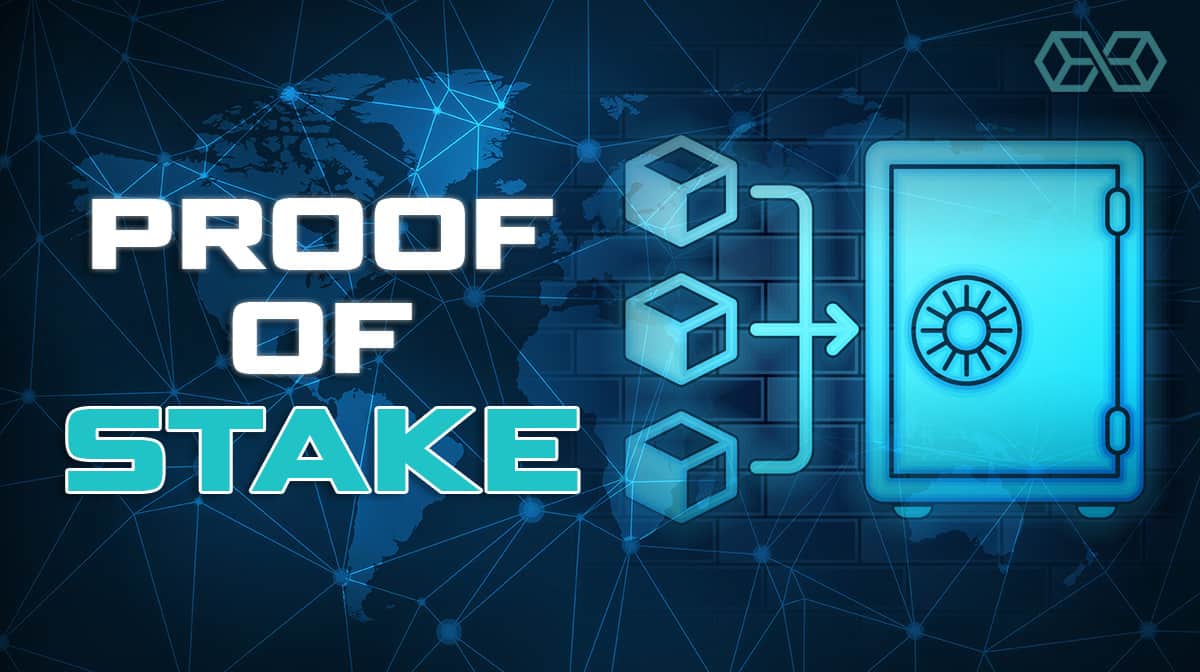
As an alternative to Proof-of-Work (POW), this POS allows more users to participate in maintaining and validating the network without the need for expensive equipment and high electricity usage. In this article, you will learn how POS and POW are similar, how they differ, and how you can start earning rewards through staking right away.
Consensus
Both POS and POW are different methods for reaching the same end goal, which is to coordinate agreement in a decentralized network. Consensus simply means a general agreement, but on a peer-to-peer network of computers that have no hierarchy, manager, coordinator, or director, reaching consensus requires the right combination of cryptography, rewards, and punishments.

These computers in the network, also known as nodes, must have some basic set of rules of how to agree or determine what is true. The rule set in which they agree to participate in is called a consensus protocol, mechanism, or algorithm.
The nodes are allowed to participate in the network by running software that has the same underlying consensus protocol at its root. In general, the consensus mechanism is how these nodes come to an agreement even if some (normally up to 1/3) of those nodes disagree or behave badly. This is also known as a Byzantine Fault Tolerant system.
Proof of Stake (POS) vs Proof of Work (POW)
Proof-of-Work (POW) was a breakthrough technology because it provided, for the first time, an effective and reliable mechanism for reaching consensus in a way that was secure and decentralized. Therefore, to truly understand Proof-of-Stake (POS), it is important to understand how POW works.
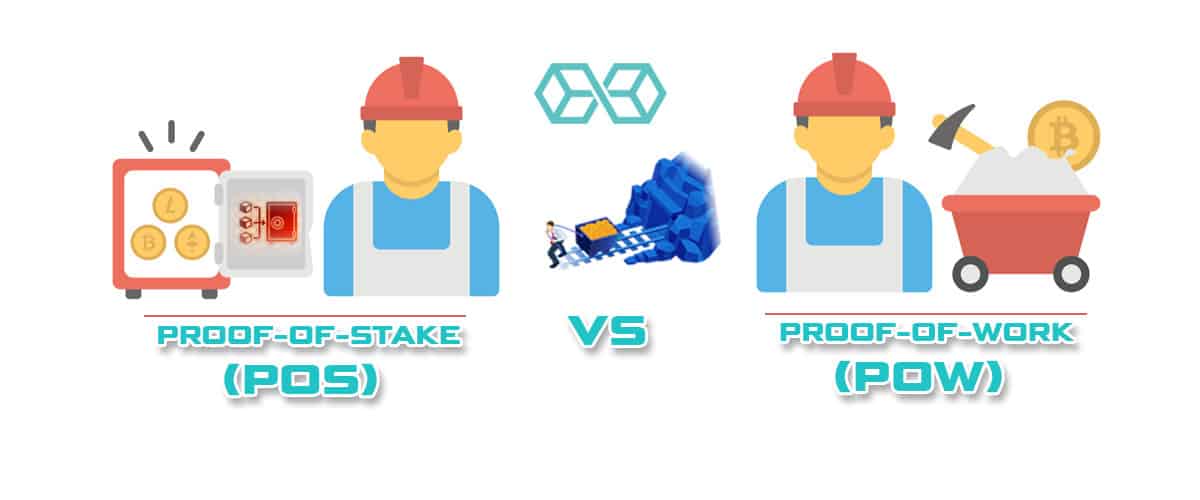
POW Costs
If POW works and works very well, then why does there need to be POS at all? The answer is electricity. The primary input of a POW system is electricity and this real material cost to our environment and planet is one of the main reasons why so many of the major existing and upcoming blockchain networks have plans or are already dedicated to alternative consensus mechanisms such as POS.

Bitcoin was the first application to use POW and did not consume massive amounts of energy in its initial years. However, as the Bitcoin asset became more valuable and thus more profitable to mine, competition increased and so did the electricity needed to mine profitably. Bitcoin mining has now reached the point where the entire mining process consumes more electricity than many small and even some medium-sized countries.

In addition to the massive energy costs involved in POW, the process also requires highly specialized computers called ASICs, which has resulted in massive electronic waste when the ASICs become obsolete or unprofitable. These very real and significant costs to our environment will likely increase as POW blockchain assets like Bitcoin rise in value.
Similarities Between POW and POS
Like POW, POS requires a minimum amount of participants to secure or maintain the network. If there aren’t enough participants then the network will be easily attacked and not very secure. In addition, the asset on the network needs to have a minimum amount of value.
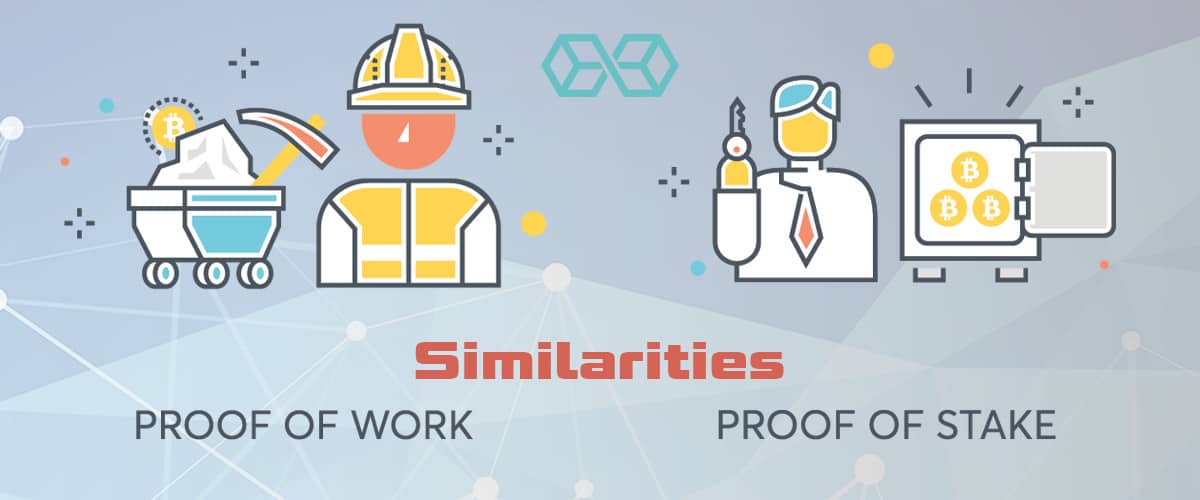
The fact that the crypto asset has value makes the network more secure because the POS or POW systems can reward participants with coins produced by the consensus mechanism. The rewards for participating in consensus combined with the transaction fees on the network, which generally go to POS and POW participants, are the necessary financial incentives that keep a blockchain growing.
Differences
| Proof-of-Work | Proof-of-Stake | |
| Significant Costs | Equipment + Electricity | Crypto Asset |
| Hardware | ASIC / GPU | General Computers |
| Rewards | Fixed | Variable |
| Cooperative Options | Cloud Mining / Mining Pools | Delegating / Staking Services |
| Disadvantages | High Energy Consumption, High Barriers to Entry | Less Proven and Test |
| Participants | Miners | Validators |
The primary difference between POW and POS is the activity that participants engage in in order to secure the network. In POW, participants are called miners, and they must solve complex and difficult mathematical equations through a process of trial and error.
The mining process relies heavily on powerful computers and large amounts of electricity consumption. In a POW system, new tokens are produced to reward miners thus keeping a fixed supply of new tokens that enter the economy with every block mined.
In POS, validators must stake or deposit their crypto assets in order to engage in proposing and voting on the next block in the chain. Instead of investing electricity like miners, validators stake their capital in the form of network coins and the network rewards these validators by producing new coins over time as a reward for validators. Because the barriers to entry are much lower than in POW, nearly anyone is able to participate in POS.
Centralization
Because it is easier to become a validator than a miner, more people are likely to run nodes and become validators, which means a more diverse and decentralized group are securing the network. In order to be profitable more regularly, miners in POW tend to pool resources into mining pools. As a result, three mining pools already control more than 51% of the Bitcoin network.
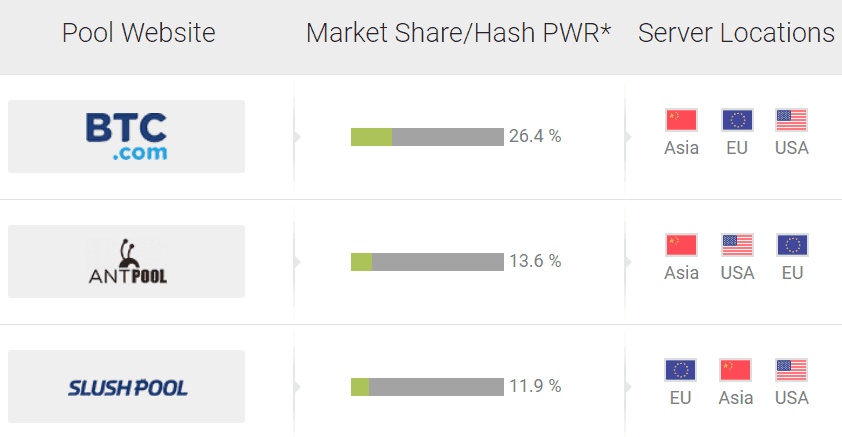
Validators
Though there are many different types and designs for POS systems, with a variety of different terms, the most general name for participants in POS is validators.

Validators are users who stake or deposit their crypto assets for a certain length of time and run specialized software in order to validate and maintain the blockchain network.
What is Staking?
Staking is generally done by sending some minimum amount of crypto assets into a smart contract or specific destination that is used for validating. These stakes are coins of the POS network and are essentially deposits that are frozen and cannot be moved for a certain amount of time. This freezing of assets leaves the validator vulnerable to slashing as a way to deter bad behavior.
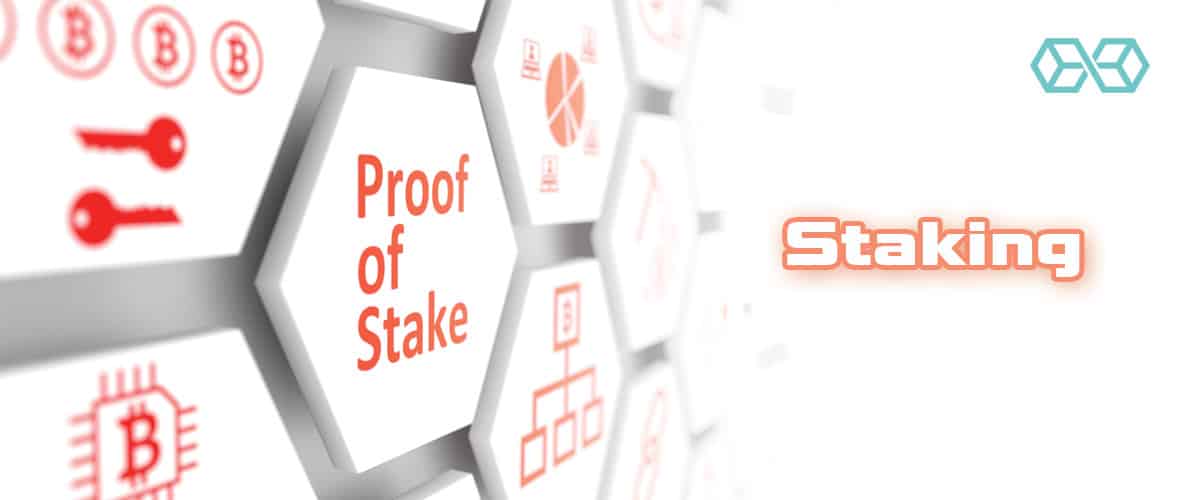
There is normally also a period of time when a validator wants to stop staking tokens, but cannot move them. This time period is called an unbonding period where crypto assets are not being staked, but are also still frozen. All blockchains differ on the length of the unbonding period, which can last from three days with EOS or up to three weeks with Cosmos Hub.
Rewards
Validators are incentivized to lock up their precious capital because they will be rewarded, generally in both network transaction fees and staking rewards. The reward amount in POS systems is usually variable and can change depending on how many total validators are participating at the same time.

If the rewards are too low, there won’t be enough validators participating and if the rewards are too high, it will cause the value of the crypto asset to decrease because it will increase the supply of coins too quickly. The economic and monetary incentives must be carefully balanced.
Punishments
In POS, because there is no electricity being sacrificed to secure the network, there needs to be another deterrent used to prevent attackers from trying to cheat the system. Therefore a necessary component of an effective POS system is a penalty mechanism used to punish those that are misbehaving or simply breaking the rules of the protocol.
Breaking the rules could mean trying to disrupt the consensus of the system or simply not running the software during the validating process. It does not have to be intentionally harmful.
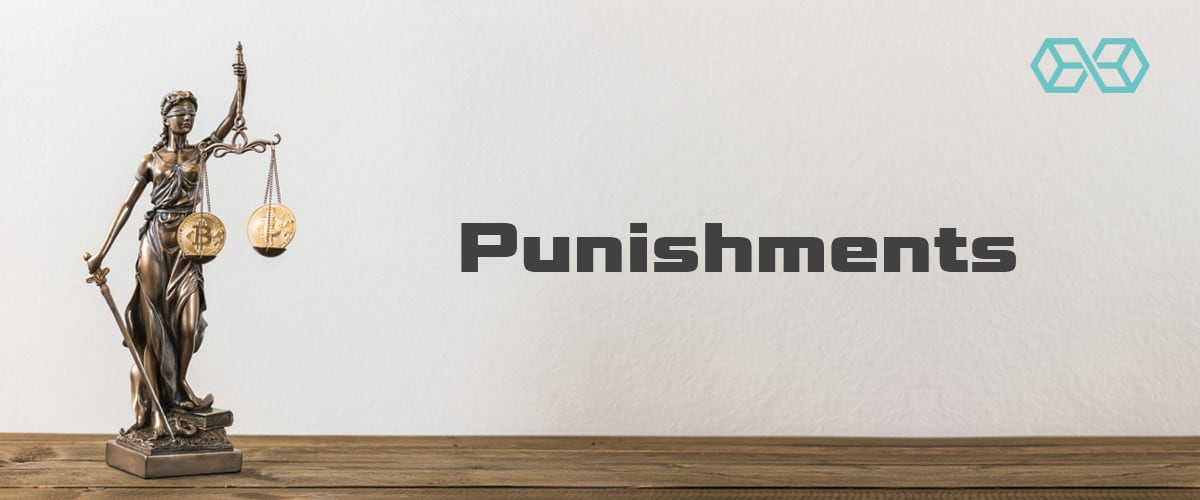
This penalty or punishment is sometimes referred to as ‘slashing’. Each POS protocol has its own rules for what actions are punishable and how severe the punishment is, but in general, the punishment is removing a part of the stake that a validator has locked into the network.
The risk of losing crypto assets should be significant enough to prevent harmful actors in the system. Many POS systems also have reputation systems attached so that good validators who have a long history of good action will be seen as more trustworthy.
POS Costs
The primary cost in POS is the value of the crypto asset which must be purchased or staked in order to participate in POS. The cost of validating on the network is in running the equipment and software. Though, not nearly as intensive and costly as in POW, it does still require some cost. For example, in Ethereum’s upcoming POS system, the cost of staking is around ‘$120/year for a beacon node and $60/year per validator client’.

Besides the material cost, there is an opportunity cost of not being able to access your crypto assets, which can be used in other decentralized financial application such as lending. These alternative uses for your crypto assets may offer higher returns but must be given up in order to participate in staking.
Selection
Not all validators produce the same blocks at the same time. Instead, validators are chosen individually or as a set to determine which one will produce and validate the next block. Each POS design has its own method of determining, which validator(s) is chosen, but the election process is normally a combination of random selection or the total value of the validator’s stake.
Risks
Participants have to trust the POS system that they are locking their precious crypto assets into. If the network has a fatal flaw or bug then you could easily lose your staked coins. At the very least, the discovery of a major bug in the system will mean that your coins lose significant value and because you are locked in the system for a certain amount of time, you will likely not be able to sell very quickly.

You are also trusting that the POS design’s slashing and punishment mechanisms work as intended and you are not mistakenly slashed.
Staking in a network that promises higher yields usually means staking in smaller networks that are less proven and therefore have higher risks. POS protocols have not had to deal with anywhere near the amount of value in existing POW protocols such as Bitcoin or Ethereum so it is a valid argument to say that POS has not been tested against attackers in the same way that POW has been.
Known Issues With PoS
Some cryptographic researchers have pointed out some pressing issues with PoS consensus. These issues don’t afflict every PoS blockchain, and there are some which have effectively solved many of these limitations – which we’ll discuss later.
These issues include:
- The nothing at stake problem – As there’s no hashing power required to build a PoS blockchain, and therefore no or little computational effort, blockchain validators can exploit the network. They do this by building on all of the past versions of the blockchain, which allows them to claim fees for validating transactions on both the chain that becomes the most used, and any legacy chains which continue to be used.
- Negative feedback loop – Proof of stake encourages the staking of coins or tokens, which effectively removes them from the circulating supply. This means there are less tokens to be used as digital cash within a blockchain ecosystem, potentially negatively affecting the economics of the underlying network. However, scarcity via staking could also increase the price of the token.
- Goldfinger attacks – Goldfinger attacks can seek to bribe the node operators or staking pools, rent more stake to launch an attack on the protocol, or build a pool to try and seize a majority. Goldfinger attacks are named after the James Bond villain, who undermined the US Treasury to his own gain.
- Security – PoS is a relatively new technology, and so the security has not yet been proven. PoS has been in use for some time and so far it seems to be secure, but there is no guarantee as of yet.
Certain blockchains have sidestepped these issues. For example, third-gen blockchain protocol Cardano use the Ouroboros consensus mechanism, which uses sidechains to avoid Goldfinger attacks, and solves nothing at stake issues by using forkable strings.
Similarly, Tezos uses a security deposit to ensure that double staking or validating on simultaneous chains is prevented.
Delegating
The easiest way to get involved and start earning rewards in most POS systems is not through validating directly, but through delegating. Delegators participate in POS by staking their crypto assets with a trusted or reliable validator who runs the software and equipment, but pools the capital from different delegators.

In other words, instead of running the software yourself, you can send your tokens to a validator who will do it for you for a small fee and share of the rewards.
Like with ‘validators’ and even ‘staking’, many different terms are used when a user must trust another party to handle the technical staking, but we will stick to delegating. As a delegator, there is a risk in choosing and trusting validators because you will both share in the rewards and the punishments if they occur. As with validating directly, there is the danger of getting punished or slashed if the validator that you are delegating to misbehaves.
Delegating can normally be done on-chain so that the validator does not own or control the delegator’s tokens and can only use those tokens in staking. Delegating to participate in POS involves the same basic steps:
- Step 1: Get Coin
- Step 2: Download Wallet
- Step 3: Delegate to Validator
Staking Comparison
The blockchain networks below are active today and anyone can become a validator or delegator to earn rewards on them. We will describe the unique POS mechanisms of each one as well as how to start staking in them.
| Cosmos
|
Tezos
|
TRON
|
EOS
|
Dash
|
|
| Native Coin | Atom (ATOM) | Tez (XTZ) | Tronix (TRX) | EOS (EOS) | Dash (DASH) |
| Consensus Mechanism | Tendermint | Liquid Proof of Stake | Delegated Proof of Stake | Delegated Proof of Stake | Proof of Work + Masternodes |
| Market Cap (as of 2 May 2019) | $874 Million | $800 Million | $1.5 Billion | $4.5 Billion | $1 Billion |
| Annual Staking Yield (as of 2 May 2019) | 13% | 7% | 4% | 2% | 6% |
| Minimum Staking Requirements | 1 ATOM | 1 XTZ | 1 TRON | 1 EOS | 1,000 DASH |
| Active Validators (as of 2 May 2019) | 109 Validators | 220 Bakers | 27 Super Representatives | 21 Block Producers | 4800 Masternodes |
| Annual Token Supply Growth | 7% | 5.5% | 336,384,000 TRX | 5% | 8% |
Cosmos
The Cosmos network aims to become an interoperable blockchain protocol that allows many different blockchains to communicate, share data, and transact with each other. Cosmos also easily allows developers to build their own specialized blockchain on their Tendermint consensus protocol, which uses POS.

One of the biggest and best crypto exchanges in the world, Binance has created its own blockchain, Binance Chain that is built on the Tendermint protocol.
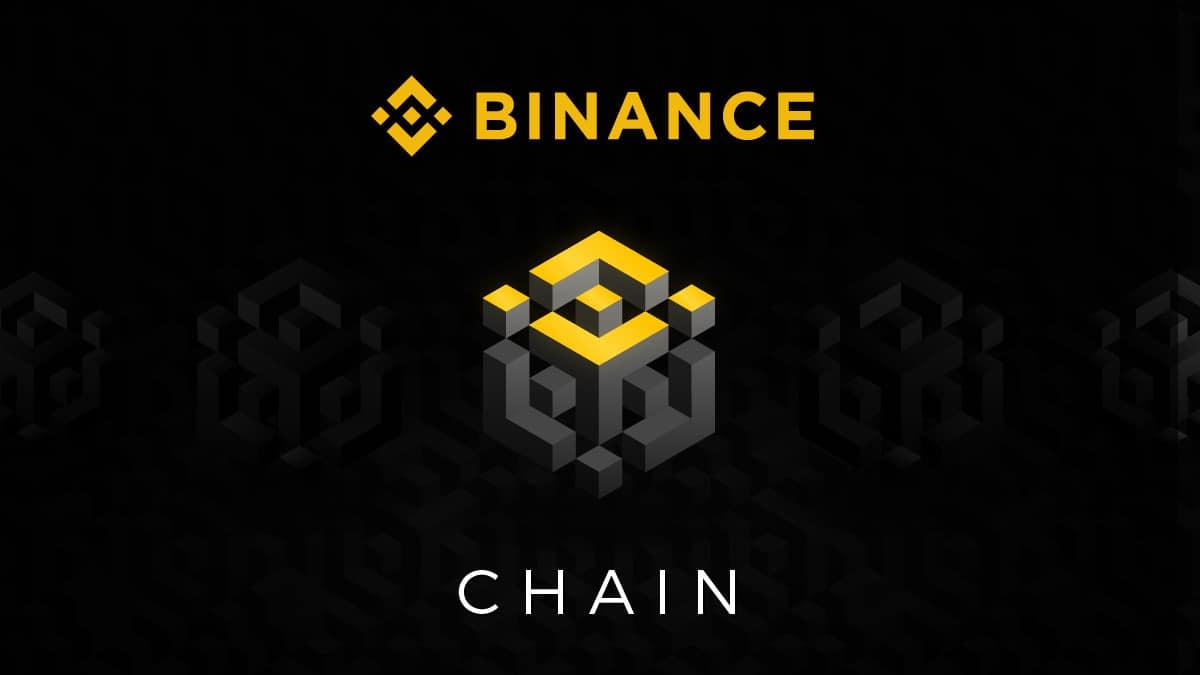
ATOMs
The Cosmos Hub is the first hub that will connect many different blockchains and its native token is ATOM. Holders of ATOMs are able to participate in POS to earn more ATOMS as well as vote on governance decisions on Cosmos Hub.
Validators
There are currently over 100 validators on Cosmos, but there are plans to have up to 300 over time. Validators are chosen based on their own self staked ATOMs and the ATOMs of those who have delegated tokens to them. The top 100 validators with the most self and delegated stakes are chosen as the validators of the system so it is important for a successful validator to attract stakes through delegators.
If you want to start running your own validator on the Cosmos network, you can follow its instructions using command line.
Delegators
All validators in the Cosmos network can be delegated to and this happens as an on-chain function. To become a delegator, you must hold ATOMs and send a ‘delegate transaction’ indicating how many ATOMs to stake and to which validator.
The top active validators on the Cosmos network can be seen below:

Polychain Labs is the top validator on Cosmos and delegating your ATOMs to Polychain Labs can be done on-chain via the command line interface:

Tezos
Tezos is a smart contract platform where holders of the Tez (XTZ) tokens are able to participate in POS and governance decisions.
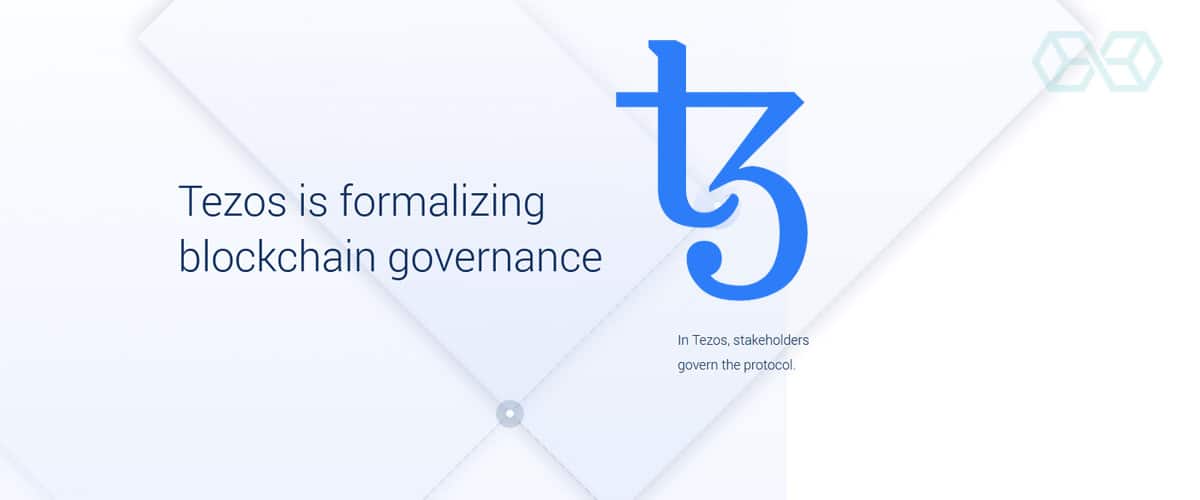
Baking
The Tezos POS system works through ‘baking’ in which holders of XTZ tokens sign and publish blocks to the Tezos blockchain. Bakers in Tezos are basically the validators that we have been describing in other POS systems. Bakers get the right to create a new block by being randomly selected.
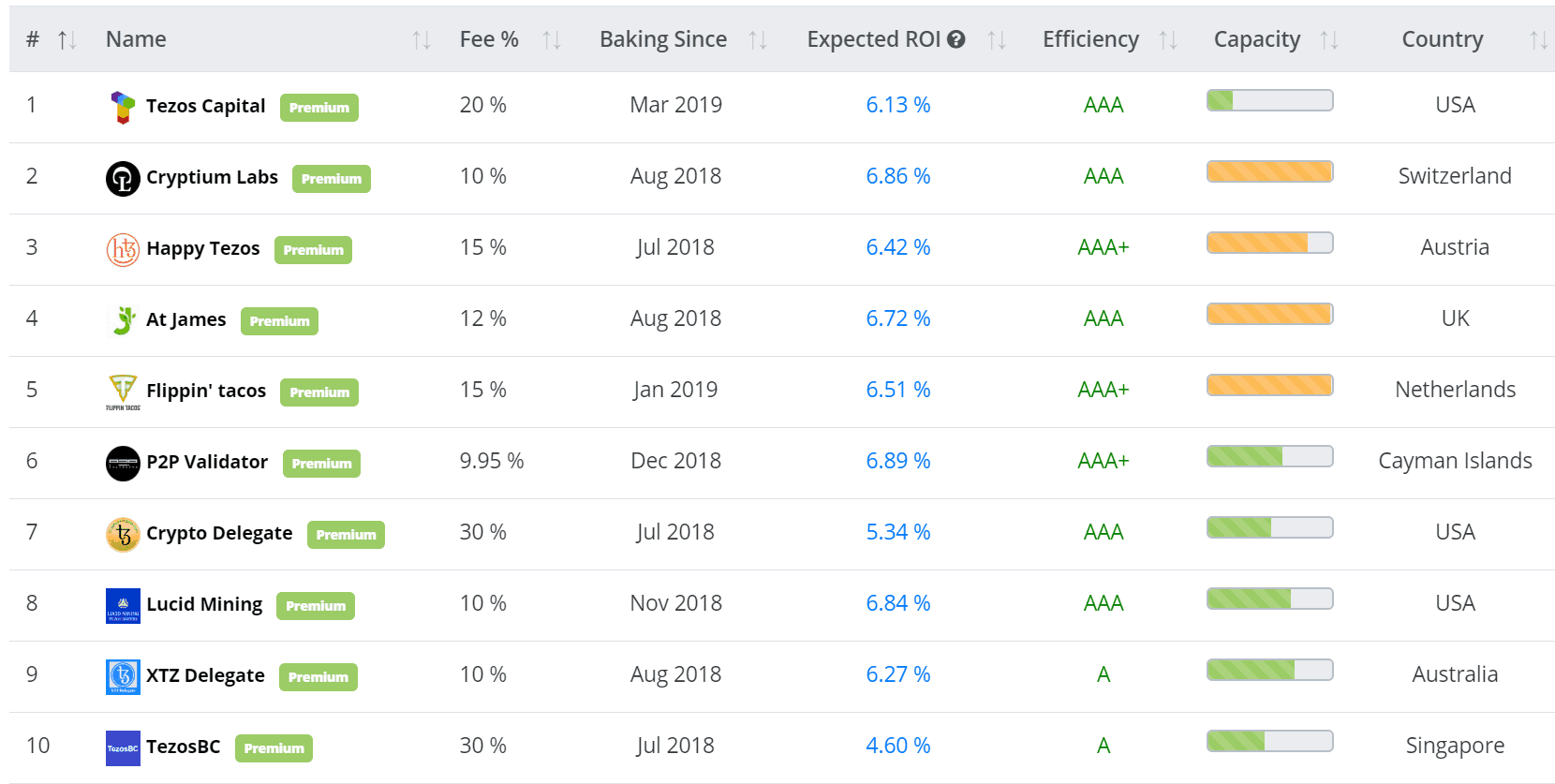
The baker is notified that they have the right to bake blocks weeks in advance and is required to place a deposit or ‘bond’ that changes depending on how many blocks the baker needs to create. The rewards for baking changes depending on the total number of bakers, but the system will create roughly 5.5% of the total token XTZ supply each year in baking rewards.
A list of active bakers and tools for calculating rewards based on how much XTZ is staked and which baker is chosen can be found at mytezosbaker.com.
Delegating
Like Cosmos, Tezos also allows its coin holders to delegate their crypto assets to chosen validators or bakers. To get started delegating, you need to download and use a wallet, which will likely have a delegation feature from which you can choose the baker that you want to trust to bake for you and share rewards with you.
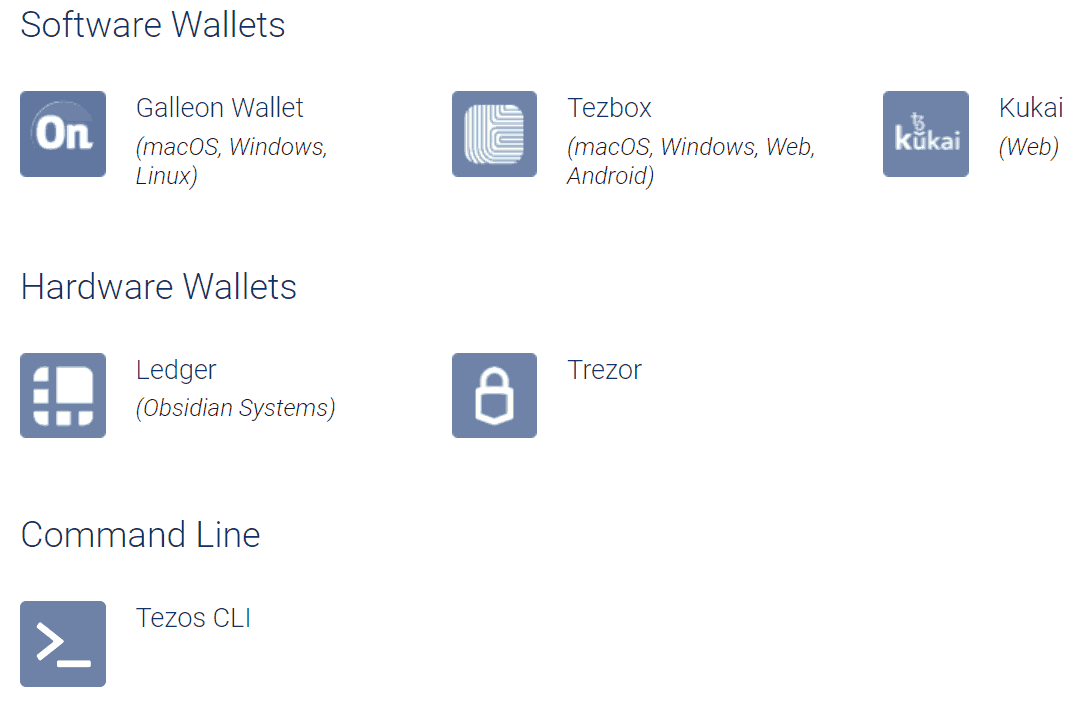
Delegating can be done through the Galleon Wallet by following these simple instructions:
Dash
DASH is meant to be a private and secure cryptocurrency that can be transferred quickly and easily.

Dash has a consensus system that is a hybrid of POW and POS so it still has miners maintaining the network. However, we will focus on the POS portion of the DASH protocol, which revolves around a concept known as Masternodes.
Masternodes
Masternodes are servers that are dedicated to maintaining the DASH network. These Masternodes host full copies of the DASH blockchain and must contain a minimum stake of 1000 DASH in order to earn network rewards. In order to host a DASH Masternode, you will need 1000 DASH, a wallet that stores DASH, and a Linux server. For complete steps on how to run a DASH Masternode, please see the instructions here.

Hosting Service
Delegating your stake of DASH to another party to do the difficult technical work is known as a ‘hosting service’ in DASH. There are several hosting services available that are recommended on the official DASH website such as CrowdNode, SID Hosting Service, and AllNodes.
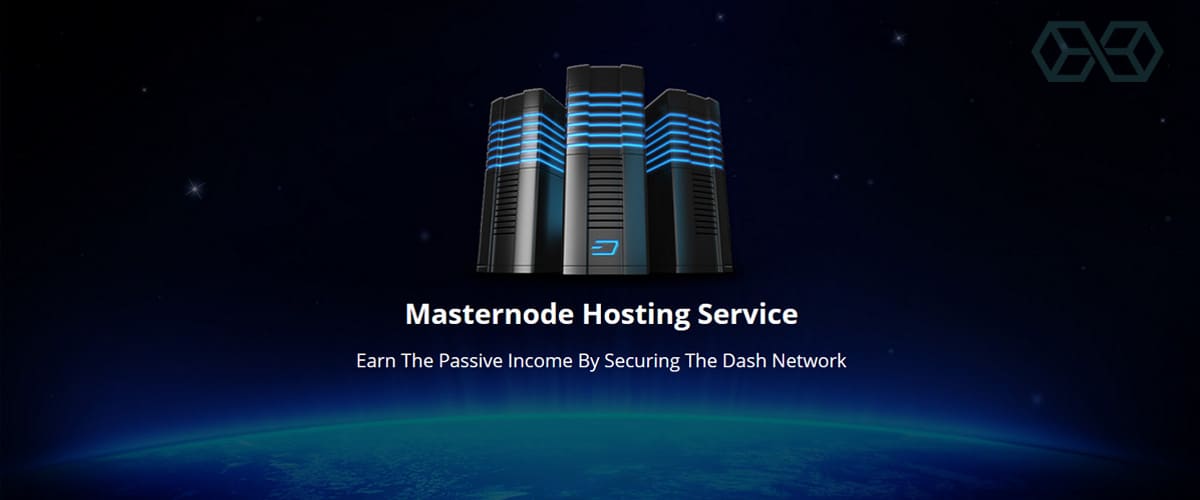
TRON
TRON is a fork or copy of Ethereum that was redesigned to be optimized for performance. Specifically, TRON is much faster than Ethereum, being able to handle up to 2000 transactions per second compared to Ethereum’s 15 transactions per second. TRON is able to accomplish this speed and throughput because it uses a delegated POS protocol while Ethereum still uses POW.
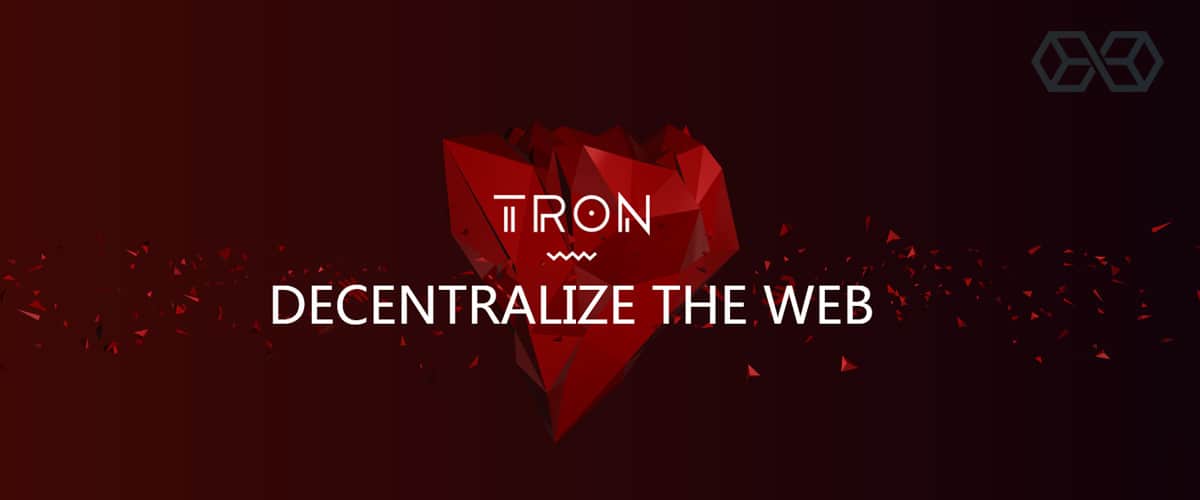
Super Representatives
TRON has implemented a delegated POS consensus protocol and staking occurs through 27 validators that are called Super Representatives (SR). Staking in TRON is done through a system of freezing TRX tokens and voting for SRs. You can see all the current Super Representatives as well as the SR candidates on the tronscan.org block explorer:
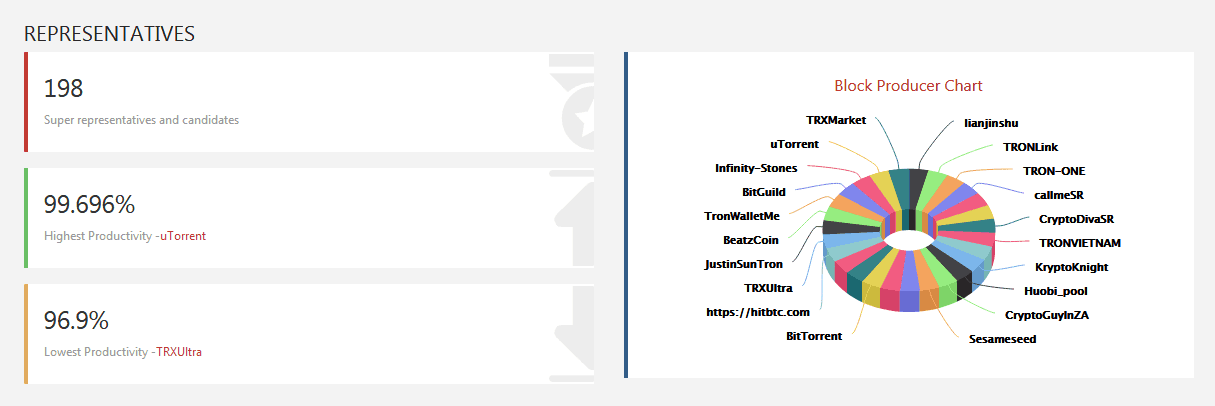
Delegating your TRX to an SR is done by ‘voting’ for them. The top 27 SRs with the most votes gets to participate in the block producing process. To start delegating or voting, you can follow these instructions.
EOS
Like TRON, EOS is also a smart contract platform that has become scalable by using the Delegated POS system.
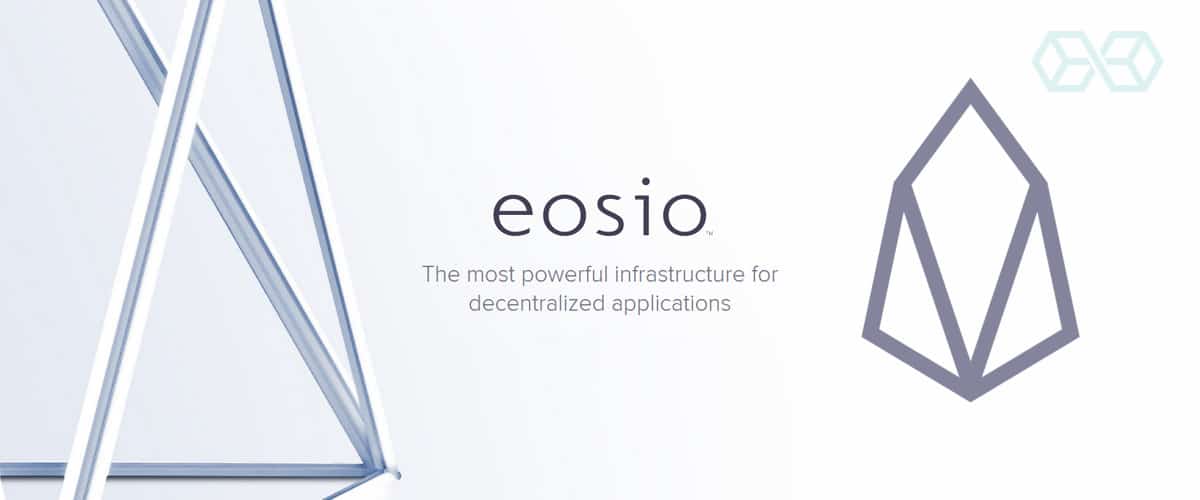
Block Producers
The EOS delegated POS system relies on 21 elected Block Producers to actively maintain and build the network. The system is also similar to TRON in that Block Producers are voted on or selected by EOS holders. Voting happens in rounds where the 21 Block Producers are selected by EOS holders and the more EOS tokens a voter has, the more their vote is weighted.
You can participate in voting on EOS through a wallet such as SimpleEOS, EOS Voter, or Scatter.

For a comparison between EOS, Ethereum, and TRON, check out our in-depth guide.
Cardano
In July 2020, Cardano completed its move to a fully decentralized blockchain with the release of the Shelley era. The blockchain underwent a continuous hardfork which welcomed the beginning of staking and delegation on the network.
ADA holders can currently delegate their stake through the official Daedalus wallet, and soon the Yoroi wallet from Cardano’s partners, EMURGO; and also eventually through Binance!
Although staking has been live for less than a month, there’s already almost one thousand stake pools live, making Cardano one of the most decentralized blockchain protocols almost overnight.
Staking has proven very popular on Cardano, and although it’s currently too early to give a detailed breakdown of staking rewards here, you can find out how much you could earn through ADA staking by checking out their staking calculator.
Ethereum 2.0 Staking Plans

The world’s largest crypto network after Bitcoin is Ethereum and the protocol plans to switch to POS in what is being known as Ethereum 2.0. Though the plans for Ethereum 2.0 are constantly changing, the first step in the POS specification is being planned for completion by 30 June 2019.
At the latest specification, a validator would need a minimum of 32 ETH staked in order to participate in POS on Ethereum. The amount of ETH designated as rewards for staking will depend on the total number of validators in the system. Though exact figures are still unconfirmed, resources are available to estimate how much return can be expected by staking a certain amount of ETH.
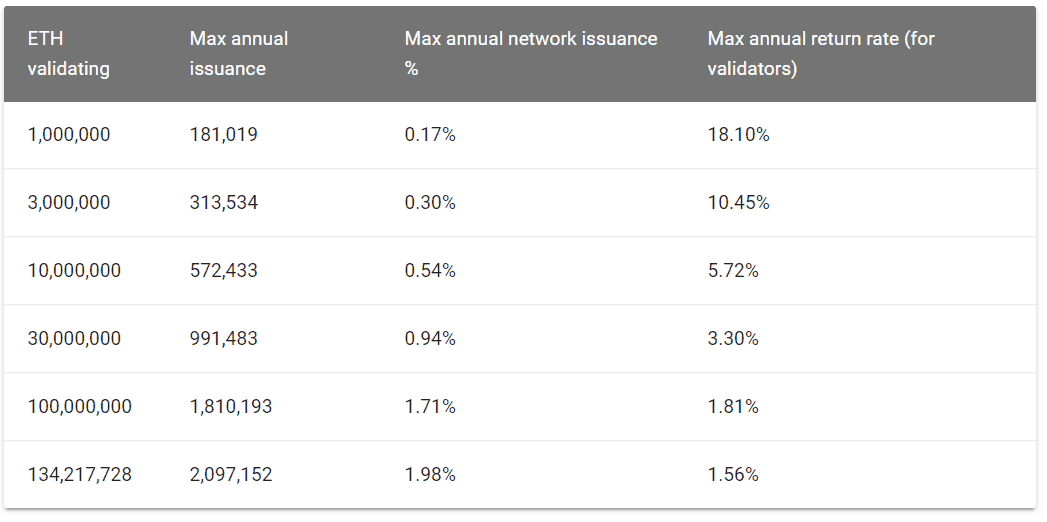
Adjustable calculators can be used to view interest rates and returns depending on different things like total staked and supply. Since the final release of Ethereum 2.0 is still probably at least a year away, many of these parameters will likely continue to change.
The Future of POS
The environmental impact and cost of POW have meant that POS is becoming the preferred consensus protocol for both new and existing blockchain networks. By allowing coin holders to participate in maintaining the network and incentivizing them with rewards in the form of native tokens, POS is a simple way to earn money without selling your crypto assets.

As POS becomes more well-known and popular, we will also likely see a rise in staking services that will offer easy user experience and handle all the intricacies and work of staking for the user while sharing the rewards for a small fee. The blockchain industry continues to evolve rapidly in all aspects from basic infrastructure to the user interface.
References
- EOS.IO Technical Whitepaper v2
- Tron Whitepaper v2.0
- Blockchain Explained
- Opportunity Cost Defined
- ETH 2.0 Economics
- Bitcoin Electronic Waste Monitor
- Bitcoin Energy Consumption Index
- Application-specific integrated circuit Explained
- What is Byzantine Fault Tolerance?
- Peer-to-Peer Defined
- Ethereum 2.0 roadmap
What Is Proof of Stake (PoS) & How Does it Work? Find Out Here in our Ultimate Coin Staking Guide was originally found on Blokt - Privacy, Tech, Bitcoin, Blockchain & Cryptocurrency.
]]>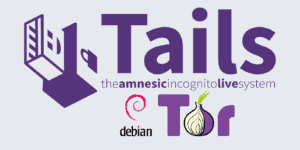
Internet privacy is something a lot of people are concerned about. Despite this, not a lot of people know the best ways to go about it. This article will give you some information you need to make sure you can keep yourself protected from any When whistleblower Edward Snowden was communicating with Glenn Greenwald back […]
Tails OS – An Actionable Guide for Regular Folks was originally found on Blokt - Privacy, Tech, Bitcoin, Blockchain & Cryptocurrency.
]]>
Internet privacy is something a lot of people are concerned about. Despite this, not a lot of people know the best ways to go about it. This article will give you some information you need to make sure you can keep yourself protected from any
When whistleblower Edward Snowden was communicating with Glenn Greenwald back in 2013 about the goings-on at the NSA, one of the tools he used to protect himself was Tails. But that was a long time ago. So does Snowden still like Tails? Here’s what he had to say on the subject in this December 13, 2017 tweet:
TAILS (@Tails_live, https://t.co/Re3LzE4WdO) is the most accessible for normal folks looking to "torify" non-browser traffic, and a gentle introduction to Linux (which is still gonna be a learning experience). You can boot it from a USB stick without overwriting your everyday OS. https://t.co/eHqYarXFjZ
— Edward Snowden (@Snowden) December 13, 2017
Even if you don’t understand exactly what he’s talking about (yet), this Tails thing is important. So please keep reading to learn what it is and why it has become so popular.
What is Tails, and why do privacy fans love it?
Tails is a unique computer operating system. It is designed to help you use the Internet anonymously and get around censorship. Tails is a live system (live operating system) that runs from a USB stick or DVD. It lets you connect to the Internet using virtually any computer while leaving no trace of your activities after you have finished.
Even better, Tails is free software that anyone can install and use whenever and wherever privacy and anonymity are essential.
What makes Tails safer than other operating systems?
Because Tails was designed from the beginning to provide privacy and anonymity, it differs from other operating systems in several areas:
- Tails forces all Internet connections to go through the Tor network. Tor is a worldwide distributed network that prevents people from watching your network connection from knowing what websites you visit while keeping those websites from learning your physical location. For more details on how this works, visit the official About Tor page.
- Tails connects to the hardware of a computer but doesn’t use the operating system or disk drives. That means there is no permanent record of your activities on that computer. Once you remove the Tails USB Stick or DVD and restart the computer, there will be no way to tell Tails was used there.
- Tails comes with state-of-the-art encryption technology. From PGP and OTR support for secure communications to the automatic use of HTTPS when visiting websites to the ability to encrypt the files on your USB stick or DVD, Tails has you covered.
With all these privacy and anonymity features together in a package that you can literally carry in your pocket, it is easy to see why privacy fans love Tails.
This all sounds great, but you may still be wondering, “Is Tails safe to use?” Tails is far safer than the typical operating system, but it is not foolproof. There are various ways bad guys can get around the protections built into Tails. Here is a detailed explanation of Tails’ security limitations.
Watch the following video for a more detailed introduction to Tails:
One of the great things about Tails is that you can create your own Tails USB Stick or DVD and try it yourself. And since it is free software, all it will cost you is the USB Stick or DVD you install it on.
In the following few sections, we’ll talk about the process of creating and configuring a Tails System using a USB Stick. We won’t walk you through the process step by step, as the details depend on the type of computer you install from and the media you will install to.
We encourage you to create your own Tails System by following the instructions on the Download and Install Tails page that applies to your situation.
Once we’re done, you’ll be able to see for yourself how Tails and its included software work.
We’re going to:
- Download and verify Tails
- Install Tails on a USB Stick
- Configure Tails & Tor
Tails 5.0
On the 3rd May 2022, Tails announced the launch of Tails 5.0. This is the first version of Tails to be based on Debian 11 includes lots of new versions of software and tools.
Some features to note are:
- The addition of Kleopatra, a popular certificate manager, to replace the OpenPGP Applet and other utilities.
- The Additional Software feature is enabled by default to make it quicker to configure additional software packages.
- The activities overview can now be used to access windows and applications.
Downloading and Verifying Tails
We used a computer running Linux to create our Tails System. Clicking through the options on the Download and Install Tails page led us here:
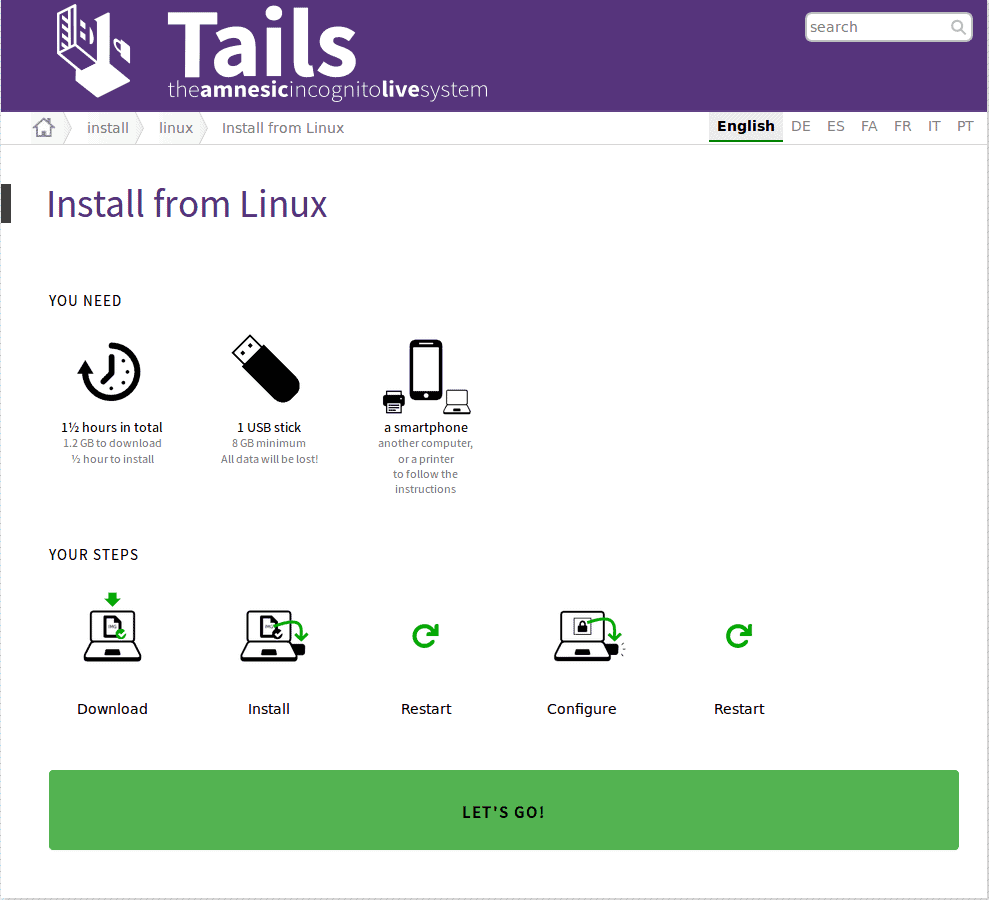
Once we were ready, we clicked the big green “Let’s Go” button, which led us to the detailed instructions. From here on out, it was just a process of following the detailed instructions provided by the Tails team.
We downloaded the Tails USB image then verified it using the Tails Verification browser extension. Verifying your download is vitally important. This will tell you if your download is somehow corrupted.
Downloads are sometimes incomplete, or part of the download might not be 100% identical to the original. And sometimes, hackers break through the security on a website and replace the original with a hacked version. Verifying your download will spot any of these problems for you.
Once we had a verified version of the Tails USB image on our computer, we followed the instructions for installing it on the USB stick.
Installing and Running Tails on a USB Stick
Installing Tails might be overstating things a bit here. All that we need to do is copy the verified Tails USB image onto your USB Stick. The instructions will tell you exactly how to do this for the computer you are using to install Tails.
Running Tails for the first time may be more challenging than downloading and installing it. That’s because most computers are not configured to run from a USB Stick.
We had this problem and had to spend some time figuring out how to get our computer set up correctly. The Tails does not start at all troubleshooting guide helped us deal with this.
Configuring Tails
There isn’t a lot of configuring to do with Tails initially. When you start Tails, you see a screen that looks like this one:
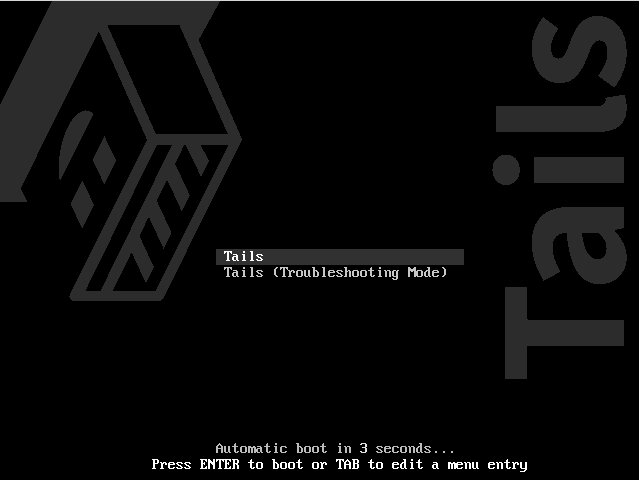
After you press Enter (or several seconds with no input), the Tails Greeter screen appears:
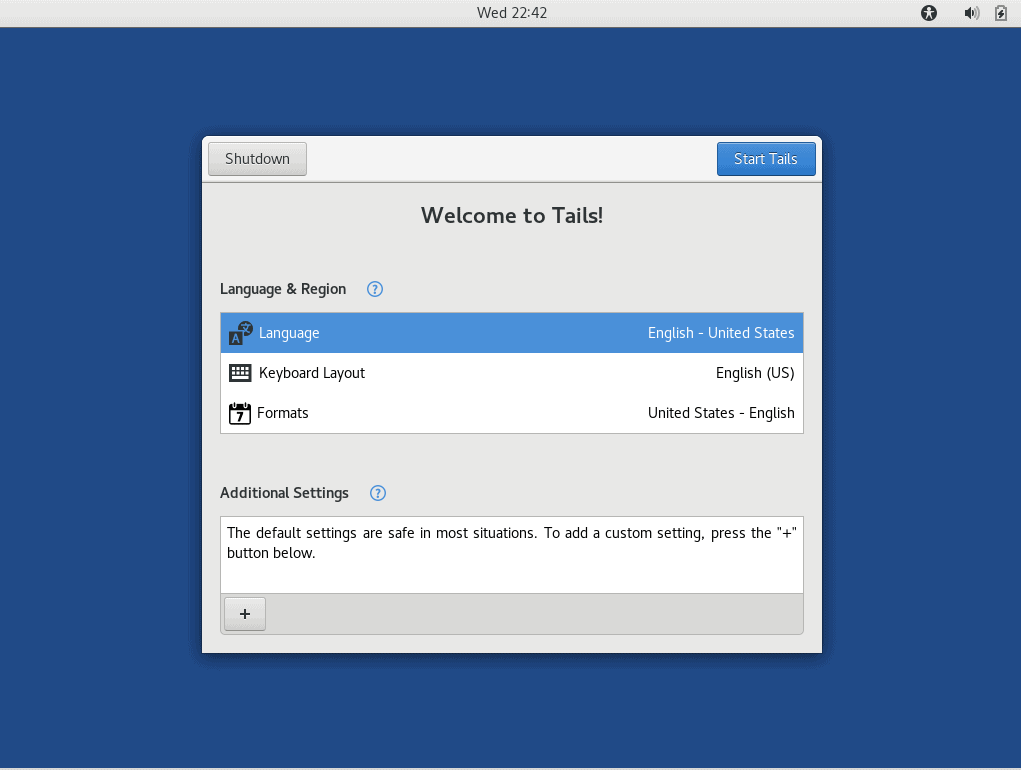
Here you tell Tails the Language you want to use, the Keyboard Layout, and the Formats for things like the date and time.
In addition, you can activate a full range of Accessibility options from the Universal Access menu:
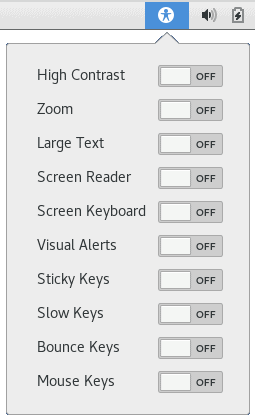
NOTE: The Tails team configured Tails to be as safe as possible by default. If you need to deviate from the defaults, the Additional Settings section of the Greeter is where you make those changes. We recommend you avoid making any changes here, if at all possible.
Once you are done setting things up in Greeter, click the Start Tails button.
A Quick Intro to the Tails Desktop
Tails uses the GNOME graphical user interface. GNOME is used in several versions of Linux and is one of the more popular user interfaces. In Tails, the GNOME desktop looks like this:

The Top Navigation Bar contains the two main Tails menus, along with a group of icons with various functions. Here is a quick summary of what you’ll find in this navigation bar, from left to right:
- The Applications menu gives you shortcuts to the pre-installed software on Tails, along with some utilities for configuring the desktop. You’ll find all the basic applications you need to get things done here, along with some specialized stuff related to the privacy and anonymity features of Tails.
- The Places menu has shortcuts to folders on the system, as well as any storage media like disk drives that might be connected.
- The Calendar and Notifications appear together in the top center of the window.
- The OpenPGP Applet comes next. You’ll use this to encrypt and decrypt text for greater privacy.
- The Tor Status icon looks like an Onion, and you can click it to see the Open Onion Circuits Tails knows about.
- We talked about the Universal Access icon and menu back in the Configuring Tails section.
- The System menu contains information on your network connection, the status of the computer’s battery, and other settings.
Connecting Tails to Your Network and the Internet
Tails is of little use unless it is connected to the Internet. But before it can connect to the Internet, Tails needs to connect to your network. You can see the status of your connection to the local network in the System menu:
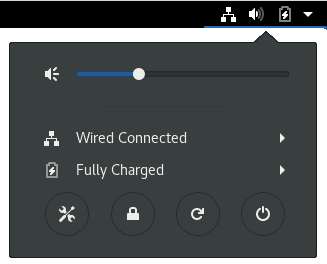
We had no problem connecting Tails to our local network. Once we did, it automatically connected itself to the Tor network and through that to the Internet.
You can quickly see if you are connected to the Tor network by looking at the Tor Status icon in the top Navigation Bar.
If Tails is connected to the Tor network, the Tor Status icon looks like this:
If Tails is not connected to the Tor network, the Tor Status icon looks like this:
While we had no problems, connecting Tails to the Internet doesn’t always go so smoothly. If you have problems, the Tails documentation has detailed instructions on how to connect to the Internet anonymously.
The Tor Browser
The Tor Browser is based on the popular Firefox browser. But it has been heavily modified, with your privacy and anonymity in mind. The developers stripped out services like JavaScript and cookies that can be used to defeat the anonymity provided by the Tor network. This makes the Tor Browser safer for you to use, but you may find that some websites don’t work right without these services. You can learn more about the differences at the Tor Browser page.
Tails Tools for Privacy
The Tor network and browser provide you with anonymity when using the Internet. But anonymity doesn’t guarantee privacy. Let’s take a quick look at a few of the most useful encryption tools that Tails gives you to boost your privacy.
Why You Need Encryption Too
This can be confusing, so let’s look at an example. Let’s say I want to send a message to my wife, Ruth. I don’t use an encrypted application to create it, so the message starts out in plain text. Before the message leaves my computer, Tor wraps it up in three layers of encryption. That’s an essential part of how Tor works.
As my message passes through the network, Tor strips off layers of encryption. When my message leaves the Tor exit mode and goes to its destination, all the layers of encryption that Tor added are gone. What Tor has done is make it impossible to trace my message back to the computer it came from. This provides anonymity.
But what about the contents of my message? The contents are now in the same state that it went into the Tor network. Since I sent a plain text message into the network, a plain text message comes out of the network.
This might be fine, but it might be disastrous. When in doubt, it is best to be safe and use the encryption tools provided by Tails. That way, your messages, and data can only be read by the people who are supposed to read them. Even if they were somehow able to intercept your messages en route, all any snoop would see would be incomprehensible gibberish.
Keeping Your Communications Secure
Tails gives you several ways to keep your communications secure from prying eyes.
Encrypting, Decrypting, and Verifying Messages with the OpenPGP Applet
If you want maximum privacy, you should use the OpenPGP applet. Encrypting and decrypting messages is riskier if you do it in the web browser. To use the applet, you can compose your message in a text editor, then use the applet to encrypt it. Likewise, you can receive an encrypted message and import it into the applet before decrypting it.
Using OpenPGP can be labor-intensive. If you are sending lots of encrypted messages by email, Thunderbird, an email program that comes pre-installed on Tails, might be a better option than OpenPGP. If you want to go this route, you can find more information at the Thunderbird Help page.
Chatting Securely with the Pidgin Instant Messenger and OTR Encryption
Pidgin Instant Messenger is a chat application that can connect to several different chat systems simultaneously. When combined with OTR (Off-the-Record) messaging, you get encryption and more. If you want to be able to chat securely while using Tails, get all the details at the Chatting with Pidgin page.
Keeping Your Data Secure
Normally Tails only stores data until you shut down. But if you are running Tails on a USB Stick with additional space available, you can create a Persistent Storage area on the USB Stick to retain data long term.
There are pros and cons to creating a Persistent Storage area, and the Tails team advises against doing so in most cases. Still, if you need to store data securely, or add additional applications beyond those that come pre-installed, this is your best option.
The Pros and Cons of Using Persistent Storage with Tails
| Pros | Cons |
| Allows you to store encrypted data on the Tails USB Stick | The Persistent Volume is visible to anyone who has access to the USB Stick. |
| You can install additional applications | Installing non-default applications can break Tails security |
| You can change the configuration of applications | Changing configurations of default applications can weaken anonymity |
| You can open the Persistent Storage from other operating systems | Accessing Persistent Storage from other operating systems can compromise security |
To further minimize the risks of using Persistent Storage, you get to specify exactly which types of files Tails can store there.
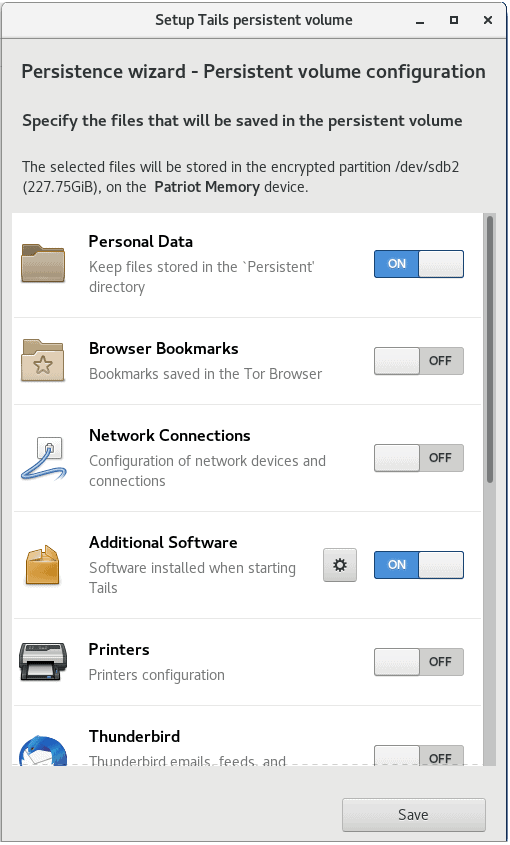
If you still want to go ahead after looking at the pros and cons, you’ll want to head to the Encrypted Persistence page for detailed instructions.
Managing Passwords
One of the best uses for Persistent Storage is to keep track of all your passwords. Using a different, strong password for each website and application that needs one is a must, but keeping track of them all without computerized help is almost impossible.
To address this problem, Tails comes with KeePassX, an open quality password manager. You can use it to keep track of all your passwords while only needing to remember the single password that unlocks this application.
Tails and Cryptocurrencies Make a Great Team
If you are interested in cryptocurrencies and are familiar with crypto exchanges, you definitely want to check out Tails. Its privacy and anonymity make it a safer place to keep your cryptocurrency wallets than a standard computer. Tails includes a Bitcoin wallet in its pre-installed software.
Built-in Bitcoin Support with the Electrum Wallet
The Electrum Bitcoin Wallet comes standard with Tails. With only a little work, you can transfer your Bitcoin keys into Electrum. Once you do, your keys will be safer, and your Bitcoin transactions will gain the anonymity of the Tor network. To learn more about the Electrum Bitcoin Wallet, visit the Electrum Home Page.
What about using Monero with Tails?
Monero is a secure, private, and untraceable cryptocurrency. That makes Tails a natural place to store your Monero. If you want to keep your Monero on Tails, you’ll need to set up Persistent Storage on your Tails USB Stick. That’s because Tails does not have a pre-installed wallet for Monero as it does for Bitcoin.
Here are the instructions for setting up Persistent Storage. Once you have that setup, here are the instructions for installing the Monero wallet on Tails.
If you want the ultimate in security for your Monero, you’ll store it in a cold wallet. Tails is an ideal tool for creating such a wallet. Tails leaves nothing behind on a computer that could help a bad guy get access to your cold wallet or even know it exists. And by using Tails, you’ll be creating your cold wallet on a safer system.
Check out this link if you are interested in creating a Monero cold wallet using Tails.
Is Tails always the best solution for privacy and anonymity?
While Tails is a great privacy operating system, it isn’t the only one available, or even the best for every situation. In particular, people interested in online privacy and anonymity often use Whonix or Qubes.
So which is the best? As usual, the answer is, “it depends.” Let’s see how each one stacks up against Tails.
Is Whonix better than Tails?
Whonix typically runs as two VirtualBox virtual machines. You do your work in one virtual machine(the Workstation). The other (the Gateway) handles all connections between the Workstation and the Internet by passing them through the Tor network.
This design means that any computer that can run VirtualBox should be able to run Whonix. This makes it easy to install Whonix, but there are some big security implications to this design.
When you run Tails from a USB stick or DVD, it is the only operating system running on the computer. To run Whonix, you need to have the host operating system running too. You can easily jump back and forth between the private and anonymous Whonix workstation and the host computer.
While this is convenient, it makes it all too easy to do something in the host when you should be doing it in Whonix and vice versa. Even worse, Whonix can’t force communications between the host and the Internet to go through Tor. If you do slip up and do something in the host that you shouldn’t, you’ve lost your anonymity.
While Whonix has some advantages, we think Tails is a better privacy solution than Whonix.
Is Qubes better than Tails?
In some ways, Qubes is more like Tails than Whonix is. That’s because when you run Qubes, it is the only operating system running on the computer. This is inherently more secure than the Whonix approach since there is no way to accidentally get “outside” the secure Qubes environment.
Qubes contains its own virtual machines with differing levels of trust for running applications. The virtual machines are completely isolated from each other by Qubes. This limits the damage that a bad app (like spyware or a virus) can do by confining that damage to one virtual machine.
Qubes itself doesn’t provide any real anonymity. To address this, people sometimes run Whonix inside of Qubes.
One big drawback of Qubes (with or without Whonix) is that there isn’t a Live USB version of it. This means that when you use Qubes, there will likely be traces of it leftover on the host computer once you end your session.
As with Whonix, while Qubes has some benefits, we think Tails is a better solution overall.
Is Tails right for you?
Whether Tails is the “right” operating system for you depends on what you plan to do with it. You probably don’t want to use it as your main operating system. The features that make it such a good privacy tool can make it clumsy for full-time use. Installing your favorite software can be a hassle and may break the privacy protection that Tails provides. Making all your connections to the Internet go through the Tor network will slow down your browsing.
But there are many situations where Tails is extremely useful for anyone concerned with online privacy and anonymity:
- Does it bother you that ISPs and websites watch what you do online and sell that information to marketers or hand it over to spy agencies? If so, using Tails can keep them from finding out anything useful about you.
- Have you ever had your personal data stolen from some poorly protected websites by hackers? Using Tails can minimize the amount of data sites have about you. They can’t lose what they don’t have.
- Do you need to visit sensitive websites that your government doesn’t want you to see? With Tails, you can anonymously get around the blocks they put up to stop you.
- Does your government have a system like China, where everything you do online is monitored and used to decide whether you are a good citizen or not? You can use Tails to anonymously do the things the government doesn’t like.
- Do you want to keep your cryptocurrencies safe? Keeping your cryptocurrency wallets on a Tails USB Stick adds layers of protection to your cryptos.
In short, virtually anyone reading this can think of situations where they could use the privacy and anonymity that Tails can give you. We think it is a great tool, as long as you remember that nothing is 100% safe and secure. Check out the Tails warnings page to be sure you understand the limitations, then give Tails a try.
And in case you were wondering why they call this thing “Tails,” the name is an acronym. It stands for “The Amnesic Incognito Live System.” Now you know.
Tails OS – An Actionable Guide for Regular Folks was originally found on Blokt - Privacy, Tech, Bitcoin, Blockchain & Cryptocurrency.
]]>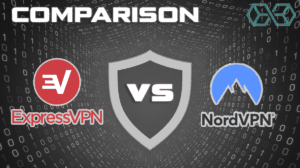
While there are hundreds of VPN services available today, there is a handful that stands out from the rest of the pack. ExpressVPN and NordVPN are two of those standouts. In this ExpressVPN vs NordVPN article, we’ll be comparing these two quality services head-to-head to help you decide which is the best option for your […]
ExpressVPN vs NordVPN was originally found on Blokt - Privacy, Tech, Bitcoin, Blockchain & Cryptocurrency.
]]>
While there are hundreds of VPN services available today, there is a handful that stands out from the rest of the pack. ExpressVPN and NordVPN are two of those standouts.
In this ExpressVPN vs NordVPN article, we’ll be comparing these two quality services head-to-head to help you decide which is the best option for your particular needs and circumstances.
NordVPN and ExpressVPN are always in our top 5 best VPNs in every category. There is a reason for this, they never stop innovating and improving. However, in a head-to-head comparison which one comes out on top?
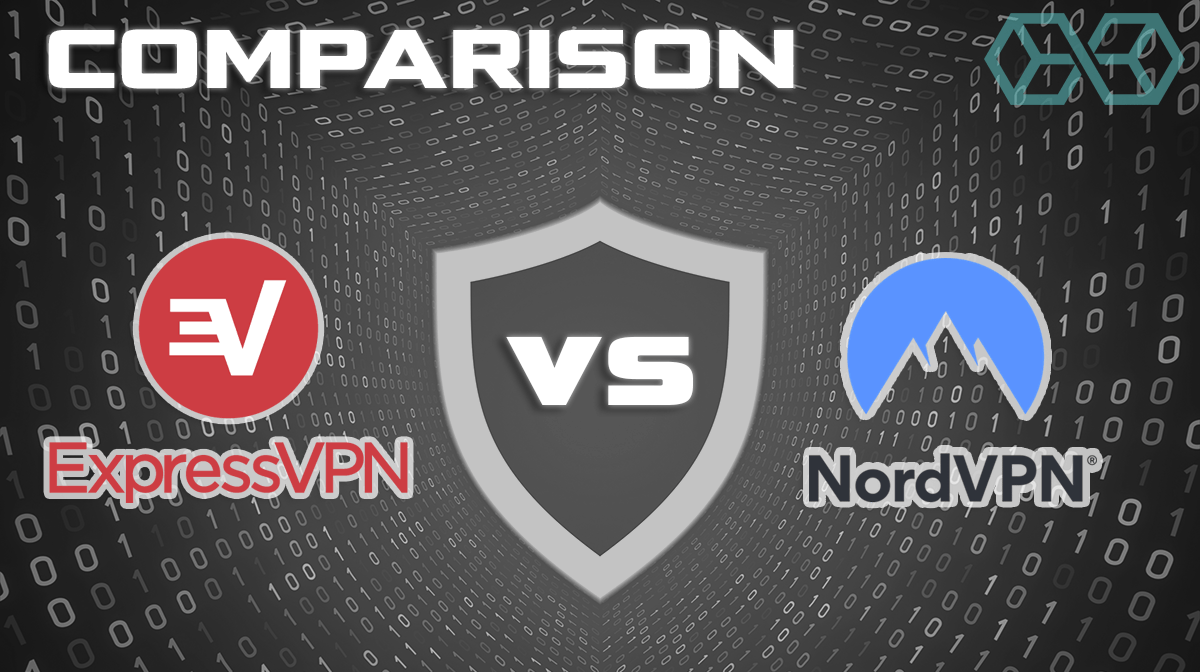
Introducing the Contenders
Here’s a really quick introduction to the two VPNs we are looking at in this article:
ExpressVPN
 ExpressVPN is a premium no-logs VPN at a premium price.
ExpressVPN is a premium no-logs VPN at a premium price.
Based in the British Virgin Islands (BVI), ExpressVPN is known for state-of-the-art features, top-notch encryption, high performance, and excellent customer support.
Frequently touted as the best VPN, ExpressVPN supports the Windows, Mac, and Linux desktop operating systems, along with the Android and iOS mobile operating systems, including the iPhone.
They also have browser extensions for Chrome and Firefox. Beyond this, ExpressVPN can run on many different routers and assorted other devices, such as routers, tablets, games consoles such as the PlayStation 4 and Xbox One, and even e-readers like the Barnes & Noble Nood HD and Amazon’s Kindle.
ExpressVPN guarantees access to streaming services such as Netflix, Prime Video, and Hulu, and also sports streaming channels from around the world such as ESPN, SkySports, and European channels such as BBC and ITV.
There are recent reports that Netflix works perfectly with ExpressVPN and that you even unblock US shows from other countries by choosing a USA IP within ExpressVPN.
More recently, ExpressVPN‘s Aircove router has been met with great reviews for its built–in VPN, intuitive interface, and easy setup. The company regularly listens to customer feedback and is always working to improve the product. Recently, they have released a list of 6 new features and improvements that are designed to make the Aircove router even better.
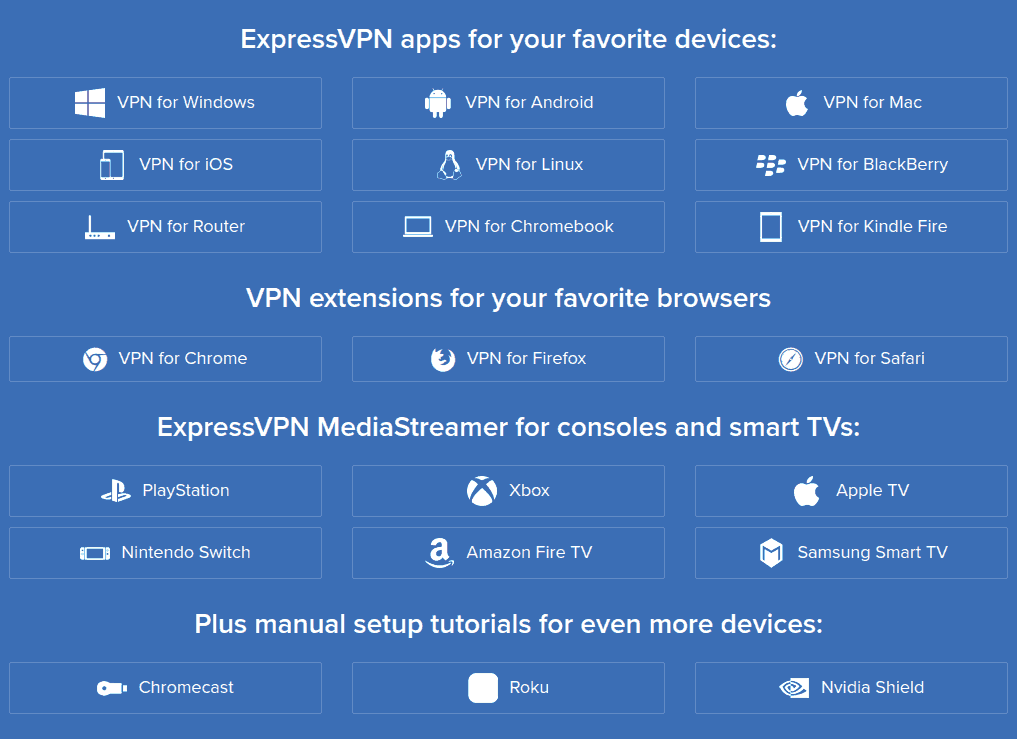
NordVPN
 NordVPN is a quality no-logs VPN service with very attractive pricing on multi-year subscriptions.
NordVPN is a quality no-logs VPN service with very attractive pricing on multi-year subscriptions.
Based in Panama, they are known for top-notch encryption, strong privacy and security protections, and a generous connection policy.
NordVPN supports the Windows, Mac, and Linux desktop operating systems, along with the Android and iOS mobile operating systems.
They also have browser extensions for Chrome and Firefox. Beyond this, NordVPN can run on Android TV, many different routers and other devices, including Raspberry Pi.
NordVPN also provide access to a huge number of streaming services, which includes Netflix, Amazon Prime, BBC iPlayer, and more.
If you have many devices on many different operating systems then NordVPN has you covered.
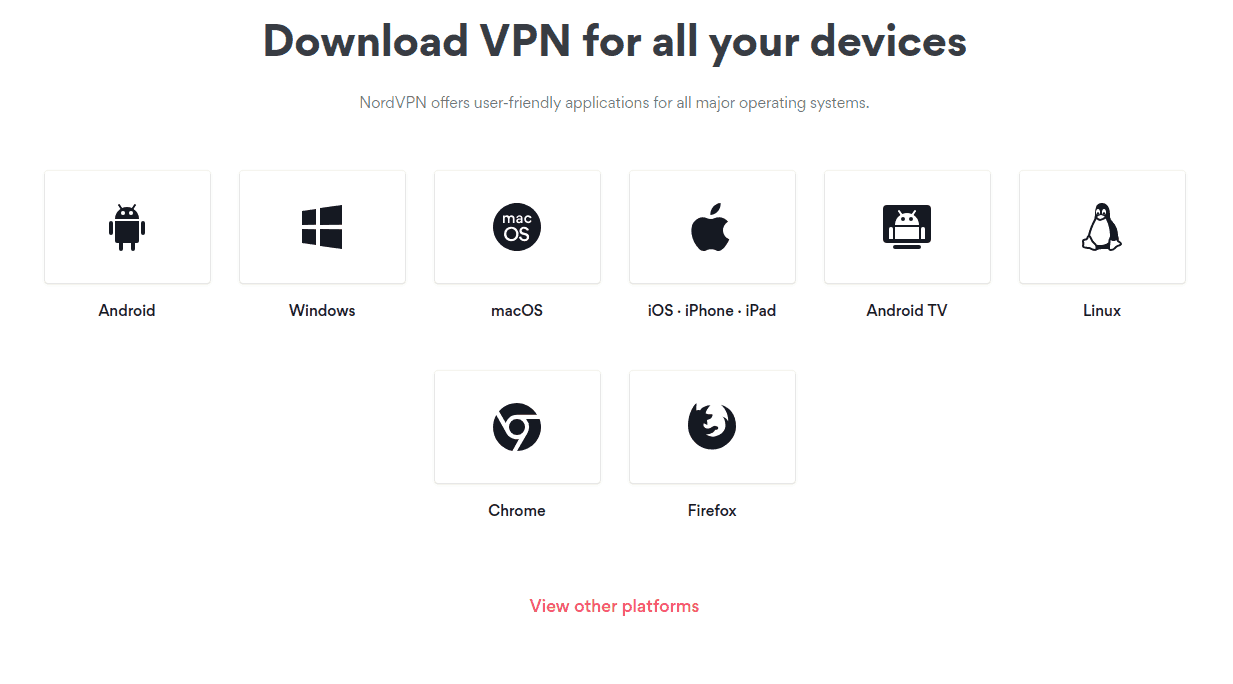
How We Compared Them
We compared these two great services using the following criteria:
- Speed – Which one is the fastest head to head?
- Security and Privacy – One of our top criteria: do they keep logs? is there any DNS leaks? And so on.
- Geographic and Legal Considerations – Another very important criteria, are they based in a country which would force them to give up data, or would actively spy on them?
- Global Coverage – Do they have enough servers in different countries and regions?
- Streaming and Torrenting – Do they allow streaming and torrenting, which is a important feature for many users.
- Connections, Price, and Value – How does the price compare vs others in the space
- Customer Support – If something goes wrong, can you expect them to fix it quickly?
Ready? Let’s start.
Speed

Testing the speed of a VPN is difficult. There are so many variables to take into account. Some factors that can affect the results include:
- The location of the computer doing the testing
- The location of the VPN server (or servers) being tested
- The time of day
- The type of data used in the test
Happily, in 2018 AV-TEST GmbH published its VPN Comparative Test report. This report was commissioned by AnchorFree, the publisher of HotSpot Shield Elite. For this test, they compared 12 VPNs, including both NordVPN and ExpressVPN.
In these tests, both NordVPN and ExpressVPN scored well for latency and download speed. NordVPN also did well on upload speed, with ExpressVPN several percent behind. See page 10 of the report for the full performance breakdown.
While neither of these VPNs are the fastest in the world, they are both better than average performers that should be adequate for any use.
Update June 2020 – With the release of NordLYNX we can finally say that NordVPN is the fastest VPN around. They have managed to hack Wireguard to make it perform at amazing speeds that are faster than OpenVPN. At the same time they have also managed to do it while getting around privacy issues associated with using Wireguard. Well done NordVPN, very impressive.
Security and Privacy

How well they protect your security and privacy are two of the key things to look for in a VPN. Let’s look at how these two products stack up.
Security and Privacy Technology
Both of these products offer high-end encryption technology and the industry-standard OpenVPN protocol. They both protect against IP and DNS leaks.
Recently NordVPN made some big advances in both speed and security by releasing NordLynx which is built using wireguard and NordVPN’s own NAT (Network Address Translation) system. Basically this means that it is even faster than before, but with all the same security and privacy features we have come to expect. According to Nordvpn, it is the fastest VPN protocol they have ever used.
While ExpressVPN is secure against WebRTC leaks, NordVPN did sometimes leak during the 2018 AV-TEST testing program. Based on this blog post, NordVPN seems to have the WebRTC leak issue under control now.
ExpressVPN does have a big advantage over NordVPN when it comes to Kill Switch technology. Network Lock is ExpressVPN’s Kill Switch. When triggered by a problem with the connection to the VPN network, Network Lock blocks prevent any traffic from entering or leaving your device.
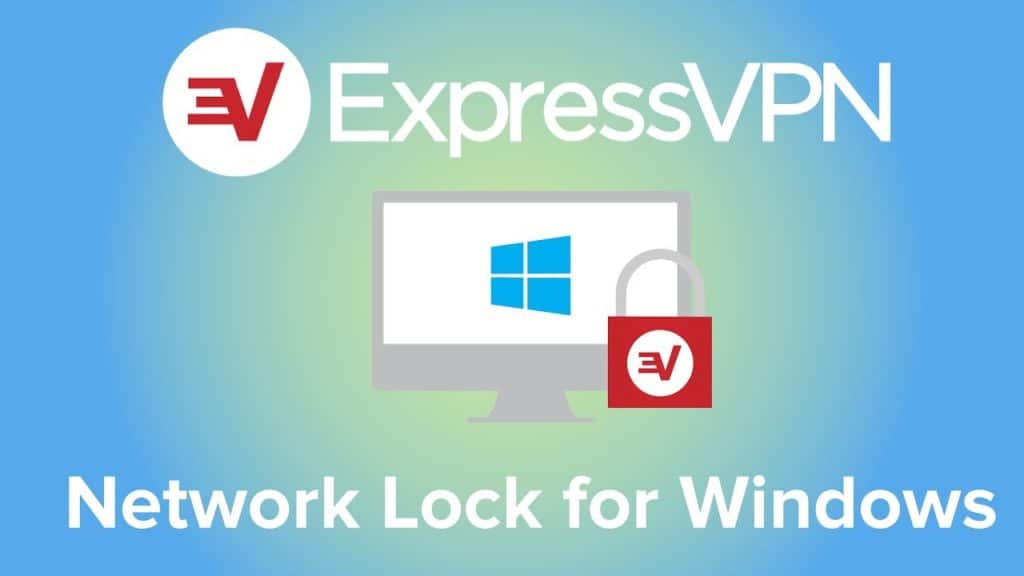
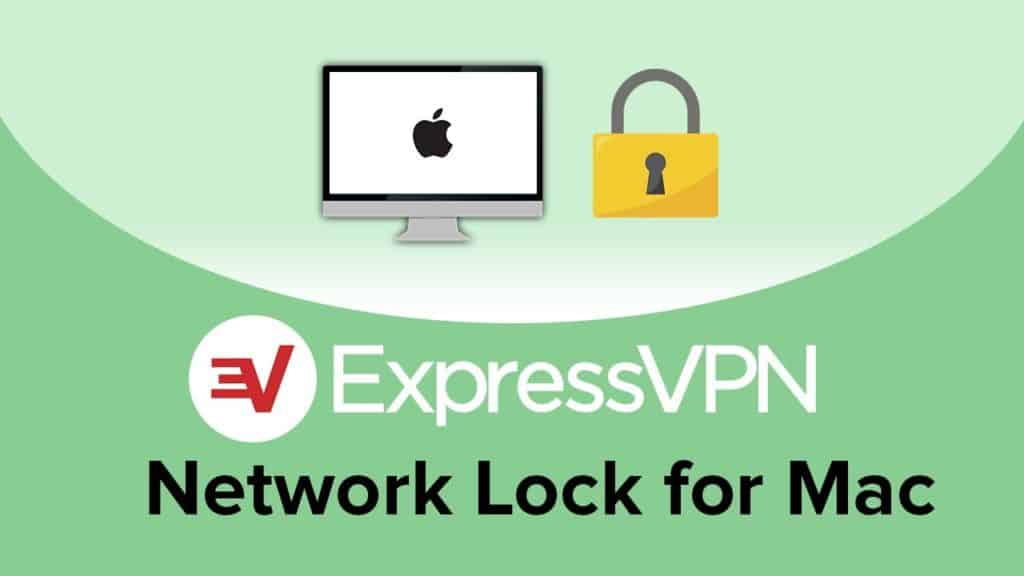
Network Lock is enabled automatically when you launch the VPN client. By automatically blocking all traffic to and from your device, ExpressVPN prevents your real IP Address from being exposed.
NordVPN Kill Switch technology doesn’t protect your privacy, as well as Network Lock, does. Instead of blocking all message traffic, NordVPN shuts down applications you specify when the VPN connection is lost.
The NordVPN team recognizes the limitations of this approach and are working on a solution that will shut down all communication automatically.
ExpressVPN is definitely ahead in this area for now.
Privacy Policies & Confirmation of No-Logs Status
Both of these services have solid “no-logs” policies. There is some controversy over the use of the term “no-logs” because all VPNs have to keep some logs to function properly.
Perhaps the best thing to do is to treat, “no-logs” as short for, “no connection or activity logs that could be used to connect a specific user to specific activities.”
Using this definition, both ExpressVPN and NordVPN are confirmed as no-logs VPNs.
This was shown for ExpressVPN in 2017 when the Turkish government tried to get user data from them.

After the company refused to cooperate with Turkish authorities because it felt the Turks had no jurisdiction over them, the Turkish police raided the data center and seized the server.
Even with the server in hand, the authorities were unable to get any useful information since ExpressVPN doesn’t log that information.
NordVPN took a more proactive approach to confirm its no-logs status. In 2018, they engaged PriceWaterhouseCoopers AG to audit their claim.
According to this post in the NordVPN blog:

While we do not have access to the results of the audit, we have not seen anything that contradicts NordVPN’s claim of providing a no-logs VPN service.
NordVPN passed a second audit in June 2020, again commissioned by third-party assurance firm PwC Switzerland, which confirmed a second time that NordVPN never kept user information on file.
Call this one a tie, with both services ranking near the top among all VPNs when it comes to protecting your privacy.
Geographic and Legal Considerations

While we seldom think about real-world geography when doing things online, geographic considerations are important when it comes to your VPN. There are several reasons why this is so. They include:
- Legal Jurisdiction:

Where a VPN service is located determines whose laws they are governed by. ExpressVPN is located in the British Virgin Islands (BVI), while NordVPN is located in Panama.
Neither of these countries imposes any mandatory data retention policies on VPN services.
However, because the BVI is part of the British Commonwealth, there is some small chance they could be pressured into applying England’s policies. Those policies are not privacy-friendly at all.
In the meantime, Panama is a privacy-friendly jurisdiction but imposed an extremely strict copyright law in 2012. This law can result in huge (as in $100,000 US dollars huge) fines for downloading copyrighted material. In theory, the government could someday pressure NordVPN to log user activity in an attempt to collect more fines from their citizens.
A good way to reduce the risk that you will be affected by jurisdictional issues is to never use a VPN based in your home country. The odds of a country going after a non-citizen for violating local laws are far smaller than for a citizen.
Neither of these services is legally located on United States territory, which provides a little protection against US government snooping. But it is probably best not to use a VPN server that is physically located on US territory since that makes the data on that server subject to US surveillance laws.
- Physical Distance:

When you use VPN signals travel back and forth between your computer and the particular VPN server you are using.
The further apart these are physically, the longer it takes to pass information back and forth. Using a VPN with servers located physically close to you allows you to minimize this delay.
Each of these services has thousands of servers distributed across dozens of countries around the world.
You should be able to connect to a VPN server close to you or to the website or other resources you want to view, thereby minimizing the impact of this factor.
- Censorship and Surveillance:

In some countries the government censors news and information that it doesn’t want the local populace to see.
In other countries, you may not be prevented from viewing certain content, but the police and intelligence agencies watch everything you do.
No good can possibly come of the government recording your actions for future use.
To minimize the risks of this, it is best to avoid using a VPN service that is based in your home country.
Call this one a tie as well.
Global Coverage
In general, you want your VPN service to have as many servers as possible, located in as many different countries as possible. This gives you the most options for access to content that might be geo-blocked.
Results are mixed on this one. While these numbers fluctuate, ExpressVPN has servers in far more countries, but NordVPN has far more servers overall.
| Number of Countries | Number of Servers | |
| ExpressVPN | 94 | 3,000+ |
| NordVPN | 60 | 5,200+ |
Further complicating things, both services provide multiple server locations within specific countries.
For example, NordVPN has over 1,800 servers in the USA, spread across 20 locations.

ExpressVPN has its USA servers spread across 32 locations.
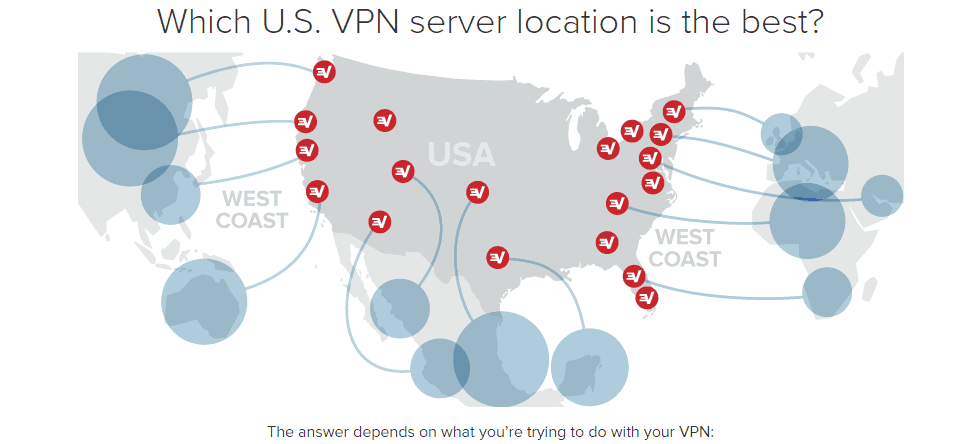
To add yet another layer of confusion to what once seemed simple, not all servers are the same. Both services offer general-purpose servers.
But they also offer servers that are optimized for specific protocols, for torrenting (P2P), for people who need a dedicated IP Address, and so on. Users can choose an IP from a wide selection of countries, meaning they can access geo-locked services such as streaming, gaming, or using a Bitcoin casino.
What’s the final call?
If you are a general VPN user, both of these services provide thousands of servers spread across the countries you are most likely to be interested in.
If you have specialized VPN needs you will need to contact the support team at each company. Alternately, you can investigate their server locations and capabilities yourself.
- To see what servers ExpressVPN has to offer, start here.
- To see what NordVPN has to offer, start here.
Streaming and Torrenting
The first thing that people look for when talking about streaming and torrenting is the speed of the VPN.
Both ExpressVPN and NordVPN are generally fast enough for this, in that they both provide fast connections, with no bandwidth limits or throttling. They are both frequently referenced as the best VPN for torrenting.

According to the 2018 AV-TEST GmbH report, both were far faster for torrenting than most VPNs tested, with NordVPN just slightly the faster of the two (see page 13 of the report).
NordVPN was also faster when it came to streaming, although the difference in speed was only about 1% (page 12).
But things can quickly get complicated. How you connect to the source of the content you want to download is one factor.
If you connect using a VPN server that is physically further from the source than you are, it can slow things down. If you use one of your VPN’s servers that are optimized for streaming, it can speed things up (relative to an unoptimized server).

In some rare cases, using one of these VPNs may even speed up your connection when streaming. Sometimes ISPs will throttle your connection to streaming services to reduce the load on their network, or even completely block certain sites due to local laws.
In these cases, the encryption provided by the VPN may let you avoid this throttling and deliver higher downloads speeds than otherwise.
Speed Isn’t Everything
While speed is important for streaming and torrenting, it is not the only consideration.
When torrenting in particular, you want to be sure that your VPN will never expose your real IP Address. Both of these VPNs have you covered here. With their automatic kill switches and IP leak protection, a glitch might kill your download, but it won’t expose your identity.
Both NordVPN and ExpressVPN have proven over time that they can unblock Netflix. Netflix goes to great lengths to try to force you to use the Netflix library assigned to your physical location.

In other words, if Netflix thinks you are in the UK for example, it will try to force you to use Netflix UK, and block you from using logging into your Netflix US account.
While this kind of blocking may serve Netflix’s contractual obligations to their content providers, it only makes your life more difficult.
You may have a paid subscription to Netflix US, but if they think you are in the UK right now, they are going to try to force you to watch only Netflix UK. And pay for that too!

In their ongoing war with Netflix, both of our contenders have generally done a good job of getting past the blocks Netflix tries to impose.
If you log into a server located in the USA (continuing our example from a moment ago), both of our VPN services do some techno trickery to convince Netflix that you are in the USA, so you can log into the account you pay for.
In other words, while we can’t give you hard numbers or 100% guarantees, we believe you will find both of these VPN services to be fast enough for streaming or torrenting, good enough at getting past blocks to give you the access you want, and secure enough to protect your identity while doing so.

Connections, Price, and Value
While all the technical details we’ve looked at are important, they aren’t the only things to consider when choosing a VPN.
Let’s look at three more characteristics that could help you choose between ExpressVPN or NordVPN.
Connections
These days, most of us have several devices that we want to protect with a VPN. At a minimum, a computer and a smartphone. Or maybe two computers. And what about the rest of the family? It is easy to see how the need for connections can multiply.

VPN services normally place a limit on the number of simultaneous connections they allow. You can have the VPN client installed on any number of devices. But only a certain number of them are allowed to connect to the VPN at any one time.
- ExpressVPN gives you five (5) simultaneous connections.
- NordVPN gives you six (6) simultaneous connections.
Assuming you have a need for more than 5 simultaneous connections, NordVPN offers one more so that might work better for you.
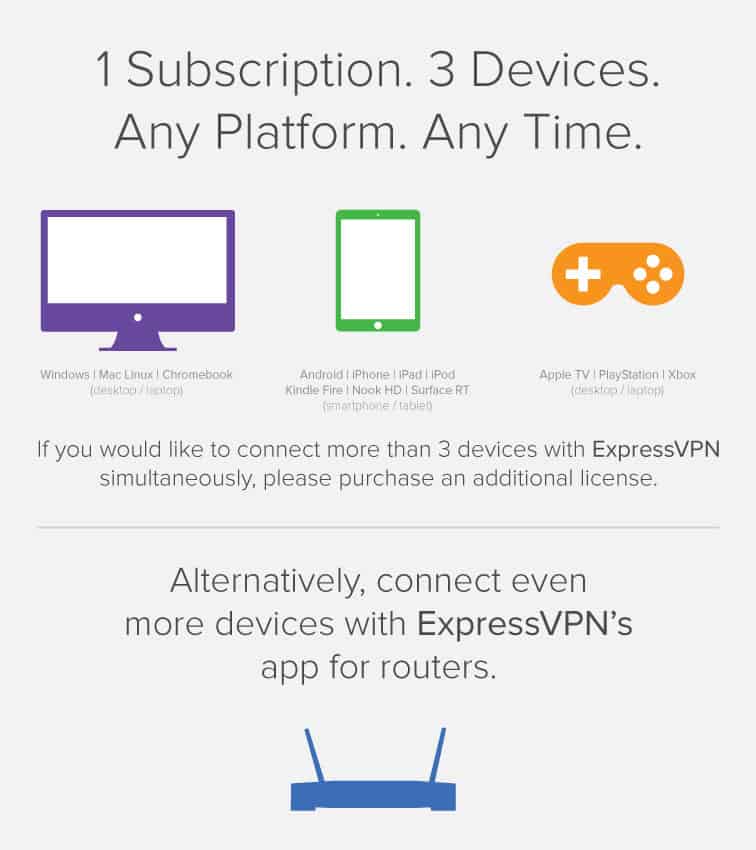
What about running the VPN on your router?
But what if you need more than 5 simultaneous connections and you prefer ExpressVPN? Or what if you need more than 6 simultaneous connections?
If your router runs the VPN software, then every device connected to the router will automatically be connected.
Both NordVPN and ExpressVPN have apps that can be installed on routers. Not all models of routers are supported by either company and setting this up is more complicated than installing the VPN app on your computer or phone.
If you want to explore this further, follow these links:
Unless you are willing and able to install VPN software on your router, give NordVPN the win for this feature.
Price
Price is another area where NordVPN tends to lead ExpressVPN. Here are their prices as of 2023:
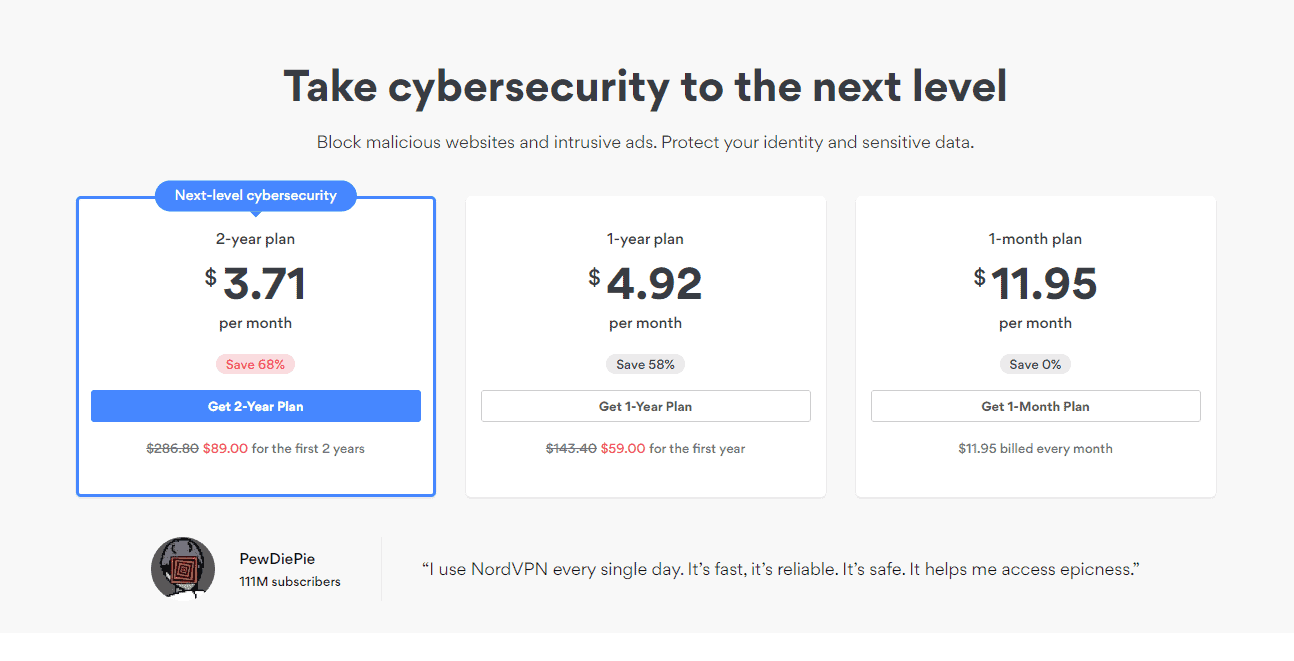
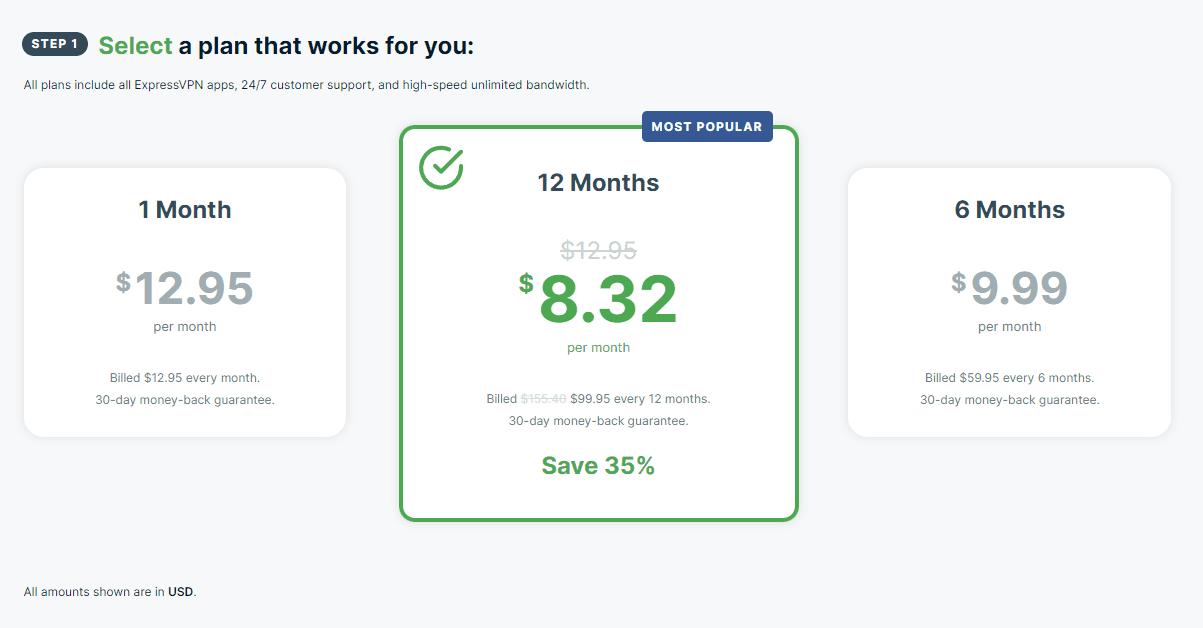
As you can see, while their pricing models don’t match exactly, for 1-year and longer plans, NordVPN is significantly less expensive than ExpressVPN. It might seem risky to sign up for NordVPN’s multi-year plans to get the lowest price, but try running the numbers.
NordVPN is definitely the less expensive option.
Interestingly, in March 2023, NordVPN made its Meshnet private tunnel feature available for free to all users, regardless of whether or not they have a subscription. It initially launched Meshnet as a paid feature in June 2022. It allows users to establish secure, encrypted tunnels between trusted devices for network traffic, essentially allowing them to create their own VPN (virtual private network) servers.
Value
We can’t give you a definitive answer for this one. With a lower price and double the number of connections, NordVPN looks like the better value. But that assumes that all other factors are equal.
As we’ve seen throughout this article, while these services are similar, they each have unique characteristics that may make one or the other more suitable for your particular situation. You’ll need to do that evaluation yourself.
What we can say is that both of these are quality VPN services, and for typical usage patterns (browsing the web, streaming content) both offer good value.
If you are on a budget, or you want a cost effective and cheap way to cover the entire family’s devices, then NordVPN is a clear winner on price, costing just a fraction of ExpressVPN over a longer subscription period.
Customer Support

While you hope to never need it, the odds are good that at some point you will need to contact customer support. When you do, you’ll be glad to know that both NordVPN and ExpressVPN offer a full range of support options. But which is best out of ExpressVPN vs NordVPN?
We’re talking about 24/7 support with:
- Live Chat
- Knowledge Base
- FAQ
NordVPN also have a special email address for business users, so if you need a VPN to cover a whole office or your business computing infrastructure, you can get put through to a specialist team straight away. This service is called ‘NordVPN Teams‘, and it offers a number of cost effective ways to cover your work communications.
While we haven’t used either service’s Customer Support very much, both teams have a good reputation. We would rank them both to be better than practically any other VPN support team.
ExpressVPN vs NordVPN – Which Should You Choose?
There isn’t a clear-cut winner here. As we’ve seen, there are only a few areas where one of these services is clearly better than the other. So what we’ve done here is put together two tables.
One idea would be to use the NordVPN VPN Speed Comparison Tool, which is currently hosted on Github, to check which VPN works the fastest for you. The tool is available free of charge to the public and offers reports which include the median download speed results, the arithmetic mean, median winner, and more.
One summarizes the case for choosing ExpressVPN over NordVPN and the other summarizes the case for choosing NordVPN over ExpressVPN.
The Case For and Against ExpressVPN vs NordVPN
| For | Against |
| Premium reputation | Premium price |
| Better Kill Switch than NordVPN | Thousands of fewer servers than NordVPN |
| No WebRTC leaks | Based in BVI, part of the British Commonwealth |
| Servers in more countries than NordVPN | Five (5) connections per subscription |
| Turkish court case confirmed No-Logs VPN claim |
That’s the case for and against ExpressVPN. Now let’s flip things around and look at the case for and against NordVPN.
The Case For and Against NordVPN over ExpressVPN
| For | Against |
| Outside auditor confirmed No-Logs VPN claim | Kill Switch needs to be updated |
| Low price than ExpressVPN | Servers in fewer countries than ExpressVPN |
| Thousands of more servers than ExpressVPN | Reported WebRTC leaks (fix being developed) |
| Six (6) connections per subscription |
You now have all the information you need to choose between the two services.
If you are still not sure, remember that both offer 30-day money-back guarantees. Install the one that looks best to you and try it out for a few weeks. If you are happy with your choice, perfect.
If you are not happy with your initial choice, grab the refund and install the other VPN. Since these are both quality products, one or the other of them will almost certainly satisfy you.
References
- Using uTorrent with ExpressVPN
- Why NordVPN is the best VPN for streaming
- ExpressVPN customer support
- NordVPN customer support
- ExpressVPN pricing
- NordVPN pricing
- How to watch Netflix with ExpressVPN
- How to watch Netflix with NordVPN
- How to use uTorrent with ExpressVPN
- uTorrent proxy setup on NordVPN
- ExpressVPN server locations
- NordVPN server locations
ExpressVPN vs NordVPN was originally found on Blokt - Privacy, Tech, Bitcoin, Blockchain & Cryptocurrency.
]]>
While AI is being touted as the latest hype in Silicon Valley, replacing crypto, it’s worth acknowledging that the hype surrounding crypto has likely just faded because its prices have declined steeply over the last 15 months. This is nothing new, as crypto prices have fluctuated heavily since their creation over 13 years ago, with […]
AI and Crypto: Examining the Hype and Recent Price Trends was originally found on Blokt - Privacy, Tech, Bitcoin, Blockchain & Cryptocurrency.
]]>
While AI is being touted as the latest hype in Silicon Valley, replacing crypto, it’s worth acknowledging that the hype surrounding crypto has likely just faded because its prices have declined steeply over the last 15 months.
This is nothing new, as crypto prices have fluctuated heavily since their creation over 13 years ago, with periods of intense hype during the bull markets and a lot of “FUD” during the bear markets.
However, what makes AI impressive is its immediate usefulness and rapid adoption. As a result, people are increasingly incorporating AI into their daily lives to aid them in their work and other activities.
In contrast, while tens of millions of people own crypto, it has yet to experience widespread adoption for daily use in things like payments and smart contracts. Instead, crypto is still most commonly used for speculation and investing.
But how could AI impact crypto itself, and what are the top names in crypto utilizing AI? This article explores just that and will show how AI-based cryptocurrencies are leading the pack in the most recent crypto price rally.
A Look at the Top AI Cryptocurrencies
According to sites like CoinMarketCap and CryptoSlate, some leading AI cryptocurrencies (by market cap) include The Graph, SingularityNET, Fetch.ai, Ocean Protocol, and Numeraire. Here’s how each of these uses artificial intelligence.
Numerai (NMR)
Numerai is a hedge fund that uses machine learning to try and predict the stock market as accurately as possible. It hosts machine-learning tournaments and incentivizes top data scientists to participate by rewarding those with the most accurate models with Numeraire (NMR) tokens. To date, Numerai has paid out $53 million in NMR to data scientists.
The Graph (GRT)
The Graph Network is a decentralized indexing protocol that utilizes AI to simplify searching and retrieving data from blockchain networks like Ethereum. The protocol allows developers to quickly and easily query specific data without needing a centralized entity. Open APIs on The Graph, known as subgraphs, can be built and published by anyone, allowing easy data access. Given how AI plays a central role in web2 applications like Google search, the convergence of AI and web3 is also critical.
SingularityNET (AGIX)
SingularityNET is trying to usher us into the era of decentralized AI. As a leading AI marketplace powered by blockchain, its core mission is to develop beneficial artificial general intelligence (AGI). With SingularityNET, AI-driven solutions will, someday, facilitate the formation of open-sourced, decentralized human-level intelligence that serves the common good. Using blockchain, they hope to create an equitable global network where value, power, and technology are equally distributed.
Fetch.ai (FET)
Fetch.ai is paving the way for a decentralized future by using machine learning and blockchain technologies to facilitate an alternative to the currently restrictive, centralized data silos. Their mission is to allow anyone to create and deploy AI services at scale, potentially transforming multiple industries. Recently, Bosch partnered with Fetch.ai and agreed to allocate funds to a $100 million grant program intended to develop Web3, AI, and decentralized technologies for real-world use cases.
Ocean Protocol (OCEAN)
Ocean Protocol aims to address a critical issue in our data-driven society. This project, governed by a Singapore-based non-profit foundation, seeks to distribute the immense value data creates equitably through its platform. Currently, a few large organizations with massive data assets and powerful AI capabilities monopolize the benefits of data, which Ocean believes threatens a free and open society. Instead, Ocean Protocol aims to promote the fair use of data and ensure that it is leveraged for the betterment of all.
What Do Influential Figures in Crypto Think About AI?
Most leaders in the crypto industry have yet to express substantial views on how AI might impact their respective projects. However, with the current buzz surrounding AI and ChatGPT, several influential figures have taken to social media or blogs to air their thoughts. Here’s what some of them had to say:
- Vitalik Buterin: In a recent blog, he shared his experience testing ChatGPT to help him code. Vitalik concluded that AI is improving quickly and is a helpful programming aid, but still far from replacing human programmers.
- Charles Hoskinson: In a tweet, he revealed his use of AI to create art. He remarked, “I can’t imagine how amazing this technology will be in three years.”
- Sandeep Nailwal: The Polygon co-founder called for a DAO version of ChatGPT in a tweet, stating it’s too powerful to be controlled by a single entity.
- Binance: In a recent blog, the company states that ChatGPT could help crypto adoption by providing a conversational educational tool, improving customer support, and even aiding with smart contract coding.
How the Hype Surrounding AI Is Affecting Crypto Prices
While crypto, on the whole, has been rallying from lows for the last month or so, traders have been gambling on AI-related cryptocurrencies outperforming, and they have been doing so. Here’s how the five AI cryptocurrencies we looked at earlier have performed versus Bitcoin since January 2023:
- Bitcoin: +41.00%
- Numeraire: + 58.05%
- The Graph: + 179.98%
- Ocean Protocol: +144.74%
- SingularityNET: +808.17%
- Fetch.ai: +376.85%
However, it’s hard to tell if AI cryptos will continue outperforming or if the hype will fade and prices will retrace.
For example, BuzzFeed (BZFD) rallied 350% on the stock market in two days after reporting that they would use ChatGPT to help them create content. However, prices retraced quickly after, and BZFD is now only up around 70% since making the announcement, and its price could continue lower.
In the crypto space, the gameFi token Cocos-BCX rallied more than 250% in five days after merely mentioning AI in a suggestive tweet:

COCOS + AI = ?
#CocosBCX #COCOS #BNB
— Cocos-BCX (@CocosBCX) February 8, 2023
So far, COCOS-BCX has maintained its rapid gains.
While there will likely be potentially profitable opportunities ahead for investors and traders in AI-related coins, there has also been a notable rise in scams attempting to exploit the AI trend. For example, numerous fraudulent “ChatGPT” coins have been launched recently for pump and dump schemes, similar to the fake “Squid Game” token we saw in 2021.
AI and Crypto: Examining the Hype and Recent Price Trends was originally found on Blokt - Privacy, Tech, Bitcoin, Blockchain & Cryptocurrency.
]]>
Bitcoin’s price has fallen for the eighth week in a row, setting a new record. BTC/USD declined another -3.3% percent last week, and it is down about -35% since this losing streak began eight weeks ago. This is the longest weekly losing streak Bitcoin has ever had since it was created in 2009. The previous […]
Bitcoin Falls for the 8th Week, Setting New Record was originally found on Blokt - Privacy, Tech, Bitcoin, Blockchain & Cryptocurrency.
]]>
Bitcoin’s price has fallen for the eighth week in a row, setting a new record. BTC/USD declined another -3.3% percent last week, and it is down about -35% since this losing streak began eight weeks ago.
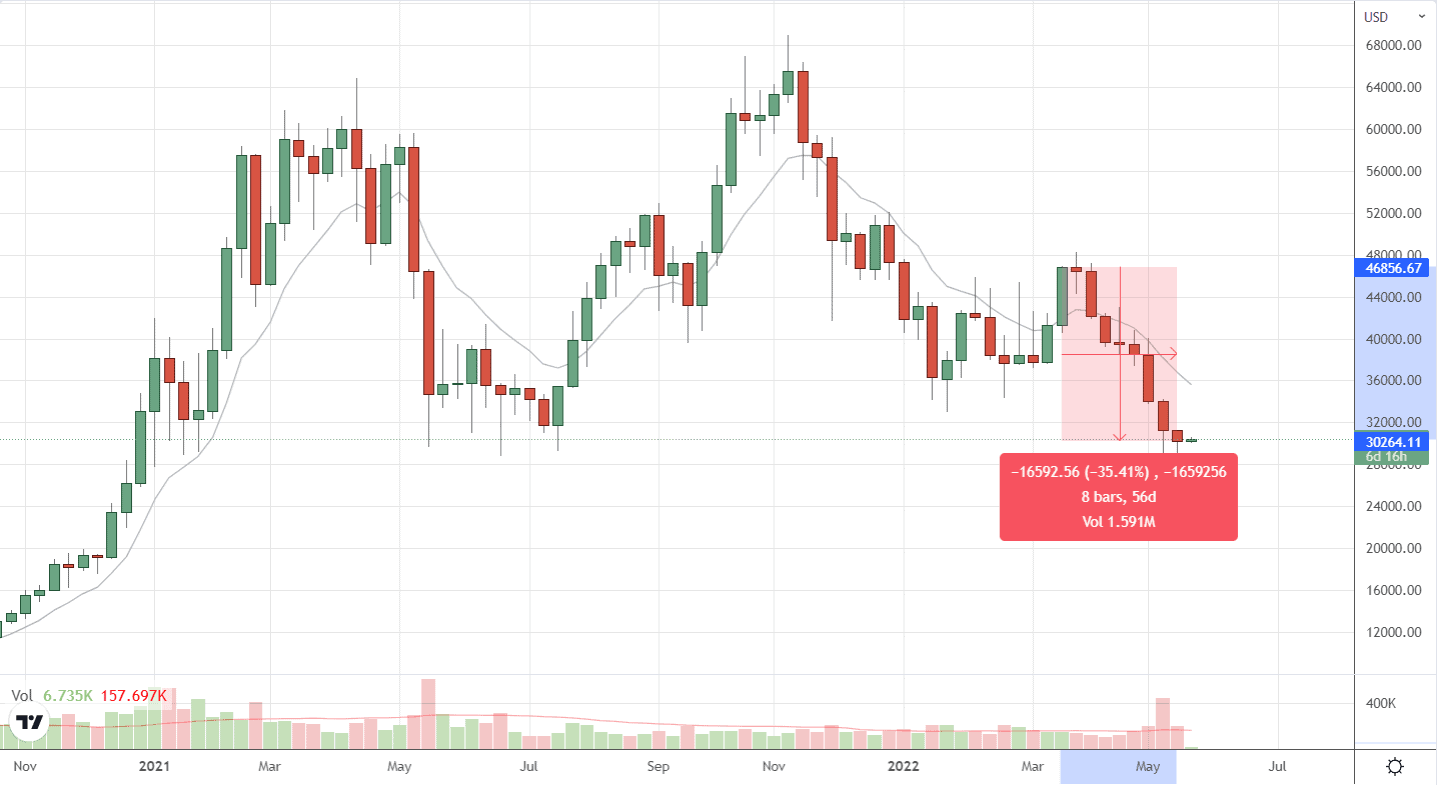
This is the longest weekly losing streak Bitcoin has ever had since it was created in 2009. The previous record was five consecutive weeks, which last happened between 1 December 2014 and 5 January 2015.
However, Bitcoin is not the only cryptocurrency stuck in a rut. In fact, four out of the top five cryptocurrencies by market cap, excluding stablecoins, are having record-setting weekly losing streaks, with BNB being the exception.
- Ethereum: Fell for the 7th consecutive week, setting a new record. ETH has fallen around -42% since this down streak began.
- BNB: Rose last week, finally ending its run of 6 consecutive weekly losses. BNB fell about -30.5% during this losing streak.
- XRP: Fell for the 8th consecutive week, setting a new record. XRP has fallen about -50.8% since this streak began.
- Cardano: Fell for the 7th consecutive week, setting a new record. ADA has fallen about -54.33% since this streak began.
On a positive note, all of these cryptocurrencies finished slightly up yesterday on the daily timeframe, ending the week strong. Holders will be hoping this strength continues into this week and that these down-streaks finally come to an end.
Stock Market Fell for the 7th Straight Week
Cryptocurrencies are not the only asset class having a bad run. The S&P 500 and Nasdaq, two leading stock indexes, have fallen seven weeks in a row, highlighting a correlation between the crypto market and the stock market. This suggests that there is a bearish sentiment in financial markets generally at the moment.
The S&P 500’s fall for the seventh week is the longest losing streak since the dot-com bubble burst over twenty years ago. Moreover, it’s only the fourth time it has had seven or more consecutive weekly losses since 1931.
The S&P 500 dropped 3% this week, its 7th consecutive weekly decline. This is longest weekly down streak since 2001 which fell 8 straight weeks (and is tied w/ 1970 for the record). Here's a look at what happened following the longest down streaks in history…$SPX pic.twitter.com/0I9yuvrEBf
— Charlie Bilello (@charliebilello) May 20, 2022
According to Charlie Bilello, CEO of Compound Capital Advisors, the S&P 500 is having its fourth-worst start to the year ever, as it’s down -18.2% in its first 97 days of trading.
Bilello says the only other years that started worse were 1970 (Vietnam War and US Recession) when it declined by -20.1%, 1940 (World War II) when it declined by -21.4%, and 1932 (Great Depression) when it fell by -32.5%.
Why are These Financial Markets Falling?
Crypto and the US stock market enjoyed a bullish run throughout most of 2020 and 2021. In fact, the fall we’re seeing now is the first major pullback since the covid pandemic crash back in Feb/Mar 2020.
Therefore, you can argue that both crypto and stocks are due a correction, and what we’ve seen recently is just part of a typical bull and bear cycle.
However, some underlying fundamental issues might also be shaking investor confidence. For example, the economy in the US and many other countries look relatively fragile at the moment, with a risk of recessions and high inflation.
Inflation and higher living costs mean many people will have less spare cash to invest or may have to sell some of their existing holdings to cover additional costs. You also have the ongoing Ukraine war with the risk of escalations and the covid-19 pandemic still lingering in the background, causing disruption to many businesses and workers.
In the crypto market specifically, we’ve just seen the collapse of Luna and UST, where both assets lost virtually all of their value. Some industry experts are saying this event is as damaging for crypto as the Mt. Gox scandal.
Bitcoin Falls for the 8th Week, Setting New Record was originally found on Blokt - Privacy, Tech, Bitcoin, Blockchain & Cryptocurrency.
]]>
To help answer these questions, we’ve looked at the last three major pullbacks and corrections in Bitcoin to see how they compare to the current one. We analyze various technical and fundamental factors, such as how severe the corrections were, how long BTC took to recover and make a new all-time high, and the main […]
Bitcoin Bear Market: Almost Over or More Pain Ahead? was originally found on Blokt - Privacy, Tech, Bitcoin, Blockchain & Cryptocurrency.
]]>
To help answer these questions, we’ve looked at the last three major pullbacks and corrections in Bitcoin to see how they compare to the current one.
We analyze various technical and fundamental factors, such as how severe the corrections were, how long BTC took to recover and make a new all-time high, and the main news narratives influencing price action.
Quick Look at the Last 3 Bear Markets & Corrections
Here are the last three major corrections, starting with the oldest up until the most recent.
#1: The 2014-2015 Bear Market
Quick Stats:
- Price Decline: -86.9%
- Bear Market Duration: 413 days (59 weeks)
- Subsequent Bull: +12,800%
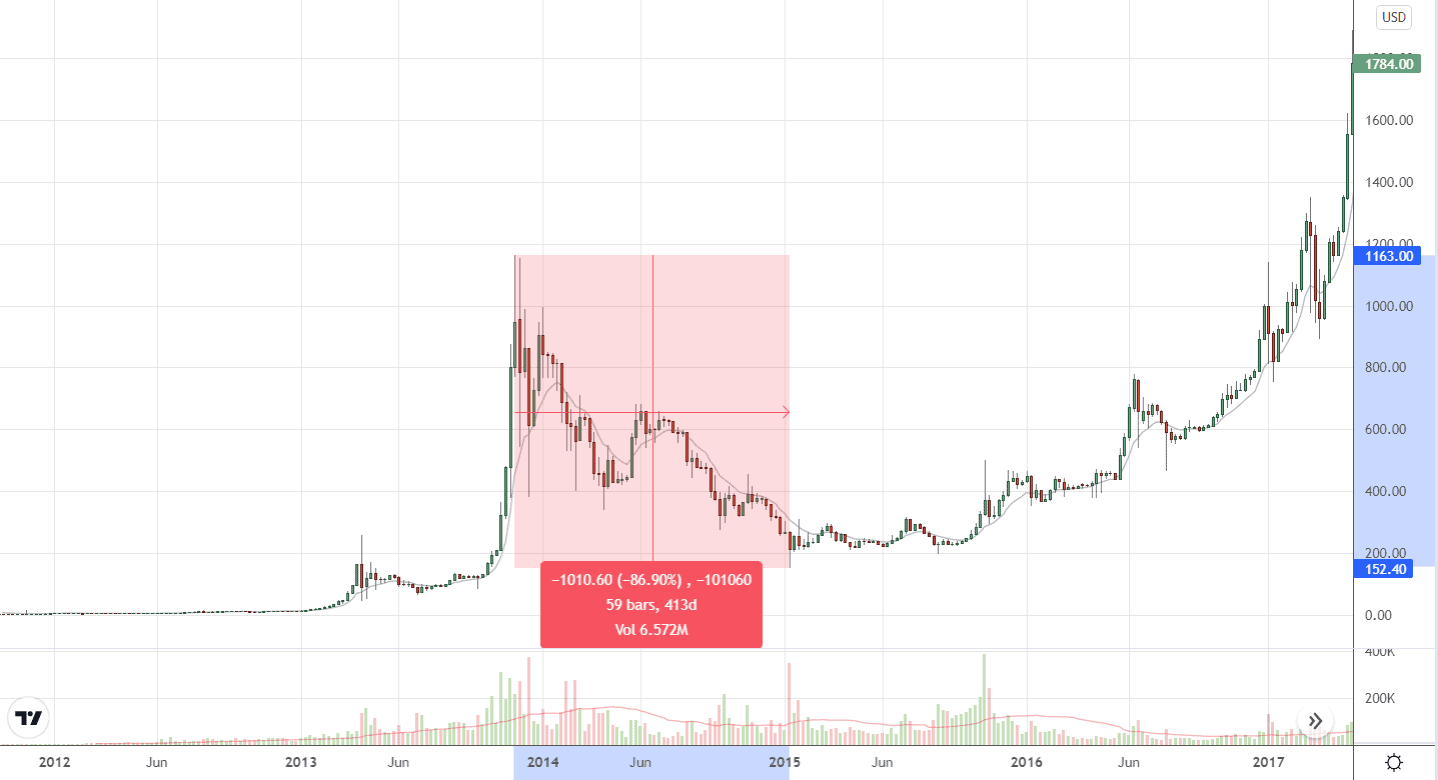
This bear market began as soon as the parabolic 2013-2014 bull market ended. Bitcoin increased 51,000% during this time, so it was due to have a correction.
The 2014-2015 bear market that followed took BTC from its all-time high at $1163 down to $152, a decrease of -86.9%, where it finally ended just over a year after it began. It then took BTC a further two years (771 days) to recover from this low and make a fresh new all-time high above $1163 in Feb 2017.
BTC continued soaring higher from here, continuously making new ATHs until it peaked at around $19,700 in Dec 2017.
#2: The 2018-2019 Bear Market
Quick Stats:
- Price Decline: -84%
- Bear Market Duration: 364 days (52 weeks)
- Subsequent Bull: +2,105%

This bear market was comparable to the previous 2014-2015 bear market, as it declined by a similar percentage and lasted for close to a year. It also came after an explosive bull market that saw BTC make an ATH around $19,700. BTC fell from this ATH to a low of $3122 during the 2018-2019 bear market.
After the 2018-2019 bear market ended, it took BTC 716 days (just under two years) to recover and make a fresh new all-time high above $19,700. Once BTC made a new all-time high, it continued rising until it peaked at $69,000 in Nov 2021, which is where the bearish period we’re in today began.
While the subsequent bull market that came after the 2018-2019 bear market was impressive (a 2,105% rise), there was some turbulence along the way. In Feb and Mar of 2020, global financial markets were spooked by the emergence of the covid pandemic.
#3: The Covid Pandemic Crash in March 2020
Quick Stats:
- Price Decline: -63.34%
- Crash Duration: 29 days (4 weeks)
- Subsequent Bull: +1688.5%

This correction in BTC was different from the previous two bear markets we’ve covered. It did not come after a protracted bull market and was driven primarily by negative news.
Therefore the characteristics of this pullback were also much different. Bitcoin’s price declined by a lesser amount (-63.34%), and the crash lasted only four weeks. BTC was also much quicker to recover this time, rising from the crash lows at $3850 back up to pre-crash levels in around 80 days.
Current 2022 BTC Correction
Quick Stats:
- Price Decline So Far: -63.2%
- Bear Market Duration So Far: 183 days (26 weeks)
- Subsequent Bull: Unknown
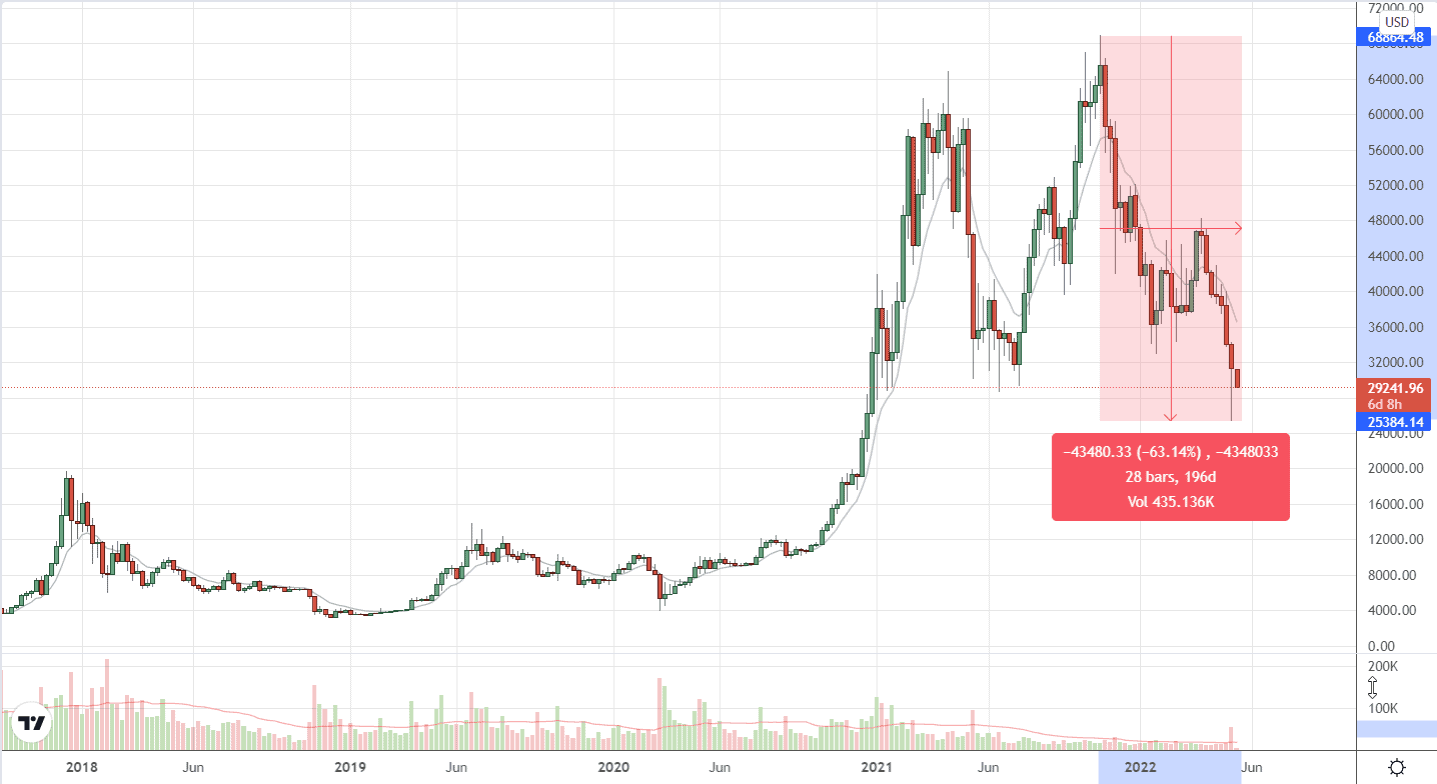
The current 2022 bear market is still in progress, and we don’t exactly know how it will play out. However, BTC’s price has already declined by -63.2% over the last 26 weeks from its ATH at $69,000 in Nov 2021.
What Can We Expect Going Forward?
Well, as BTC has not recovered rapidly like during the covid pandemic crash, we look set for a longer-term move down or sideways here. Also, this theory is supported further by the fact that this bear market has come after a strong bull market in 2020-2021 which saw BTC increase by 2,105%.
Based on the previous two bear markets we’ve looked at, it seems we could only be about halfway through this bearish phase. Also, considering BTC’s price has only dropped -63.2% from its ATH, there is room for a further decrease to get us down around -80% from the ATH, in line with previous bear markets.
Of course, these are only estimates based on previous BTC bear markets, and this time it could go down much less or more than it did previously.
Is Now a Good Time to Invest in BTC?
It’s impossible to say whether now is a good time to invest or not. However, if BTC were to decline 70-80% from its ATH, which would take its price down to $13,700-$20,000, the odds of making a profit on your investment if you were to buy Bitcoin at this point would be in your favor based on previous bear markets. That’s not to say it’s a good idea to short Bitcoin; the market is too unpredictable to say what will happen with any certainty.
How Long Till BTC Makes a New ATH Again?
There is no guarantee that Bitcoin will make a new all-time high again in the future. However, if it does, it wouldn’t be unusual if it takes a couple of years from now based on the previous bear markets we looked at.
What Else Could Affect the Price?
Other factors may also come into play aside from the fact that Bitcoin may just be in a bearish phase, which is a normal part of the cycle in any financial market.
As was seen during the covid pandemic crash, significant macro events can also affect how BTC’s price behaves. Right now, here are some of the main news narratives circulating:
- The collapse of UST and Luna undermining confidence in crypto
- The Ukraine war and the risk of it spilling over to other nations
- The covid pandemic and the risk of new variants and further disruption
- The risk of recession in the US and other nations
- Inflation and higher costs of living
- A stock market crash could create fear in the crypto market
An escalation of any of these events could create more fear in the crypto market, leading to more severe price declines and volatility. Likewise, if any of these problems improve, are resolved, or are averted, this could increase optimism and help stabilize the market.
Final Thoughts
At the end of the day, Bitcoin has bull and bear markets just like any other publicly traded financial asset. This probably won’t be the last bear market, and fortunately, there should be plenty more bull markets to come too.
While bear markets can be extremely frustrating and painful for those already invested and holding throughout, they can also provide excellent opportunities for those who want to invest fresh new capital. If you choose to invest at this point, be sure to use one of the trusted crypto exchanges.
Bitcoin Bear Market: Almost Over or More Pain Ahead? was originally found on Blokt - Privacy, Tech, Bitcoin, Blockchain & Cryptocurrency.
]]>
Since Facebook announced Meta in October of last year, the world became Metaverse-crazy. Meta Quest store sales have quadrupled in the last three years with the Quest 2 becoming a roaring success, with 8.7 million units sold in 2021. Within the NFT space, Metaverse projects have picked up steam, with many businesses taking a Metaverse-centric […]
NFT Collectors Can Now Frame Their Art in the Metaverse was originally found on Blokt - Privacy, Tech, Bitcoin, Blockchain & Cryptocurrency.
]]>
Since Facebook announced Meta in October of last year, the world became Metaverse-crazy. Meta Quest store sales have quadrupled in the last three years with the Quest 2 becoming a roaring success, with 8.7 million units sold in 2021.
Within the NFT space, Metaverse projects have picked up steam, with many businesses taking a Metaverse-centric priority for recent launches. Yuga Labs, the company behind the Bored Ape Yacht Club NFT franchise is set to be launching a Metaverse land sale named Otherside as soon as this month. Otherside is likely to be a multiplayer RPG within an “interoperable world.”, including all of the firm’s NFT franchises.
In the fashion industry, after acquiring RTFKT Studies in December, Nike Inc. has been hard at work in the Metaverse space. Nike and RTFKT have revealed their first metaverse NFT wearables, which are digital metaverse sneakers named CryptoKicks. These digital shoes are designed specifically to be used within Metaverse worlds.
RTFKT, together with Nike CryptoKicks, introduce the future of Sneakers, powered by Skin Vial tech
Welcome to 2052 :
pic.twitter.com/7449L79Bf4
— RTFKT Studios (@RTFKTstudios) April 22, 2022
Oncyber is a digital world for creators, where artists and collectors can show off their NFTs in the Metaverse. Punk 6529, a famous NFT collector and thought-leader with a huge following, is building an “Open Metaverse” on Oncyber. The 6529 Museum District is the alpha version of the district of Open Metaverse.

This move to a fully open 3D Metaverse where users can display their art and other NFTs is a contrast to the previously 2D NFT space. This is where projects such as Oncyber shine, allowing users to experience 2D assets in a 3D space. Another promising project which allows its users to bring their digital assets into a 3D space is Frahm, a project which explores the art of framing within the Metaverse.
Frahm is building a platform around digital frames tokenized as NFTs. Establishing and pioneering a new segment in the NFT market. With that the startups is democratizing the frame creation process, creating a new economy and marketplace around digital frames in the Metaverse.
Frames will be an integral part of bridging the NFT art world with the Metaverse and Frahm users can frame their NFTs for free using the Frahm framing application. After connecting their wallet, users select a frame and NFT that they’d like to combine and then the Frahm software outputs a fully 3D framed NFT for them to experience within their web browser. This 3D framed art can then be utilized within 3D Metaverse worlds.
Frahm is launching its Genesis Drop starting 28th April 2022, and the frames in this drop are the output of a generative art algorithm. Some demos of the Frahm Genesis frames can be viewed in the Oncyber gallery.
With the coming of the Metaverse, there will be a huge opportunity for businesses to stake their claim in these digital worlds. From gaming to fashion to framing, 2022 is set to be a huge year for the Metaverse.
NFT Collectors Can Now Frame Their Art in the Metaverse was originally found on Blokt - Privacy, Tech, Bitcoin, Blockchain & Cryptocurrency.
]]>
Virtual Private Networks offer exceptional levels of security and privacy to browse the internet anonymously. Using an encrypted internet connection from your computer to a network ensures the confidentiality of any sensitive data transmitted over the internet. In addition, it keeps unauthorized people from spying on your internet traffic and allows you to work remotely. There […]
ExpressVPN vs Private Internet Access (PIA) was originally found on Blokt - Privacy, Tech, Bitcoin, Blockchain & Cryptocurrency.
]]>
Virtual Private Networks offer exceptional levels of security and privacy to browse the internet anonymously. Using an encrypted internet connection from your computer to a network ensures the confidentiality of any sensitive data transmitted over the internet. In addition, it keeps unauthorized people from spying on your internet traffic and allows you to work remotely.
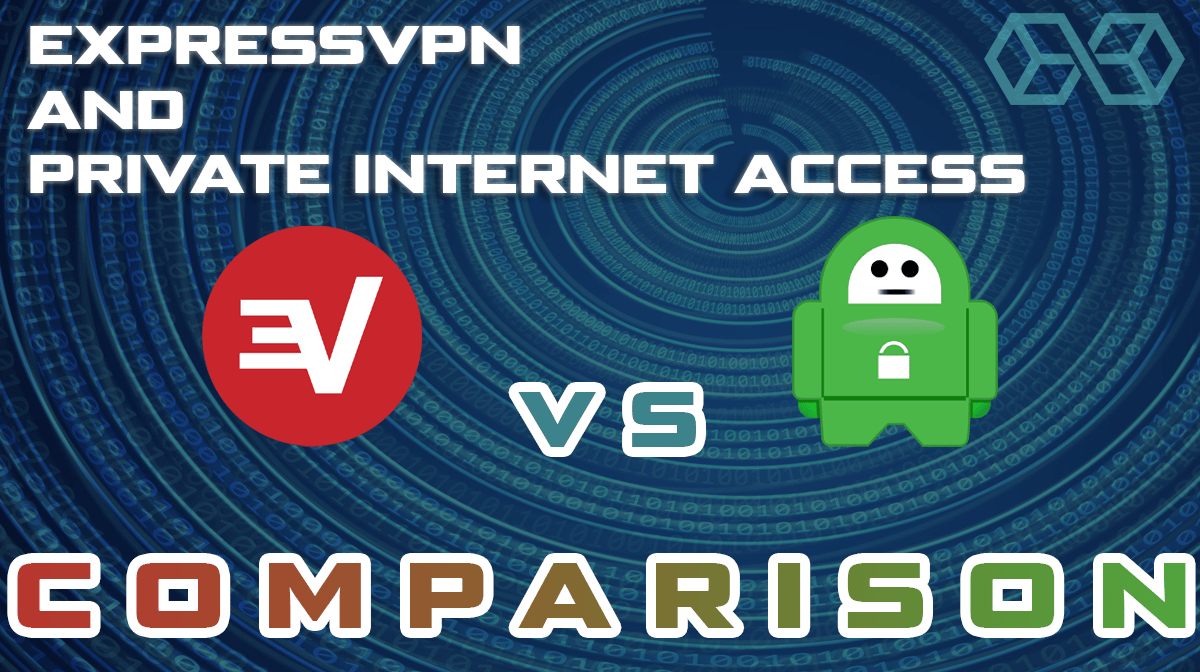
There are many popular VPN providers available today. This review discusses two phenomenally popular VPN services: Private Internet Access, otherwise known as PIA, and ExpressVPN. We’ll compare their features and focus on categories such as privacy, security, pricing, performance, and more.
Private Internet Access Features vs. ExpressVPN Features
Two of the most popular VPN providers available today are Private Internet Access (PIA) and Express VPN. But, first, let’s look at some of their features and see how they compare to each other.
Private Internet Access (PIA)
PIA offers a lot of features essential to your internet security. However, unlike ExpressVPN, PIA chose the United States as its base. This location may be considered harmful in terms of data retention laws.
While the US doesn’t have a mandatory law on data retention, it shouldn’t be surprising to find out that the government can obtain access to any stored data under the SCA or Stored Communications Act. PIA is smart, however, and doesn’t keep user logs.

This VPN also provides vital features for anonymity, such as DNS protection and a Kill Switch. PIA also ensures a better browsing experience by supplying protection from malware and ads. We all know how annoying ads are and how dangerous malware is, so these are great features to have. PIA offers OpenVPN, which many consider the securest protocol of all.
Private Internet Access also gives you the option to choose your preferred level of encryption. In addition, it includes port forwarding, a common technique that redirects computer signals between the internet and LAN computers.
PIA has apps for Android, macOS, Windows, Linux, and iOS. It provides cost-efficient high performance.
Pros of PIA Features
- DNS Leak Protection
- Kill Switch
- Port Forwarding
- Options to Choose Encryption Level
- Protection against trackers, malware, ads
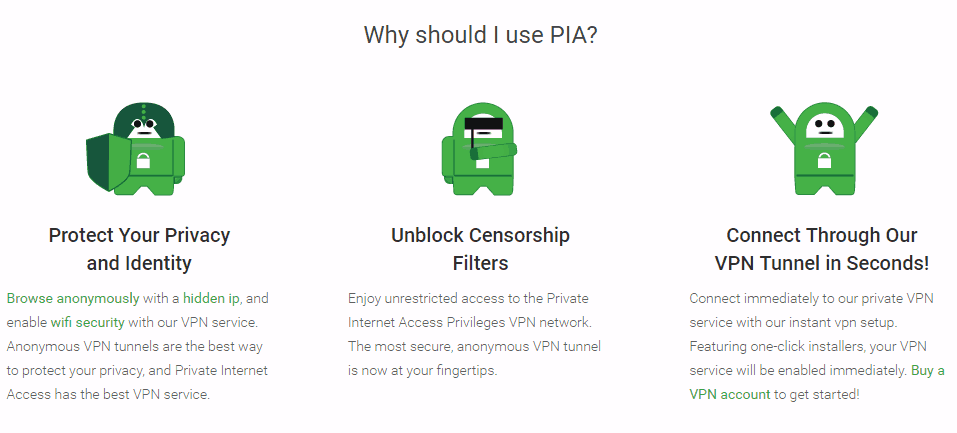
Cons of PIA Features
- Location
- Fewer Server Locations

ExpressVPN
Some say that ExpressVPN picked a better location by utilizing the British Virgin Islands because there are no data retention laws.
We agree, for us, privacy is of paramount importance. However, you need to be in the right jurisdiction for the ultimate privacy.
A government that isn’t infamous for snooping won’t ask for the information, and if it did, ExpressVPN has no legal responsibility to comply. Location is a plus in this aspect. Even if PIA doesn’t keep user logs, a site further away from the UK or US adds an extra security layer.
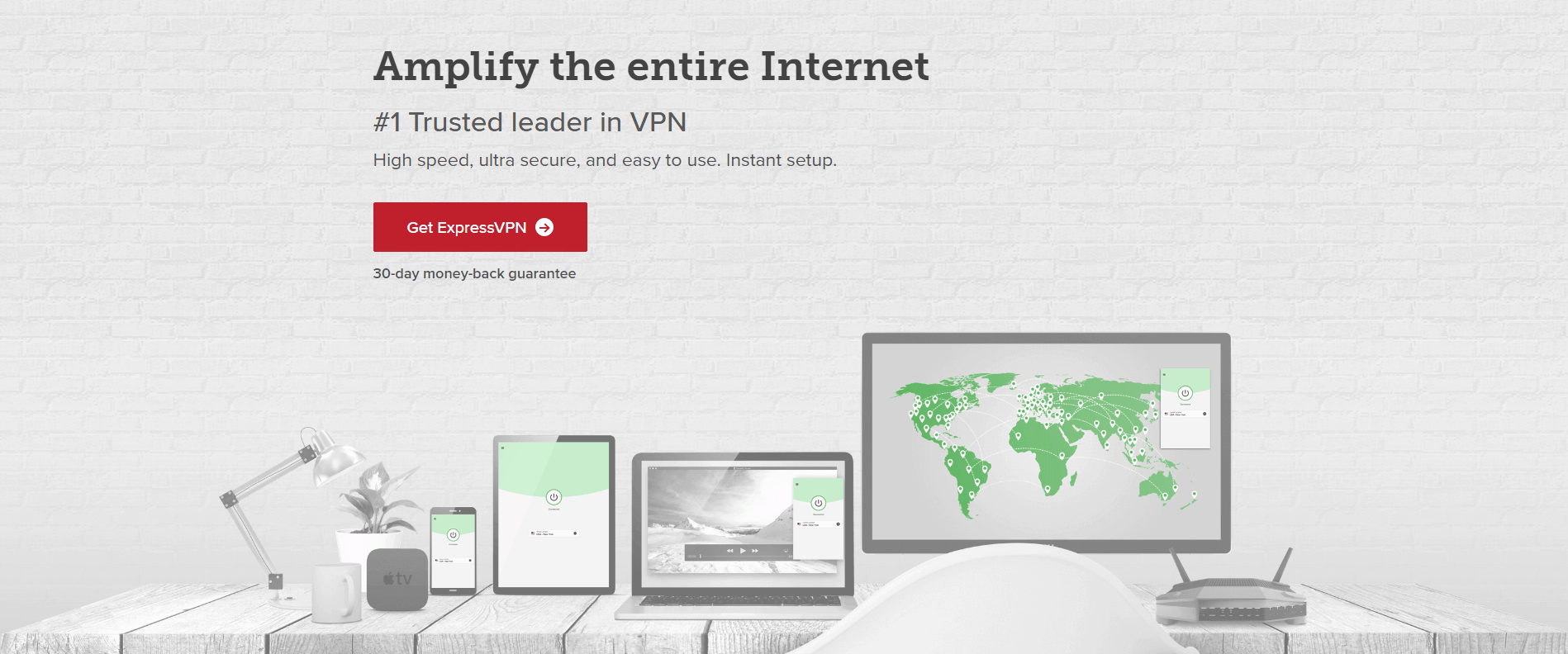
Like PIA, ExpressVPN offers Kill Switch and DNS Leak Prevention as well as IPv6 Leak Protection. ExpressVPN has a server speed test integrated into its software and it allows you to automatically or manually choose a server.
While PIA has more servers, ExpressVPN has more locations for its servers, which is excellent because it increases the number of available locations users can choose from nearby. This feature is critical since you should choose a server in a different country but one that is still close. Just make sure to look at the server list since this can change for every user.
ExpressVPN has apps for macOS, Linux, Windows, iOS, Amazon Fire TV, and Android. It also has great 24/7 live customer support through chat.
ExpressVPN has become such a trusted and reliable VPN operator that global computer hardware and software manufacturer HP have officially partnered with ExpressVPN to offer their customers internet privacy solutions. As a result, since late 2019, all HP computers have come pre-loaded with ExpressVPN.
And it is always either 1 or 2 on our top VPN lists. Besides Nordvpn (our top choice), we would say it is one of the best VPNs in the world today.
Pros of ExpressVPN Features
- Location
- Integrated Server Speed Test
- Kill Switch
- Servers in 94 Countries
- Split Tunneling
Cons of ExpressVPN Features
- Fewer Servers
- No Additional Protection from Ads and Malware

Speed, Reliability, and Performance
First, PIA has high performance at a low cost, while ExpressVPN has great unblocking capabilities. Many experts consider ExpressVPN more ideal to use with home-based routers.
PIA’s blocking of trackers, ads, and malware certainly enhances the experience and performance. The unlimited bandwidth also contributes to its quality performance.
ExpressVPN’s split tunneling enhances performance by allowing you to route some of your traffic through a VPN while directing the rest through the internet. It has over 160 server locations in those 94 countries previously mentioned which also boosts its performance.
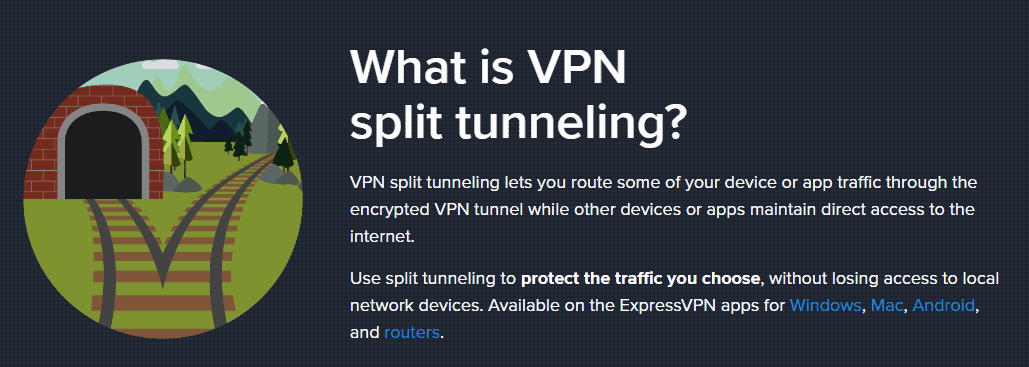
Both have great performance at high speeds. ExpressVPN claims to have incredibly-fast VPN speeds, and remember it has that integrated speed test to help you choose the fastest server in your network. PIA says it has gigabit VPN port speeds and unmetered VPN transfer. Reviewers testing the speed loss on both networks’ VPNs found a 7 percent loss of speed with ExpressVPN, and PIA has an 11 percent speed loss.
PIA and ExpressVPN are known for their reliability and quality. It’s why they are so popular. You can’t go wrong with a fast VPN tunnel connection.
Both of these VPNs are very reliable. You can enjoy content from blocked and censored websites from virtually anywhere in the world. In the world of peer-to-peer downloads, both ExpressVPN and PIA are among the highest-rated VPNs for torrenting.
Security and Privacy
ExpressVPN protects your data with 256-bit AES encryption. Use one of ExpressVPN’s secure servers to mask your true location and IP address. It lets you browse anonymously, and you can even use this VPN with Tor for extra security and privacy online.
ExpressVPN also lets you pay with Bitcoin, which is still a rarity and brings its own privacy benefits. Also, there is no need to worry about your private data being shared as ExpressVPN doesn’t ever log DNS queries, traffic data, or any identifying information.

Your ability to choose your own VPN protocol or let ExpressVPN select one for you is an excellent security feature. Also, ExpressVPN operates its own encrypted and private DNS on every server guaranteeing you faster and safer connections.
PIA has a lot of great security features as well. The fact that it doesn’t keep traffic logs make up for its location in the US. The malware, tracker, and ad blocking also serve as critical security and privacy functions.
PIA allows you to enable Wi-Fi security with their service and use a hidden IP to browse anonymously. Utilizing anonymous VPN tunnels is one of the securest ways to protect your privacy. Your PIA VPN account is secure and safe.
Price
ExpressVPN and PIA both have three different subscription plans. They have very different pricing terms, however.
The subscription periods for ExpressVPN are 1 month, 6 months, and 1 year while PIA’s periods are 1 month, 1 year, and 2 years. ExpressVPN costs $12.95 a month. If you choose a 6-month plan billed every 6 months the price per month lowers to $9.99. A 12-month plan paid yearly brings the cost per month down to just $8.32.
ExpressVPN accepts credit card payments, such as Visa and Mastercard, electronic payment options such as Bitcoin and Alipay, but users can also pay for their subscription in Bitcoin if they are particularly privacy-focused.

PIA costs just $9.95 a month if you choose its monthly option. The cost lowers to $5.99 a month if you pick the yearly option and if you decide on PIA’s 2-year plan, the price equals just $3.49 a month.

Both companies offer a money-back guarantee. PIA’s is only 7 days while ExpressVPN’s is 30 days. Each company offers discounts with certain subscriptions, such as the steep discount for purchasing their highest plans. PIA provides a 58 percent discount on its 2-year plan. In addition to the discounts that ExpressVPN gives for buying a longer-term plan, it offers 3 months free with its annual subscription.
Private Internet Access lets users pay for their subscription through traditional methods, such as credit card, but also allow users to pay using PayPal, Google Play, and iTunes. PIA also has Bitcoin and Ripple payment options – but this is only available for one-time purchases and not subscriptions.
The Verdict
The choice of which one of these VPNs is the best can be difficult. They both have excellent security features and pricing plans. Each company offers something that the other one doesn’t.
Even though PIA is less expensive for a fantastic VPN service, the choice for the best VPN goes to ExpressVPN. Several factors led us to this choice.
First, the company location is a significant asset. It is based in the British Virgin Islands, which is about as good a location you can get. Although PIA doesn’t keep logs, it is still based in the USA, which is a major disadvantage in our opinion. If you are very concerned with privacy when choosing a VPN then we always recommend looking at jurisdiction before anything else.
Even without jurisdiction, Expressvpn still comes out on top. ExpressVPN has the most server locations. It has excellent speed and less speed loss than PIA. It may be more expensive, but its service is still excellent value for the price.

ExpressVPN also has a 30-day money-back guarantee. The company gives you 3 months free if you sign up for the longest subscription which is an excellent incentive.
ExpressVPN also has some great educational features on navigating VPNs. There are step-by-step how-to privacy guides on anonymous browsing. Its blog provides awesome information on digital freedom, security tips, and global internet privacy news. It even has guides on how to stream your favorite sports online. And when it comes to streaming, ExpressVPN also happens to be one of the most best VPNs for Netflix.
The critical thing when choosing the right VPN for you lies in the specific features that you need. No matter which one you select, make sure that you find out about its server locations and other pertinent information before you make your choice.
| VPN Services | |
|---|---|
 |
|
 |
|
Disclosure: Blokt strives to provide transparent, honest reviews, and opinions. The writer of this article is a user of the product(s) or service(s) mentioned in this article and was not influenced by the respective owners.
We rarely run ads, but sometimes earn a small commission when you purchase a product or service via a link on our site. Thank you kindly for your support.
Read more or donate here.
ExpressVPN vs Private Internet Access (PIA) was originally found on Blokt - Privacy, Tech, Bitcoin, Blockchain & Cryptocurrency.
]]>![How to Short Bitcoin - A Simple Guide [2022] 336 Shorting Bitcoin on BitMEX](https://blokt.com/wp-content/uploads/2019/05/shorting-bitcoin-bitmex-300x143.png)
When Bitcoin made its dramatic decline in 2018 from all-time highs, many traders may have wished that they could profit from the thousands of dollars that were wiped off Bitcoin’s market cap and spot price. Well, it may surprise you to learn that many traders did – and they still are in 2022. Trading a […]
How to Short Bitcoin – A Simple Guide [2022] was originally found on Blokt - Privacy, Tech, Bitcoin, Blockchain & Cryptocurrency.
]]>![How to Short Bitcoin - A Simple Guide [2022] 343 Shorting Bitcoin on BitMEX](https://blokt.com/wp-content/uploads/2019/05/shorting-bitcoin-bitmex-300x143.png)
When Bitcoin made its dramatic decline in 2018 from all-time highs, many traders may have wished that they could profit from the thousands of dollars that were wiped off Bitcoin’s market cap and spot price.
Well, it may surprise you to learn that many traders did – and they still are in 2022. Trading a derivative of Bitcoin allows traders to profit from both positive and negative price movements in the market, but how is this possible, and how can you get started?
Find out in our how to short Bitcoin in 2022 guide, where we’re going to break down the fundamental concepts behind ‘shorting’ the market.
Shorting Bitcoin
So, you’ve decided you want to open a short position on Bitcoin. How would you do this? The first step is to identify and sign-up for a cryptocurrency derivatives platform. We’re going to review some of the best ones below.
For this, you’ll need to have some Bitcoin ready to deposit to the exchange. There’s plenty of options to buy BTC with fiat, such as USD or EUR. We review the best ways to buy Bitcoin in 2022 here, so make sure you’re ready to deposit before you start.
Once you’ve got some BTC, open a cryptocurrency derivatives exchange account and deposit your Bitcoin. Unlike traditional exchanges, most crypto derivatives exchanges don’t require KYC or identity verification, so you can start trading in minutes.
Top Exchanges for Shorting Bitcoin in 2022
As the cryptocurrency markets have matured, the number of derivatives exchanges launched to meet demand has increased, and there are now plenty of trusted options available for traders looking to short Bitcoin.
Let’s look at some of the top trading platforms:
| Rank | Exchange | Deposit Methods | Fiat Accepted | Cryptocurrency Supported | HQ |
|---|---|---|---|---|---|
| 1 | FTX (Full Review) | BTC, ETH, Stable coins | None | BTC, ETH, LTC,BCH | Hong Kong |
| 2 | BitMEX [Full Review] | Crypto | None | BTC, ETH, LTC, BCH, EOS, XRP, ADA, TRX | Hong Kong |
FTX.com
![How to Short Bitcoin - A Simple Guide [2022] 337](https://blokt.com/wp-content/uploads/2020/07/ftxexchange.jpg)
Established in 2019, FTX.com has quickly become one of the most popular crypto derivatives exchanges in the world. Built by the quantitative trading team of blockchain professional services firm Alameda Research, FTX.com has been developed from the ground up and offers advanced trading with low fees.
Traders can use FTX.com to short Bitcoin with up to 100x leverage, with options contracts for Bitcoin and a range of other top cryptocurrencies.
Another innovative feature of FTX.com that we haven’t seen implemented on other exchange platforms is their ‘BULL & BEAR’ leveraged tokens.
These are ERC20 tokens that represent either a long or short position in an underlying asset, including Bitcoin, and it’s an incredibly quick and easy way to take a position in the market.
FTX has a tiered fee structure for traders. At tier 1, taker fees are 0.07%, and this is reduced to 0.04% at the highest tier – which can be achieved by holding FTX tokens. There are no fees on futures settlements.
Deposits on FTX.com are made in Bitcoin. Overall, FTX.com is a great option for opening Bitcoin shorts. You can read our complete guide on FTX exchange here.
BitMEX
![How to Short Bitcoin - A Simple Guide [2022] 338 bitmex homepage](https://blokt.com/wp-content/uploads/2019/02/bitmex-homepage.png)
One of the longest-serving and most trusted Bitcoin trading platforms, BitMEX is a peer-to-peer trading platform for Bitcoin, Ethereum, and a handful of other cryptocurrencies.
BitMEX was established in 2014 and has consistently remained as one of the top-volume crypto derivatives exchanges in the world since its launch.
There are a number of Bitcoin options contracts available on BitMEX, which allow traders to open long or short positions.
Traders can utilize up to 100x leverage on BitMEX, which boosts your position size when opening a trade. There’s also an insurance fund that prevents traders from getting liquidated unfairly in the event of high volatility.
BitMEX’s fees are 0.075% for takers regardless of their leverage. They charge 0.01% on long funding trades, and -0.01% on short funding, with funding intervals of 8 hours. There is a 0.05% settlement fee on traditional Bitcoin futures.
Deposits on BitMEX are made in Bitcoin, which uses the ticker symbol ‘XBT’ for the purposes of BitMEX’s futures contracts.
BitMEX is one of the most well-respected Bitcoin trading platforms, and we highly recommend it for opening a short position on Bitcoin. You can read our full BitMEX review here.
Huobi Global
![How to Short Bitcoin - A Simple Guide [2022] 339 huobifutures](https://blokt.com/wp-content/uploads/2020/07/huobifutures.png)
Huobi Global is a Singaporean spot and derivatives exchange launched in 2013. It’s one of the highest volume exchanges in the world and has long been a favorite among East Asian cryptocurrency traders.
There are multiple derivatives and options contracts available for Bitcoin on Huobi Global, which include weekly, bi-weekly, and quarterly futures – which refers to the point at which the contract expires.
Huobi offers greater leverage than some of its competitors, with up to 125x on its bi-quarterly futures contracts, which let traders open short positions on Bitcoin.
You can deposit BTC and a range of other cryptos on Huobi for opening short positions. Huobi has an interest rate on margin of 0.098% and a 0.04% taker fee on Bitcoin futures contracts.
As one of the safest and most frequently used sites in the world, Huobi Global is a great choice for opening a Bitcoin short position. Find out more about Huobi Global in our complete guide here.
What is Shorting?
When you buy an asset or a derivative of an asset with the intention of profiting from the asset going up in price, you are said to be ‘going long’. On the other hand, a trade placed with a view to profit from an asset’s decline in price is called ‘going short’ or ‘shorting’ the market.
While it’s typical to buy an asset at spot price and physically hold it to open a long position, it’s not as simple to open a short. This is because you’ll need to sell Bitcoin in order to repurchase it at a lower price. For this, you’ll need to use a Bitcoin derivatives exchange, and trade a futures or options contract.
![How to Short Bitcoin - A Simple Guide [2022] 340 traditional stock market](https://blokt.com/wp-content/uploads/2019/02/traditional-stock-market.png)
Some of the options for shorting Bitcoin in crypto trading are known as ‘naked shorts’ – meaning you don’t have to own the asset before you sell or short it. However, for most crypto derivatives exchanges, you will need to deposit some Bitcoin to the platform before you can open a short.
Short sells can often be opened with leverage, which is the act of borrowing against your original capital in order to increase your position size. This can magnify gains, but also increase losses. You can read more about that here.
We’ll explore some of the most popular crypto derivatives exchanges below, but first let’s look at some of the pros and cons of shorting Bitcoin.
Benefits of Shorting Bitcoin
There are a few benefits of shorting Bitcoin, mainly for short-term traders but long-term holders may also want to consider opening a short. These benefits include:
- More opportunities for profit – If the market turns bearish, you can open a short position to profit from the downward movement. In the short-term, this means you don’t have to be left holding a bag of BTC in a bear market.
- Portfolio diversity – If you’re bullish on the blockchain industry as a whole, but not Bitcoin, then shorting Bitcoin can be a great way to maximize profits from alt-runs while also profiting from a decline in BTC price.
- Derivatives over ownership – This can be a pro or a con depending on how you look at it. When you short Bitcoin, you’re trading a derivative. This means you don’t own the underlying asset, and so positions are sometimes easier to close or open, and you don’t have to worry about Bitcoin custody.
![How to Short Bitcoin - A Simple Guide [2022] 341 btc futures](https://blokt.com/wp-content/uploads/2019/02/btc-futures.jpg)
Negatives of Shorting Bitcoin
While shorting opens up possibilities to profit from periods of Bitcoin price decline, there are a few considerations you should know before opening a position:
- Effect on the market – If you’re bullish on Bitcoin overall, but you want to profit from short-term bearish action, then you should consider that the number of short positions open influences the overall trading sentiment on Bitcoin as a whole.
- Risk of liquidation – Trading platforms that allow traders to short the market also offer options for leverage. Trading with leverage allows you to borrow against your initial funds and trade with a much larger position. However, the risk for losing funds is also greatly magnified and you should keep this in mind while trading.
- Fees – When you short, you’re essentially borrowing money from the exchange in order to place a trade. Unlike buying Bitcoin at ‘spot’ price where the asset belongs to you, when shorting you don’t own the underlying Bitcoin. As a result, you must pay fees – such as ‘overnight funding’ – on your position. This makes it unsuitable for long-term holds.
- Volatility – Just as the market moves quickly into a bearish phase, it can move quickly back into a bullish trajectory. Only open a short if you’re sure the price of Bitcoin has a significant degree of downside potential.
![How to Short Bitcoin - A Simple Guide [2022] 342 bitcoin trading e1566907472426](https://blokt.com/wp-content/uploads/2019/02/bitcoin-trading-e1566907472426.jpg)
Key Things to Remember When Shorting BTC
Hopefully, this guide will have helped you decide if shorting Bitcoin is right for you, and help you choose a trading platform on which to open a short.
As derivatives trading is a fairly technical process and comes with some risk, we recommend you take the time to read our in-depth guides for each exchange, linked in the descriptions above.
Likewise, if you’re a seasoned trader with plenty of short experience looking to move into the crypto markets and you need advice on the best ways to buy Bitcoin in 2022, read our complete guide here.
What are your thoughts on shorting Bitcoin? Let us know in the comments section below!
References
- Leverage – Investopedia’s guide on leverage
- Shorting Stocks – The basics of shorting stocks
- Derivatives Contracts – The Economic Times’ definition of derivatives
How to Short Bitcoin – A Simple Guide [2022] was originally found on Blokt - Privacy, Tech, Bitcoin, Blockchain & Cryptocurrency.
]]>
Just weeks after being acquired by Nike Inc., NFT studio RTFKT collaborated with leading NFT gallery Oncyber to jointly launch Space Pods. Space Pod Airdrop The first item of the roadmap will be airdropped by the end of the month. Your Clones very own @oncyber_io SPACE POD 🚀 1 Clone=1 Space Pod NFTClones will be […]
Space Pods: A Stunning Way to Show Off Your NFTs in the Metaverse was originally found on Blokt - Privacy, Tech, Bitcoin, Blockchain & Cryptocurrency.
]]>
Just weeks after being acquired by Nike Inc., NFT studio RTFKT collaborated with leading NFT gallery Oncyber to jointly launch Space Pods.
Space Pod Airdrop
The first item of the roadmap will be airdropped by the end of the month. Your Clones very own @oncyber_io SPACE POD
1 Clone=1 Space Pod NFT
Clones will be airdropped their Space Pods.
Unrevealed Vials will have to pay a gas fee to claim their space pod pic.twitter.com/giYN84kVMW— RTFKT Studios (@RTFKTstudios) December 12, 2021
What are Space Pods?
CloneX NFT collectors were airdropped one exclusive 2021 Space Pod each. These virtual spaces are metaverse-ready gallery capsules to customize, upgrade and show off your NFTs. The launch took place just days after the much-anticipated launch of the CloneX NFTs by RTFKT.
Space Pod Giveaway
Currently, metaverse framing project Frahm.art is running a raffle to give away one such Space Pod. The current market value is approximately 0.25 ETH or $1000. Check out the tweet from the Frahm.art Twitter account to participate:
@frahm_art New Years #NFT #Giveaway
We love the Cyber Pods by @oncyber_io and @RTFKTstudios #CloneX.
We are giving away our CloneX Cyber Pod for free!
To participate:
1. Like
2. Retweet
3. Follow @frahm_artLet us know how you like our Cyber Pod!https://t.co/oXbMrNJcSV
— Frahm (@frahm_art) December 31, 2021
Frahm is a project innovating in framing NFTs in these digital galleries. In this process, the frame itself becomes a piece of art and an NFT artifact.
The Future of NFTs
NFTs are set to lead crypto into the mainstream. The intersection of digital art, collectibles, and e-gaming will be one of the hottest sectors next year. Global lifestyle brands like Adidas and Nike making their moves into the space next to celebrities like Snoop Dogg becoming a renowned NFT collector are just the early innings of what is to come.
A clear market trend is noticeable where NFT galleries like Oncyber are evolving into much more than just art galleries. At the same time, PFP projects like CloneX are evolving into global brands. Owning a CloneX is equal to being a first-class citizen within its ecosystem and community.
The vision for these ecosystems is to evolve into an interconnected world of metaverse spaces. In this future, the Space Pod can become the home base for your CloneX. The same CloneX which will be used as an avatar in video games and character in an animated series.
We can only imagine what the metaverse will ultimately look like. Space Pods give you a first glance.
Space Pods: A Stunning Way to Show Off Your NFTs in the Metaverse was originally found on Blokt - Privacy, Tech, Bitcoin, Blockchain & Cryptocurrency.
]]>
What the hell are MoonCats? MoonCats, Ethereum-based collectible NFTs deployed on August 9th, 2017, have now all been rescued and are now finding their way onto marketplaces like OpenSea. Users could rescue cats (from the moon, naturally) at just the gas fee cost up until yesterday when all 25,600 had been rescued. MoonCatsRescue employs an […]
MoonCats: Almost-Free NFT Collectible Felines Are Selling for a Huge Markup was originally found on Blokt - Privacy, Tech, Bitcoin, Blockchain & Cryptocurrency.
]]>
What the hell are MoonCats?
MoonCats, Ethereum-based collectible NFTs deployed on August 9th, 2017, have now all been rescued and are now finding their way onto marketplaces like OpenSea. Users could rescue cats (from the moon, naturally) at just the gas fee cost up until yesterday when all 25,600 had been rescued.
MoonCatsRescue employs an off-chain algorithm that requires users’ CPU resources to find cats. This allowed the MoonCats to be more equally distributed. At the time of writing, there are 1,644 holders.
The MoonCats contract allowed only 25,600 MoonCats to be added out of a possible 4 billion unique combinations. After this point, no more cats could be rescued. Users that have rescued MoonCats can name them, but only once; once a MoonCat has been named, it is permanent.
Interestingly, there are not really any rare cats. This is different from other collectibles such as CryptoPunks and may mean we see less extremely valuable cats, but all cats may hold a similar, equally good value.
Genesis MoonCat Sells for 100 ETH
There are 256 Genesis MoonCats, which are particularly rare cats that could not be rescued like the others. These Genesis cars are currently selling for 100 ETH on OpenSea, and others are listed for over 420 ETH. The average price for each non-genesis cat is 0.6673 ETH, significantly higher than the roughly $40 gas cost required to rescue the carts.
How can I get MoonCats?
Unfortunately, there are no more MoonCats available to rescue, but MoonCats can be purchased from marketplaces such as OpenSea or Rarible.
MoonCats: Almost-Free NFT Collectible Felines Are Selling for a Huge Markup was originally found on Blokt - Privacy, Tech, Bitcoin, Blockchain & Cryptocurrency.
]]>
Namecheap is best known as an American domain name registrar and web hosting provider, who have been operating for 20 years since the early days of the internet. With over 11 million users and a highly trusted reputation, Namecheap has grown into one of the largest registrars in the world. Namecheap has long been an […]
Namecheap VPN Review – Does It Live Up To The Hype? was originally found on Blokt - Privacy, Tech, Bitcoin, Blockchain & Cryptocurrency.
]]>
Namecheap is best known as an American domain name registrar and web hosting provider, who have been operating for 20 years since the early days of the internet. With over 11 million users and a highly trusted reputation, Namecheap has grown into one of the largest registrars in the world.
Namecheap has long been an advocate of private and free internet access, campaigning for net neutrality and open communications for all. They’ve proven their commitment to this cause through various fundraising efforts and shows of support for internet freedom causes – which should come as a great accolade for those users concerned with their privacy online.
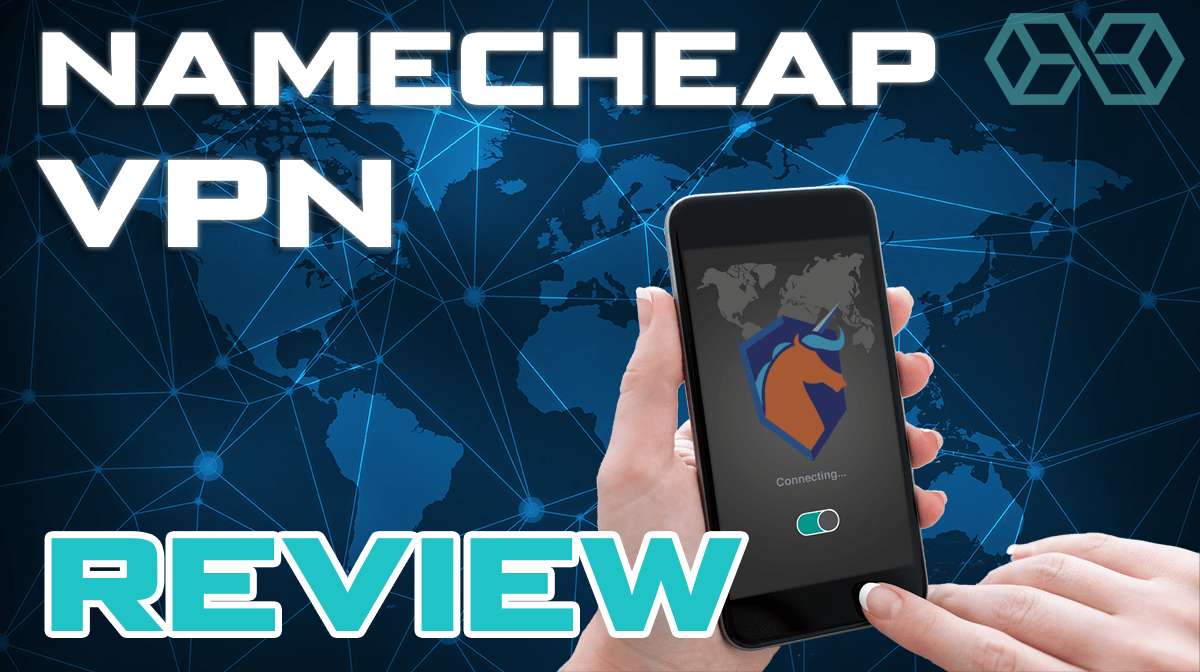
More recently, Namecheap has begun offering other services, one of which is their VPN solution. Although Namecheap’s VPN started life as a relatively simple service, it’s been built upon and seriously upgraded over the last few years. It can now hold its own against other leading VPN services.
As a result, we don’t think that current reviews do Namecheap’s new-and-improved VPN justice. So, we’re going to explore what makes Namecheap’s VPN an excellent choice for 2020 and examine some of the leading features this VPN service has to offer.
Namecheap VPN Special Features
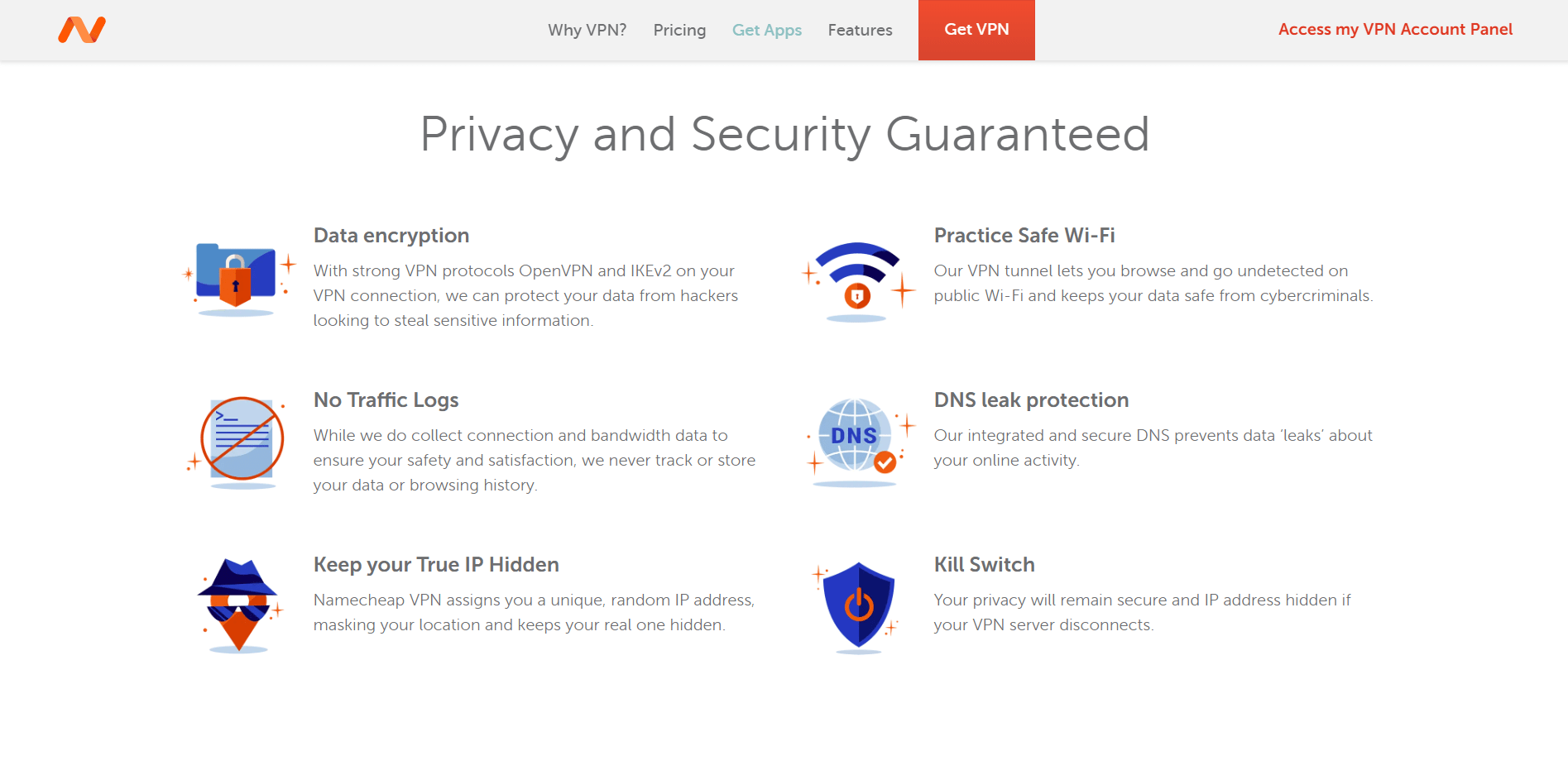
Namecheap’s VPN does all the things you would expect of a regular VPN service. Still, there are a few extra features that Namecheap offers, which make it stand out from the competition and rub shoulders with the most popular VPN providers like NordVPN, ExpressVPN, etc. These include:
- Over 1,000 servers – Unlike some smaller VPN operators, Namecheap uses over 1,000 server locations so its users can always enjoy uninterrupted access to VPN connections all over the world. This includes popular locations in the Americas, Europe, Asia, and Australia.
- DNS leak protection – Domain name systems, or ‘DNS’ is described as the ‘phonebook’ of the internet, and it can reveal specific information about you when you connect to websites. Namecheap’s VPN service prevents this information from being leaked when you surf the web.
- Strong data encryption – Namecheap uses leading VPN protocols to ensure that user data is encrypted. These include OpenVPN and IKEv2 protocols, which provide military-grade traffic encryption.
- Unlimited device support – One of the best features of Namecheap’s VPN service is its unlimited amount of connected devices. This means customers can connect any device, regardless of the operating system, in their home, or even share their connection with friends and family.
- ISP throttling avoidance – Some ISPs use ‘packet sniffing’ to examine your data and restrict browsing while you’re using a VPN. With Namecheap, ISPs are prevented from restricting your internet access using these methods.
- Random IP addresses – Some VPN providers will simply use the IP address of the data center or server you connect to, which makes it obvious you’re connecting via a VPN. However, Namecheap assigns each user a random IP address while keeping your true IP and location hidden.
Useful Extra Features
In addition to its core features, Namecheap’s VPN service has a range of other features which make it even better value for money, including:
- Strict no-logs policy – Namecheap promises that it never keeps logs on its customers’ browsing history, nor does it track or store data from your VPN sessions.
- Round the clock live support – There’s 24/7 live support available from Namecheap, so if you’re having any problems with installation or connecting to your VPN, you can chat with a representative.
- Kill switch – If your VPN connection suddenly drops out for any reason, Namecheap will block all incoming and outgoing traffic to ensure none of your data leaves your device unencrypted.
How Fast Is Namecheap’s VPN?
If you’re a power user, or you regularly use VPNs to stream content, you’ll want to know how fast Namecheap performs – and you’ll be pleasantly surprised!
As Namecheap owns the servers they run their VPNs on, they can guarantee better speeds than some other leading providers, which is great for those who want uninterrupted connections when streaming video content or gaming.
There’s also unlimited bandwidth available through Namecheap’s VPN, which means that you’ll never have your streaming restricted to save on data.
As we’ll look at below, Namecheap also displays the ping of each server next to it within their desktop apps, which is great for seeing at a glance what the fastest server for your location is.
Which Operating Systems Does Namecheap’s VPN Work With?
All major operating systems can use Namecheap’s VPN service, with full clients for Windows, iOS, macOS, Android, Linux, and most brands of router.
These clients are easy to download – once you’ve started your membership, either with a paid plan or free trial, Namecheap will prompt you to download the client that’s right for you or show you how to manually set-up their VPN on your device or router.
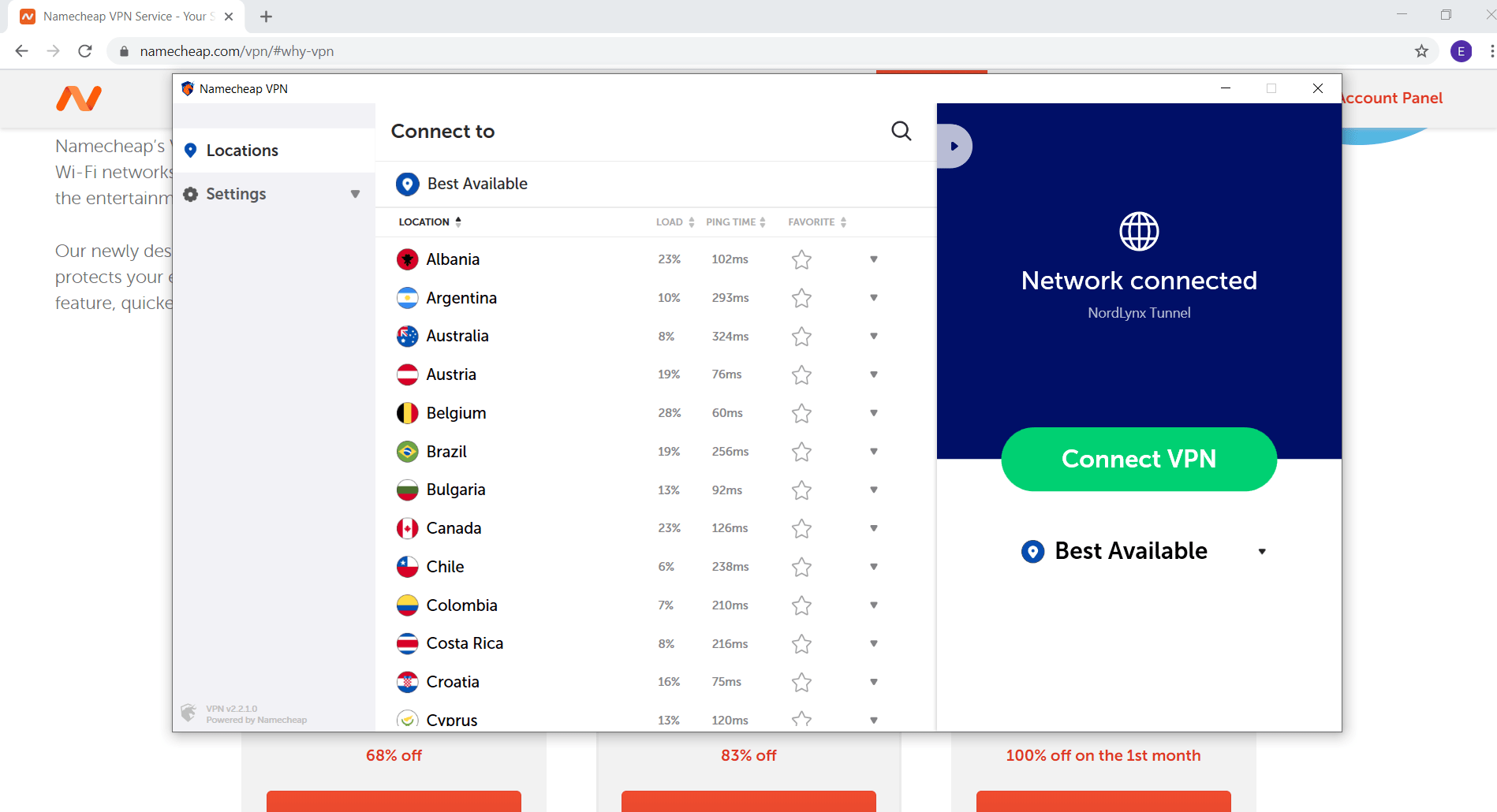
Namecheap’s VPN was quick and easy to install on Windows, as you can see in the screenshot above. Their user interface is very simple to navigate, offering a huge range of server locations to choose from at the click of a button.
Beside each server location is a live and updated ‘ping time’ – the time it takes to communicate with each server. This is great for power users who want to connect to the fastest possible VPN server, and it’s a feature we haven’t seen elsewhere.
Clicking on the drop-down menu at the side of each server location will reveal additional options for selecting a specific city location within that country – for example, within the US, users can select multiple cities such as Boston, Las Vegas, Seattle, and more. Alternatively, you can simply click ‘connect VPN,’ and Namecheap will connect users to the fastest server available.
On all clients and devices, Namecheap’s VPN opens at startup, and there’s a handy option to auto-connect as soon as the app is launched – which means you’ll always be protected when you browse.
You can also use the client to change which VPN protocol you connect to, such as IKEv2 or OpenVPN.
How Much Does Namecheap’s VPN Service Cost?
Namecheap is one of the most affordable VPN services in the world, and it’s also one of the few that offers a completely free trial for a month to new users.
A one-year subscription costs just $1 per month for the first 12 months, billed at $12.00 for the first year and then $34.56 for each year after that.
Personally, we recommend taking advantage of Namecheap’s 3-year plan. At just $1.88 per month, users can save 68% on the normal monthly subscription price, billed in a single lump sum of $67.68.
Whichever plan you choose, Namecheap’s VPN works out as one of the most cost-effective VPN services on the market, rivaled only by the likes of SurfShark, which is very affordable too.
If you choose to start a free trial, you will need some payment information, but you won’t be billed until your first month is up. Most other VPN providers offer a couple of days free protection or restrict usage by data – but Namecheap’s free trial offers all of the features you’d get in the full version.
There’s also a 30-day money-back guarantee, which means even if you change your mind about Namecheap’s service, you won’t be out of pocket.
|
Subscription Length |
Cost Per Month |
|
Monthly |
Free month, then $5.88/Month |
| Yearly |
$1/month for the first year, then $2.88/month |
| 3 Years |
$1.88 |
Namecheap VPN – Our Verdict
Overall, Namecheap’s VPN offers amazing value for money and a very comprehensive VPN service, which is both easy to use and provides plenty of protection for any level of user.
One of our favorite features has to be Namecheap’s huge range of servers – over 1,000 in total based in over 75 locations – which not only contributes to a stable and secure VPN connection, but they also offer a good level of location variety for users.
Likewise, we think that Namecheap’s unlimited device support offers great value for money as it can essentially be used to cover a whole household of devices using just one subscription, or shared among friends.
Unlimited devices and a huge range of servers are also available from other providers, but only really the top few. As a result, Namecheap’s VPN service is above average. When comparing other budget VPN options, it’s incredibly difficult to find a provider that offers the same amount of servers as Namecheap does for the same price.
Although we only reviewed their Windows client, it was easy to use and incredibly fast to install. The user interface was easy to navigate even for beginners, while also providing plenty of advanced options for users who demand more from their VPN. We expect this is similar across all operating systems and clients.
Namecheap’s 24/7 live chat support, where you can speak to a real representative, is also a great feature that many other VPN providers at this price point don’t currently offer.
Most current reviews on Namecheap’s VPN service were written before many of these new features were added, and we really think that Namecheap deserves more attention – as it provides all-round performance for any level of user, and brings Namecheap’s long experience and trustworthiness to a VPN service.
Namecheap VPN Review – Does It Live Up To The Hype? was originally found on Blokt - Privacy, Tech, Bitcoin, Blockchain & Cryptocurrency.
]]>![Top 16 Best Ethereum Wallets [2020] - ETH & ERC20 Crypto Wallets 353 16 best ethereum wallets](https://blokt.com/wp-content/uploads/2019/03/16-best-ethereum-wallets-300x168.png)
Ethereum is the blockchain protocol with the most active developers and the most projects built on top of its platform. That’s why we have put together this comprehensive guide to help you choose the best Ethereum wallet for you. Its native cryptocurrency, Ether, has the second-highest market valuation behind the original cryptocurrency Bitcoin, so it is no surprise that loads of people […]
Top 16 Best Ethereum Wallets [2020] – ETH & ERC20 Crypto Wallets was originally found on Blokt - Privacy, Tech, Bitcoin, Blockchain & Cryptocurrency.
]]>![Top 16 Best Ethereum Wallets [2020] - ETH & ERC20 Crypto Wallets 376 16 best ethereum wallets](https://blokt.com/wp-content/uploads/2019/03/16-best-ethereum-wallets-300x168.png)
Ethereum is the blockchain protocol with the most active developers and the most projects built on top of its platform. That’s why we have put together this comprehensive guide to help you choose the best Ethereum wallet for you.
![Top 16 Best Ethereum Wallets [2020] - ETH & ERC20 Crypto Wallets 354 16 best ethereum wallets](https://blokt.com/wp-content/uploads/2019/03/16-best-ethereum-wallets.png)
Its native cryptocurrency, Ether, has the second-highest market valuation behind the original cryptocurrency Bitcoin, so it is no surprise that loads of people have become interested in investing and trading Ether and Ethereum tokens.
There has also been a surge in decentralized finance (Defi) Dapps built on on Ethereum which has opened it up to far more users. ETH heads can now use stablecoins such as Dai which are pegged to the US Dollar but use ETH as collateral.
However, before we can start trading and investing, we need to understand the basic principles of how an Ethereum or general crypto wallets work.
Private Keys and Addresses
Blockchain-based assets and currencies are normally called cryptocurrencies, crypto assets, or simply cryptos because they all depend on cryptography.
On a very simplistic level, cryptography is the use of mathematics to send, receive, conceal, or reveal information.
Private keys are essentially the secret code that controls your information, which in this case, would be your crypto assets.
Knowing an account’s private key means users have complete control of that account’s assets without having to go through any intermediaries.
(Ethereum private key example)
Using cryptography and with access to the private key, we are able to generate — through many complicated steps — an address, which represents your account.
It can be thought of like a mailbox or an email address that people can send things to, but you can only send things from it if you have the private key.
The address is the public face of your account and can be shared with anyone but no one can figure out your private key from only knowing your address thanks to the genius of cryptography. An Ethereum address always begins with 0x.
(Ethereum address example)
What is a Wallet?
The term “wallet” is kind of a misnomer in that crypto wallets don’t actually hold any assets. Wallets can only contain access to private keys, which in turn control crypto assets.
Functionally, wallets allow users to create new accounts and send assets, although different wallets have different features and functionality.
It would be more accurate to call a wallet, a keyring or keychain because it controls and has access to different types of keys but we’ll go with ‘wallet’ seeing as everyone else does.
The differences between different types of wallets revolve around how each wallet deals with private keys.
Paper Wallets
The most basic type of wallet is known as a “paper wallet,” which is a piece of paper with your private keys written or printed on it.
The information on this piece of paper is all that is needed to control all the assets on an Ethereum account.
A paper wallet is secure in that it is possible to keep it from every other person or system on the planet and only you can know about its existence, its location, or how to access it.
Paper wallets are insecure though because if you lose it or it gets damaged beyond recognition, there is no possible way to recover your funds. You have lost those assets forever.
To counteract this vulnerability, some people make multiple copies of their paper wallet and put them in different locations or keep the paper wallet in a secure spot such as a safety deposit box at a bank.
![Top 16 Best Ethereum Wallets [2020] - ETH & ERC20 Crypto Wallets 355 Paper Wallet generated using MyCrypto](https://blokt.com/wp-content/uploads/2019/03/Paper-Wallet-generated-using-MyCrypto.png)
Hot vs Cold Wallets
Paper wallets fall under the category of ‘cold wallets,’ which means that they are completely disconnected from the internet. This makes cold wallets more secure and less vulnerable to software-based attacks.
Hot wallets, on the other hand, are connected to the internet, so they are more accessible and useful for frequent transactions but are also more vulnerable to hackers.
In general, cold wallets are better for securing large amounts of funds and hot wallets are better for everyday transactions and usage.
Software Wallets
| Exchanges | Ethereum-Specific | Ethereum Interfaces | ||||
| Coinbase | Binance | MyEtherWallet | MyCrypto | Mist | MetaMask | |
| Private Keys | Platform Controlled | Platform Controlled | User-Controlled | User-Controlled | User-Controlled | User-Controlled |
| Backup/ Recovery Options | Yes | Yes | No | No | No | No |
| Cold or Hot Wallet | Hot | Hot | Hot | Hot | Hot | Hot |
| Interact with Dapps | No | No | No | No | Yes | Yes |
![Top 16 Best Ethereum Wallets [2020] - ETH & ERC20 Crypto Wallets 356 Ethereum Software Wallets](https://blokt.com/wp-content/uploads/2019/03/software-wallets.png)
Cryptocurrency Exchanges
The most common way for people to buy their first crypto asset is through an exchange which allows people to trade between fiat currencies and cryptocurrencies.
Exchanges also act as wallets because the platform controls the private keys on behalf of the user.
The benefit of having a platform control your private keys is that your funds or assets are recoverable if you lose your password.
Coinbase
Coinbase is one of the oldest and most trusted exchanges. It was founded in 2012 and has over 20+ million users as well as backing from some of the most respected investors in the world.
Coinbase is also one of the most legally compliant cryptocurrency exchanges globally.
It is connected to the traditional banking system in Europe and the United States, so it is fairly easy to convert fiat currencies such as the US Dollar and the Euro to Ether.
![Top 16 Best Ethereum Wallets [2020] - ETH & ERC20 Crypto Wallets 357 Coinbase platform and app](https://blokt.com/wp-content/uploads/2019/03/Coinbase-platform-and-app.png)
Binance
Binance is the largest cryptocurrency exchange in the world in terms of trading volume.
While Coinbase is mainly available in the U.S. and Europe, Binance is accessible across continents and has even made progress expanding to Africa.
Furthermore, Binance has many more crypto assets available for trading when compared to Coinbase, which has a much stricter process for listing new crypto assets.
Both Binance and Coinbase control private keys on behalf of their users, so funds are controlled by the username and password used to access the platform.
![Top 16 Best Ethereum Wallets [2020] - ETH & ERC20 Crypto Wallets 358 Binance platform and app](https://blokt.com/wp-content/uploads/2019/03/Binance-platform-and-app.jpg)
Ethereum-Specific Wallets
MyEtherWallet and MyCrypto are wallets that are used specifically for Ether and Ethereum tokens so they do not interact with cryptocurrencies from other blockchains such as Bitcoin or XRP.
Ethereum tokens are assets or currencies, which have been created on top of the Ethereum platform.
Tokens can have a wide variety of purposes and are different from Ether itself, which is the fuel that runs the Ethereum network.
The most popular type of Ethereum token is called an ERC20, which is a token created using a common standard that allows any ERC20 token to be easily traded with another ERC20 token.
The second most common token is called an ERC721 or a non-fungible token, which is unique and cannot be broken up into smaller parts.
For simplicity’s sake, I will refer to both ERC20 and ERC721 tokens as just Ethereum tokens.
MyEtherWallet (MEW)
One of the oldest and most popular web-based, Ethereum-specific wallets is MyEtherWallet (MEW).
MEW does not control private keys on behalf of the user and instead allows users to create new accounts and access existing accounts to send transactions.
![Top 16 Best Ethereum Wallets [2020] - ETH & ERC20 Crypto Wallets 359 Myetherwallet is the best Ethereum wallet](https://blokt.com/wp-content/uploads/2019/03/Myetherwallet-is-the-best-Ethereum-wallet.png)
MEW also has a smartphone app called MEWconnect that allows users to access the functions of MEW from their mobile devices.
![Top 16 Best Ethereum Wallets [2020] - ETH & ERC20 Crypto Wallets 360 My Ether Wallet platform and app](https://blokt.com/wp-content/uploads/2019/03/My-Ether-Wallet-platform-and-app-510x1024.png)
MyCrypto
Taylor Monahan, the co-founder of MyEtherWallet, started MyCrypto in February 2018 as a fork of the MyEtherWallet codebase.
A fork means that both products have the same software or code up to the point in which they split. Once separate, two distinct products are born from the different coding decisions made by the teams.
MyCrypto claims to have started in 2015, but it is difficult to say which product or team is the original. It has very similar core features, such as the ability to create new accounts and send transactions on existing accounts.
![Top 16 Best Ethereum Wallets [2020] - ETH & ERC20 Crypto Wallets 361 MyCrypto platform and app](https://blokt.com/wp-content/uploads/2019/03/MyCrypto-platform-and-app.png)
MyCrypto has also developed a desktop application, which is more secure because it doesn’t have to be connected to the internet to function and is capable of doing things like accessing an account via a private key, which the web version does not allow any more.
![Top 16 Best Ethereum Wallets [2020] - ETH & ERC20 Crypto Wallets 362 MyCrypto platform and app](https://blokt.com/wp-content/uploads/2019/03/MyCrypto-platform-and-app-1.png)
Ethereum Interfaces
The primary purpose of Ethereum is to be a platform that runs smart contracts or decentralized applications (dapps), which means that Ethereum is meant to be more than simply a way to send and receive assets or currency.
Its true potential is in enabling the creation of computer programs that can control value that executes automatically when certain pre-defined conditions are met.
In order to access these dapps, an interface is required that can send data to the dapp, and a wallet with Ether is required in order to pay for transactions on the dapp.
Mist
The original Ethereum wallet was Mist, which functions as both a simple wallet and as an Ethereum browser.
Like traditional web browsers such as Chrome or Safari that allow users to interact with regular websites, Mist enables users to interact with dapps on Ethereum.
Mist is a desktop application in which the user controls private keys. It also allows the user to run a node, which is a critical component of Ethereum’s infrastructure and keeps a record of all the transactions that have happened on the network.
When Ethereum was first released, and Mist was the only wallet available, users had to wait for their nodes to sync before being able to make any transactions, which sometimes took hours or even days!
Though popular when Ethereum was first released, Mist has declined in popularity in recent years due to the explosion of competing Ethereum interfaces, wallet programs, and applications.
![Top 16 Best Ethereum Wallets [2020] - ETH & ERC20 Crypto Wallets 363 Mist node syncing in 2016](https://blokt.com/wp-content/uploads/2019/03/Mist-node-syncing-in-2016.png)
MetaMask
MetaMask is the most popular Ethereum interface with over 1 million downloads.
It works as a browser extension instead of a standalone desktop program and allows users to interact with dapps.
The user controls the private keys, and it functions as a wallet because it also allows users to manage their funds and crypto-assets.
MetaMask has become the preferred option for interacting with Ethereum dapps.
MetaMask have recently been working on the launch of version 8.0 of their Chromium wallet extension, and have launched the Metamask Mobile beta version which is due for full release very soon, with over 100,000 downloads already.
![Top 16 Best Ethereum Wallets [2020] - ETH & ERC20 Crypto Wallets 364 MetaMask Extension Log In Screen](https://blokt.com/wp-content/uploads/2019/03/MetaMask-Extension-Log-In-Screen.png)
Hardware Wallets
| Hardware Wallets | Mobile Phones | |||||
| Ledger | Trezor | KeepKey | Sirin Finney | HTC Exodus | Samsung Galaxy S10 | |
| Private Keys | User-Controlled | User-Controlled | User-Controlled | User-Controlled | User-Controlled | User-Controlled |
| Backup/ Recovery Options | Yes | Yes | Yes | Yes | Yes | Yes |
| Cold or Hot Wallet | Both | Both | Both | Both | Both | Both |
| Interact with Dapps | No | No | No | Yes | Yes | Yes |
Hardware wallets are self-contained devices with specially designed hardware that is optimized for security. Unlike software wallets, hardware wallets can function as either cold or hot wallets.
![Top 16 Best Ethereum Wallets [2020] - ETH & ERC20 Crypto Wallets 365 Hardware Wallets Which Support Ethereum](https://blokt.com/wp-content/uploads/2019/03/hardware-wallets.png)
Hardware wallets allow users access to their private keys without having to be connected to the internet. However, they also have the option of connecting to the internet when assets transfer or crypto-related functions need to happen.
Hardware wallets are essentially a portable hard drive that stores your private keys and helps manage or secure crypto assets. There is commonly a digital display and some kind of interface on the device.
Hardware wallets usually come with the ability to have a passcode, which adds a second layer of security, before being allowed to access it.
These companies also offer the option of holding a backup copy of a user’s private keys, which allows you to recover your private keys in case the device is lost or stolen.
As opposed to all the wallets mentioned above, hardware wallets cost money.
Ledger Wallets
The Ledger line of hardware wallets is one of the oldest and most popular hardware wallets on the market with over 1 million products sold.
They support over 1000 different crypto assets, including Ethereum and Ethereum tokens. They have even created a software application that is compatible with all their hardware devices called Ledger Live.
Ledger’s three main products are the:
Ledger Nano S
- Cheapest and most popular product
- A USB device with a simple display and two buttons
- Funds are protected via a secret PIN
![Top 16 Best Ethereum Wallets [2020] - ETH & ERC20 Crypto Wallets 366 Ledger Nano S](https://blokt.com/wp-content/uploads/2019/03/Ledger-Nano-S.jpg)
Ledger Nano X
- All the features and simplicity of the Ledger Nano S
- Can be connected securely via Bluetooth
- Compatible with their Ledger Live mobile app
![Top 16 Best Ethereum Wallets [2020] - ETH & ERC20 Crypto Wallets 367 Ledger Nano X](https://blokt.com/wp-content/uploads/2019/03/Ledger-Nano-X-e1553012038798.png)
Ledger Blue
- Ledger’s most advanced wallet, which includes a large touchscreen interface
- Compatible with the Ledger Live app
- Capable of installing additional apps on the device
![Top 16 Best Ethereum Wallets [2020] - ETH & ERC20 Crypto Wallets 368 Ledger Nano Blue](https://blokt.com/wp-content/uploads/2019/03/Ledger-Nano-Blue.png)
Trezor
Trezor, like Ledger, is also a well-established and trusted hardware wallet company having supported Bitcoin before Ethereum and other blockchains became popular.
Now, it also supports Ethereum, Ethereum tokens, and hundreds of other crypto assets. They offer simple interfaces, security-focused technology and extra layers of protection using passwords and PIN numbers, as well as backup and recovery options.
The Trezor team have worked hard to match the simplicity of Ledger’s devices, recently bringing out the ‘Trezor Wallet’, which functions a lot like Ledger Live and makes it easier for users to manage and control the assets stored on their Trezor device.
Trezor Wallet is plug-and-play, so users can start using their Trezor device straight out of the box without any complex setup process.
The Trezor wallets have a unique and distinctive design. Their wallets include the:
Trezor One
- A USB device with a simple display and two buttons
- Emphasizes quick and easy use
- Integrates with MyEtherWallet
Trezor Model T
- Similar to the Trezor One with an interactive touchscreen display and interface
![Top 16 Best Ethereum Wallets [2020] - ETH & ERC20 Crypto Wallets 369 Trezor One](https://blokt.com/wp-content/uploads/2019/03/Trezor-One-150x300.jpg)
![Top 16 Best Ethereum Wallets [2020] - ETH & ERC20 Crypto Wallets 370 Trezor Model T](https://blokt.com/wp-content/uploads/2019/03/Trezor-Model-T-300x300.jpg)
KeepKey
KeepKey was developed by online crypto exchange, ShapeShift, and is fully integrated with ShapeShift so that users can exchange different crypto assets from the device.
There is only one KeepKey product on the market so far, but like Trezor and Ledger, it offers an isolated and secure device with a simple display and button interface that is capable of functioning as a cold wallet.
KeepKey also features PIN or password protection as well as backup and recovery options.
SelfKey recently acquired web 3.0 interface application Portis, which functions similarly to MetaMask and lets users securely interact with dapps.
It’s likely that in the future, KeepKey users will be able to easily access dapps through Portis without revealing their private keys.
![Top 16 Best Ethereum Wallets [2020] - ETH & ERC20 Crypto Wallets 371 KeepKey Wallet](https://blokt.com/wp-content/uploads/2019/03/KeepKey-Wallet.jpg)
Mobile Apps
Many wallets are also available as applications on mobile devices such as Coinbase, Binance, MyEtherWallet, and Ledger.
Lumi Wallet
Lumi Wallet is available as an app for IOS and Android, as well as on the web. All the configurations are client-side, meaning that private keys are stored only on the users’ devices.
![Top 16 Best Ethereum Wallets [2020] - ETH & ERC20 Crypto Wallets 372 Lumi ETH Wallet](https://blokt.com/wp-content/uploads/2019/03/Lumi-ETH-Wallet.png)
Initially developed as a Bitcoin wallet, Lumi shortly integrated BCH, Ethereum, and more than 1200 Ethereum tokens. Lumi Technologies, the company behind the wallet, recently announced adding an in-app browser to Lumi to interact with Ethereum dapps. At the moment, it is introducing full EOS support, which will grant users the opportunity to create new EOS accounts for free. Lumi wallet is a soon-to-be-open source.
Lumi is recognized for its eye-catching and straightforward interface. Users can buy and sell a wide range of available digital assets via an in-wallet exchange. It is entirely anonymous and doesn’t require users to provide any personal information.
Lumi Technologies has additionally released the Lumi Collect app for ERC721. This wallet is equipped with a browser for Ethereum dapp interaction and sidechain support.
Guarda Wallet
Guarda supports various platforms, including Android and Apple mobile devices. It supports over 40 blockchains and thousands of tokens, including BTC, ETH XRP, BCH, BSV, XMR and many more. Supported cryptos can be purchased directly from within the wallet, and coins can also be exchanged using the built-in exchange service.
The Guarda Wallet is custody-free, so private keys are not stored by the company, meaning users are responsible for keeping their keys safe.
Others
As we mentioned above, MetaMask is currently developing its own mobile app. The app is currently in beta release, available on Android and iOS.
The @metamask_io mobile app was just announced at #Devcon4! Everyone's favorite #Ethereum browser extension is coming to your phone. The team is focusing on not being 'just a wallet', but a portal to the world of all things #blockchain. https://t.co/3bvQXuF8gV pic.twitter.com/vcaIkkzcVS
— Joseph Lubin (@ethereumJoseph) October 31, 2018
The functionality of these apps are generally the same as the web versions, and there are hundreds of other mobile apps available that function as crypto-asset exchanges, Ethereum wallets, and Ethereum interfaces so we won’t go over all that in too much detail right now.
Blockchain Native Phones
The next and most exciting phase of Ethereum wallets will be wallets that are native to smartphones or smartphones built with blockchain functionality specifically in mind.
These phones will combine the security features of a hardware wallet, with the familiar interface of a mobile app on a device that we are all so dependant on already.
The difference between these phones and other smartphones is not only specialized hardware but also that they have blockchain applications such as wallets already built-in so users will not have to download any extra applications in order to send or receive crypto assets.
Sirin Finney
The Finney by Sirin Labs is the most blockchain-focused smartphone on the market.
The Sirin Labs team initially created the Solarin, which they branded as the “world’s most secure mobile phone” costing over $14,000, so the team is no stranger to security.
It has created everything on the Finney from the ground up including its own operating system and cryptocurrency called the Sirin Token.
It was even launched through a crowdsale or Initial Coin Offering, which raised $157 million, making it a genuinely blockchain-native phone.
The Finney can interact with decentralized applications and has cold wallet capabilities.
The wallet, which pops up at the top of the phone is its most distinctive feature in both looks and functionality.
For security, the wallet has its own hardware, which is separate from the general hardware of the phone.
![Top 16 Best Ethereum Wallets [2020] - ETH & ERC20 Crypto Wallets 373 Tech Radar Hands-On Review of the Finney](https://blokt.com/wp-content/uploads/2019/03/Tech-Radar-Hands-On-Review-of-the-Finney.jpg)
Reviews have been somewhat mixed, with the general consensus being that this is a niche phone for the crypto enthusiasts with decent features.
A ZDNet review states:
“No-one, least of all Sirin Labs, is claiming that the Finney will occupy anything other than a niche in the smartphone firmament — although the company is forecasting sales in the hundreds of thousands. If you’re not a cryptocurrency enthusiast, you can certainly get a better phone for $899. Not that there’s anything wrong with the Finney, which is a well-built handset.”
Sirin Labs have recently indicated that they may abandon production of their ultra-luxury blockchain phones, and instead focus on selling the encrypted software to other smartphone companies – so be aware these handsets may not receive updates in the future.
![Top 16 Best Ethereum Wallets [2020] - ETH & ERC20 Crypto Wallets 374 Digital Trends Sirin Finney Review](https://blokt.com/wp-content/uploads/2019/03/Digital-Trends-Sirin-Finney-Review.jpg)
HTC Exodus
The HTC Exodus is the first blockchain native phone built by a major well-established corporation, HTC.
Like the Finney, it emphasizes security to protect your crypto assets and allows users to easily interact with decentralized applications as well as exchange different crypto assets.
The HTC Exodus uses a specially designed secure hardware or “vault” called Zion, which protects the private keys of users.
Its marketing is centered not only on protecting the user’s crypto assets, but also the user’s private data.
The HTC Exodus includes an exciting concept for backup and recovery called “social key recover” in which you split your recovery keys among 3 to 5 of your most trusted contacts.
![Top 16 Best Ethereum Wallets [2020] - ETH & ERC20 Crypto Wallets 375 Wired HTC Exodus 1 Review](https://blokt.com/wp-content/uploads/2019/03/Wired-HTC-Exodus-1-Review.png)
Samsung Galaxy S10
The newest smartphone with native blockchain support will be the Samsung Galaxy S10.
This will be the most mainstream or popular product line to have a pre-installed crypto wallet and blockchain-specific features.
Furthermore, the Galaxy S10 will support both Ether and Ethereum tokens, but not Bitcoin, the original cryptocurrency.
The release of the Galaxy S10 is a massive leap in terms of mainstream adoption of Ethereum.
The most explicit blockchain feature of the Galaxy S10 is their “Blockchain Keystore” app, which allows for features such as crypto payments and transfers, secure crypto storage, and digital signatures.
This Blockchain Keystore is where the phone securely stores the user’s private keys and generates new private keys and addresses.
Samsung also keeps a backup of users private keys in case they lose the phone or accidentally delete their password.
Samsung recently announced the arrival of their S20 smartphone, coinciding with the start of the new decade, which will support Bitcoin, Ethereum, and TRON (TRX) in its native wallet from factory settings.
“Security: Galaxy S10 is built with defense-grade Samsung Knox, as well as a secure storage backed by hardware, which houses your private keys for blockchain-enabled mobile services.”
https://news.samsung.com/us/samsung-galaxy-s10-more-screen-cameras-unpacked-2019/
Which Is the Best Ethereum Wallet?
There are a wide variety of Ethereum wallets with more being developed every day. Moreover, the ones that are used have overlapping functionality and features, which are constantly changing.
This has been an attempt to cover a wide variety of Ethereum wallets in limited depth. The best wallet really depends on what you value and how you plan to manage your crypto assets.
Paper wallets have maximum security from hackers but are also one of the most vulnerable to human error or physical damage.
Centralized exchanges such as Coinbase and Binance offer customer service and allow users to recover their funds in case of lost passwords, but you have to trust that they are and will continue to be reliable.
Ethereum-specific wallets and interfaces such as MyEtherWallet, MyCrypto, and MetaMask offer more functionality and keep private keys in your control, but will be unable to help if you ever lose those private keys.
Hardware wallets and blockchain native phones seem to offer the best of both worlds, allowing user control of private keys along with backup and recovery options, but they cost money.
I hope this guide helps, but as always, do your own research and choose wisely.
References
- Developer Report by Electric Capital
- Token list sorted by market cap on CoinMarketCap
- Ethereum’s native cryptocurrency Ether
- The definition of cryptography by Merriam Webster
- The amount of Coinbase users
- Coinbase’s legal compliancy
- The difference between tokens by startupgrind
- The anatomy of ERC721 by Gerald Nash
- Coinbase’s global presence and availability
- Sirin Labs’ operating system, Sirin OS
- A New Beginning: MyCrypto.com
- Sirin Labs Finney Roadmap
Disclosure: Blokt strives to provide transparent, honest reviews, and opinions. The writer of this article is a user of the product(s) or service(s) mentioned in this article and was not influenced by the respective owners.
We rarely run ads, but sometimes earn a small commission when you purchase a product or service via a link on our site. Thank you kindly for your support.
Read more or donate here.
Top 16 Best Ethereum Wallets [2020] – ETH & ERC20 Crypto Wallets was originally found on Blokt - Privacy, Tech, Bitcoin, Blockchain & Cryptocurrency.
]]>

![A Beginner's Guide to Monero - What Is XMR? [Updated 2023] 40 Beginners guide to Monero 2](https://blokt.com/wp-content/uploads/2019/04/Beginners-guide-to-Monero-2.png)
![Best 5 Bitcoin Sports Betting Sites [2023] (Analyzed & Approved) 54 Sportsbet.io](https://blokt.com/wp-content/uploads/2020/05/spotsbet-logo-1.png)
![Best 5 Bitcoin Sports Betting Sites [2023] (Analyzed & Approved) 56 1xBit](https://blokt.com/wp-content/uploads/2020/05/1xbit-logo.png)



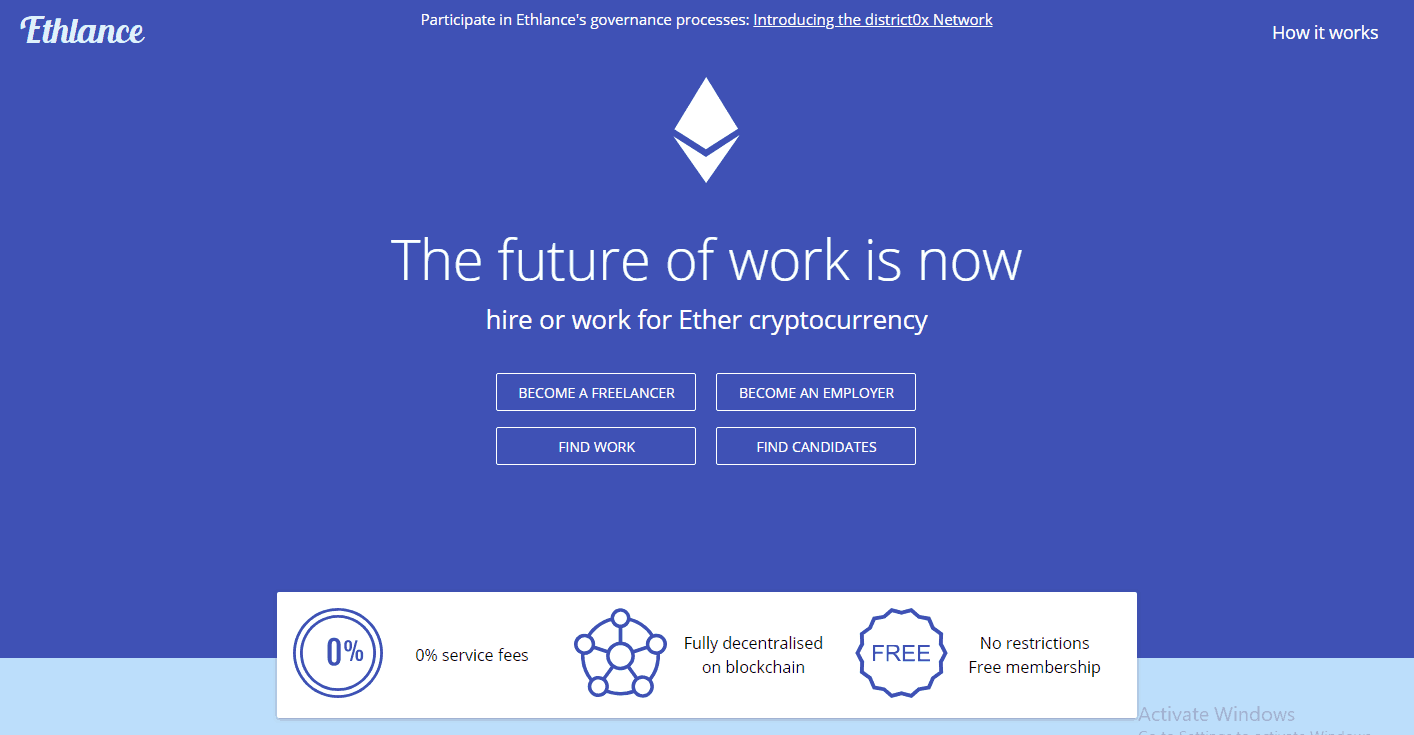
![Best VPNs For Google Chrome [2023] 150 Best VPN for Google Chroem](https://blokt.com/wp-content/uploads/2020/05/best-vpns-for-chrome.png)







